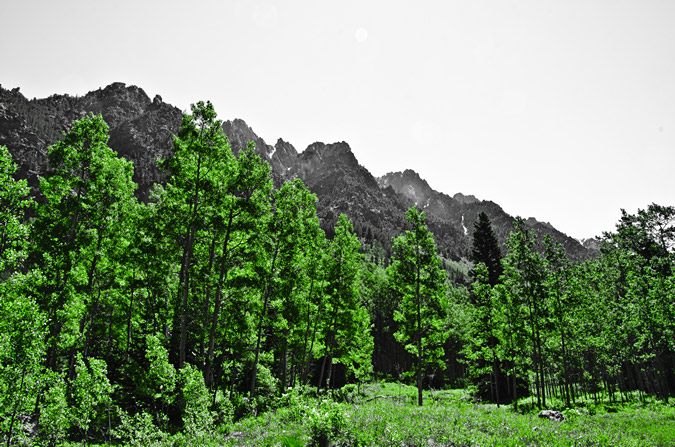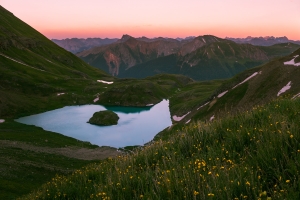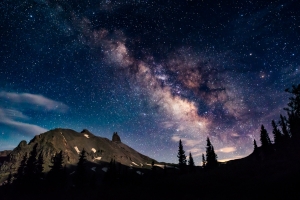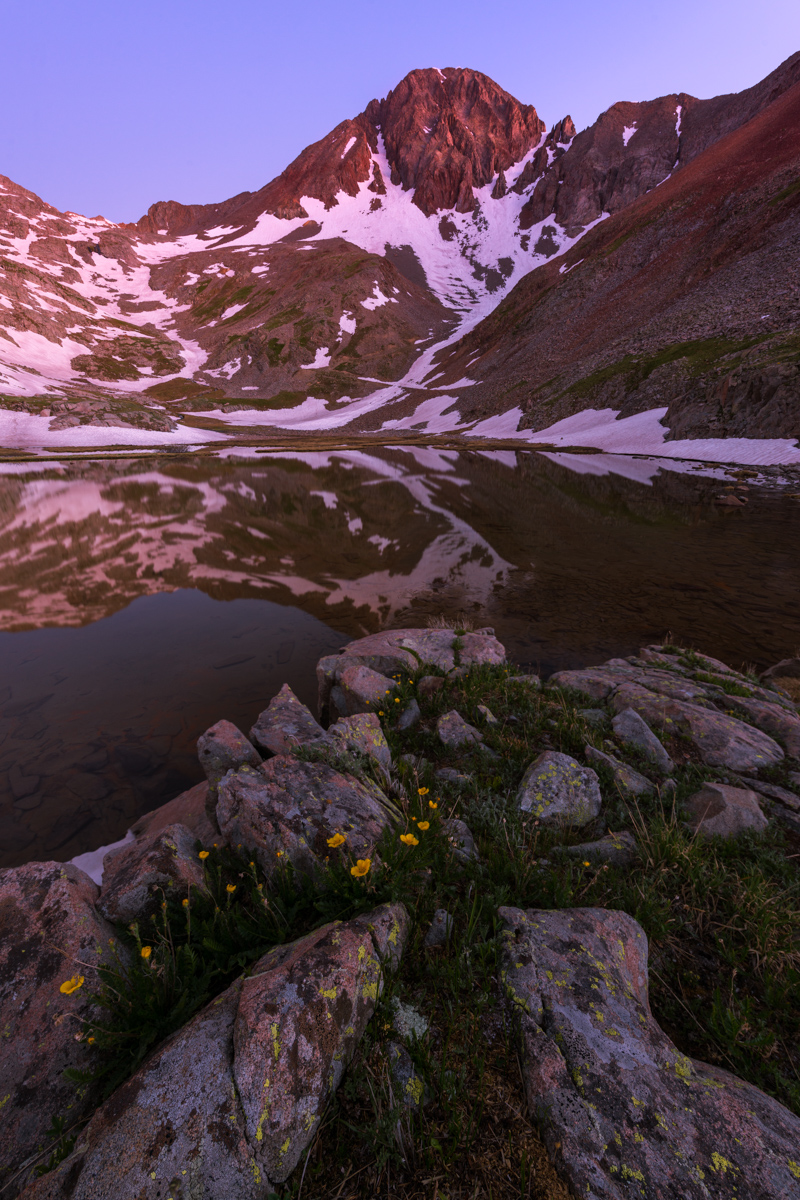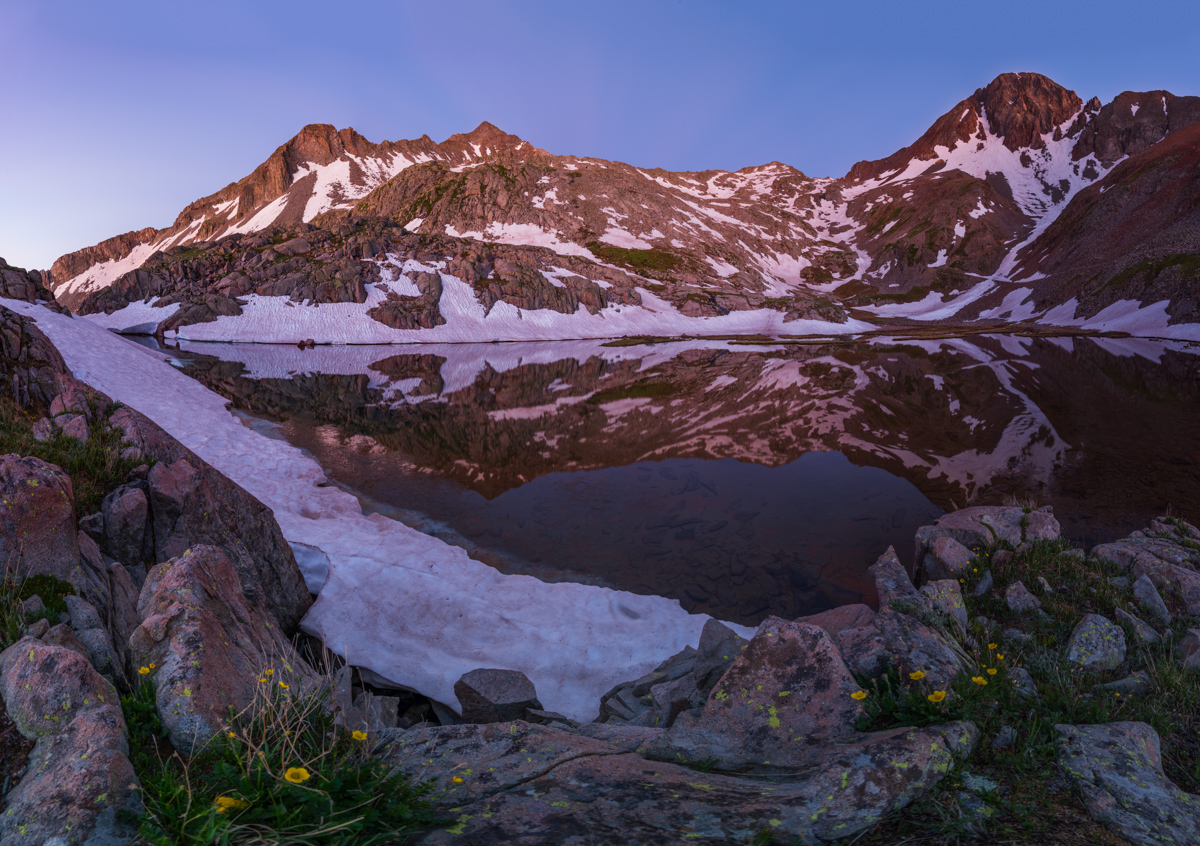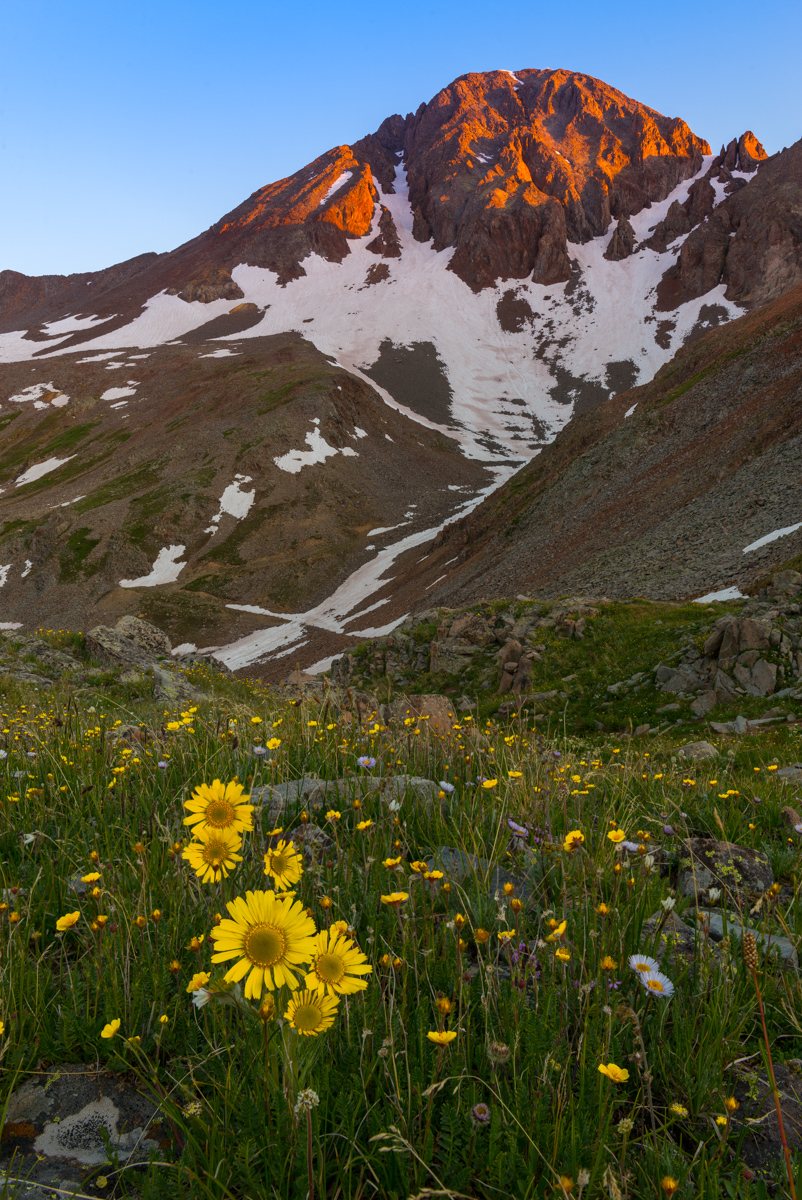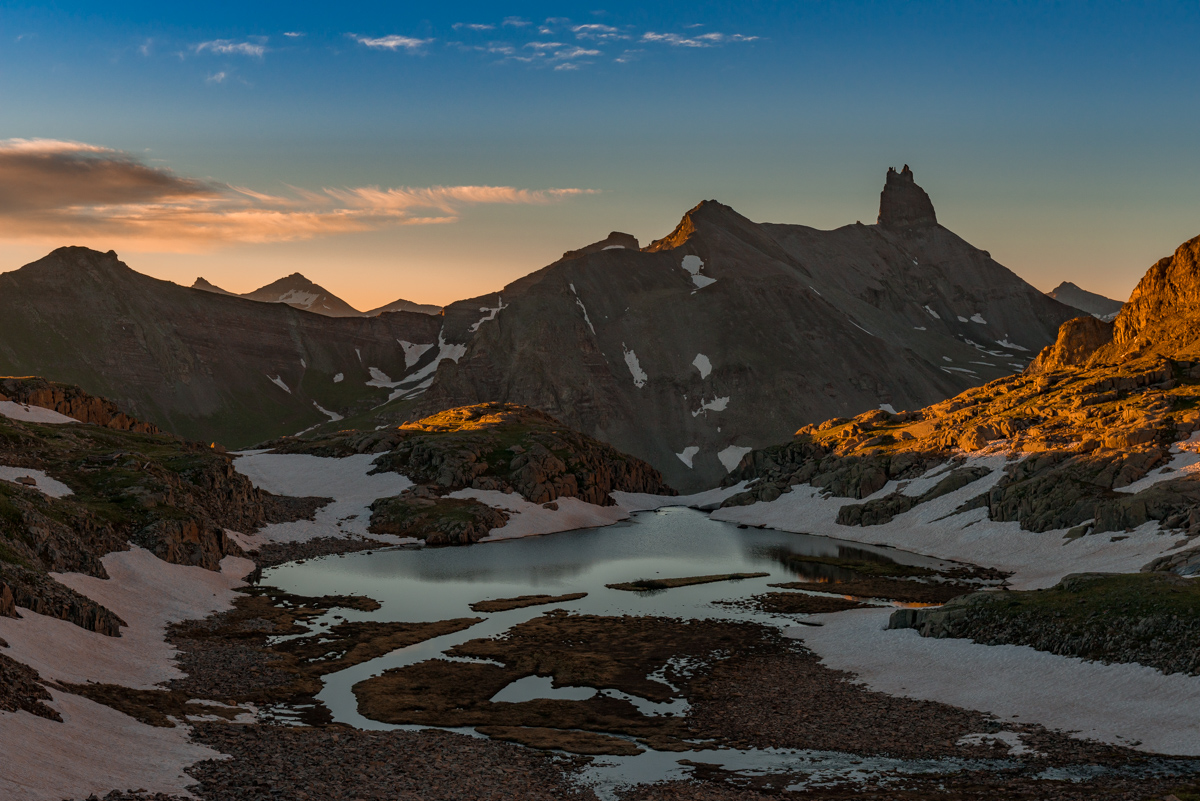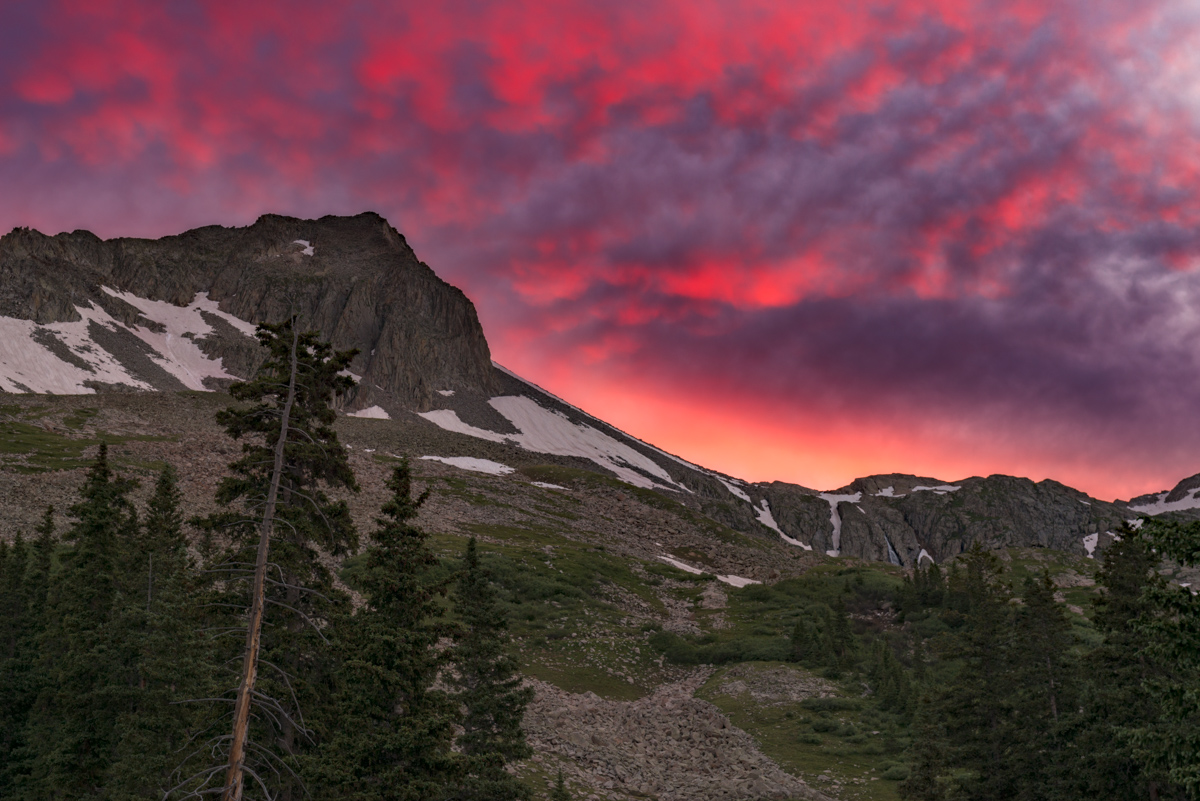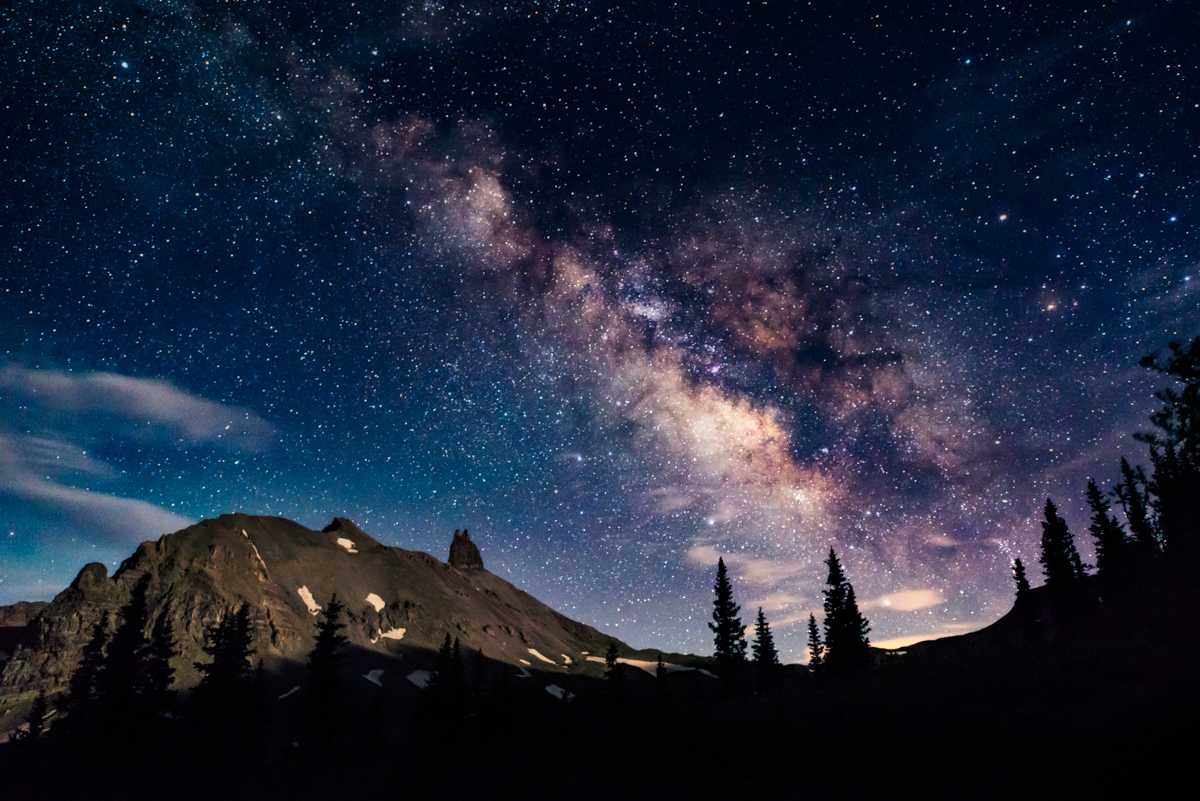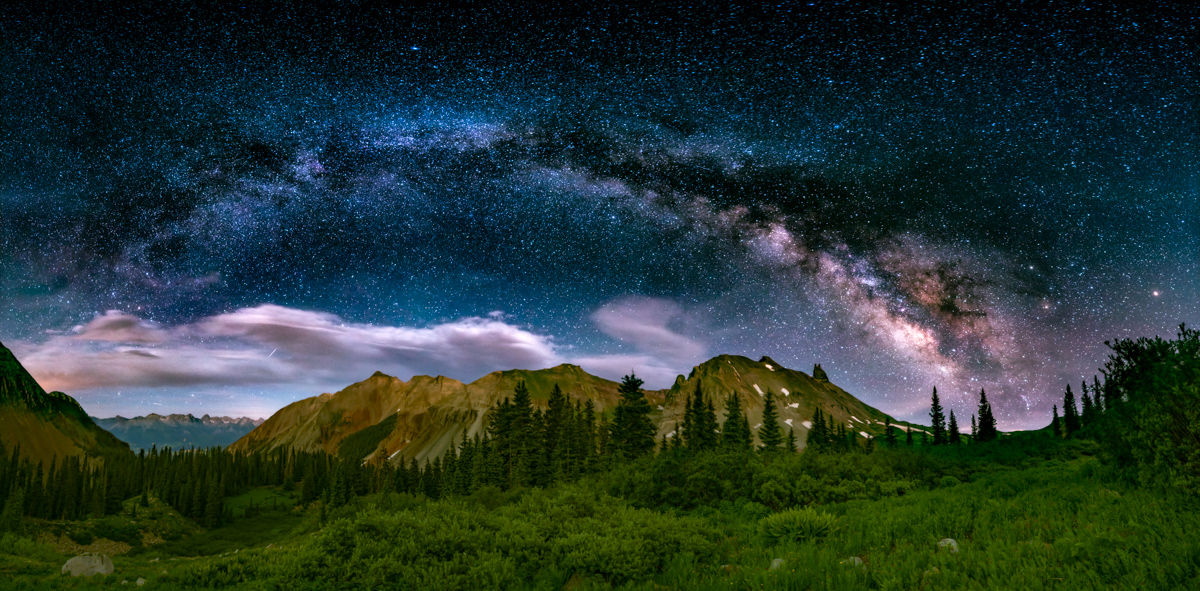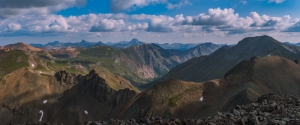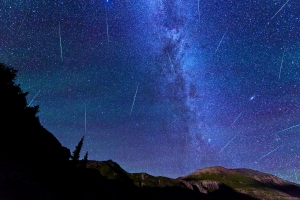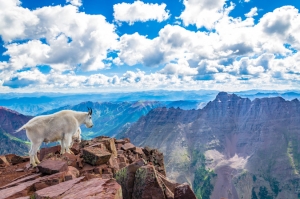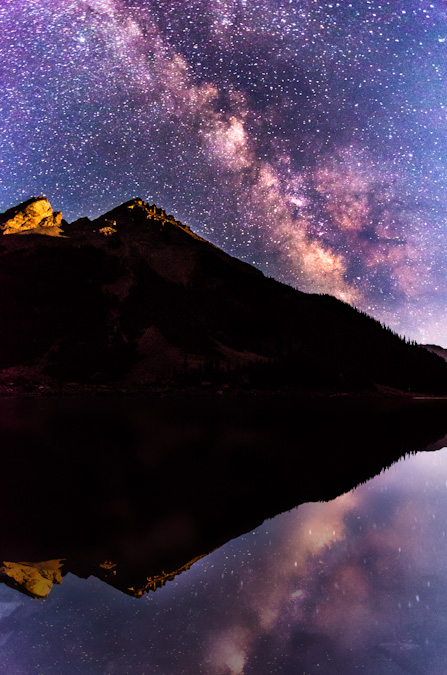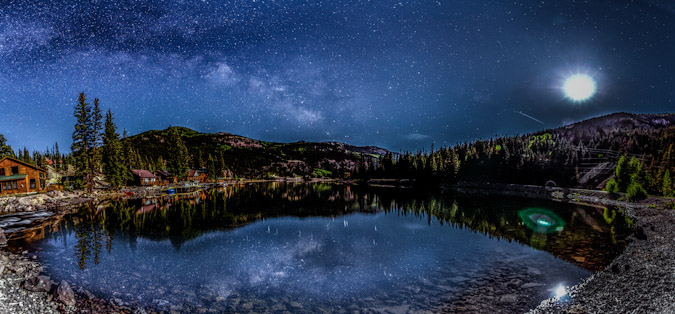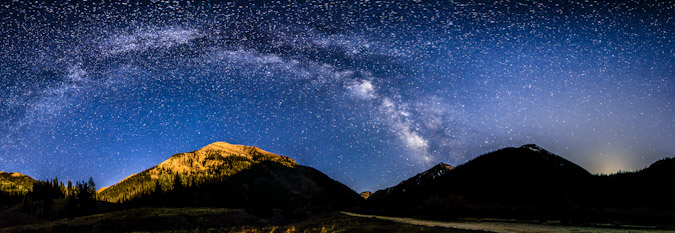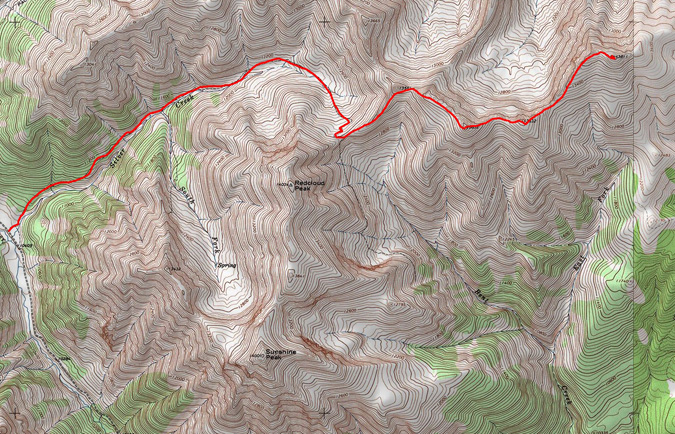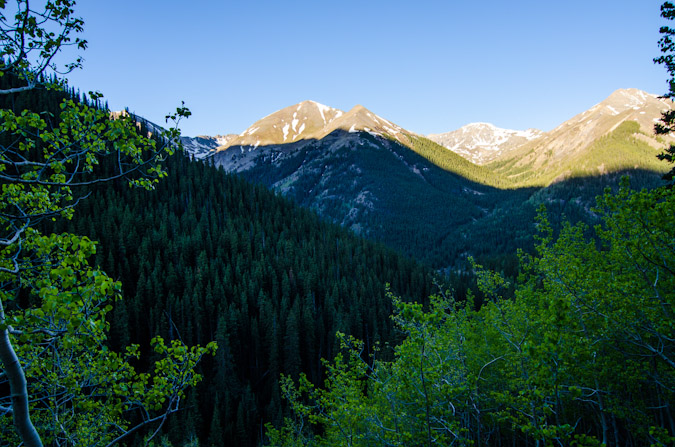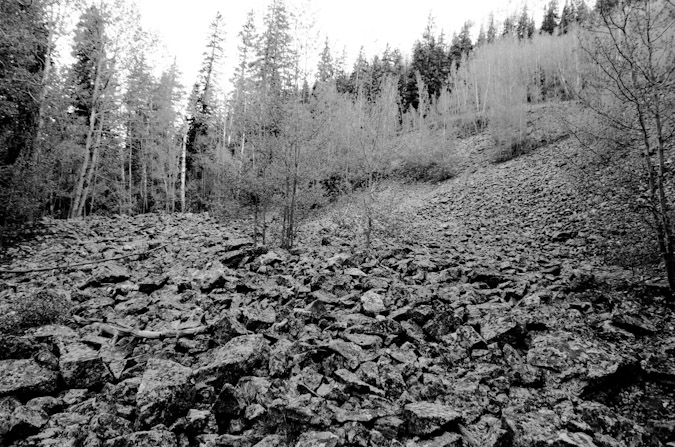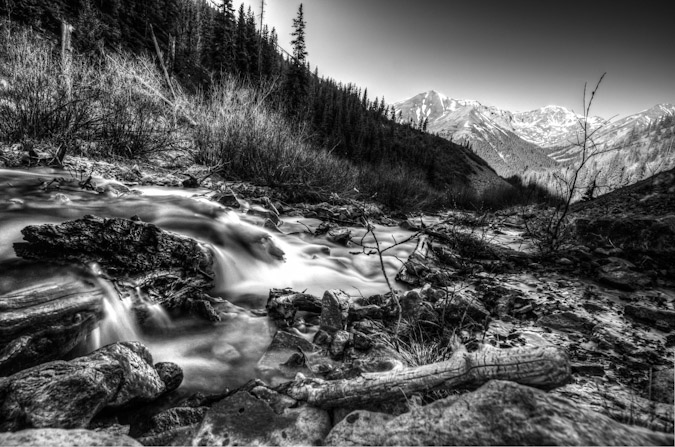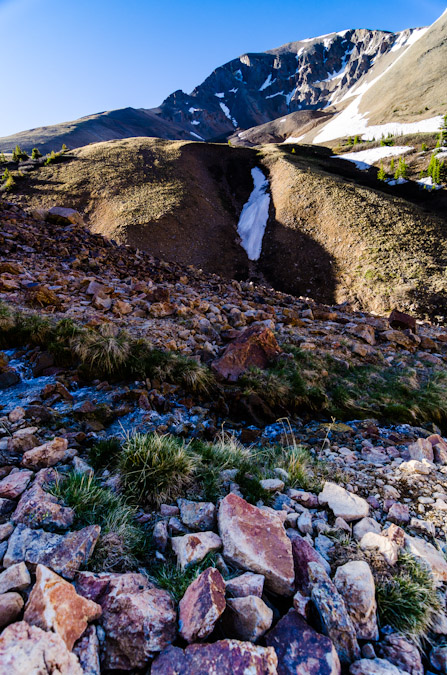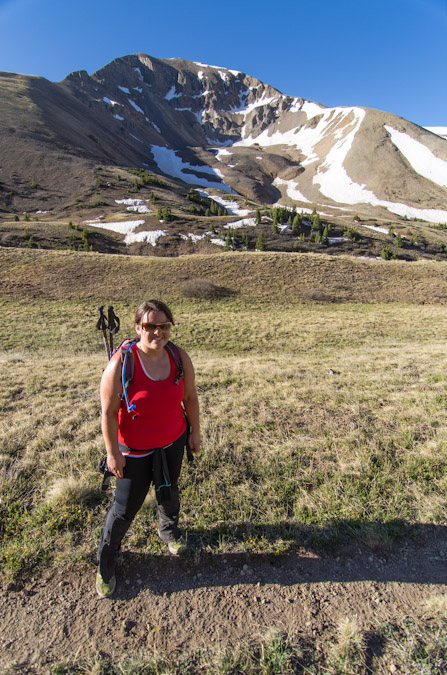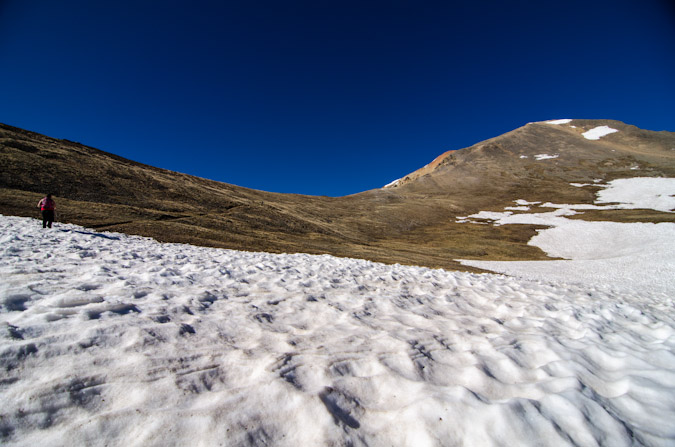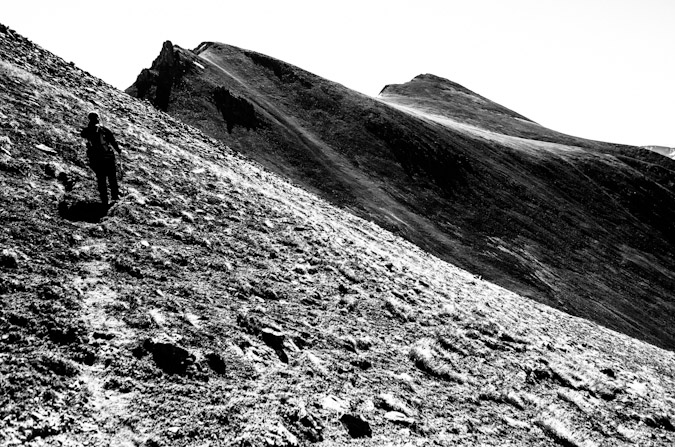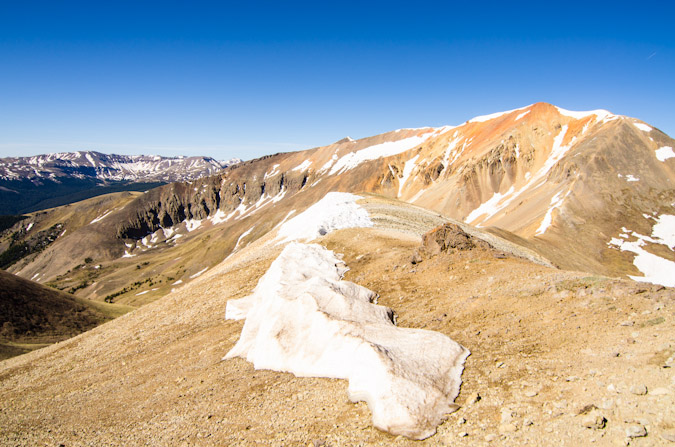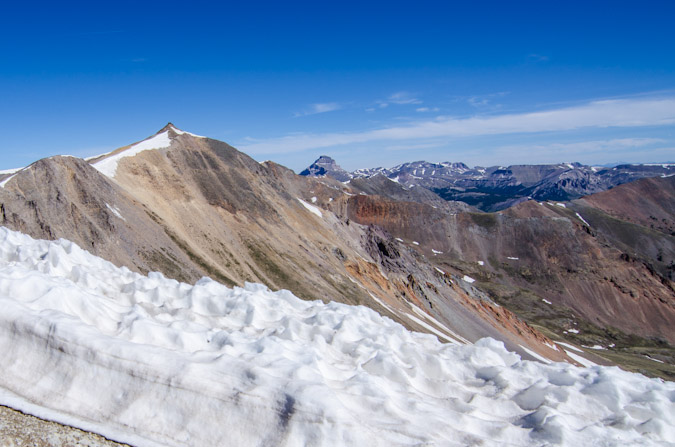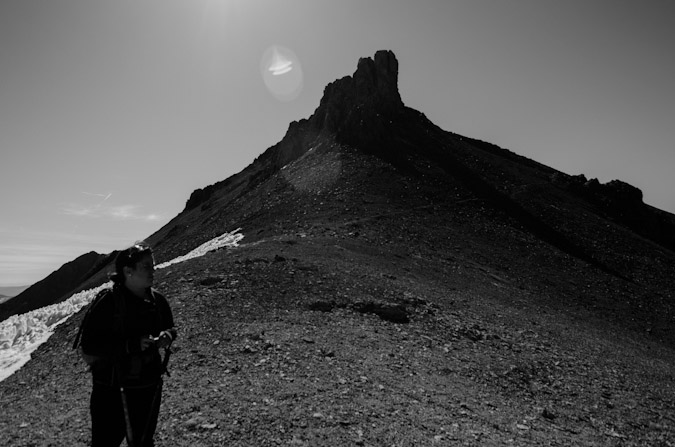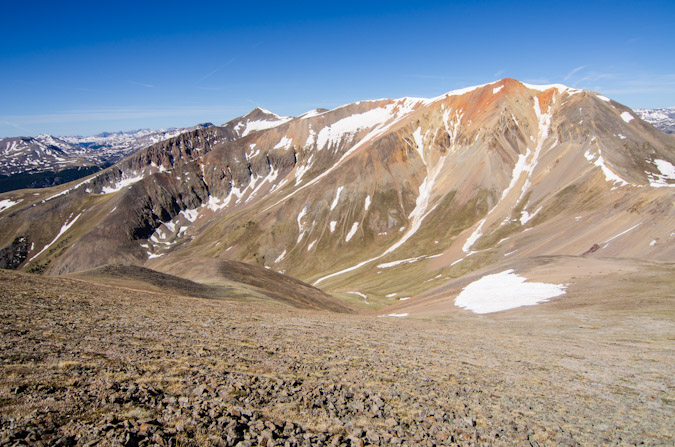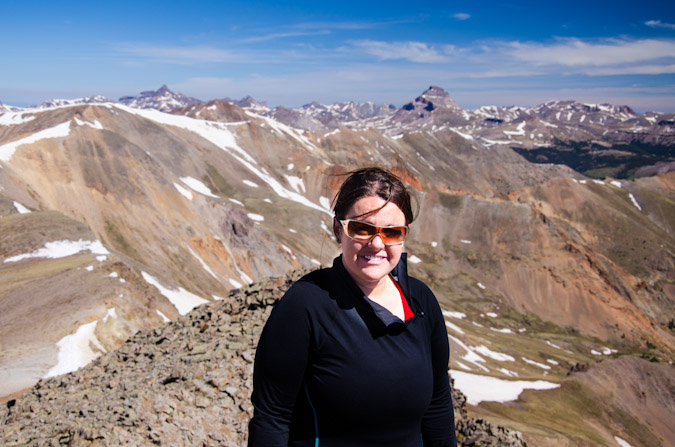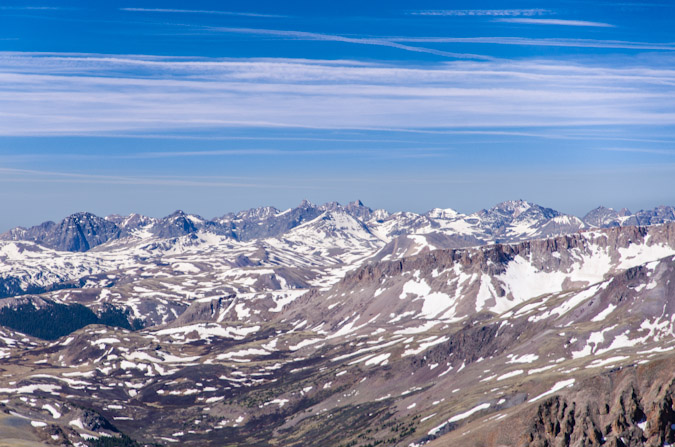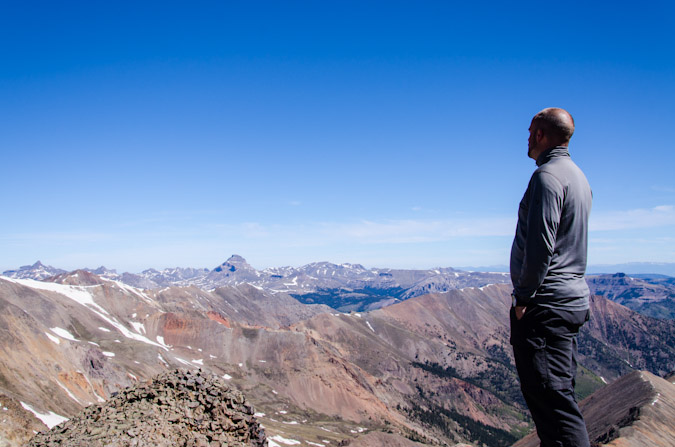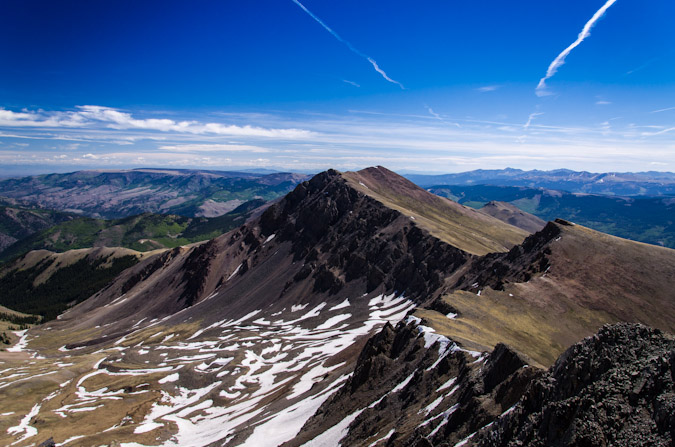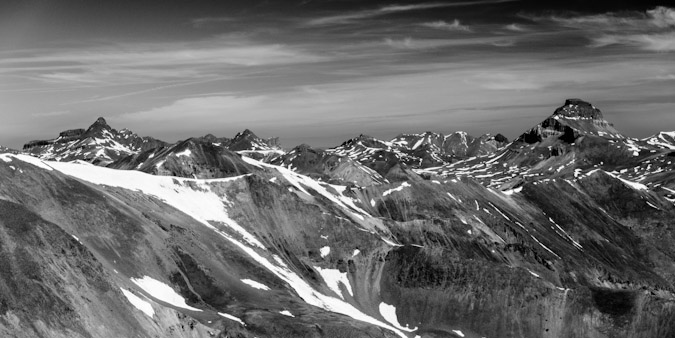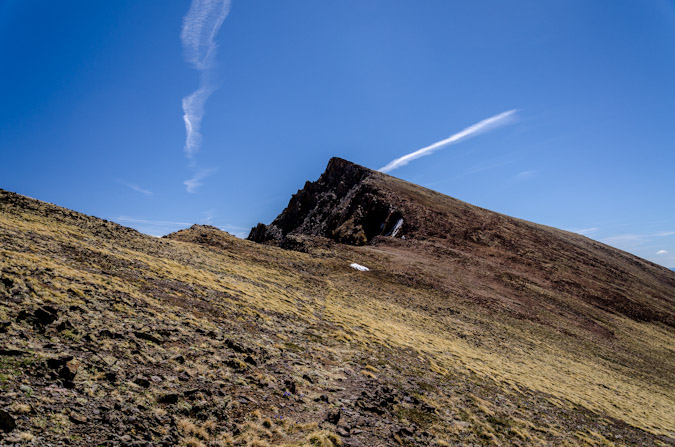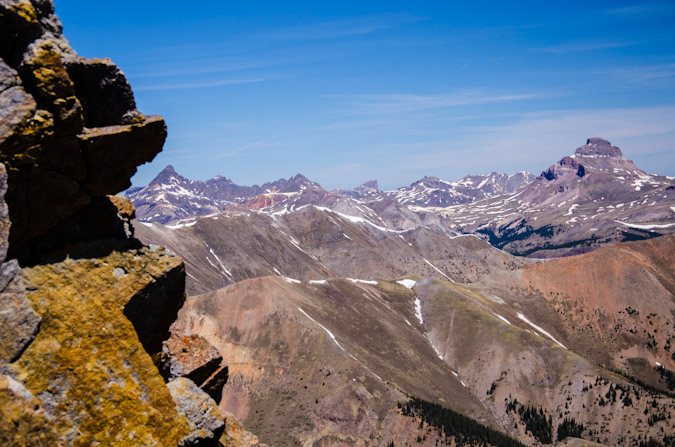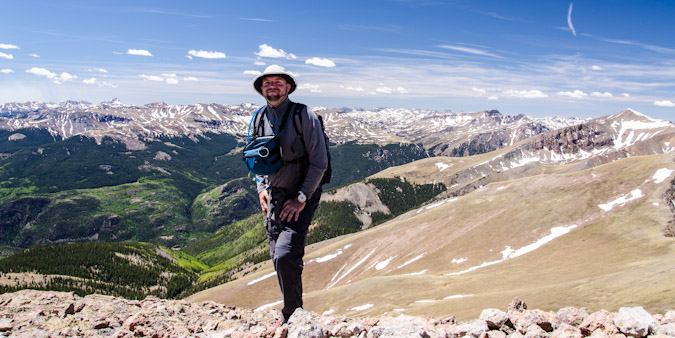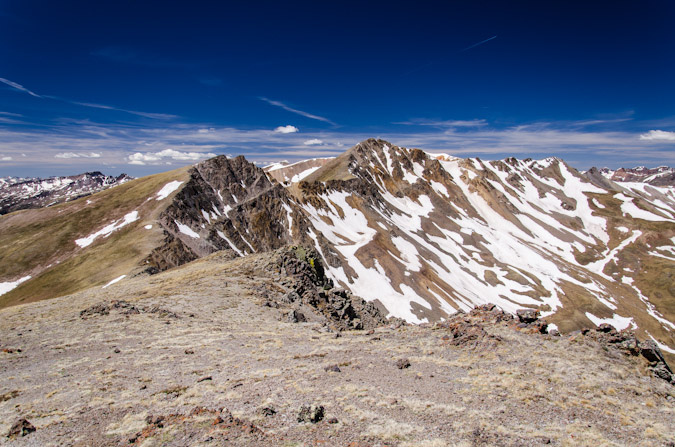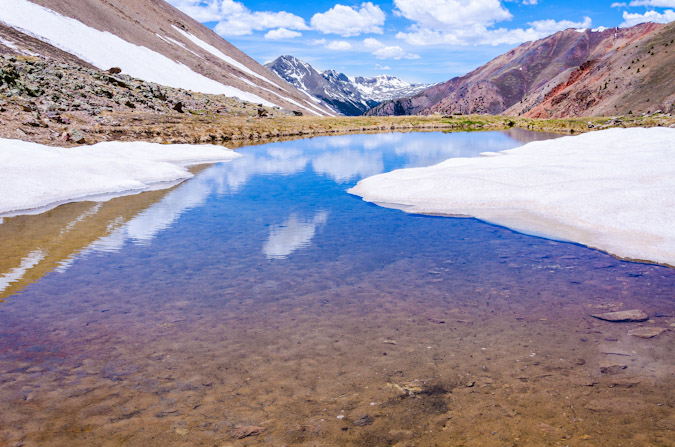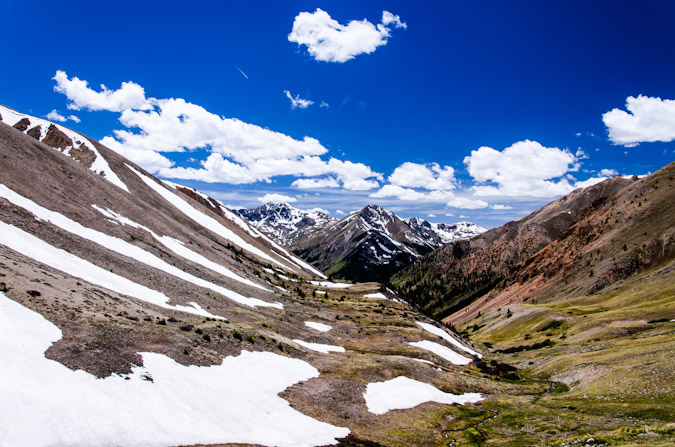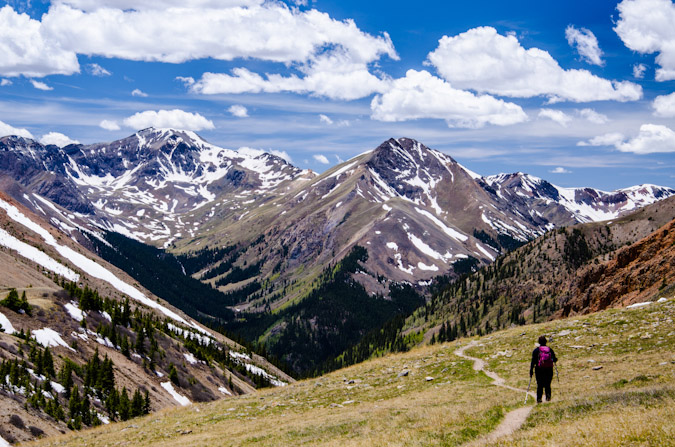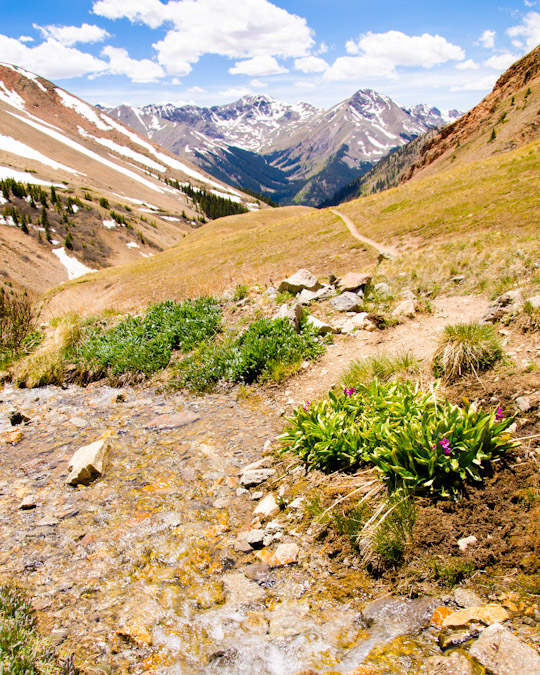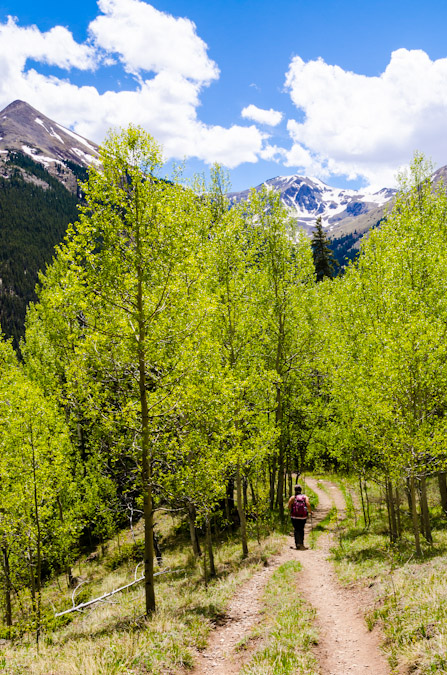Displaying items by tag: Milky Way
Adventures in Silverton, Colorado: Backpack to Island Lake and summit U.S. Grant Peak
After visiting Ice Lake Basin in August of 2013, I knew that I had to return to the area to photograph the wildflowers there at peak season (mid-July). After moving back to Colorado in November of 2015, I knew that one of my first destinations would be the Ice Lake Basin area. I also wanted to get my wife into backpacking so I got her equipped with some light gear and we both began exercising together to get ready for the primetime hiking season. Since my wife was new to backpacking, I decided to get our pack weight as low as possible. My friend Todd Myers loaned us a great book on Ultralight Backpacking by Mike Clelland which offered some great tips to get our weight down. The items I picked up for my wife included a new sleeping bag, a new sleeping pad, and a new backpack. We were able to get her pack weight under 15 lbs, which I think is a huge success. Here's the short list of gear we picked up for her:
1. REI Joule Women's Sleeping Bag - my wife sleeps super cold and this bag kept her nice and cozy at 12,500 ft, and it only weighs 2 lbs 2 oz. Success.
2. Therm-a-rest NeoAir XLite Sleeping Pad - while this is probably the lightest sleeping pad I've ever seen and it packs down to almost nothing, my wife complained it was a bit too small. Get the longer version.
3. Osprey Tempest 30 backpack - this pack was the perfect size for what she was carrying and weighed under 2 lbs. Awesome.
For myself, I picked up a new backpack as well, the Osprey Exos 48 - a perfect size pack for a tent, bag, pad, food, cookware, and my camera system.
We weighed all of our gear using a kitchen scale and used the awesome gear planner from Erik the Black to calculate our total weight. The whole planning thing helped my wife get into the ordeal and get excited, I think.
Lastly, we invited some of new friends from Durango, including Todd, Autumn, and Ellen. Good times were for sure going to be had! From my last adventure up to Ice Lake Basin, I knew about a shortcut by taking the road up to Clear Lake and then parking at the 1st switchback. This saves about 1,000 feet of total climbing. We arrived at the small parking area, which was empty (a good sign for sure). Our adventure began immediately by crossing the strong creek coming down from Clear Lake. This was my wife's very first stream crossing and she did it like a champion. The trail was steeper than I remembered and my wife struggled a great deal on the way up, but our group was supportive and I was SO proud of her determination. She rocked it! As we entered lower Ice Lake Basin, we had a decision to make - to continue on to Ice Lake Basin, to stay at the lower Ice Lake Basin, or to go to Island Lake, which was somewhere I had never been. The group unanimously voted to go to Island Lake since we anticipated the weekend to be quite busy with wildflower peepers and we thought Island Lake would be a little less busy. I personally had no problems with this since I could head over to Ice Lake no problem to take photos if I wanted. We made quick work up towards Island Lake as sunset approached and I captured a shot of the last light as we gained elevation quickly. The wildflowers were insane. By the way, you can check out the map of where we went and the GPS / GPX file over on Gaia GPS, who generously gave me a free Pro account. I love Gaia GPS - such an awesome app! You can purchase it here and help support the site.
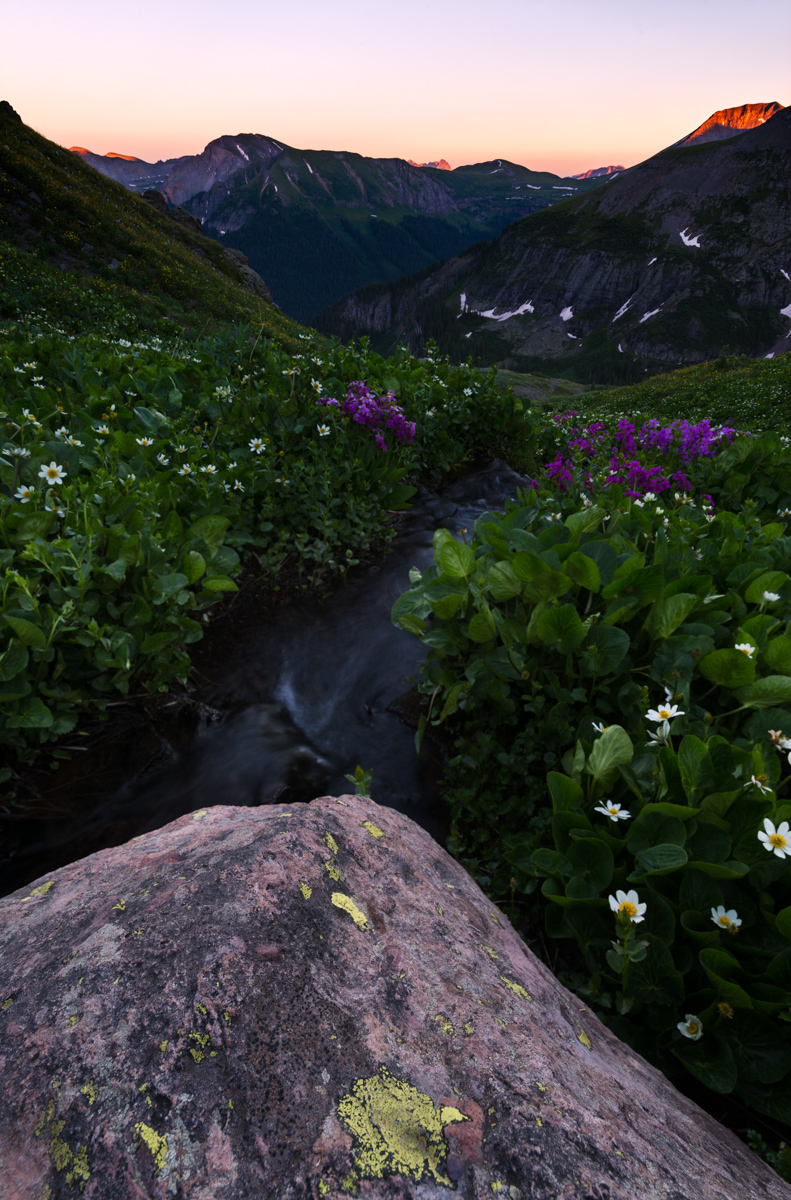
Upon arriving in the upper basin near Island Lake, the whole area opened up to the South and East, revealing views of the Grenadiers, the Chicago Basin 14ers, and Rolling Mountain (right). As you can see, the yellow paintbrush were stunning.
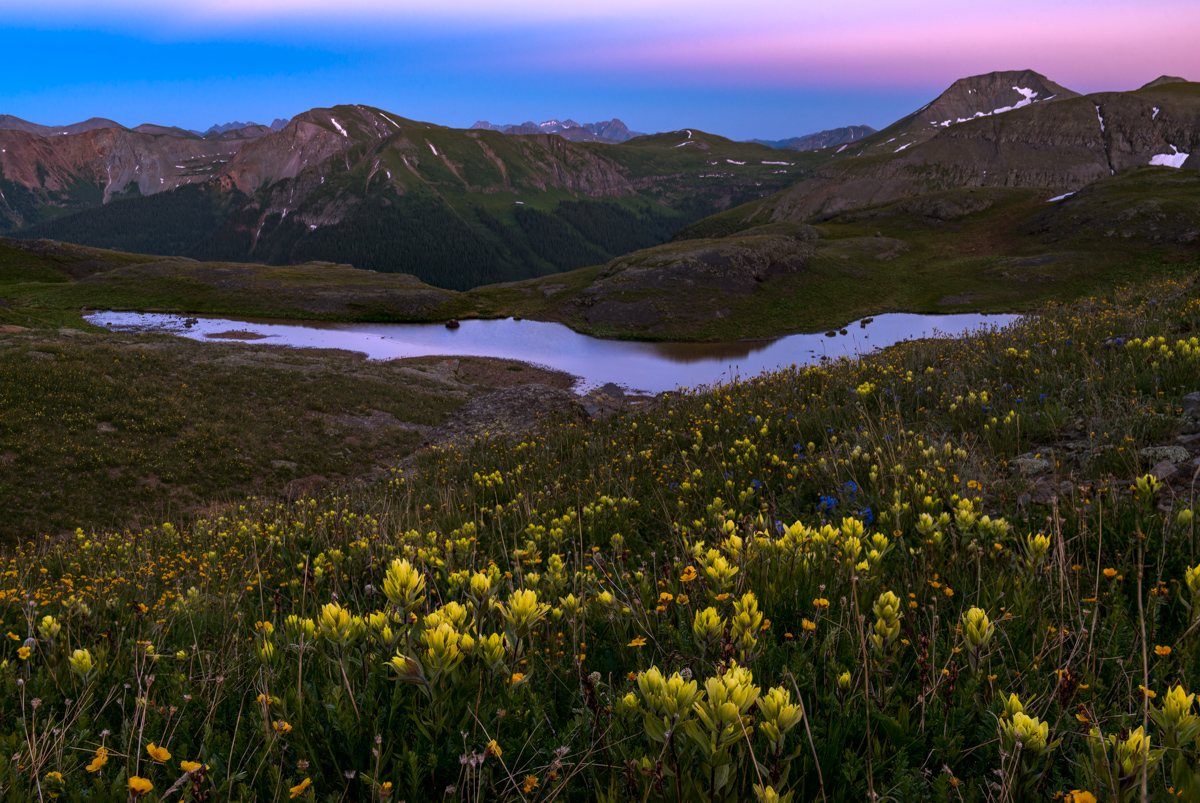
Our group found a great spot right by Island Lake to camp and we proceeded to get set-up. We were alone at the lake (or so we thought) and just loved the solitude. I knew that I would have some great opportunities for some photography at night - I had studied the projections for the moon's brightness, location, and time of rise/set as well as the location of the Milky Way and the time it would rise and set - all using a handy app called PhotoPills. Since the moon was looking to be quite bright and nearly full, I knew that I would shoot in two sessions - early at night for the bright moon illumination, and later in the very early morning after the moon had set. So - I set off to take some photos using the bright moon light to provide some ambient light in the basin. The Milky Way was barely visible, but the moon provided some light to bring out the flowers in the basin and the summit of U.S. Grant Peak.
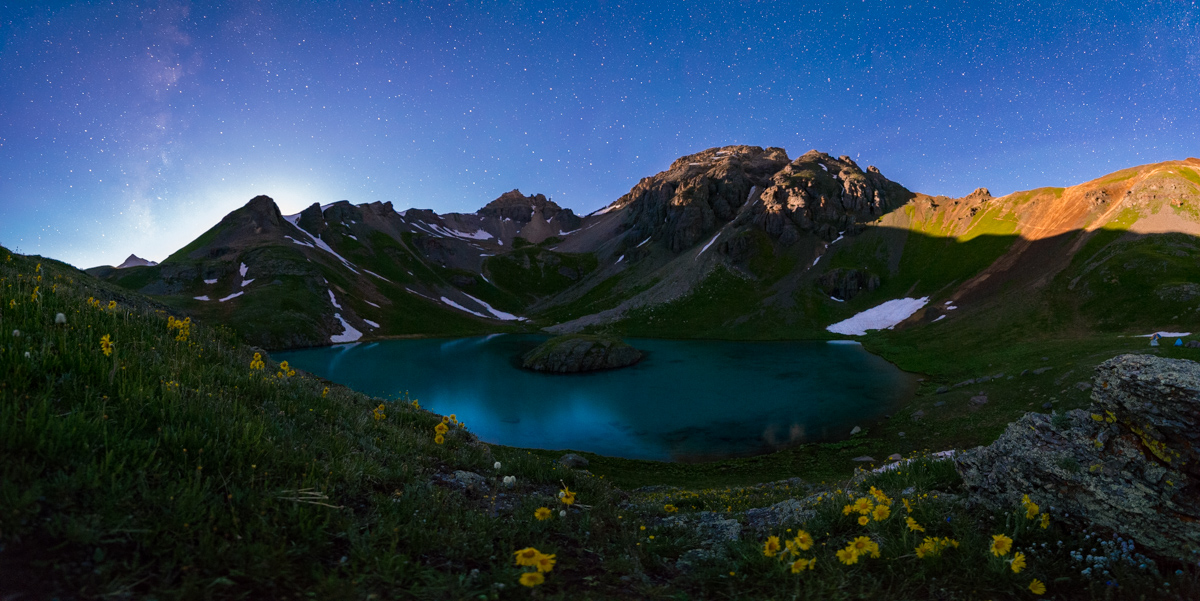
The lake was mesmerizing. I could sit there and take it in for hours.
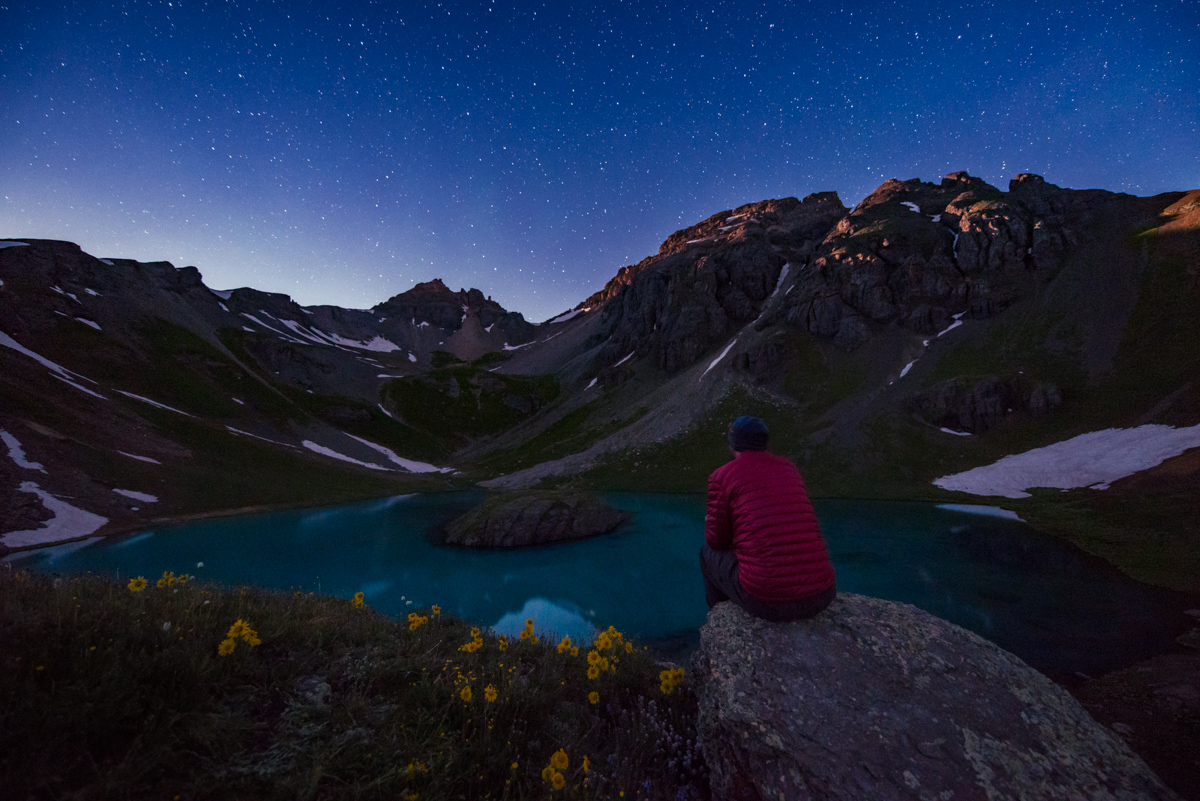
After wandering around for awhile taking photos, I decided to re-join the group at our campsite and go to bed. I set my alarm for 2 AM so that I could find a cool spot to photograph the Milky Way. Sleep is over-rated. None of us slept all that well - it was eerily quiet and everyone could hear everyone else move in their bags, open and close zippers, etc. It was pretty tough to get any sleep. I got out of the tent at about 1:45 AM and looked for a good spot to shoot the Milky Way, as planned. I found a little shallow lake nearby that had a nice view over towards the Ice Lake Basin 13ers. I was able to find a way to place my tripod in the center of the lake (it was really only about 3 inches deep), and loved how I could get the reflection of the Milky Way in the water. An amazing sight, for sure!
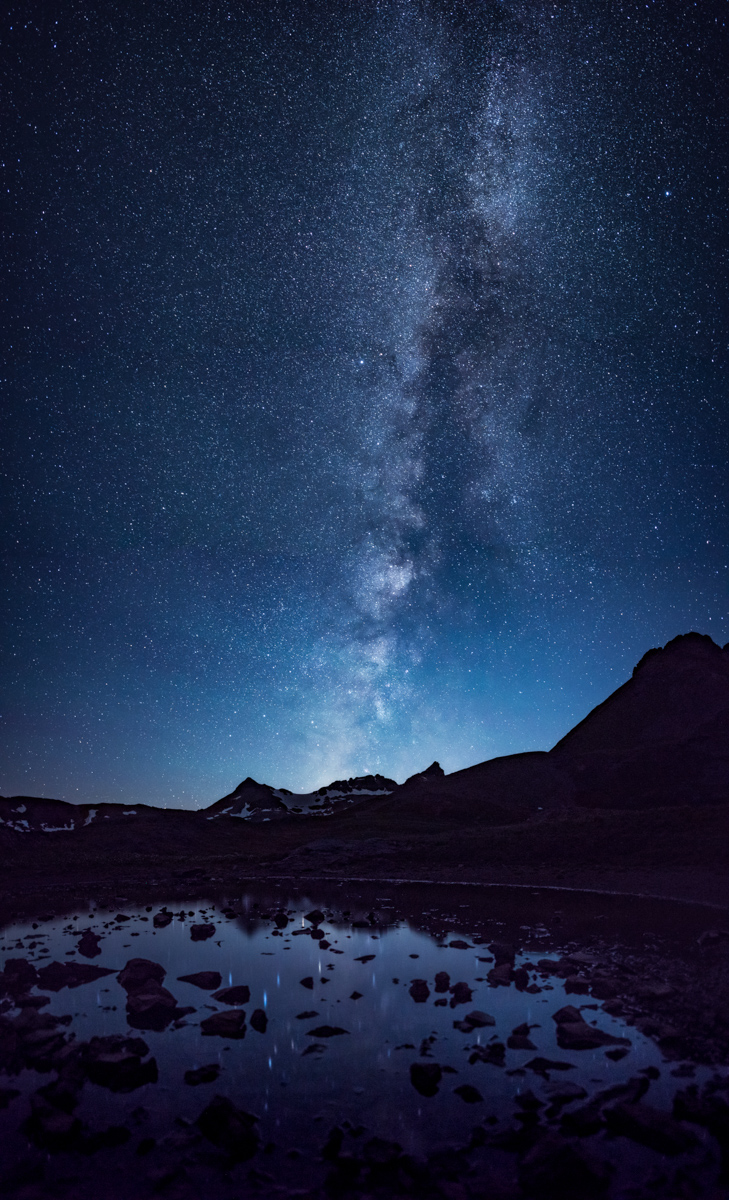
I really wanted to get a 180 degree panorama of the full Milky Way reflected in the water, and was able to pull it off after some work on my settings. The airglow (those high, green looking clouds) was looking awesome as well.
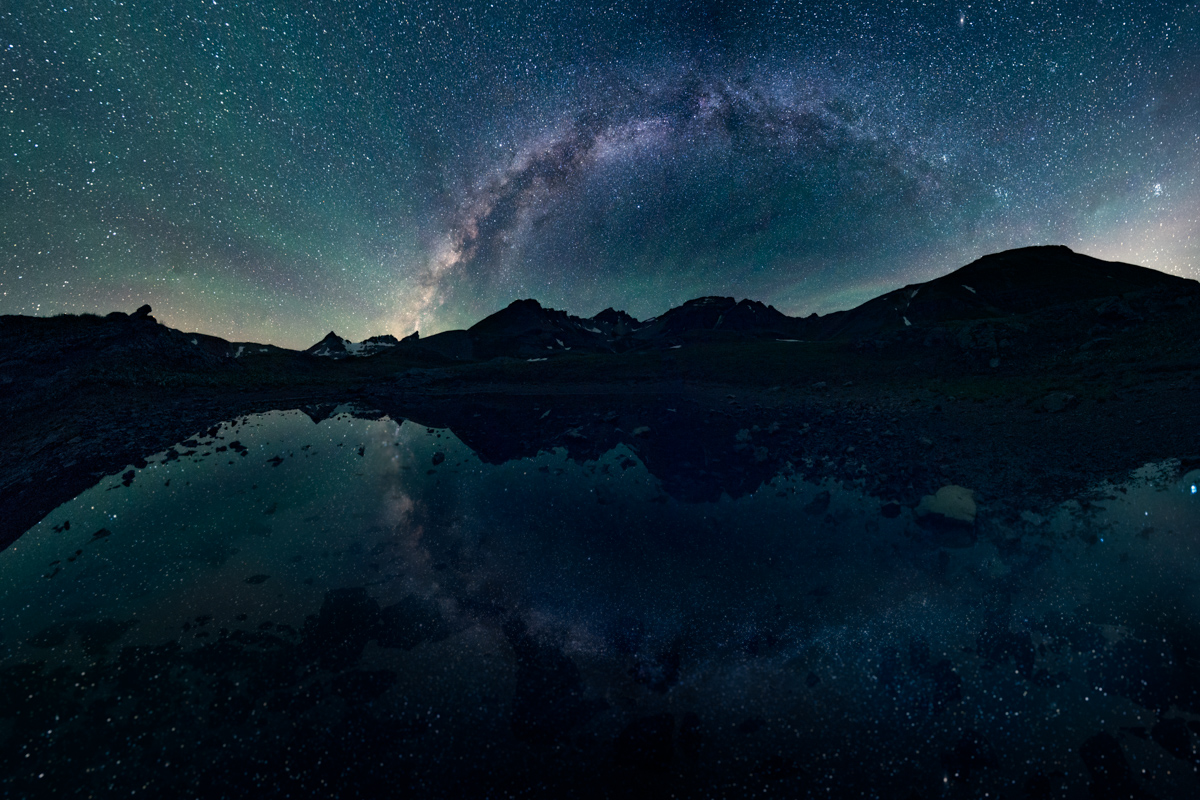
I played around a little with my headlamp as well, wanting to add a human element to the scene. I think it worked out pretty nicely.
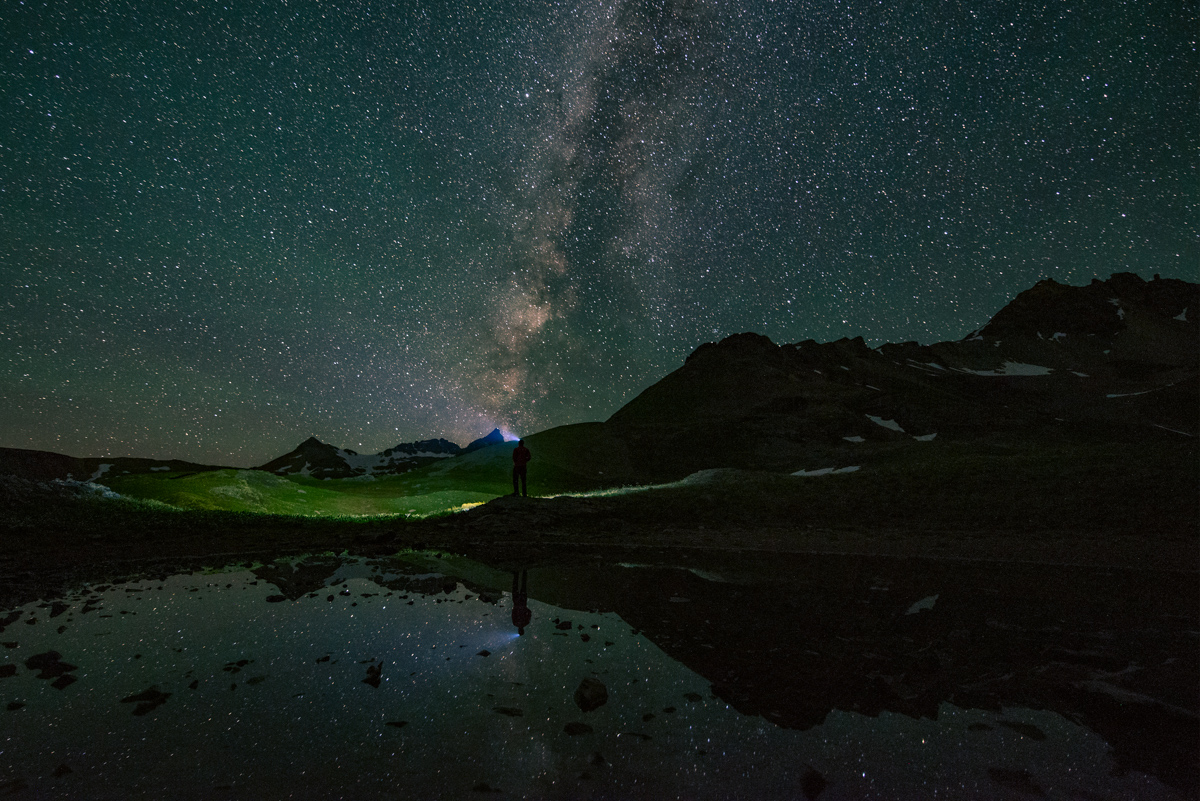
I went back over to Island Lake to set-up for one last shot before going to back to bed. This was a photo that I shot as a tattoo concept that I have been thinking about for awhile - imagine the flowers or a campfire at the bottom on the wrist and then the tattoo works its way up the arm to the mountain and then the Milky Way. I think it would look great, personally.
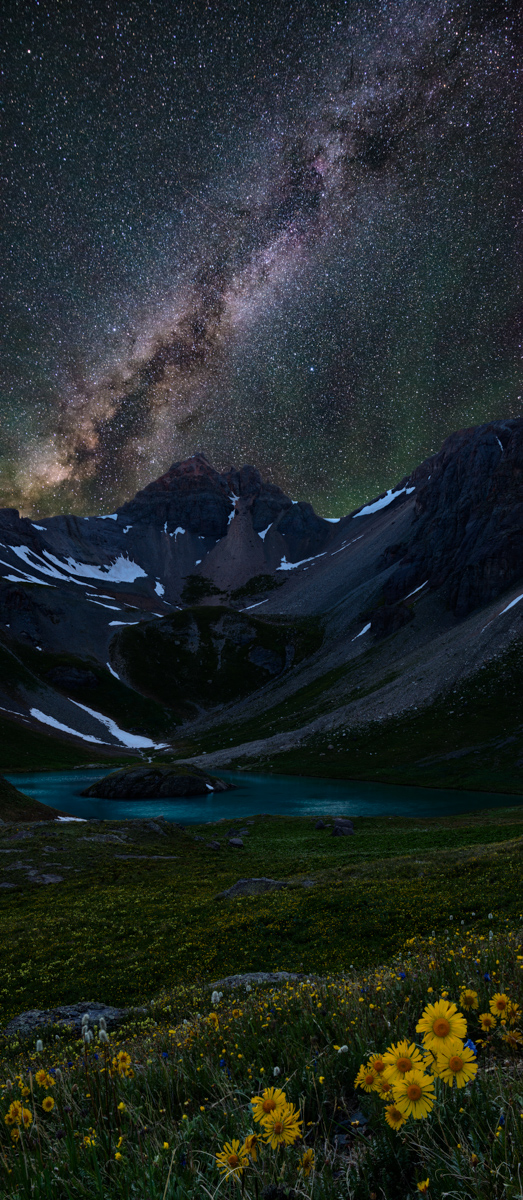
I went to bed again around 4 AM, getting about 4 hours of sleep total. We all woke up and enjoyed the amazing view from the lake and noticed some hikers heading up U.S. Grant Peak. I threw out the idea of doing the same and everyone agreed to give it a shot. So, we made breakfast and got ready for an adventure up U.S. Grant Peak. Normally I do a lot of research before climbing any peak; however, for this one, I decided to just see how things would go and turn-around if needed. I knew there was some challenging class 3 or 4 sections but had no idea what would be in store for us. Exciting!
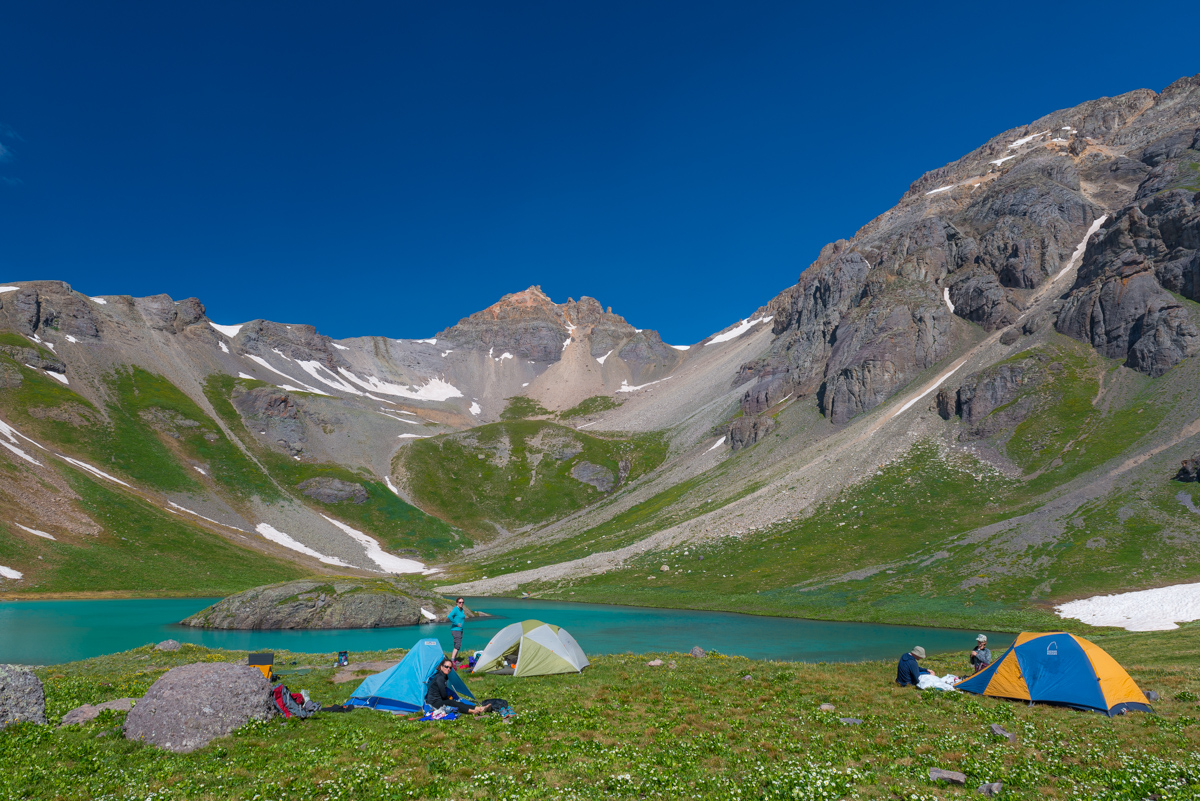
Off we went towards U.S. Grant peak - our goal was to gain the saddle between the two small areas of snow to the right of the peak above the lake seen above.
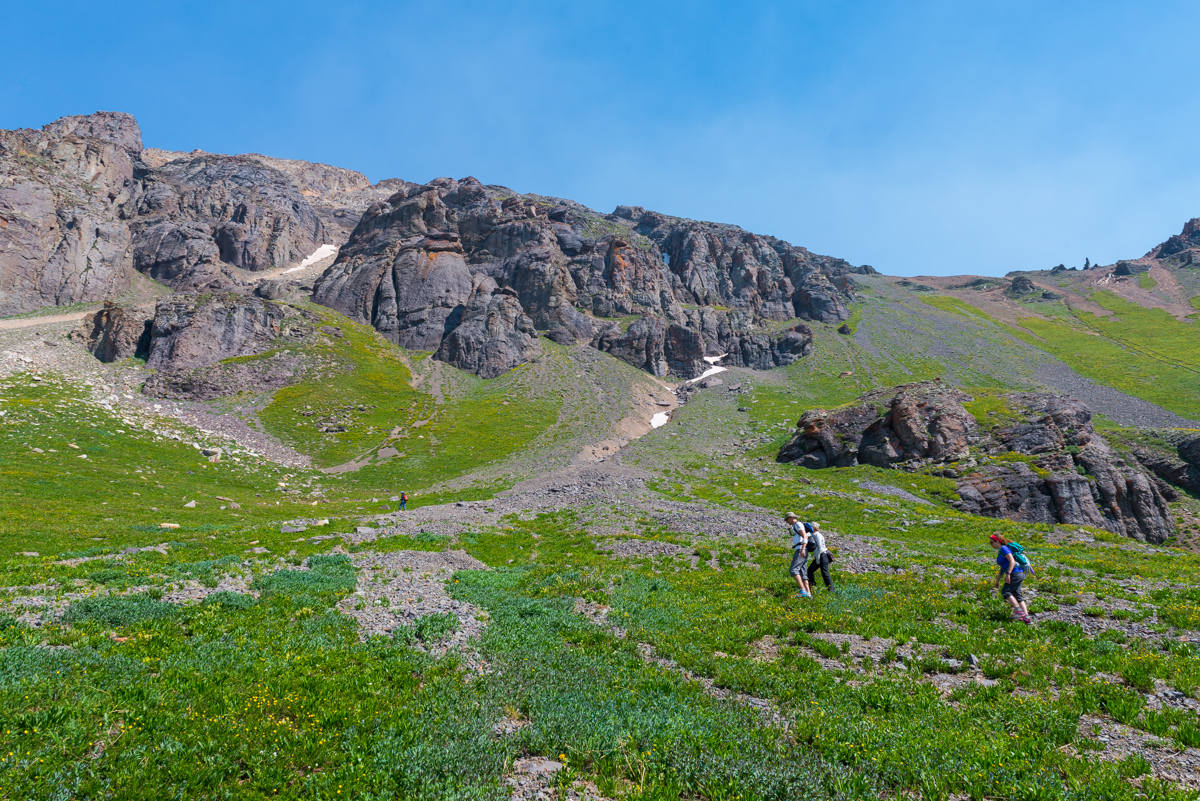
While we were hiking up there was a large group of day hikers having a bit of fun on the island - one even took a backflip off the lake. I'm thinking that was pretty damn cold. More on that later.
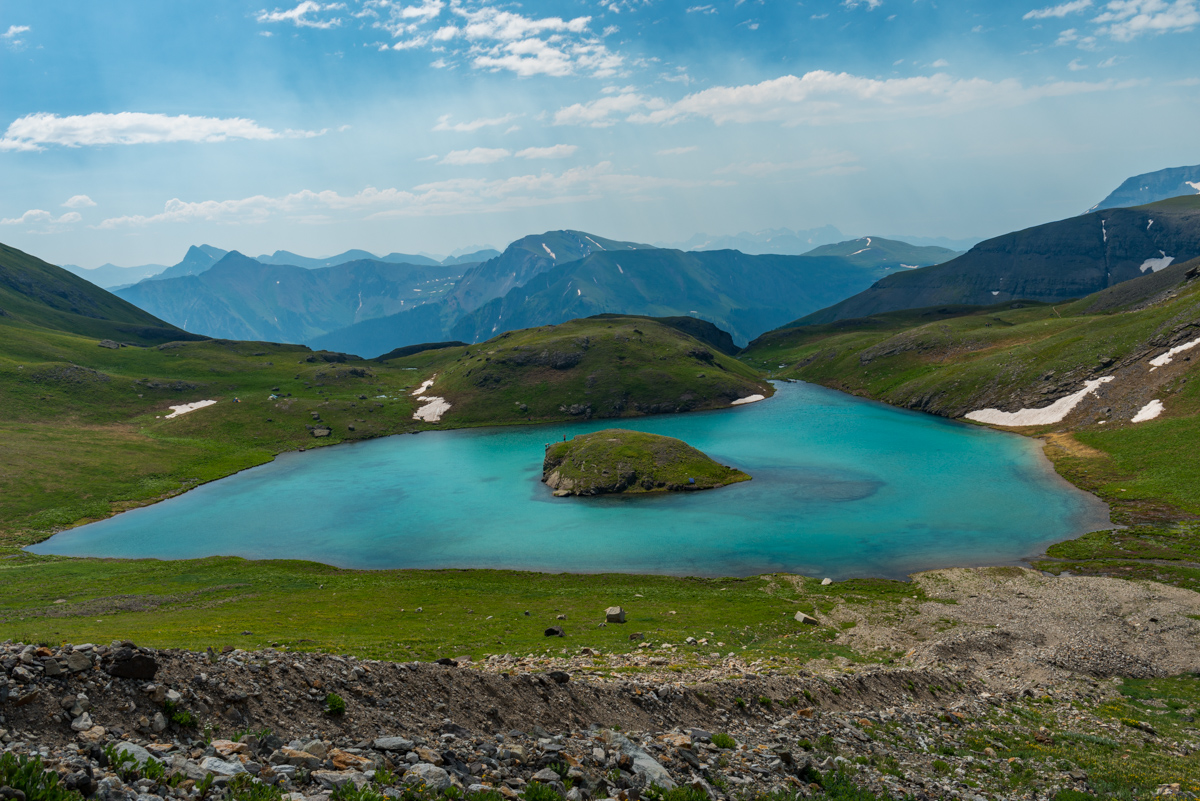
We reached the last section with grass and that is where my wife decided to rest while we continued on. She had an amazing view to take in.
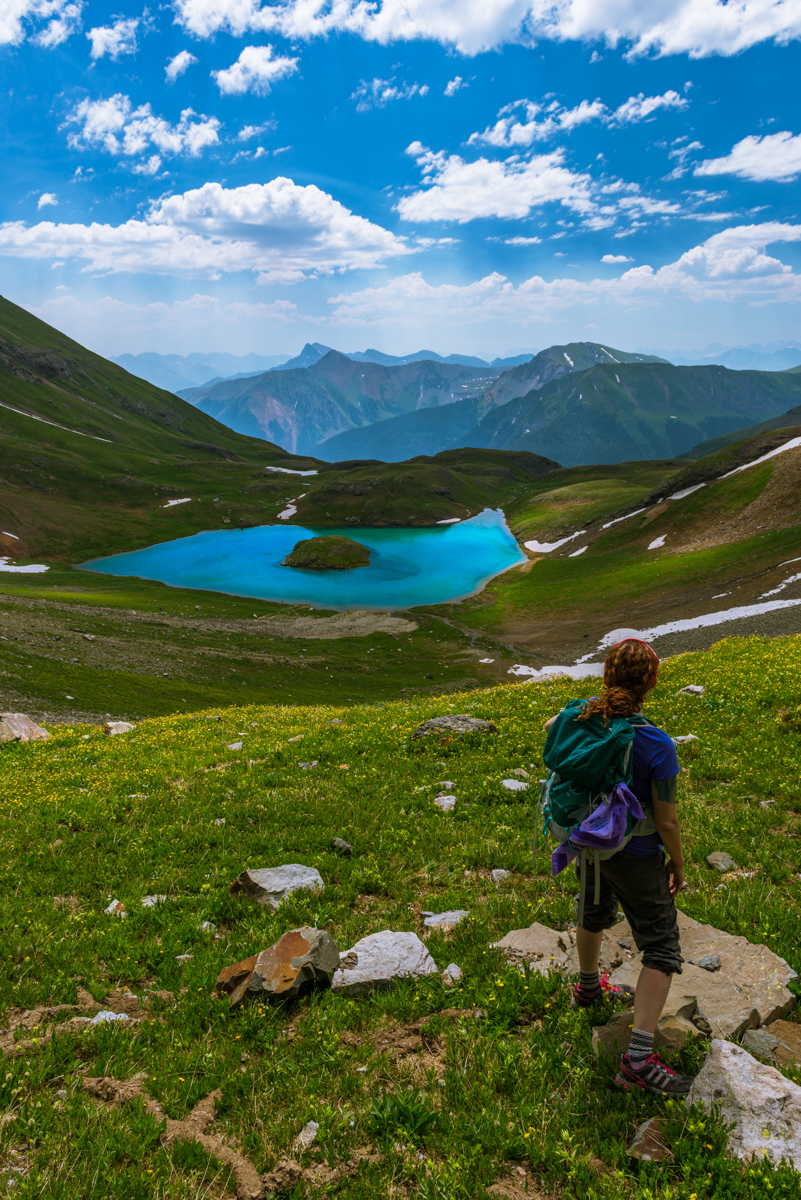
There was a very lightly travelled trail up to the ridge up the muddy dirt and scree. My legs were feeling great so I took the lead, which was awesome because then I could stop and take photos of my friends climbing up. This was a particularly memorable climb because it was Autumn's first mountain climb in Colorado, one I'm sure she will remember.
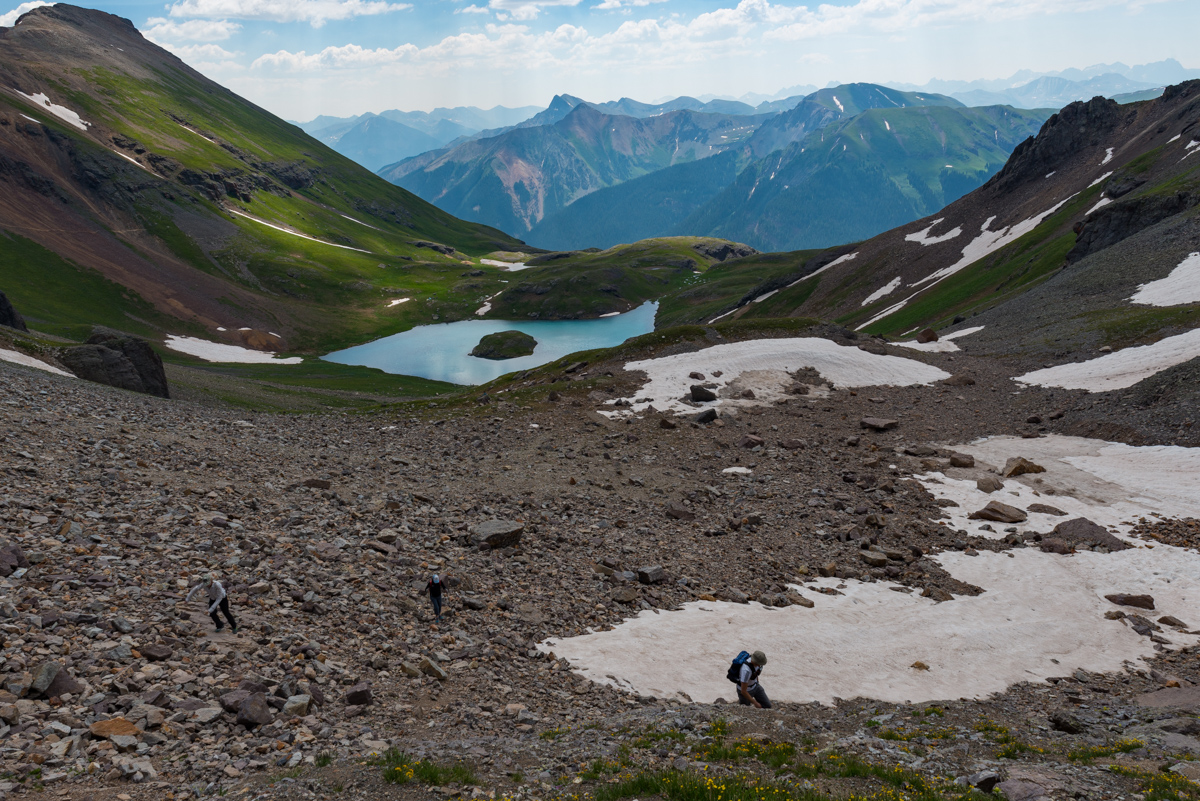
The higher we got, the better the view was, which eventually opened up fully to reveal the San Juans in their glory, from Pigeon all the way over past Vestal and again past Jones and Handies (right to left).
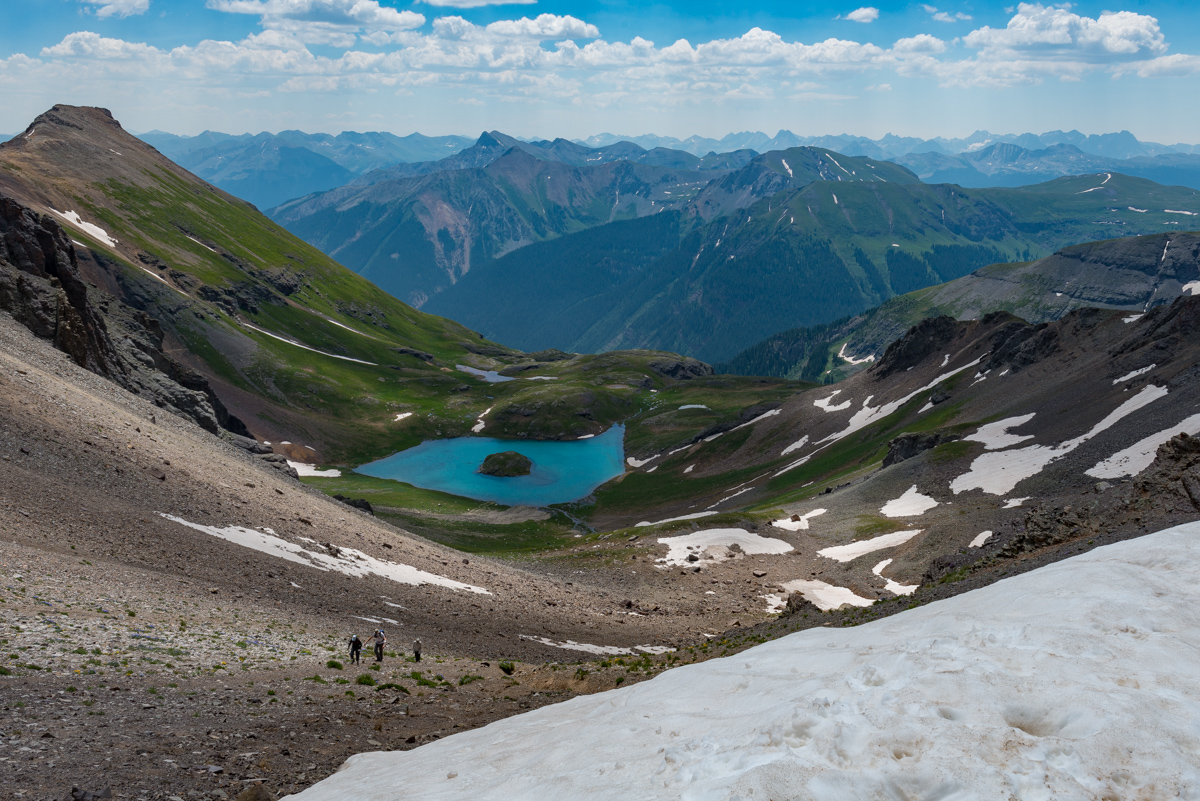
Upon reaching the ridge, I was greeted with a glorious view of Mount Wilson (left), Gladstone (left of center), and Wilson Peak (center). It was great seeing them from this vantage point since I had just climbed Gladstone and Wilson Peak the weekend before from Bilk Basin.
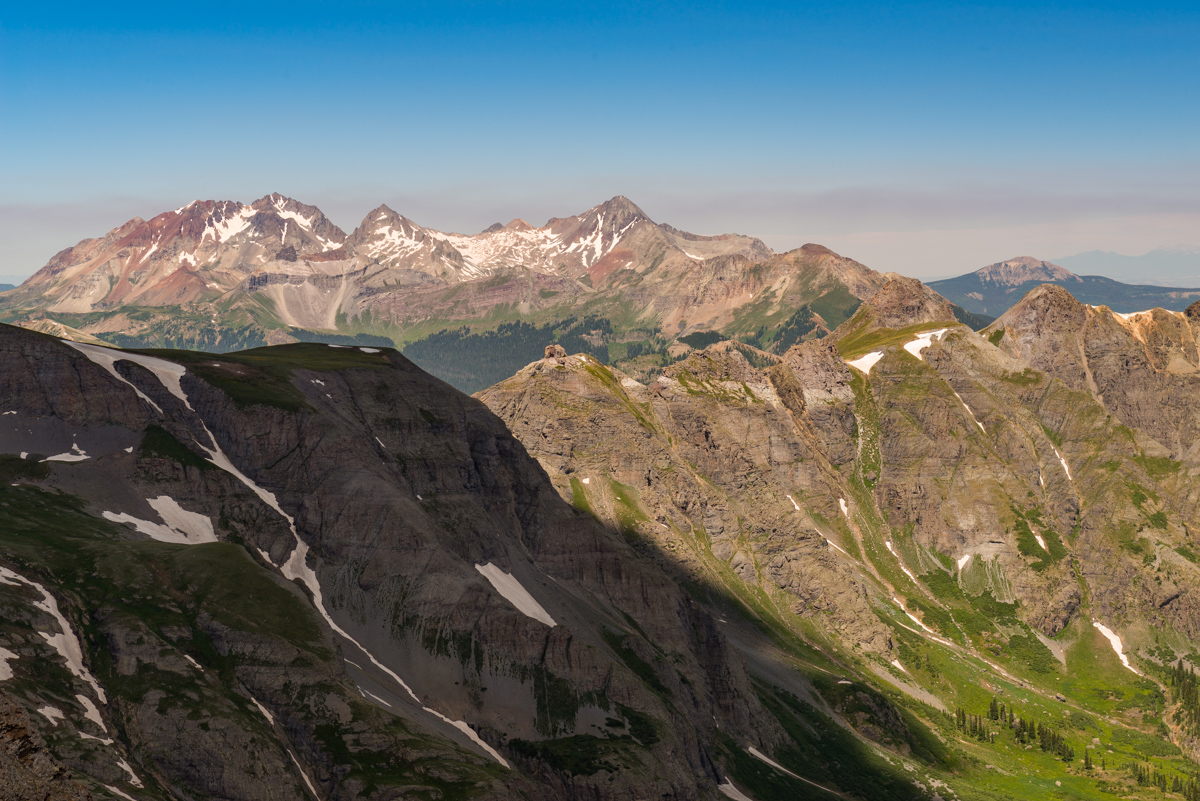
Ellen and Todd joined me on the ridge to take in all of the awesomeness.
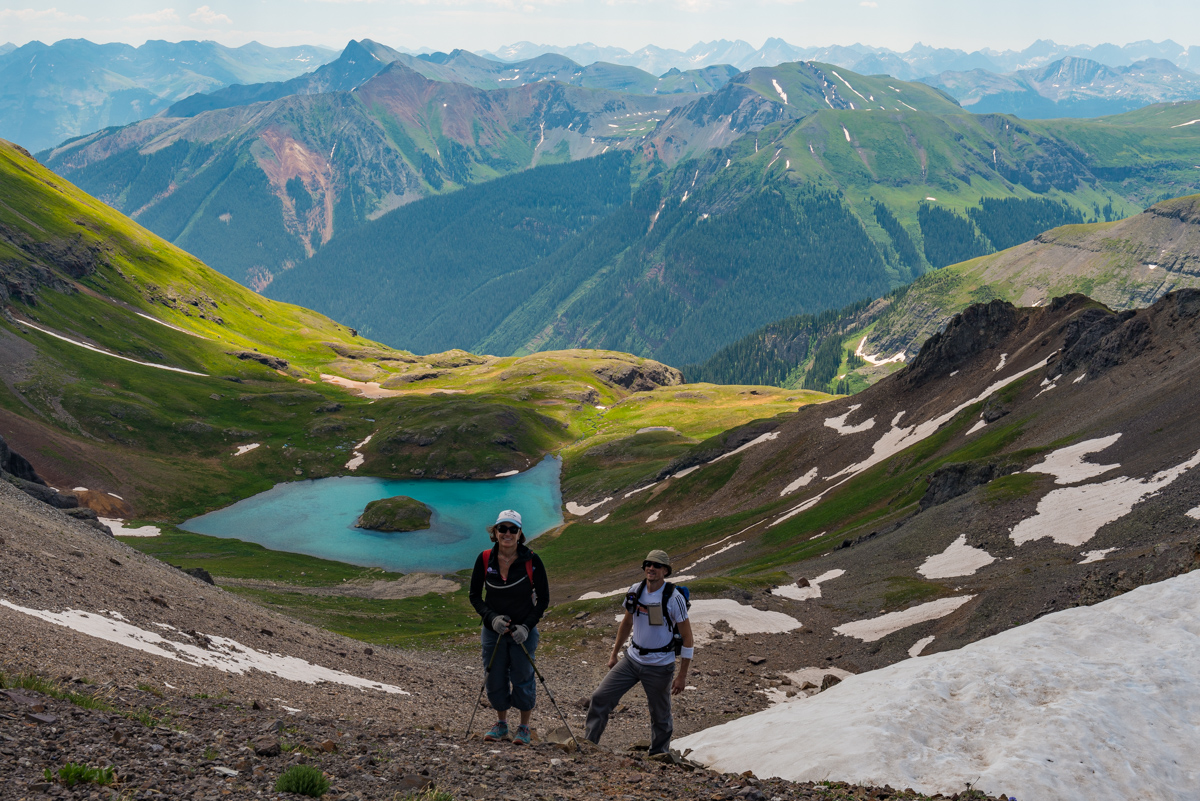
From the ridge we took a right turn and followed a very solid but slightly loose trail straight up the ridge. Here is a view looking down that ridge.
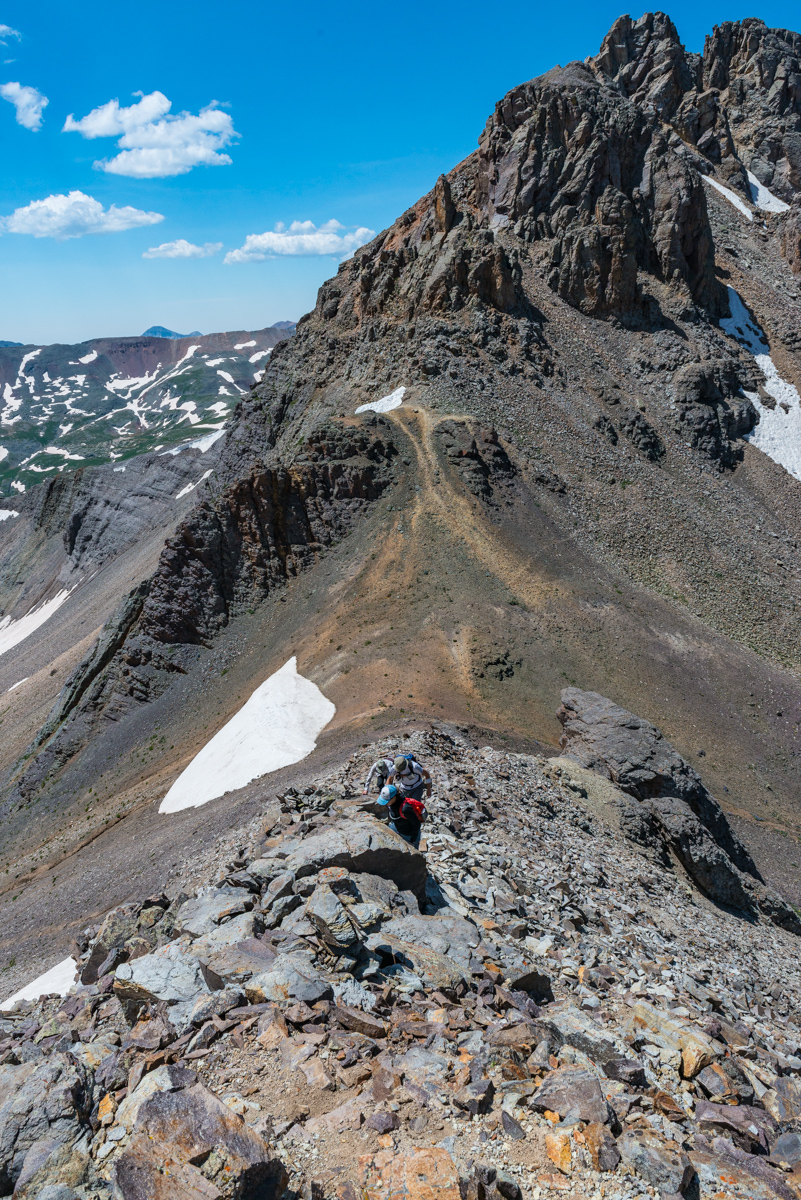
The view back down to Island Lake dominated my mind as we scrambled up the relatively easy class 2+ scree.
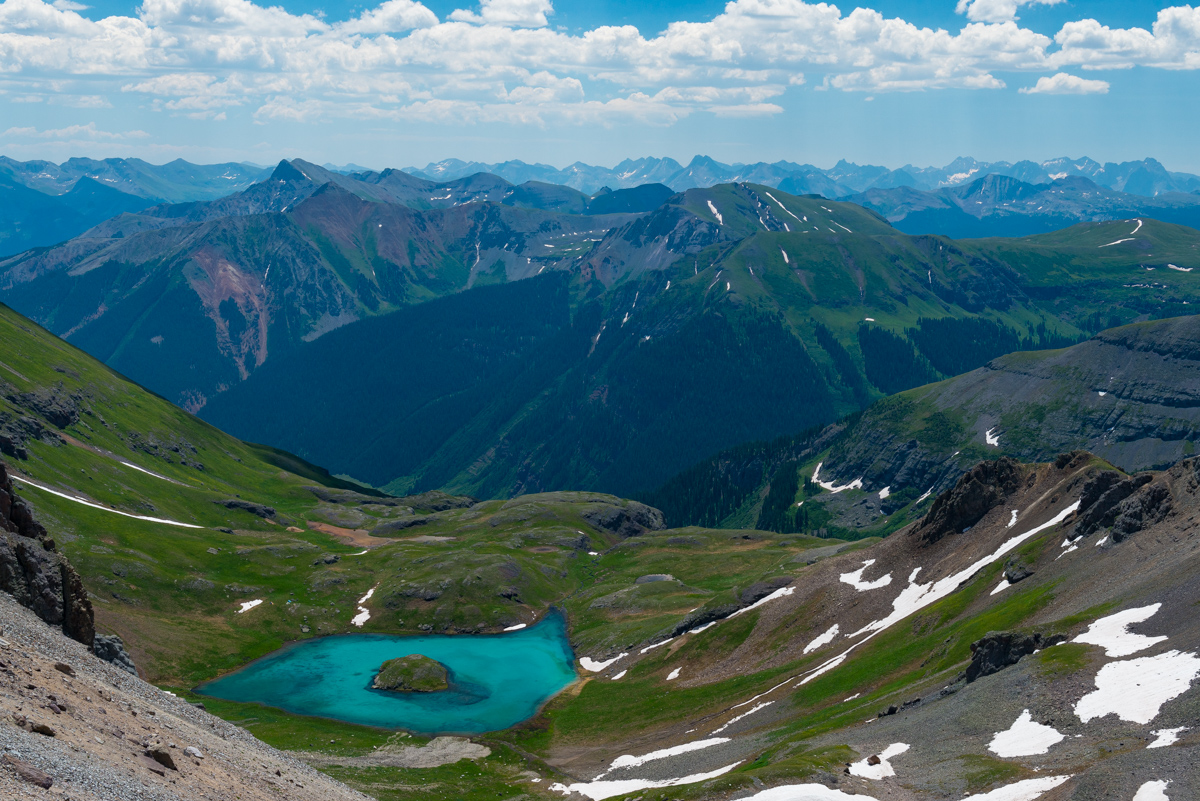
Eventually, looking back we could see Pilot Knob's gnarly summit block behind us over in Ice Lake Basin. The group continued the slog up the loose scree, which was pretty manageable.
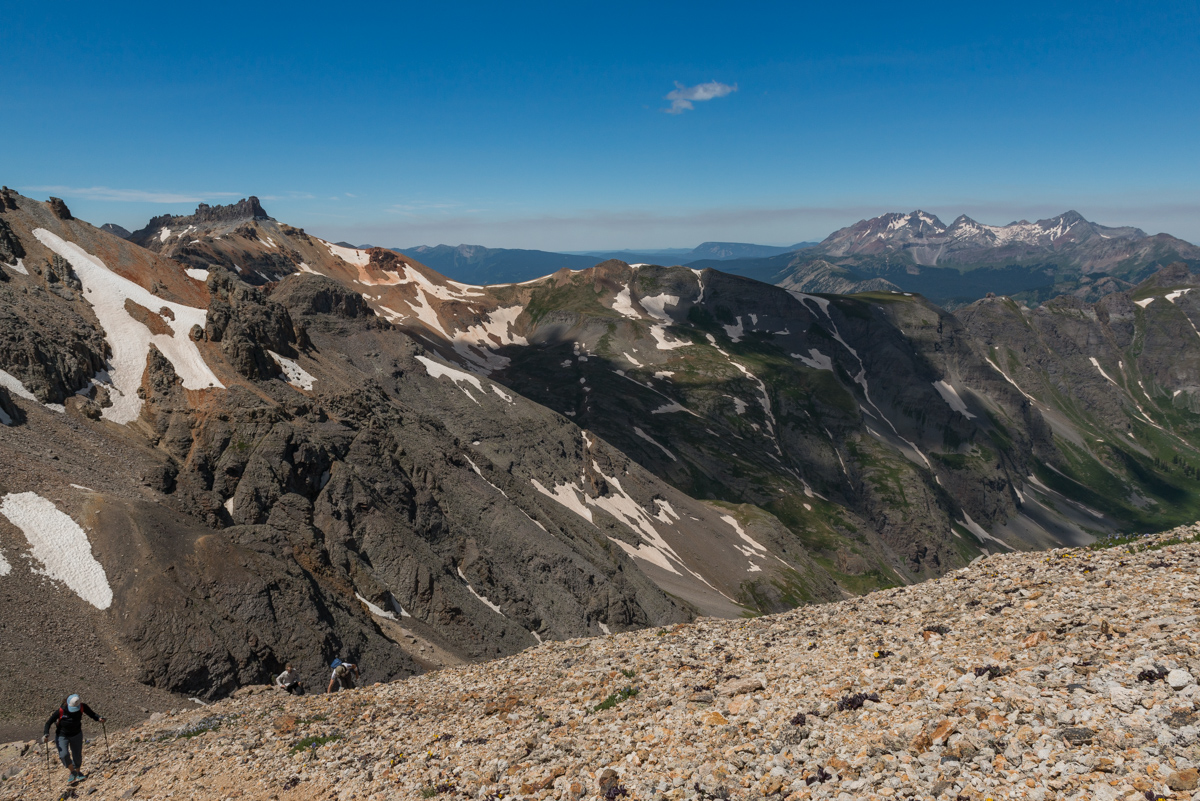
I live for this kind of terrain but I think my friends thought I was a little crazy for enjoying it. The rock was pretty much what you'd expect in the San Juans.
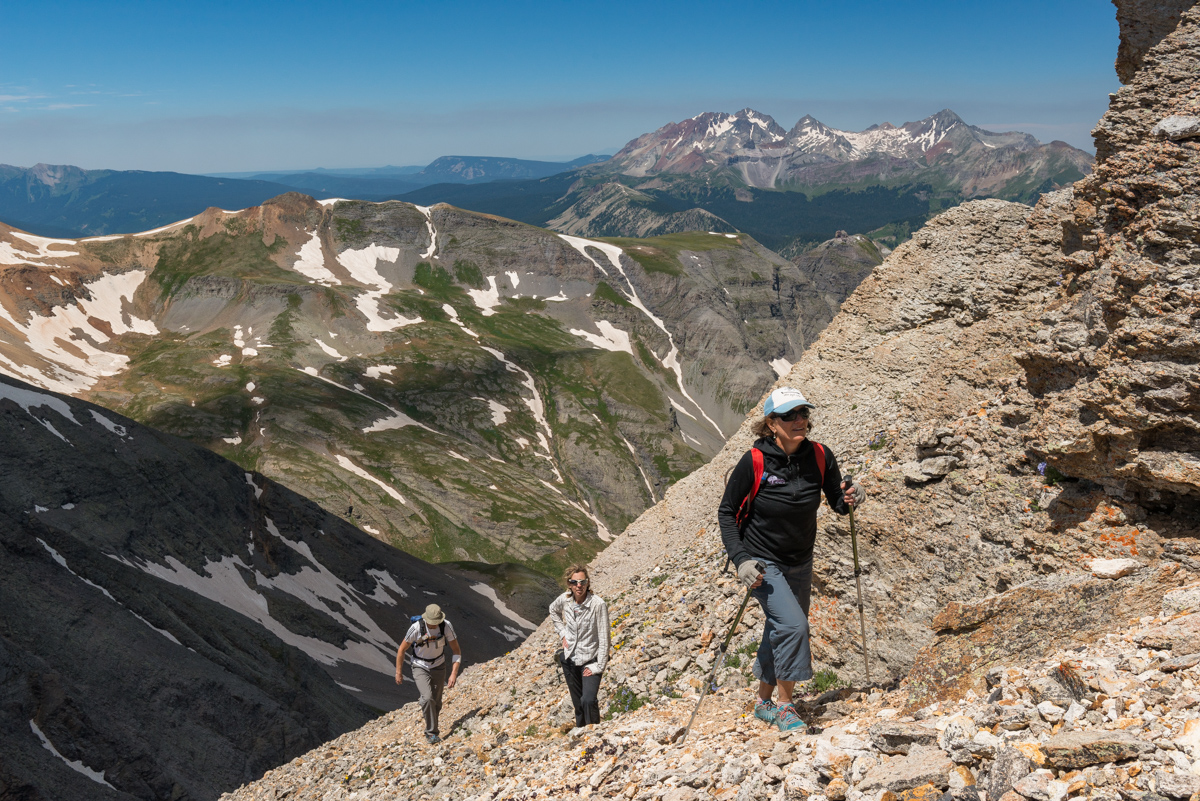
We eventually found ourselves in a steep orange gully with great hand-holds on the sides which was fairly loose. Sticking close to the wall made for pretty easy navigation.
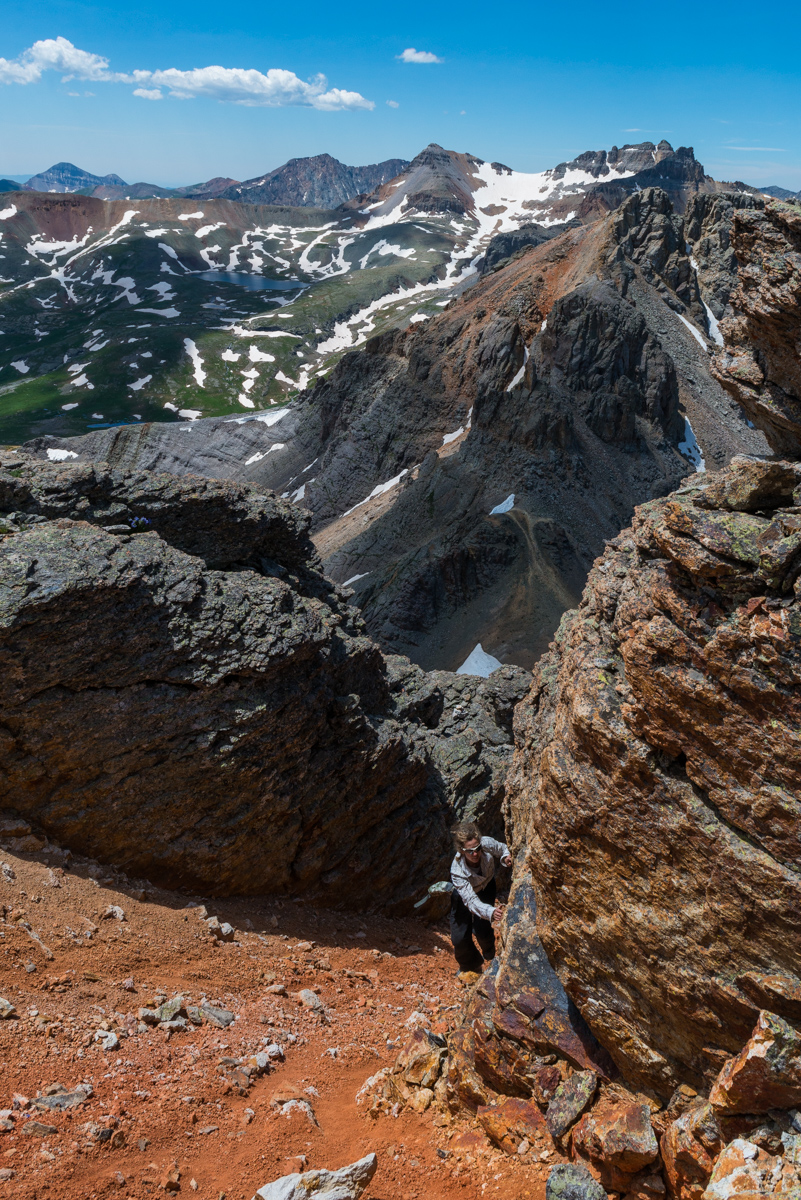
The full beauty of Ice Lake Basin presented itself as we gained elevation, showcasing both Ice Lake and Fuller Lake. The weather looked like it would hold for the whole day.
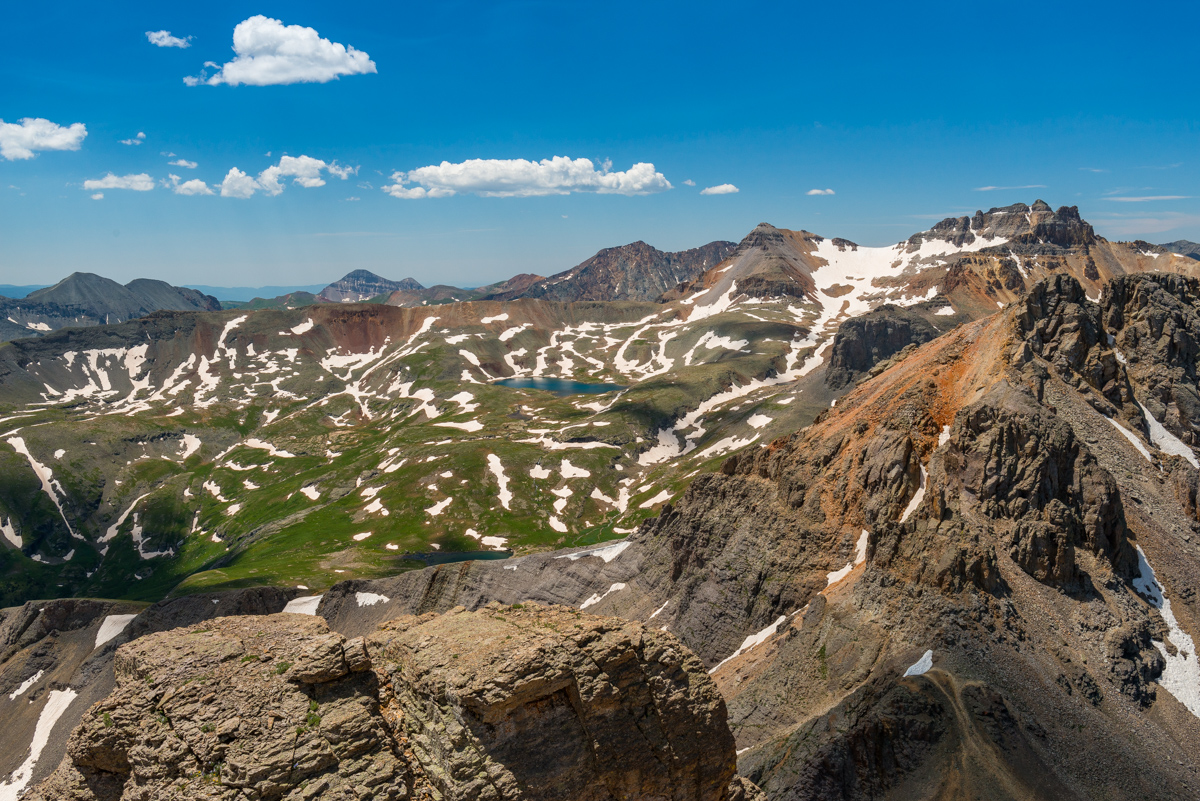
Honestly, I think I could have stayed up there for hours on end, taking in the views in every direction. It was just the reason I moved back to Colorado.
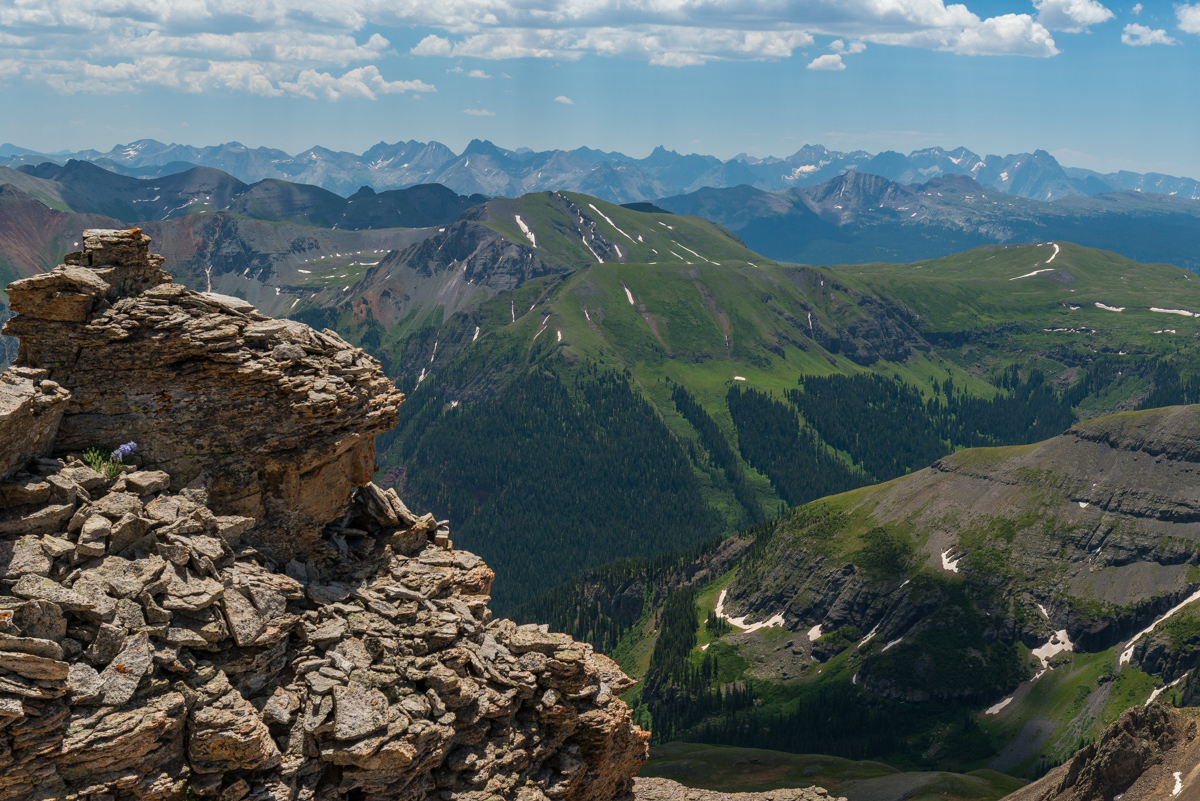
Island Lake pretty much stayed in view the entire way up, a nice beacon and reminder of just how high we had climbed in such a short amount of time.
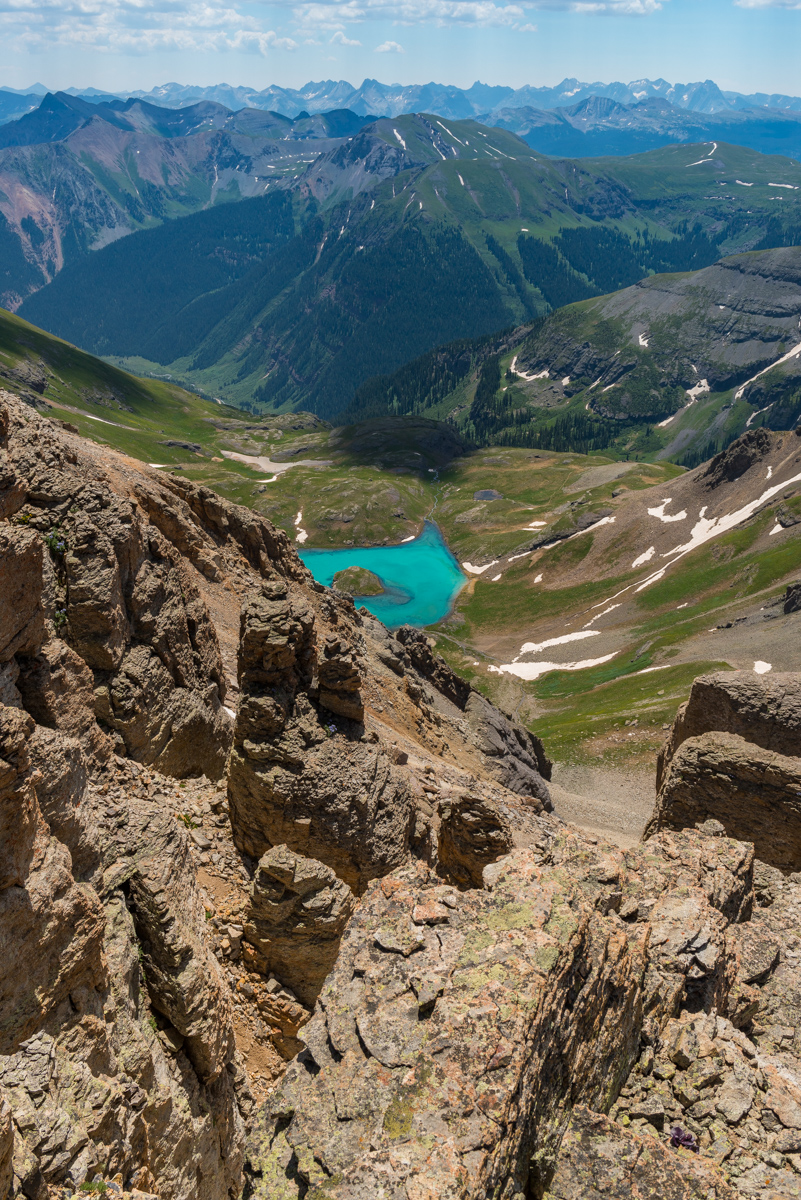
At last we reached the crux of the climb, which I had no idea existed. We got to this wall and wondered if we had taken a wrong turn or if we needed to go around, or, what? Upon close examination I decided it was the only way up. It consisted of three or four relatively exposed moves up to a small ledge, which wrapped around to the right. I went first and Ellen decided to join me. Todd and Autumn decided to stay behind because it looked too difficult.
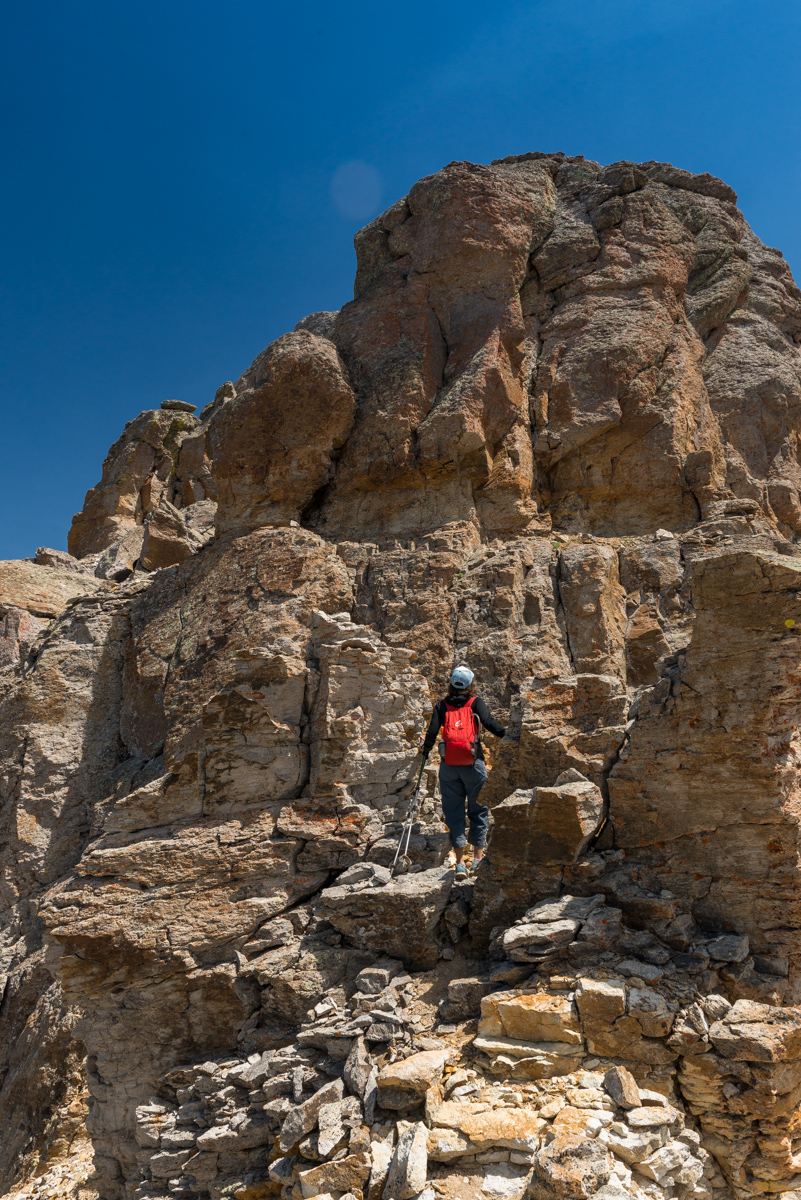
When Ellen and I got to the top, about 3 minutes later Todd and Autumn joined us - we were so excited that they decided to come up the wall. Even though the shots are out of sequence, I thought it best to show how hard the wall looked, on our way down, with Todd and Autumn still needing to downclimb it (below).
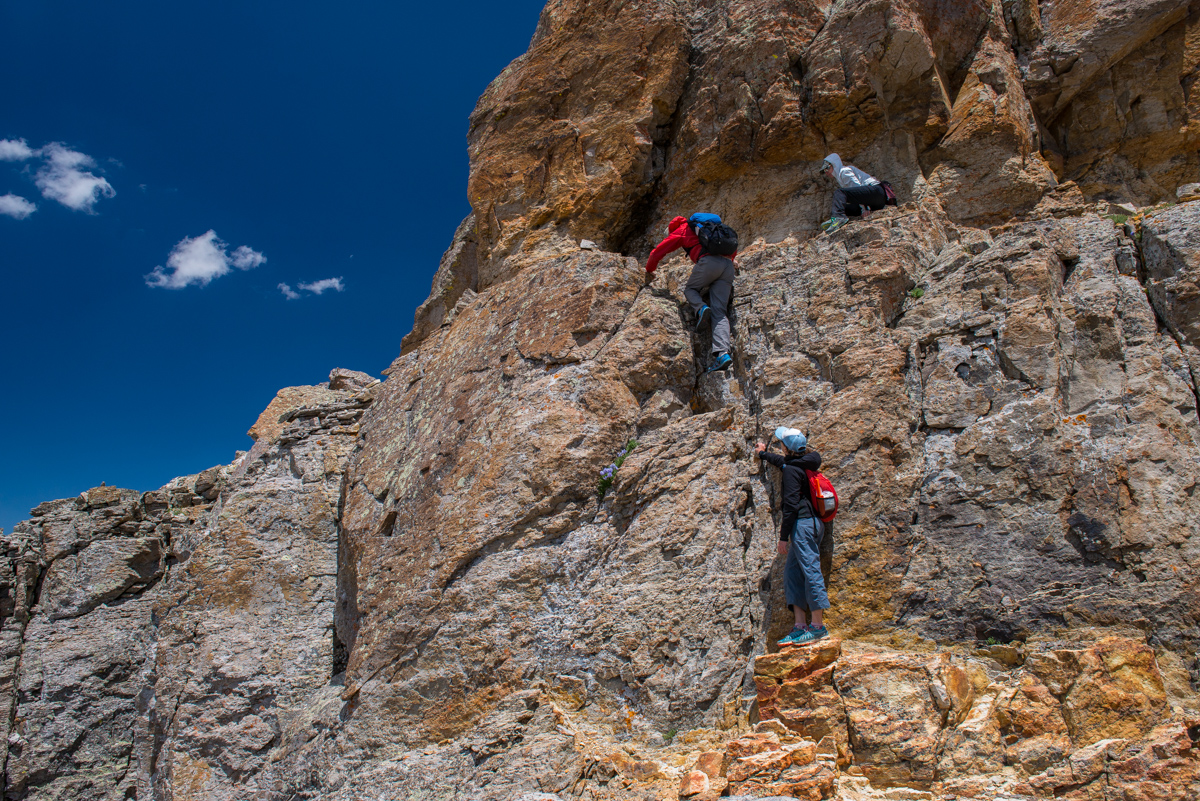
The top was magnificent. Here's Ellen topping out on a summit filled with purple wildflowers (their name always escapes me).
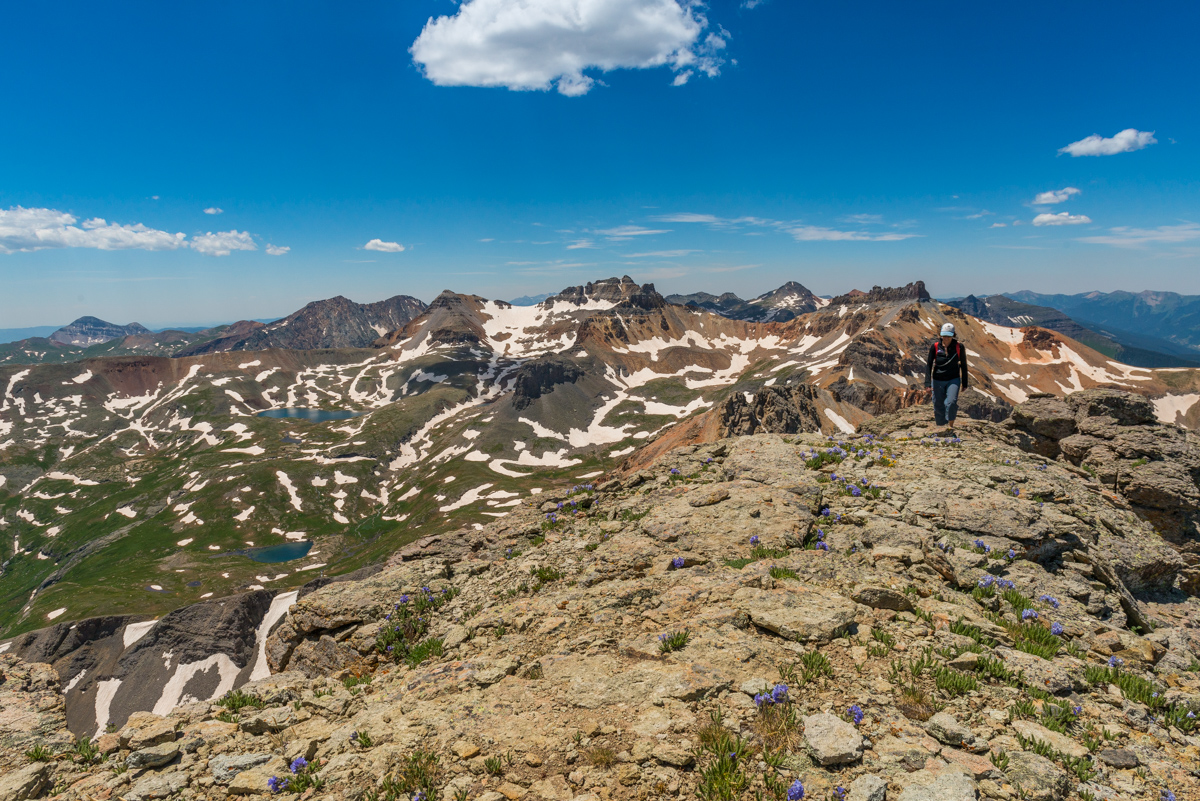
From the summit you could make out every major summit in the San Juans, including Uncompagre and Wetterhorn (top center).
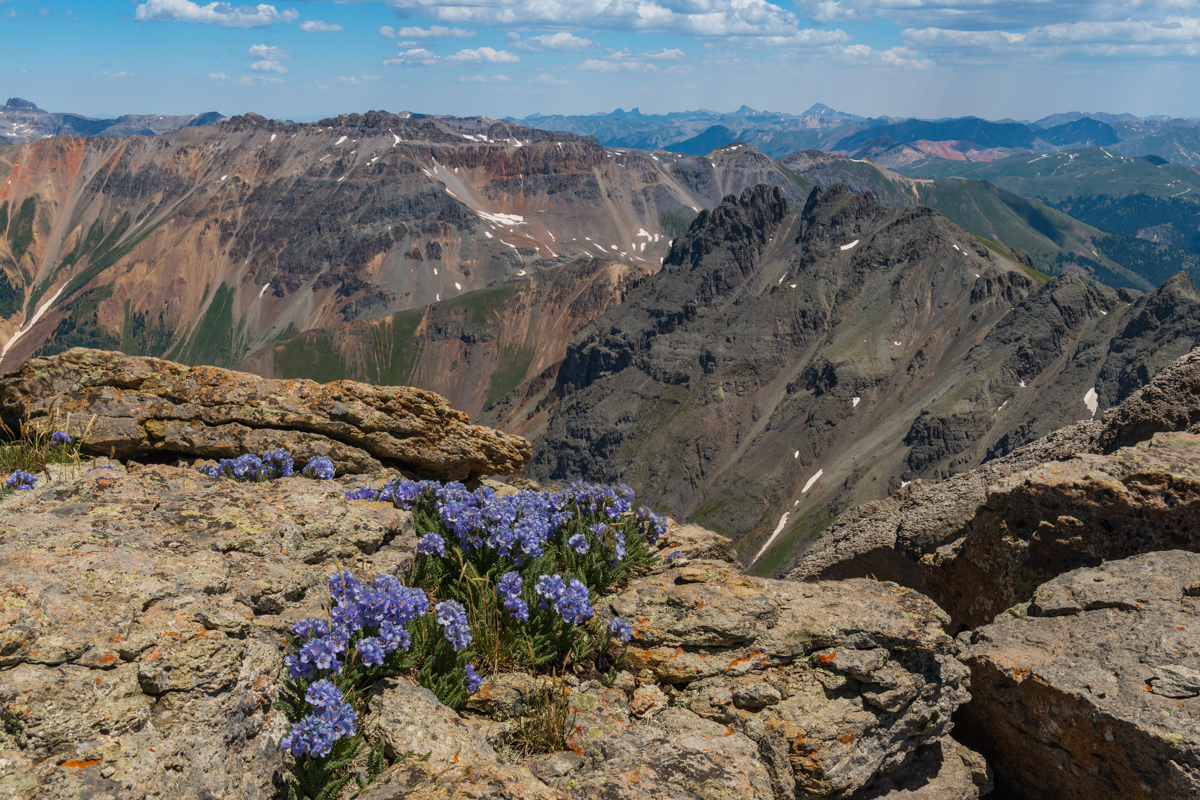
My gaze kept going back over to the San Miguels to the west. They were so damned impressive.
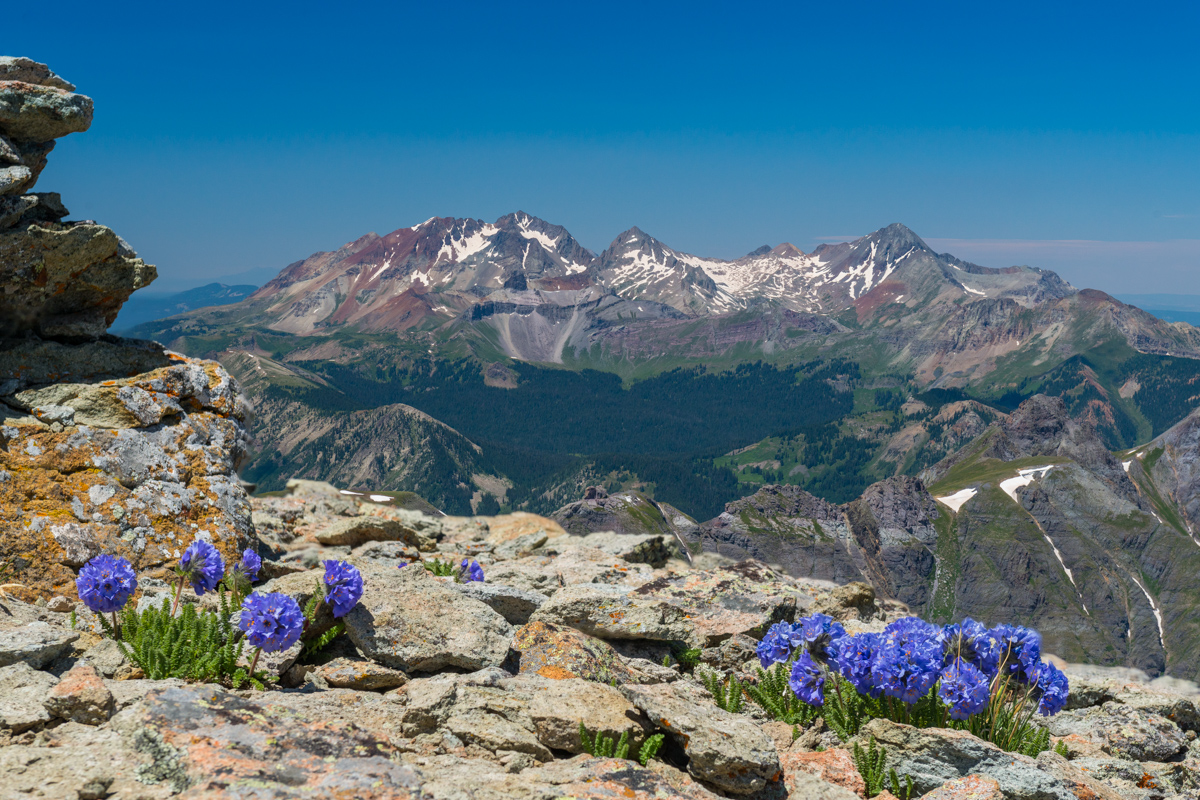
Next, a 180 degree view showing most of the San Juans and Ice Lake Basin, and Island Lake. So amazing.
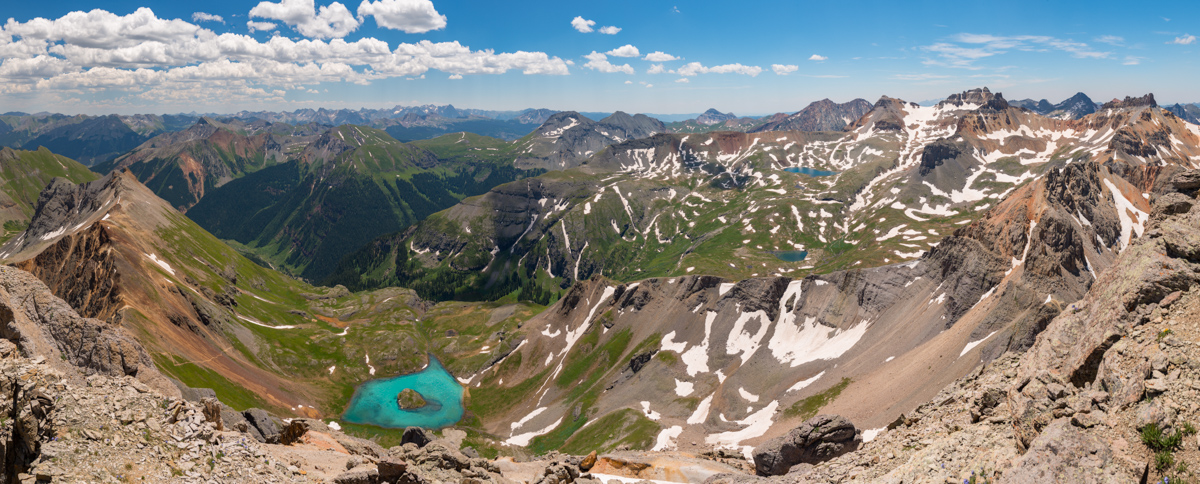
A quick group photo was in order, so I set up the tripod and self-timer. All I remember is that Todd invented a new food item on top - a burrito consisting of Peanut Butter, Fritos, and slices of apple. Apparently it was quite delicious.
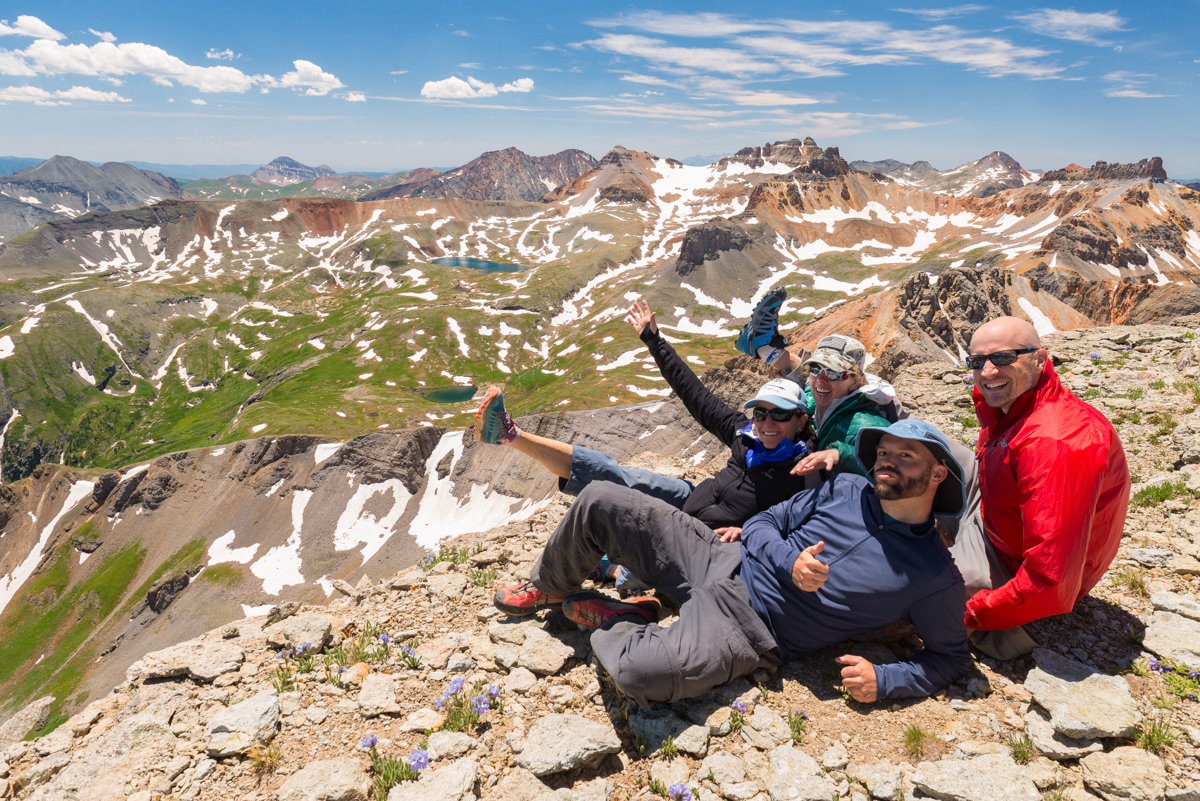
After enjoying lunch, we head back down, without any issues at all. We all faced-in on the crux and it was surprisingly easier than I thought it would be. Now, remember above where I said the lake was cold? When we were about 1/2 way down the ridge, I noticed a group of people huddled around our tents at the lake. I was not too concerned until I saw them open Todd's tent. My first reaction was, "what the heck are they doing, trying to steal beer or something?" I raced down the mountain at a quick pace and caught up with the group. As I approached they asked if they were invading our campsite. I replied, "well, yes, kind of...". They apologized and said that their son (probably about 14) had swam in the lake and was getting hypothermia and needed somehwere to lay down and warm up, and was that OK? I felt horrible for thinking they were doing something bad and replied, "of course not - not a problem at all, and that makes total sense!" The rest of our group arrived and we helped them ensure he had food and was warm before they departed the basin. We rested up and as the sun dropped lower and lower I decided to get the camera out and take some photos of sunset at the lake. It was a pretty nice one. The marsh marigolds and fireweed looked awesome.
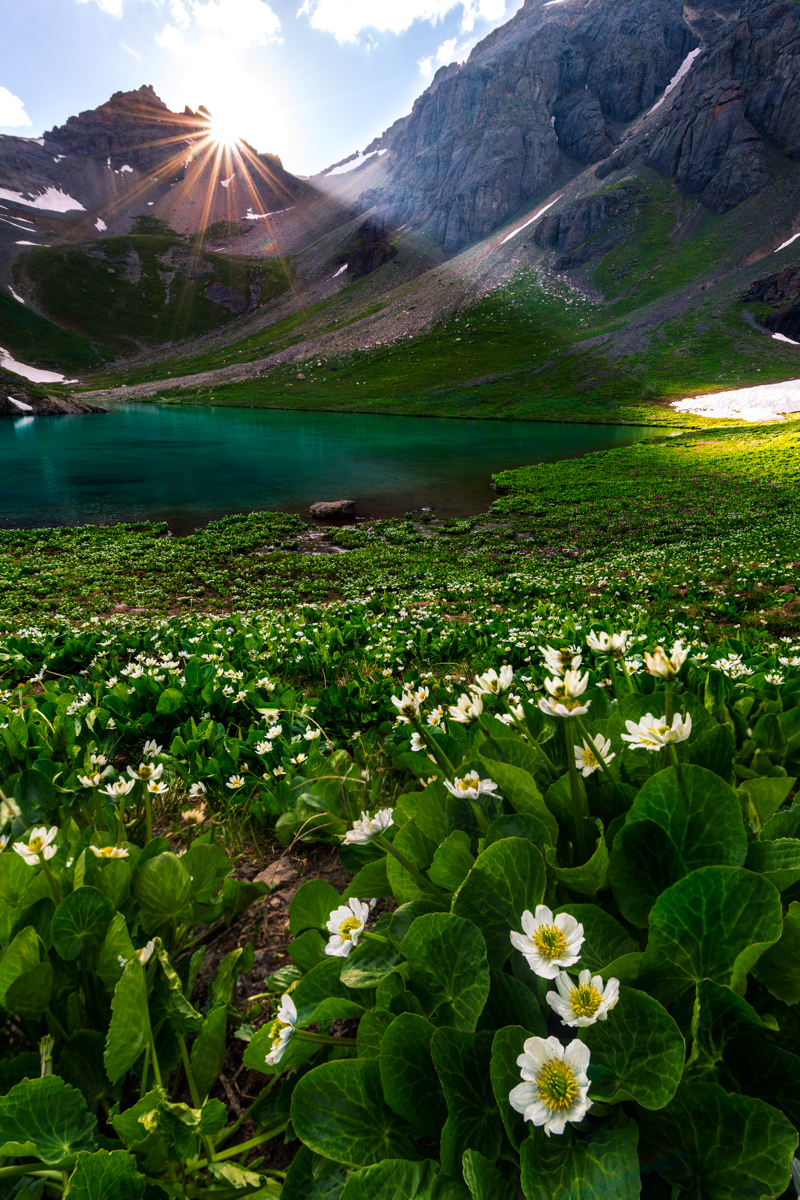
The last light left an impression on the fireweed that I knew would look fantastic in camera. I think I was right.
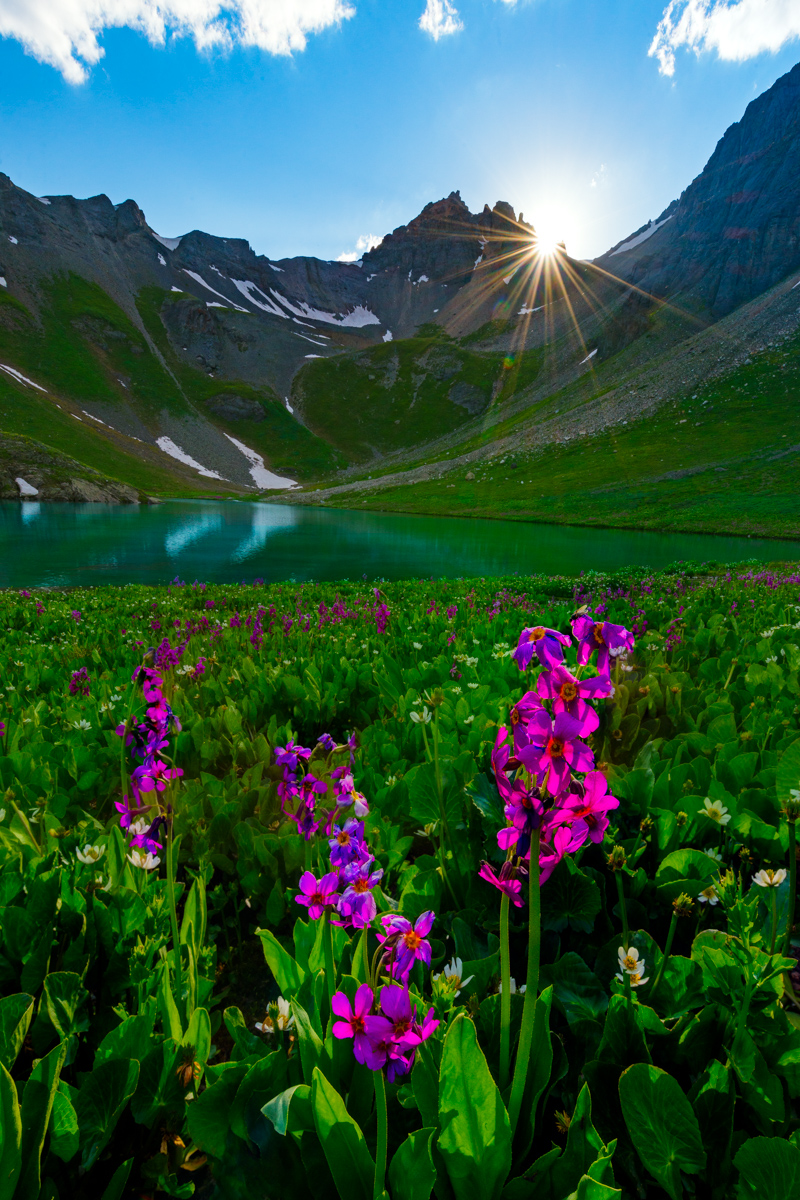
After dinner, I decided that I wanted to hike back up to the top of the grassy area below the ridge for U.S. Grant. I know that sounds crazy but I had a vision for some shots looking back over the lake at sunset. I hoped the clouds would stick around, and they were looking like they might, so I took a chance and hiked back up the mountain again. Todd thankfully joined me and kept me company. Unfortunately, the clouds did not cooperate much, but I think I still got some decent shots, including one with the nearly full moon in it.
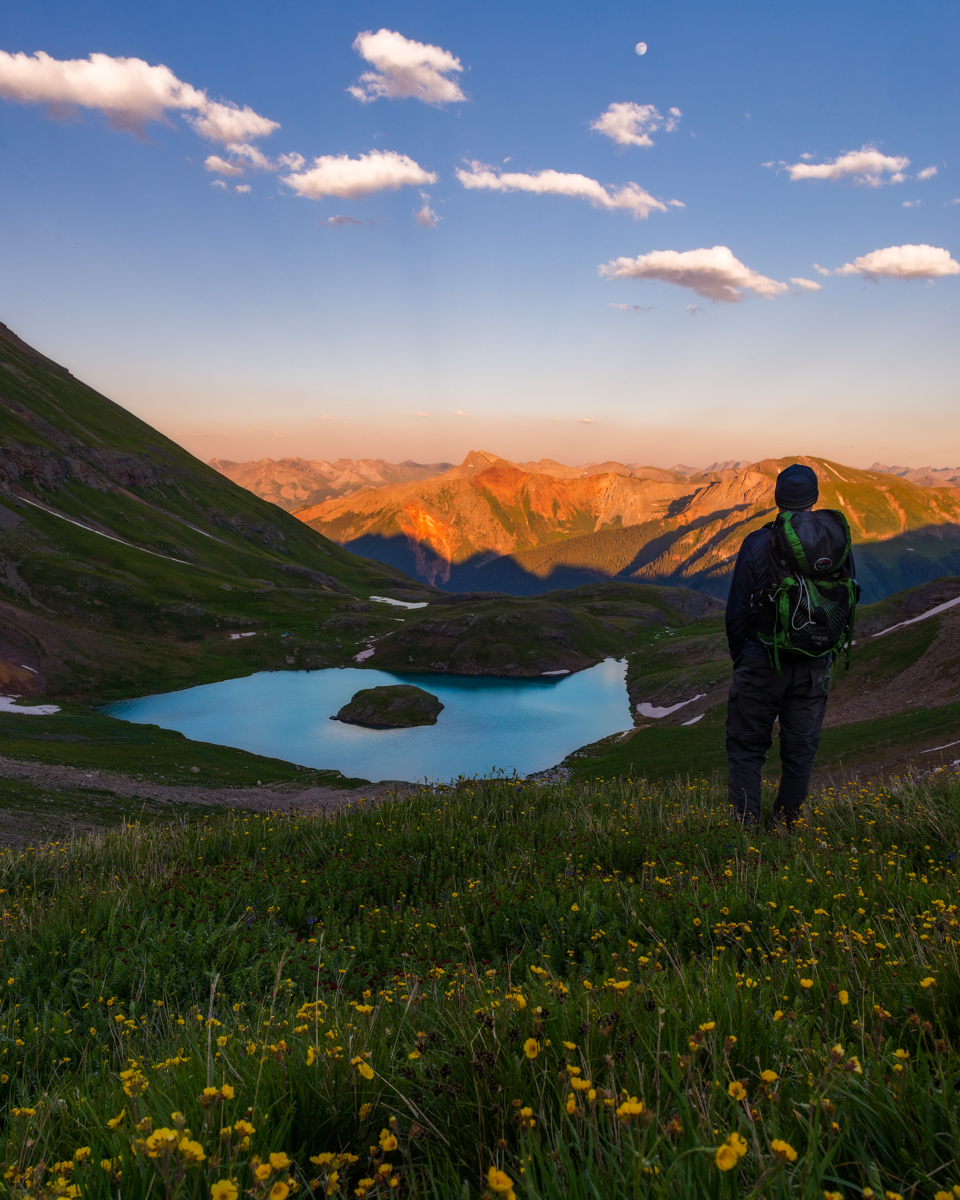
As the last light kissed the tops of the Chicago Basin 14ers, I took advantage and snapped off a two-row panorama to include the pink sky (which was a bit hazy from fire I presume), the lake, and some wildflowers.
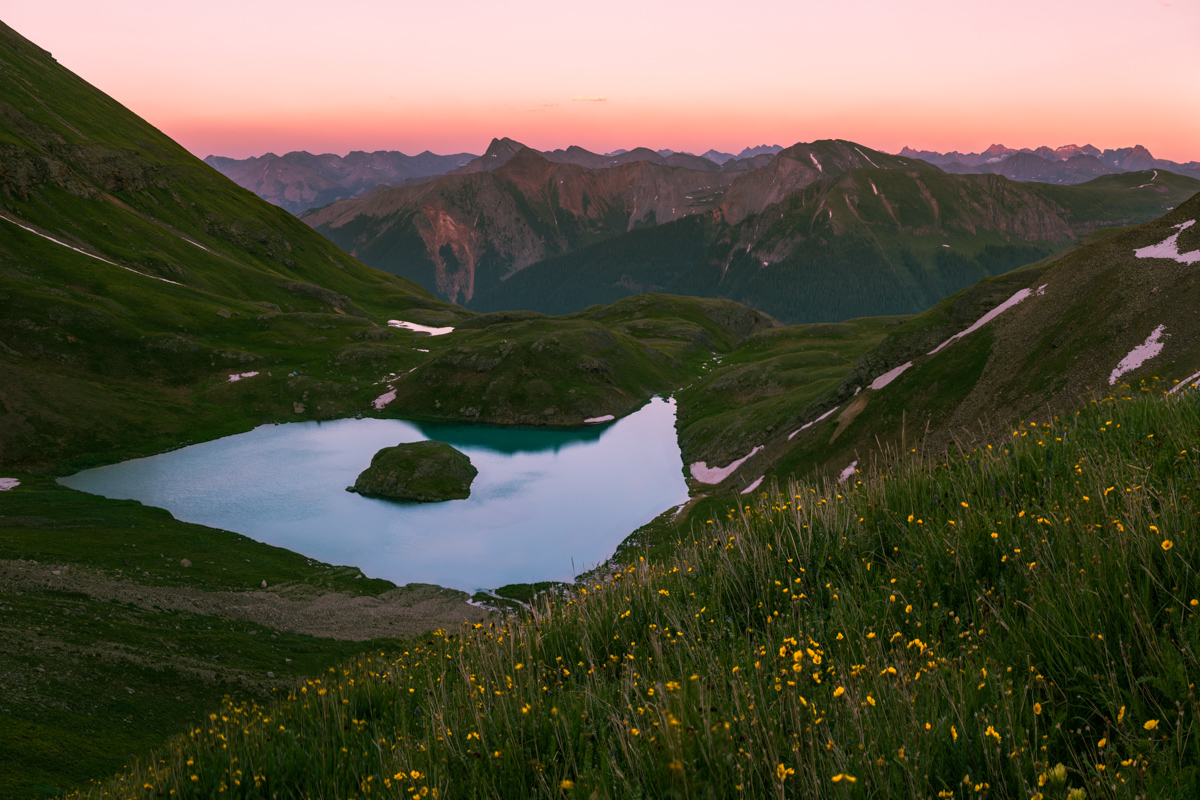
It was quite a memorable sunset, for sure. Flowers + sunset + Island Lake + San Juan Mountains in alpenglow = awesome.
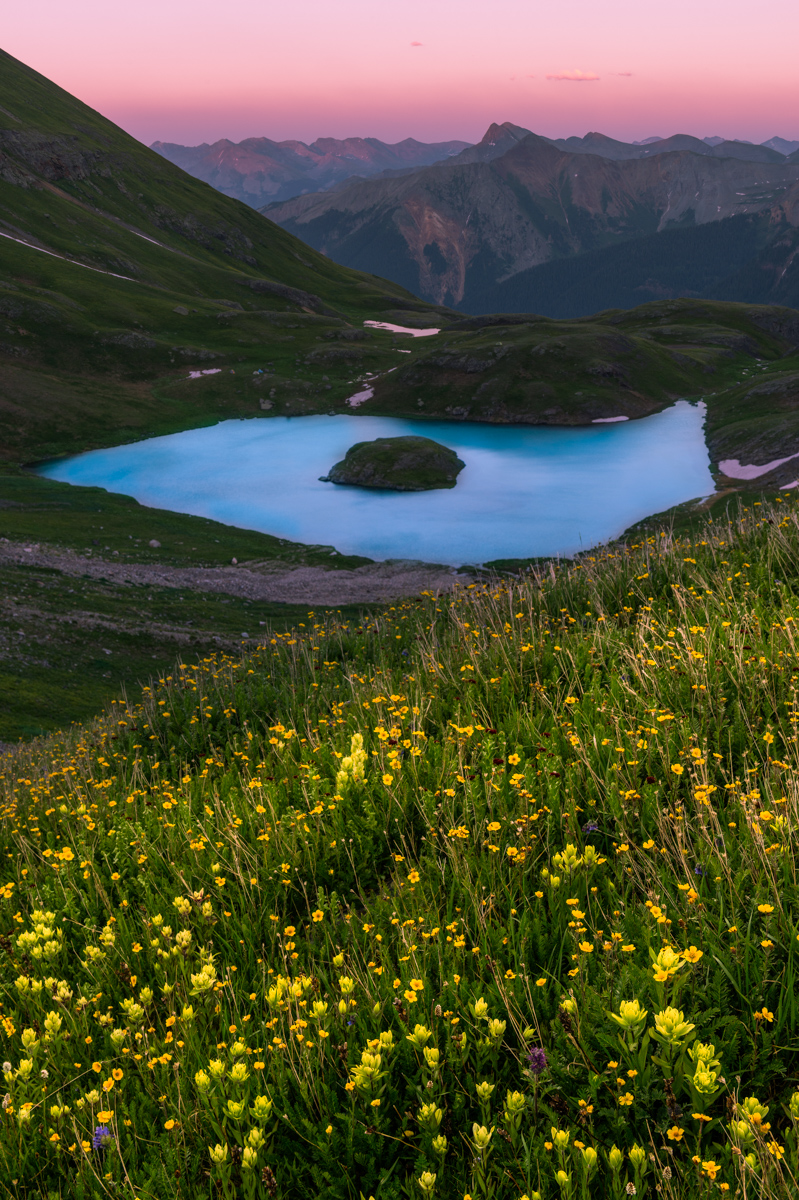
We head back down to our tents and got some much needed sleep. I never did make it over to Ice Lake for sunrise wildflower photos. Maybe next year! As a reminder, you can take a look at my GPS and/or KML file for this hike over on Gaia GPS. Prints of my photos are always available on my photography website (if you see one you like and can't find it, let me know). Thanks for reading!
Gladstone Peak and Wilson Peak from Bilk Basin - A Backpacking Trip Never to be Forgotten
Backpacking into the wilderness is an activity that is not easily surpassed. There is something about the raw nature of it all, like a tribute to our roots as human beings, which makes it such a powerful experience. Pair that experience with the ascent of two of Colorado's more challenging Centennial peaks, all while being with one of your favorite humans on Earth, and you have yourself a recipe for unforgettable memories. When my friend Silas asked me to go with him to climb Wilson Peak and Mount Wilson again, I knew we would be in for an adventure to remember. Even though I'd already done both Wilsons already, I welcomed the opportunity to help to help him finish off the 14ers, just like he had with me on Pyramid Peak in 2012. Silas and I have done a lot of hiking and climbing together - I counted that this was our 18th summit together since 2011. When I met Silas in 2011, he went by Sarah and had recently had a suicide attempt. Since then, Silas has really turned his life around - he got married, he had a child, and he has made a successful career as a non-profit badass. I'm still getting used to the idea of calling Sarah by Silas, but it is growing on me quickly.
Our hike started with Silas telling me about the recent development of not feeling comfortable in his body as a woman and wanting to transition to a man. At first I was really skeptical just as his wife was; however, when Silas told me after our trip that the decision was official, it washed over me and made me smile. No matter what, I love this person for who they are, man or woman, and really, it just does not matter one bit. Anyways, my guess is that you're here to read about climbing and not Silas, I digress.
I enjoyed the short drive to Telluride from my new home in Durango. It felt so awesome to be so close to the best climbing and wilderness in the state!
We both eventually agreed on an alternative route into the area since I'd been up there via Navajo Basin and the Rock of Ages Trailhead already and wanted to try something new... plus Bilk Basin offered stunning views of Lizard Head Peak to the south and east and by my calculations offered some pretty amazing photographic opportunities since the Milky Way would be rising behind Lizard Head Peak. So, we settled on Bilk Basin via the Sunshine Mesa trailhead. This trailhead was not terribly hard to find using both Roach's 13er guidebook and other online resouces. Silas met me in Telluride and we drove up to the trailhead together.
For this particular trip, I opted to bring my Nikon D800, my Nikon 14-24 f/2.8 lens, and my Nikon 24-70 f/2.8 lens. I felt like those two lenses would cover the ranges I'd want to be shooting on this trip, even though they were both quite burly. Nothing really beats the 14-24 for night photography. I also decided to bring my new GoPro 4 with me to shoot some footage using my helmet mount during the ascent of Gladstone. Additionally, I know it sounds crazy, but I'm on my 3rd pair of the La Sportiva S EVO Trango boots - they are so good for mountaineering in Colorado - really there is not a better boot for me and my feet in my experience. I love the higher rubber on the sides because they protect my feet during difficult scrambles and I know I can step anywhere with confidence, plus they are super lightweight. You can pick up a pair from Bentgate, a great local Colorado gear shop.
The hike up into Bilk Basin was pretty outstanding - I really enjoyed this approach and think it is the best of the three that I've done into this area.
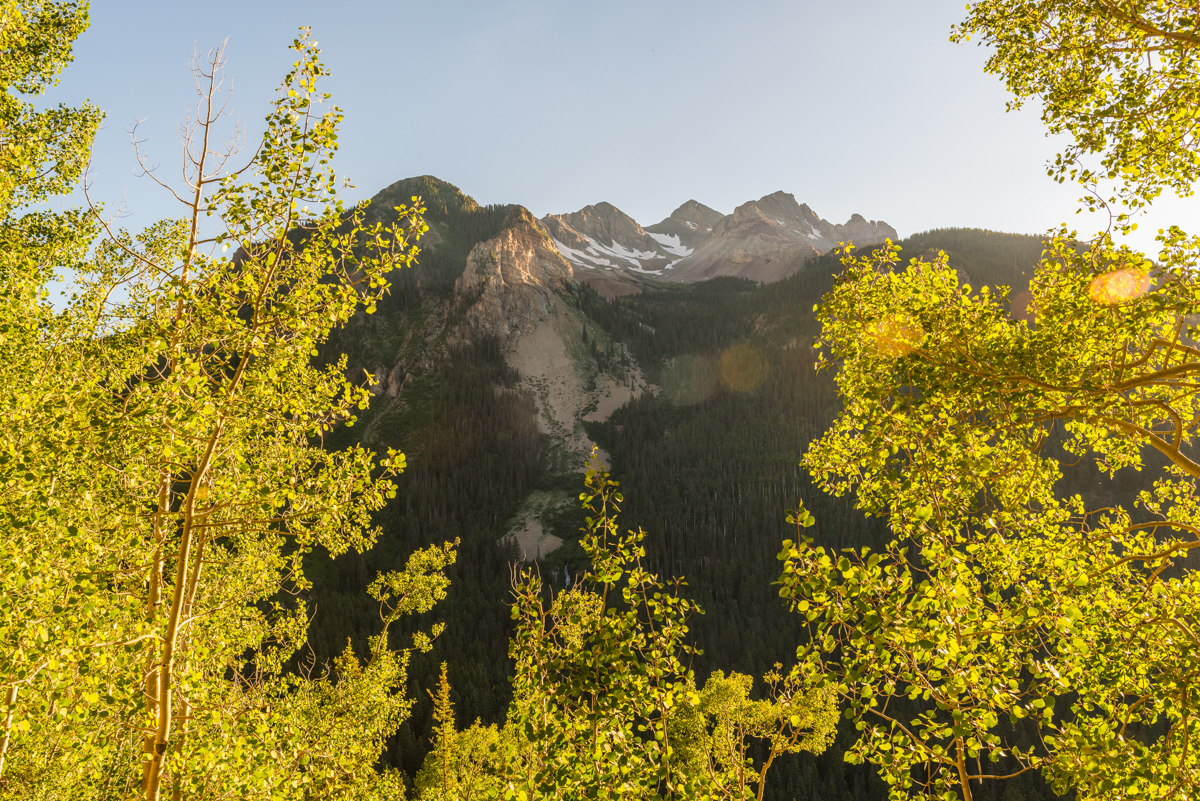
The trail was very full of wildflowers and interesting features like this crazy tall flower.
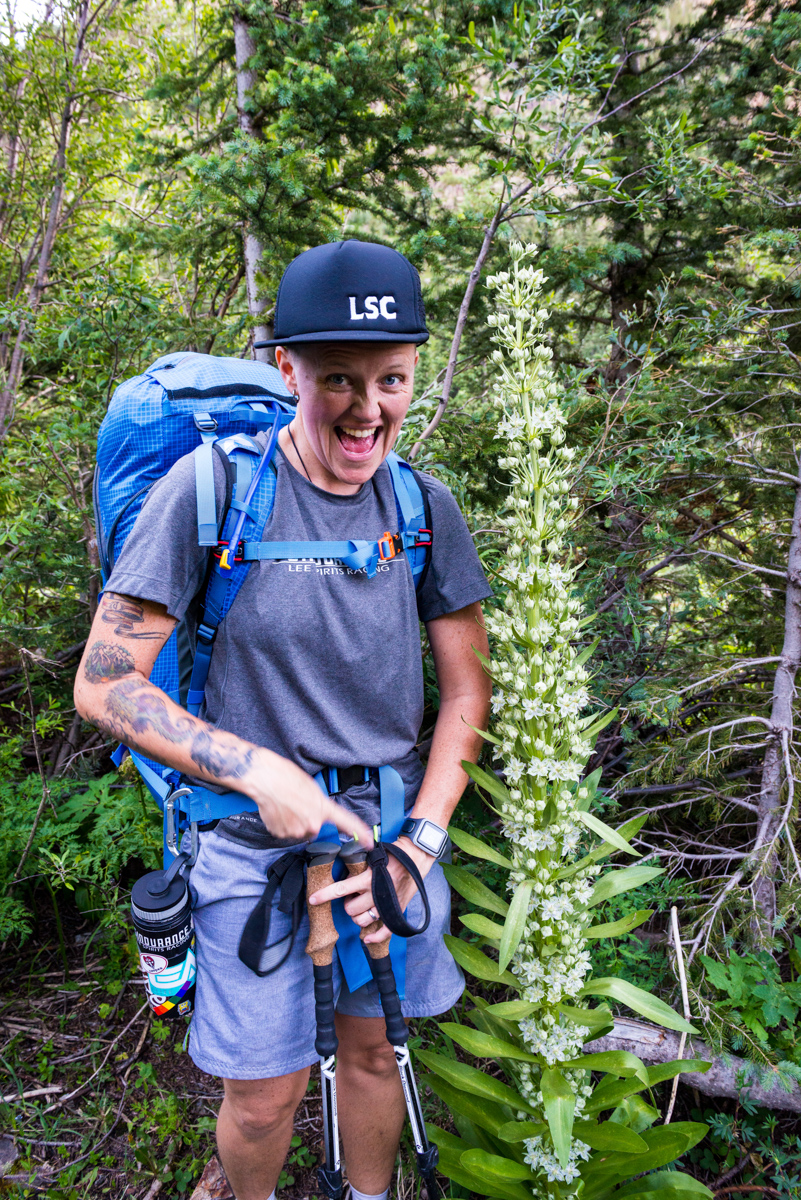
About 1/2 way up the Basin we encounted a stream crossing, which was not in any of the guidebooks to my knowledge. The location of the crossing was right after some old abandoned mining buildings, which I had read about before and seen on the USGS Topo map.
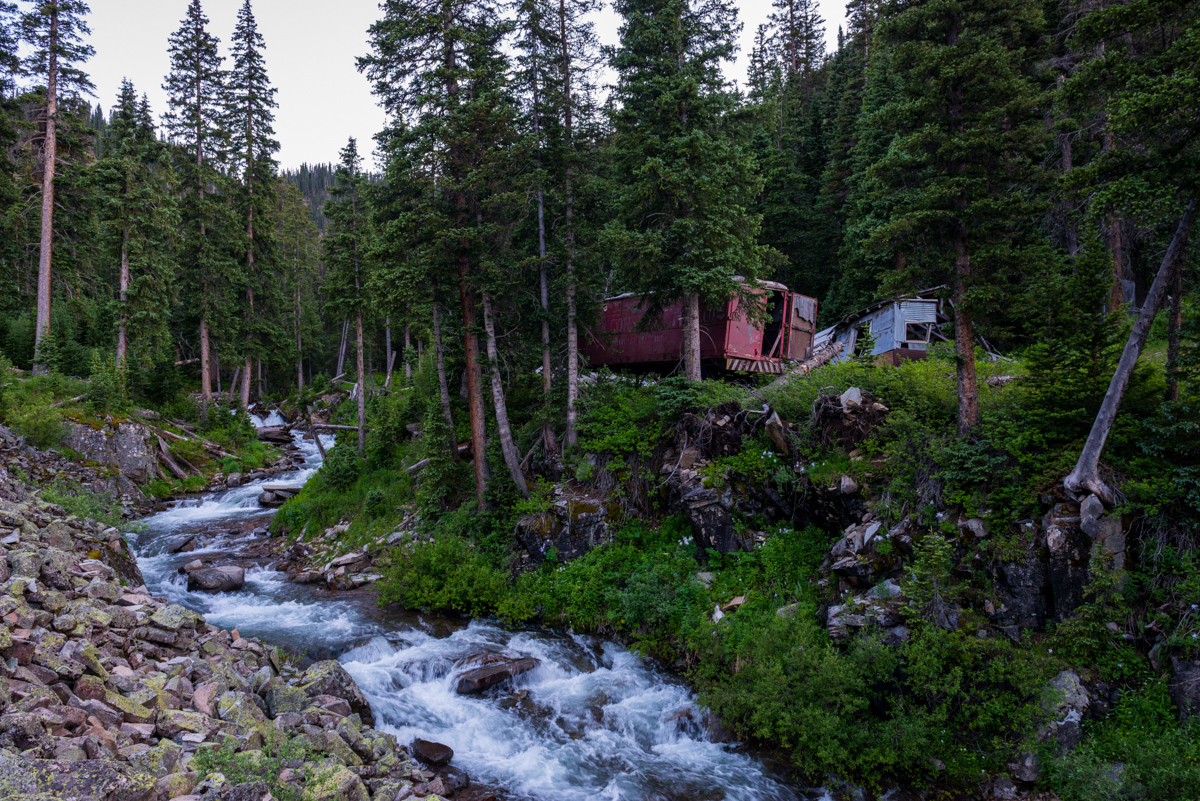
Instead of crossing the creek where it made sense, I wondered if the trail kept going higher since I had not read about the crossing. We ventured up into the valley further and even found ourselves on the creekbed, but eventually did decide to head across where the log dam was at after the mine.
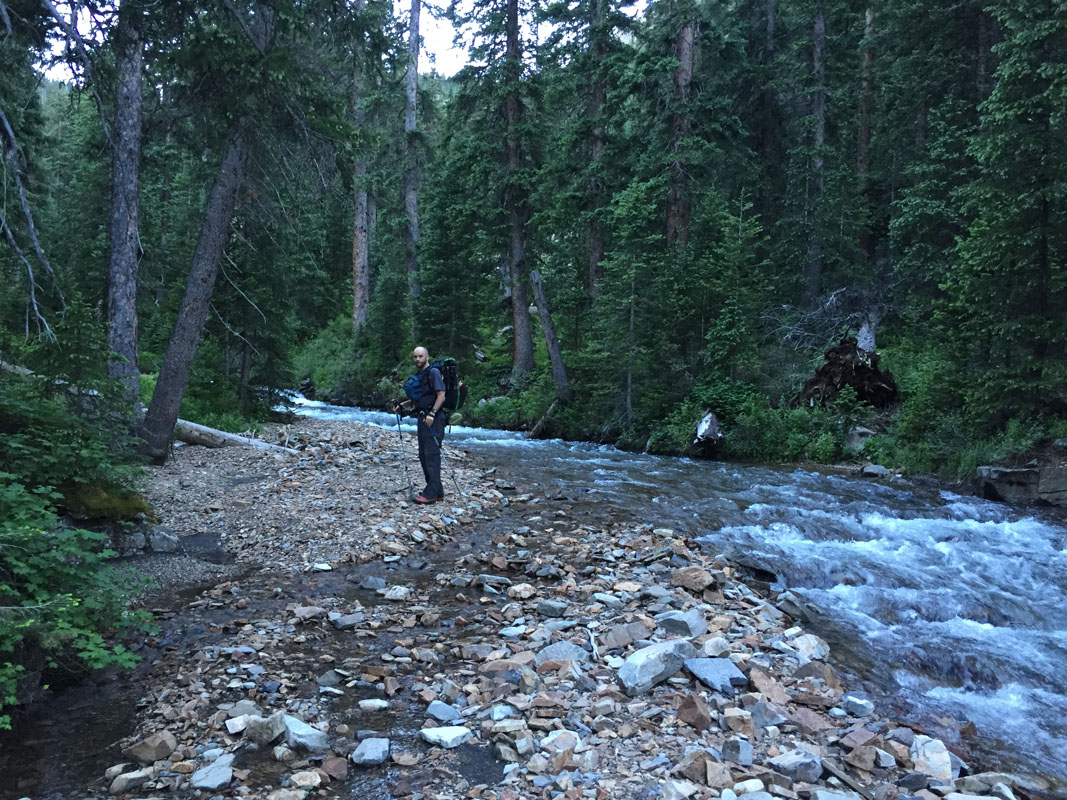
It was a pretty easy log jam crossing, and it reminded me of the log jam at Snowmass, except not nearly as insane or difficult. I went first as Silas photographed me.
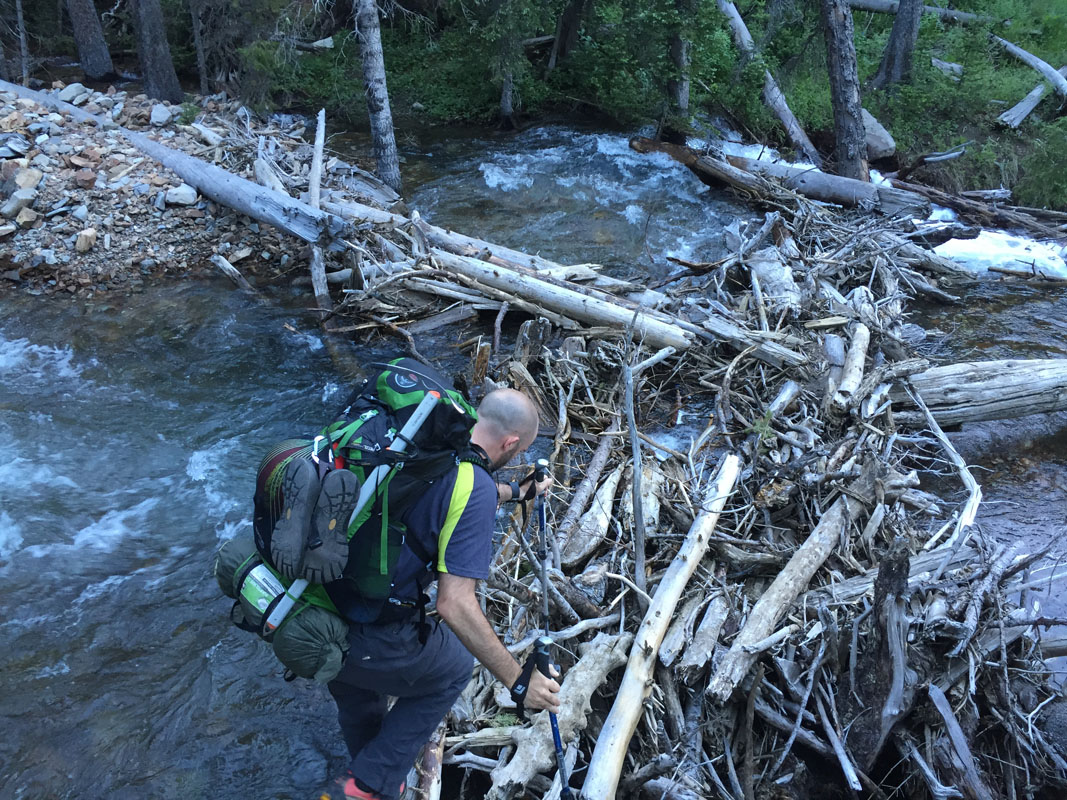
And then Silas followed. It was a bit tricky dropping down onto the logs but in the end it was no problem at all.
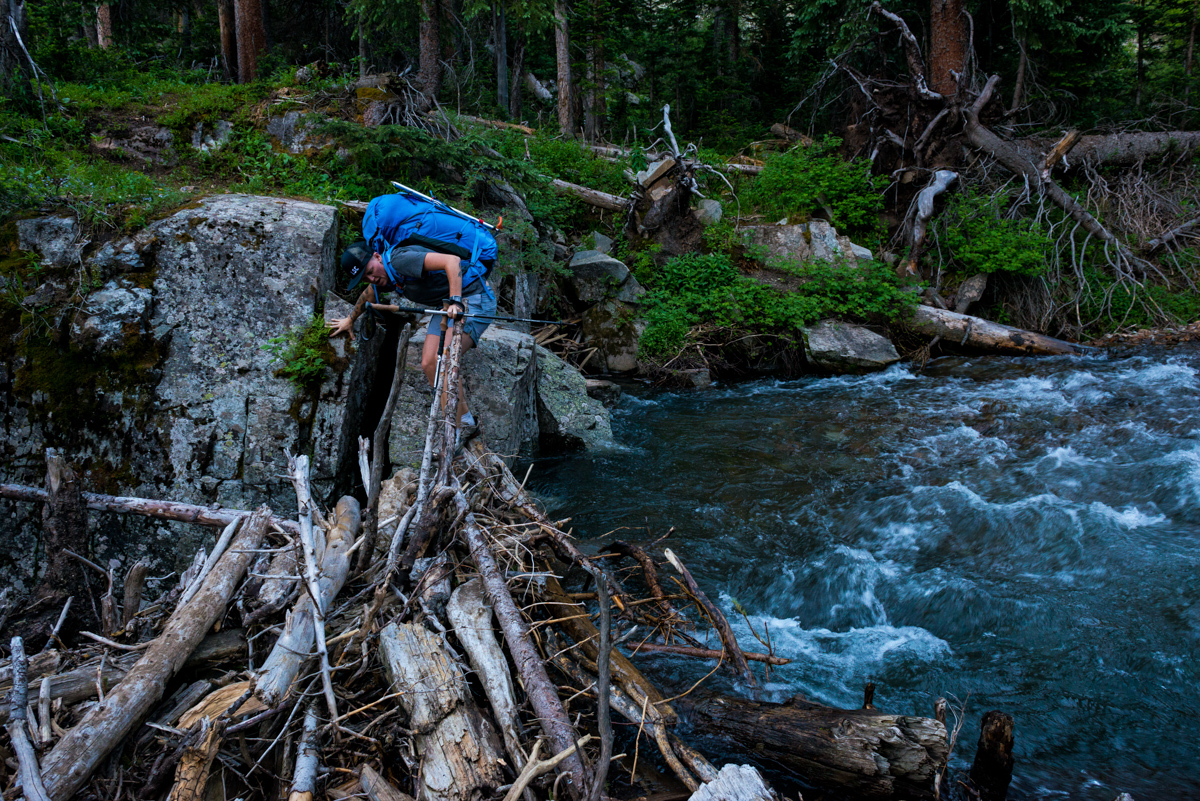
The early evening light was quite nice paired with the dark forest and the aquamarine creek.
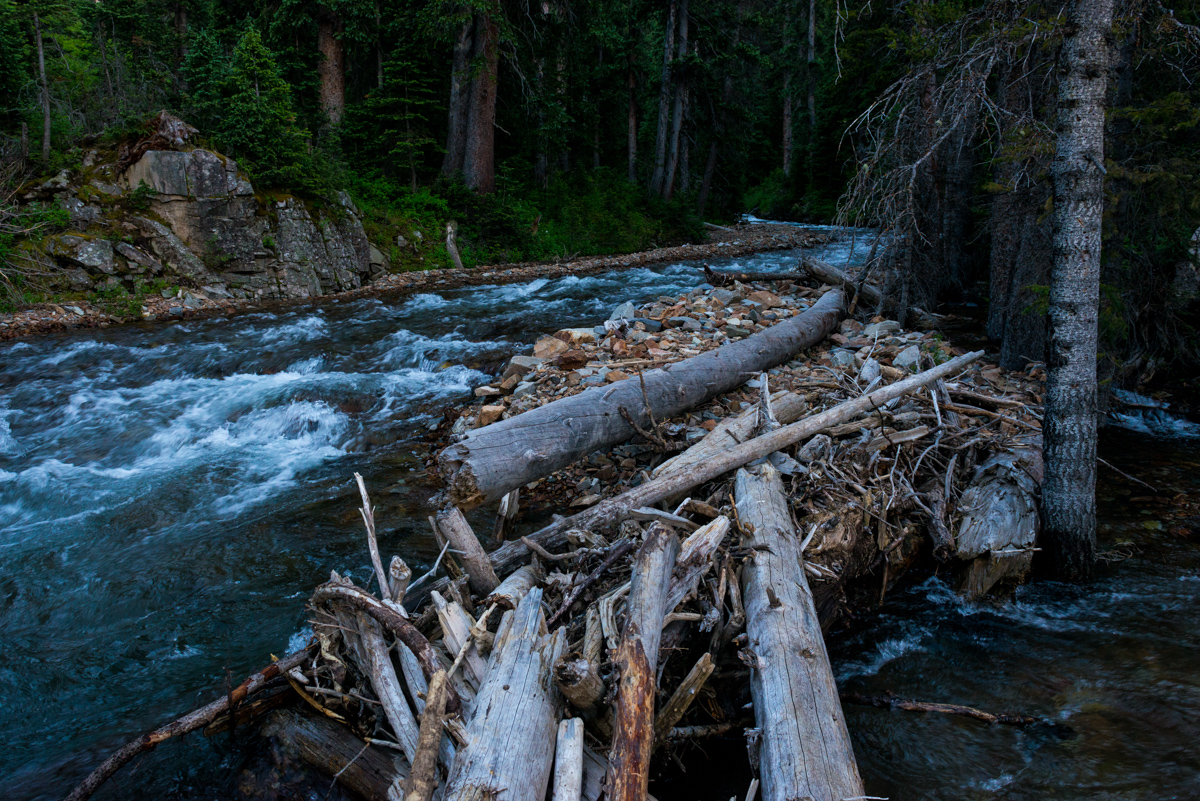
Ahhh... Wilderness.
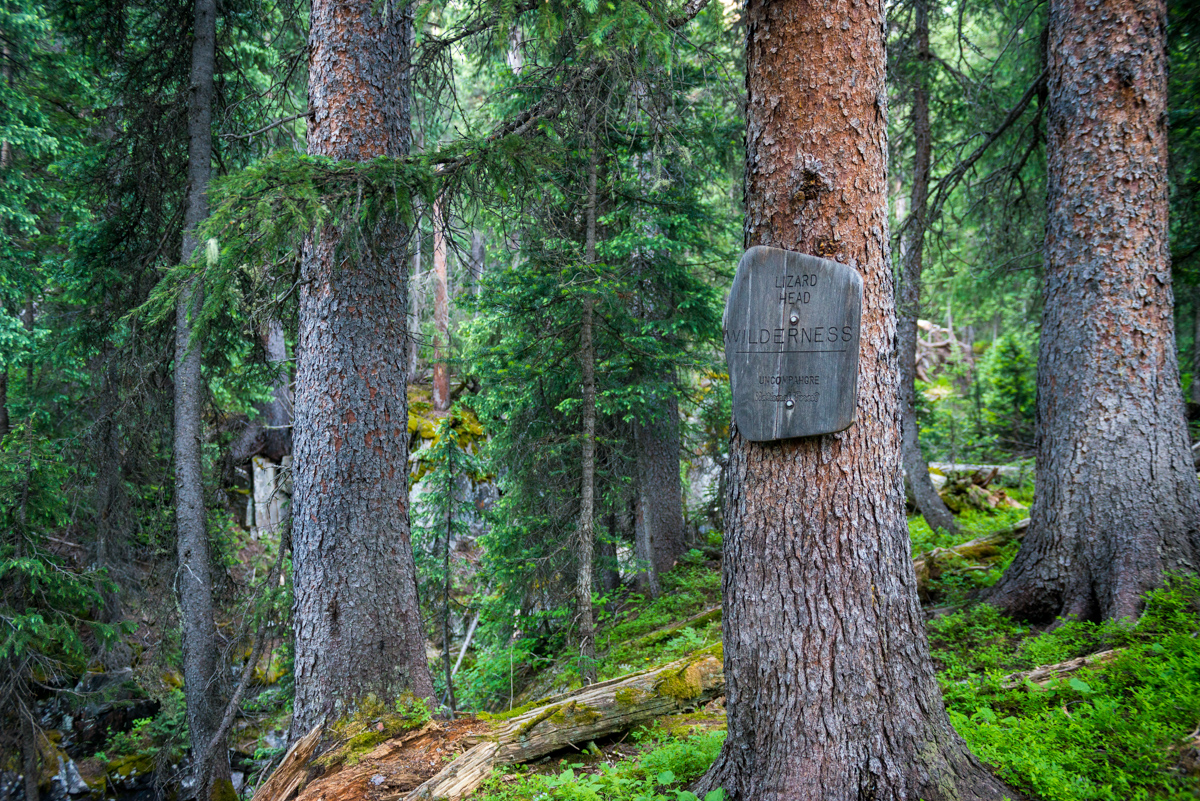
After crossing the creek, the trail was very straightforward, following the creek until eventually going up some switchbacks. The evening light was lovely.
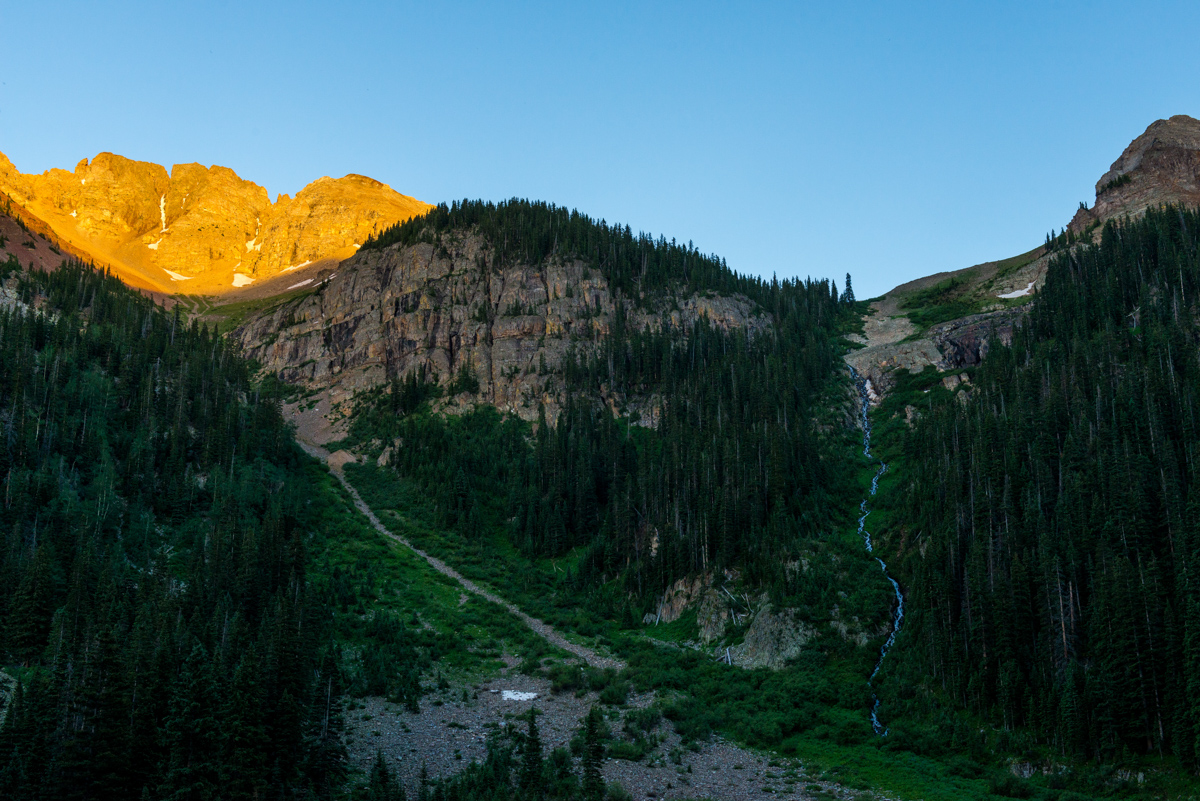
Silas enjoyed the view.
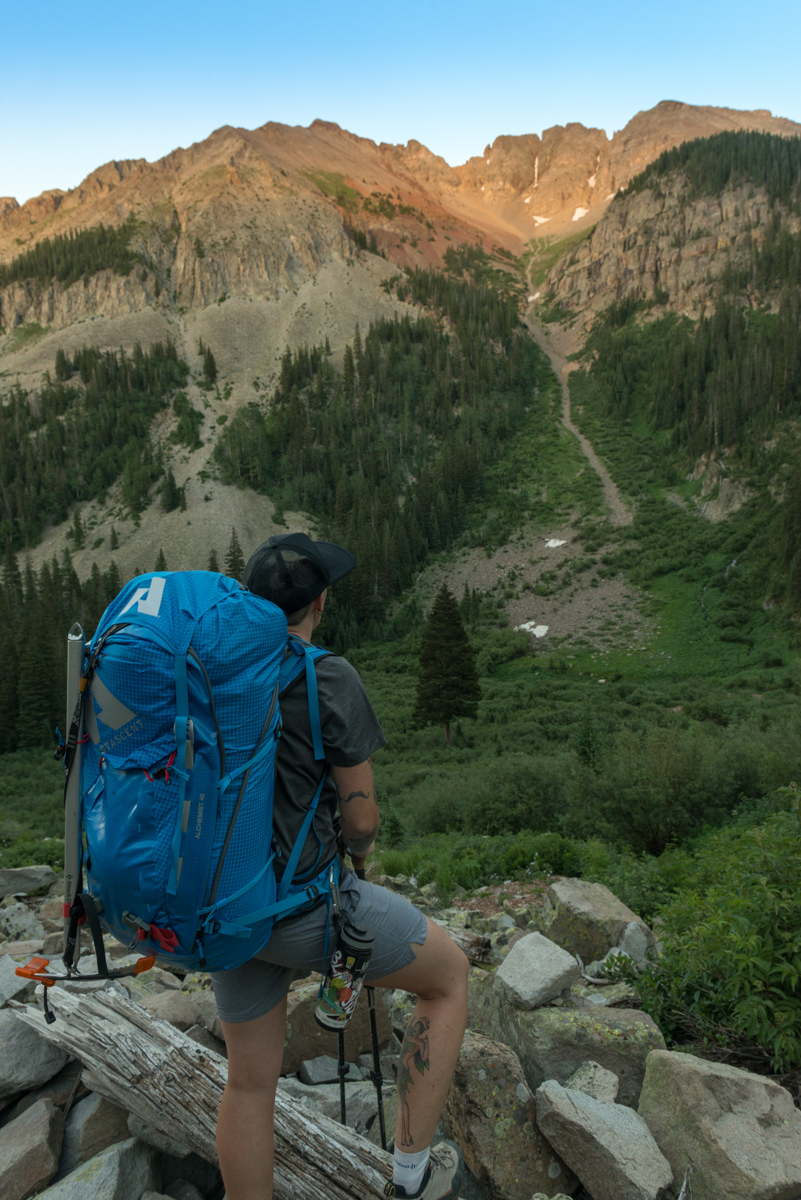
About 2/3 of the way up into the basin, the light began to change dramatically, with clouds hovering over the Mount Sneffels Wilderness Area across the valley from us. The last of the sun illuminated the summits of Campbell, Dallas, Gilpin, and Sneffels. I had to stop to capture it.
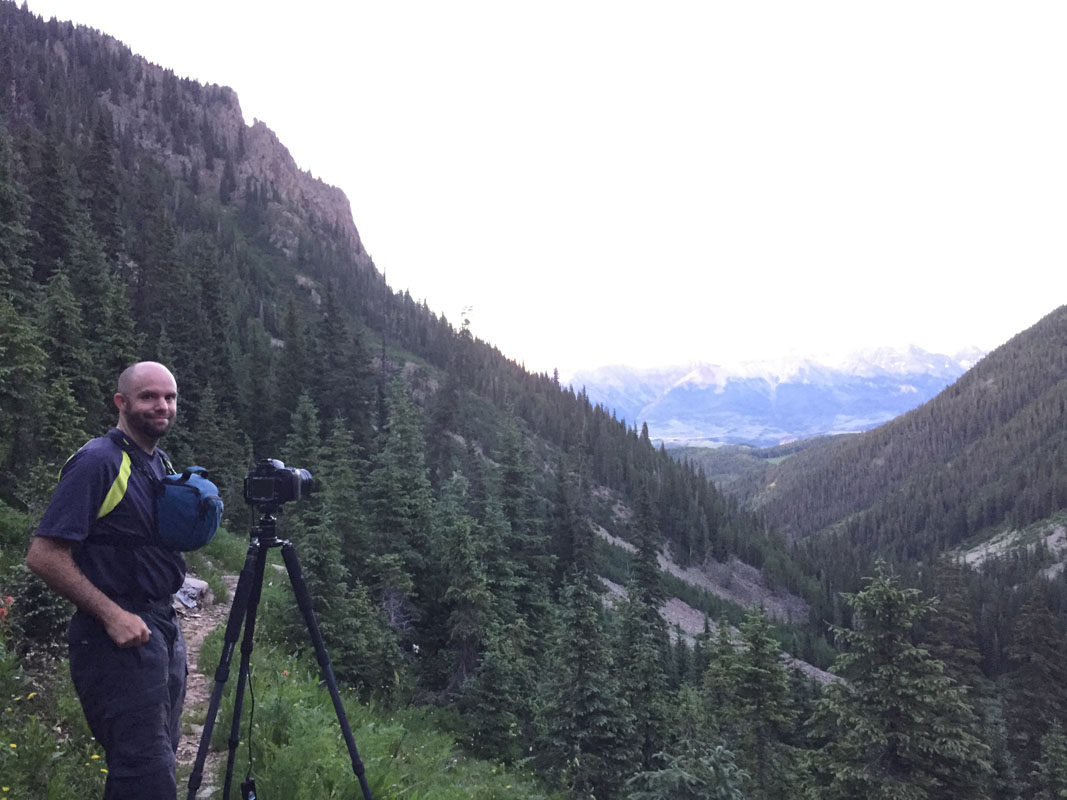
Well worth the stop, I think. For this one, I used a Circular Polarizer on my 24-70 lens in order to get greater color and tonal saturation and to reduce haze. Prints of this one are available HERE.
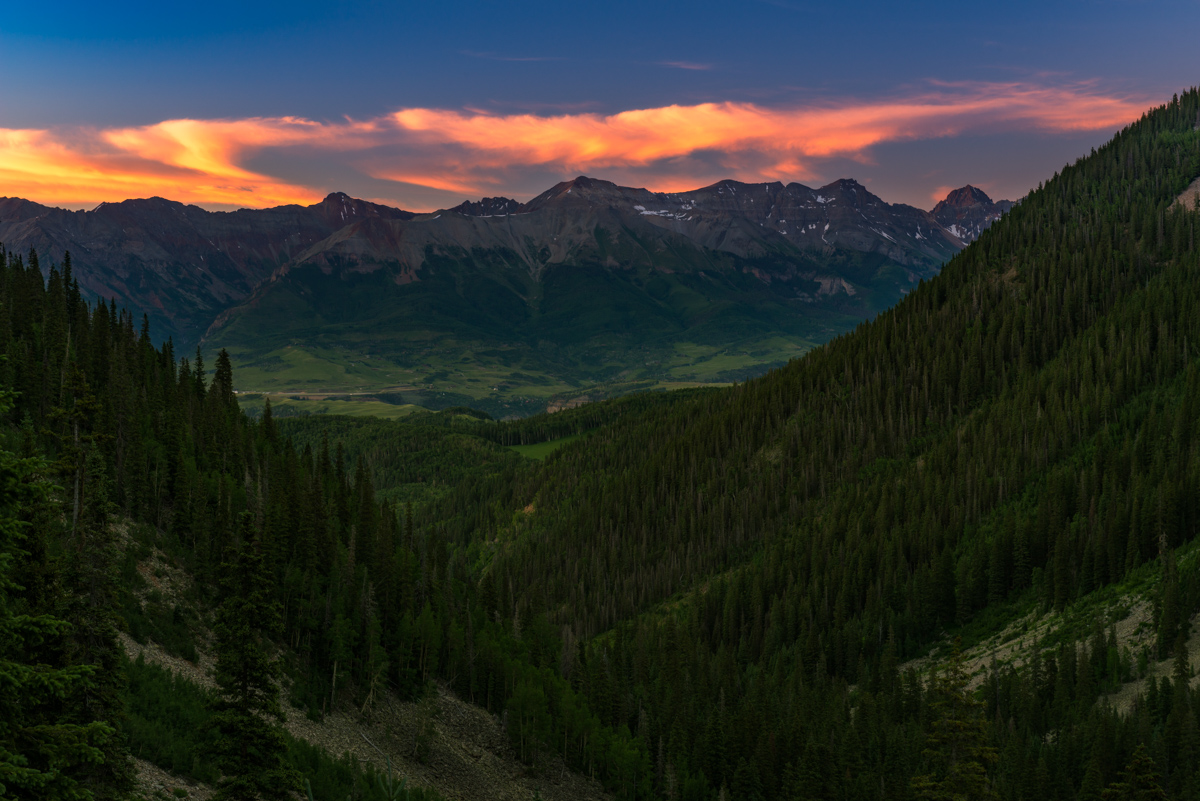
We managed to make it into Bilk Basin at dark and had trouble locating the trail going up to the lake below Wilson Peak (objective/camp possibility #1). We thought the basin would make for a good camping area too but it was super marshy down below and we did not want to get wet. We opted to try to follow where the trail that goes up to the Lizard Head Trail was supposed to be by using Gaia GPS GPS on my phone. Gaia is so amazing! You can purchase it here and help support the site. Since there was no trail to follow, we had to rely on technology. What an amazing application. It shows your location on a USGS map, tracks your progress, and even works in airplane mode. It is the best $20 I've ever spent in my life. We found some campsites just below the Lizard Head Trail and opted to stay there since we were both tired and the lake was a good distance away yet. After setting up my tent, I shot single long exposure of the Milky Way from camp. I kept the shutter open for 241 seconds for this shot using a cable shutter release in order to bring out the foreground. Then I crashed into bed at 11 PM to rest up for our big day of climbing. We set our alarm for 4 AM and declared that our 1st goal would be Gladstone Peak, followed by Wilson Peak.
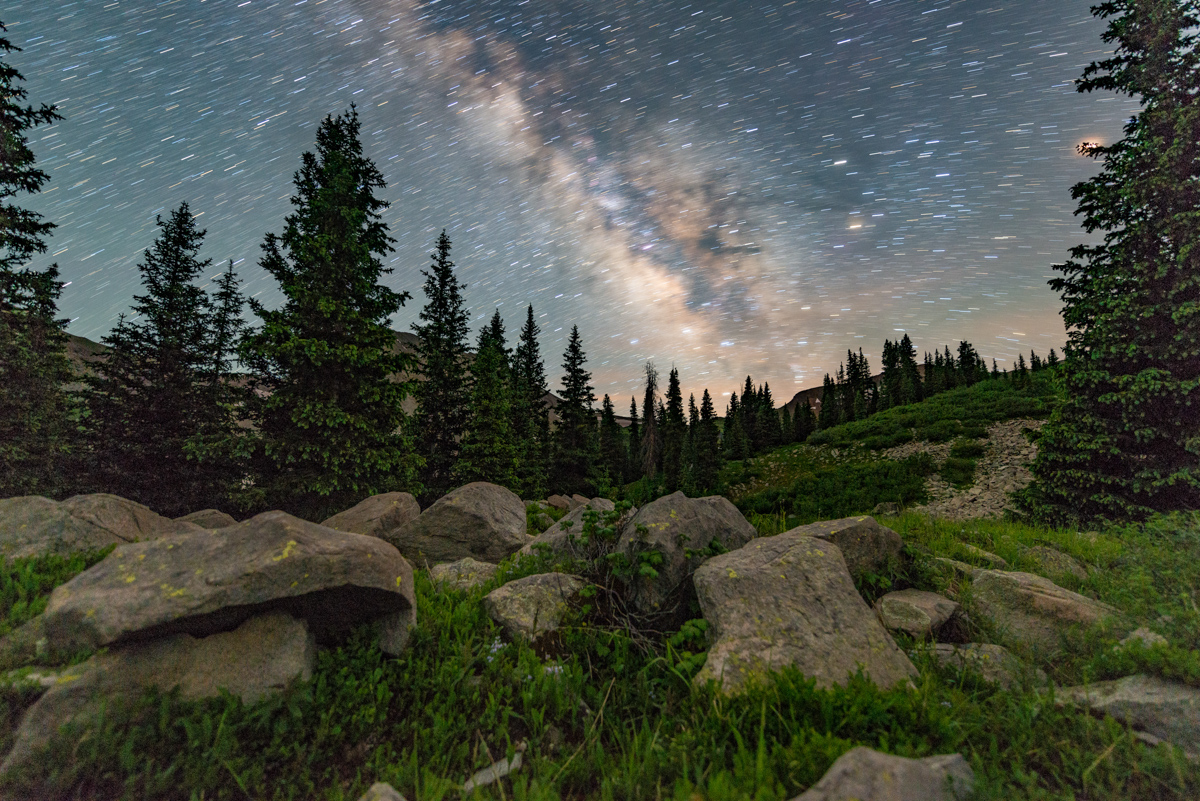
Silas and I got very little sleep but that is the name of the game when it comes to mountaineering and backpacking. We got out of our tent quickly and started off in the dark at around 4:15 AM. We followed the trail by our campsite south and west for a very short distance and found the Lizard Head trail that comes up from the Cross Mountain trail at Lizard Head Pass and turns west towards Gladstone and Wilson Peak. We followed that trail west but it ended abruptly at the creek after about a quarter mile. According to the map, the trail appeared to cross the creek here and continue up into the basin following switchbacks, but the creek was way too deep and flowing fast for our comfort, so we bushwhacked up the hill, following the creek closely. After about 200 feet of elevation gain, we located the trail again and another creek crossing, which was much more desireable and easy to cross. We crossed here and followed the trail up into the basin in the dark. It was not terribly difficult to stay on the feint trail; however, we did have some trouble from time to time. Luckily, I had Gaia GPS to help me stay on course. After about an hour we found the small lake we had hoped to reach the night before. It was a glorious lake to say the least, nestled at the base of Wilson Peak with views of Lizard Head to the southeast. I set-up my tripod and camera for some blue hour photography (the hour prior to sunrise but before the beloved Golden Hour) and Silas enjoyed the view as well. As I was setting up, Silas was able to photograph some deer that paid us a visit on the ridge behind us.
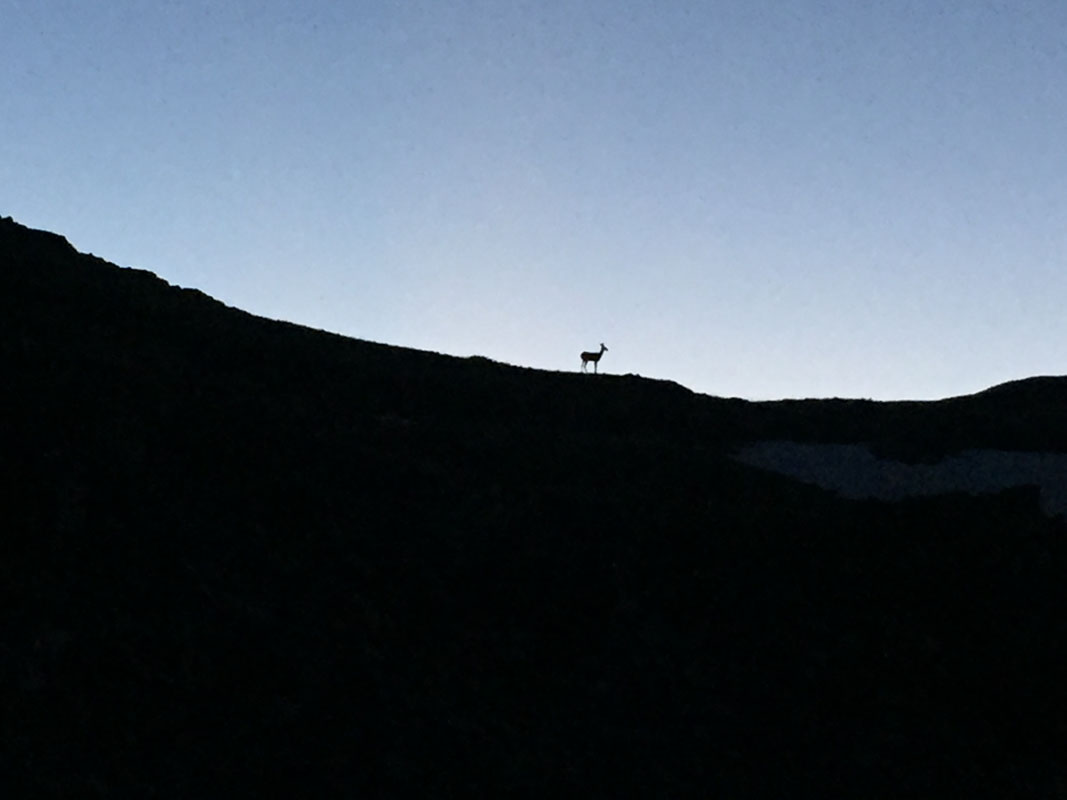
I was incredibly impressed with this location. The low light prior to sunrise coupled with the huge towering massif of Wilson Peak made for a delightful photographic subject. P.S. on some of my photos in this trip report, you can click on it, which takes you to my photography website, where prints can be purchased. I wanted to disclose that up front so that readers were not expecting to be able to click on it to see a larger version.
I also combined some shots for a panorama of Wilson Peak (right) showcasing the long ridge over to Gladstone (left of center).
When I finished shooting at the lake, I started packing up my gear when I looked back and saw the clouds changing color. I raced up the hillside back where we came from and set-up for this shot of the sunrise and Lizard Head Peak. What an amazing sight!
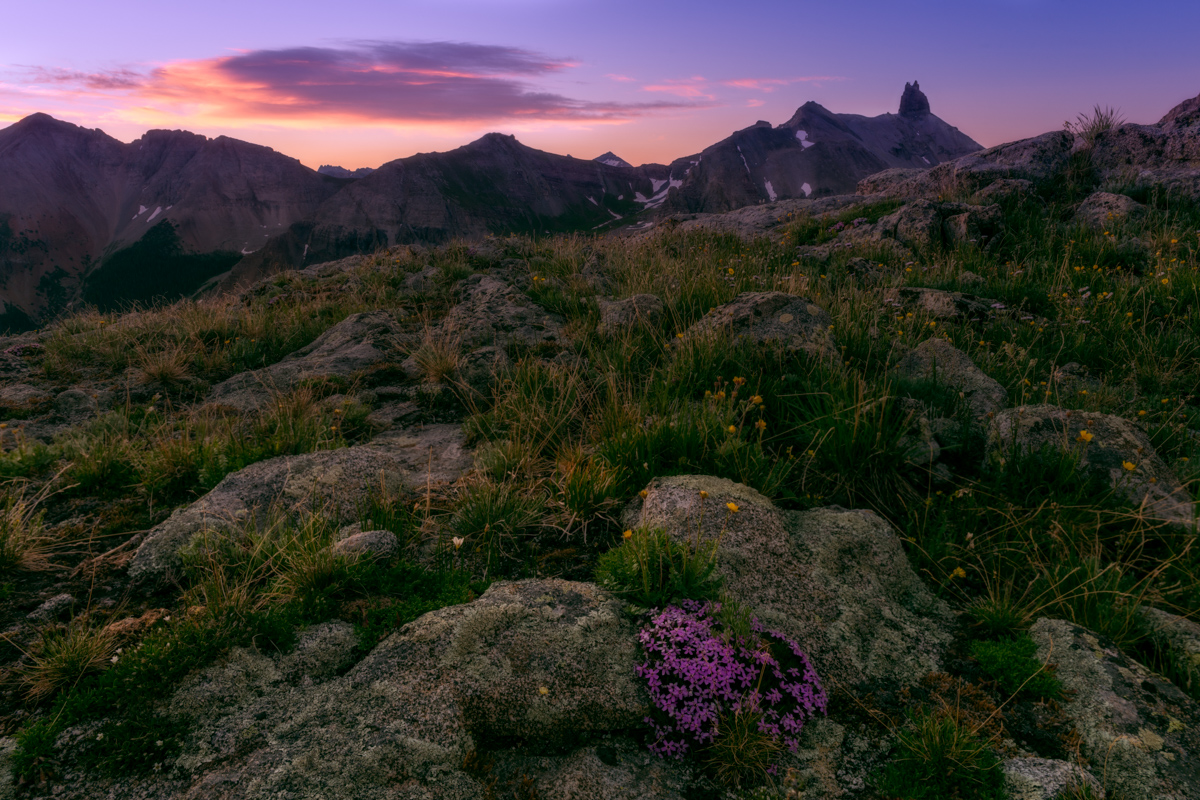
Finally, we continued on, having spent about 45 minutes total at the lake.
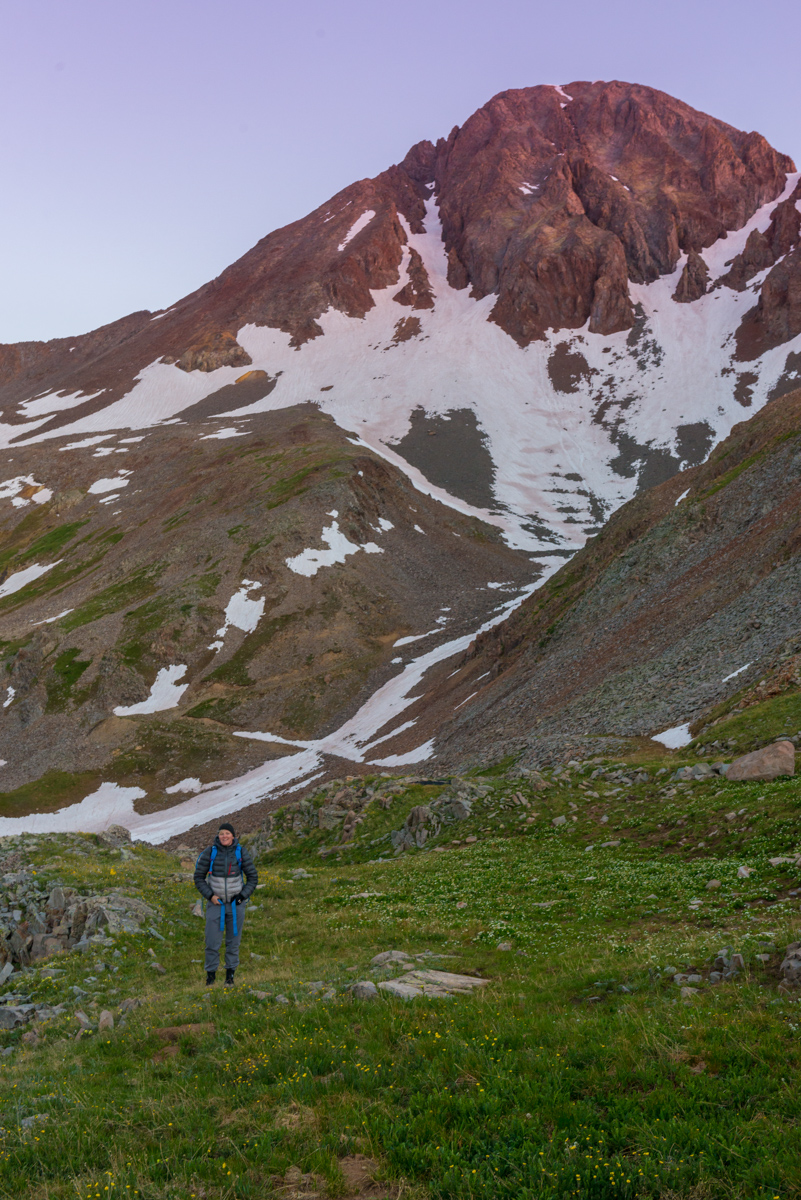
I think Silas and I were equally jacked up and elated by the sights from the lake - it was quite tremendous indeed.
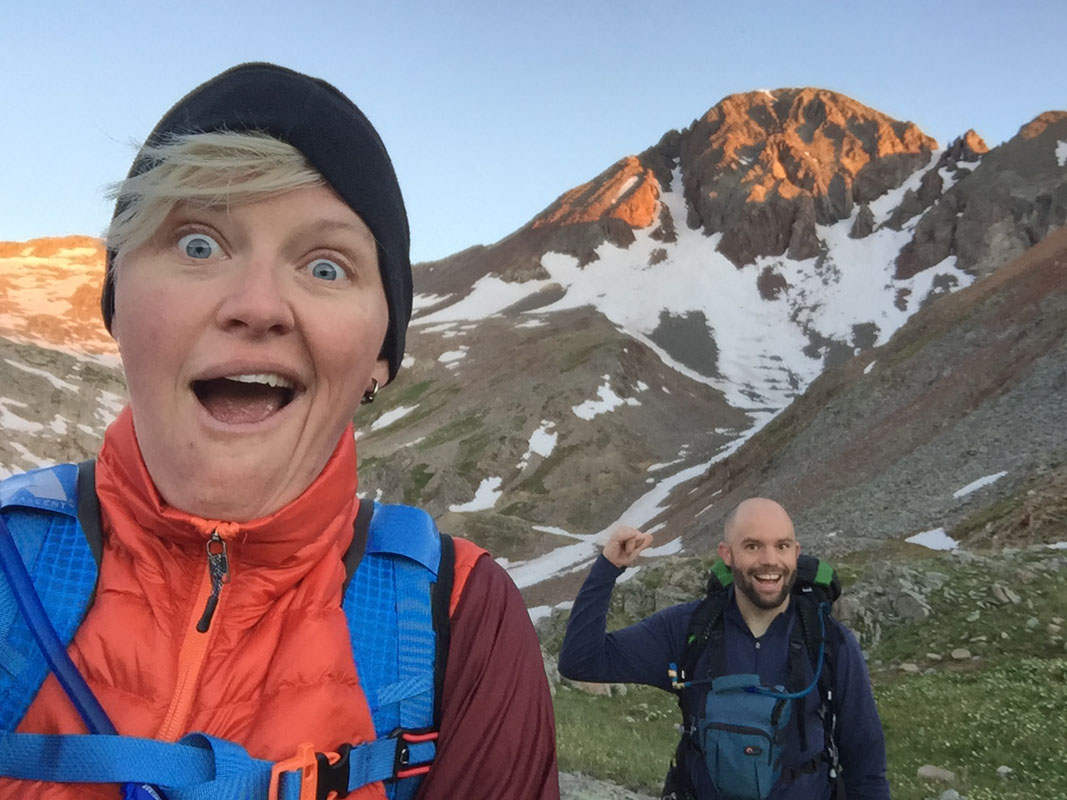
Just when I thought I was done using the tripod for the morning, I noticed some alpine sunflowers blooming and the early light of Wilson Peak, well, peaking. I had to stop and get this one. I have always admired the work of Jack Brauer and he has a shot with Wetterhorn Peak and alpine sunflowers that I've always greatly admired, so that was my inspiration for this shot.
As we contined up the basin, we kept our eyes on Gladstone.
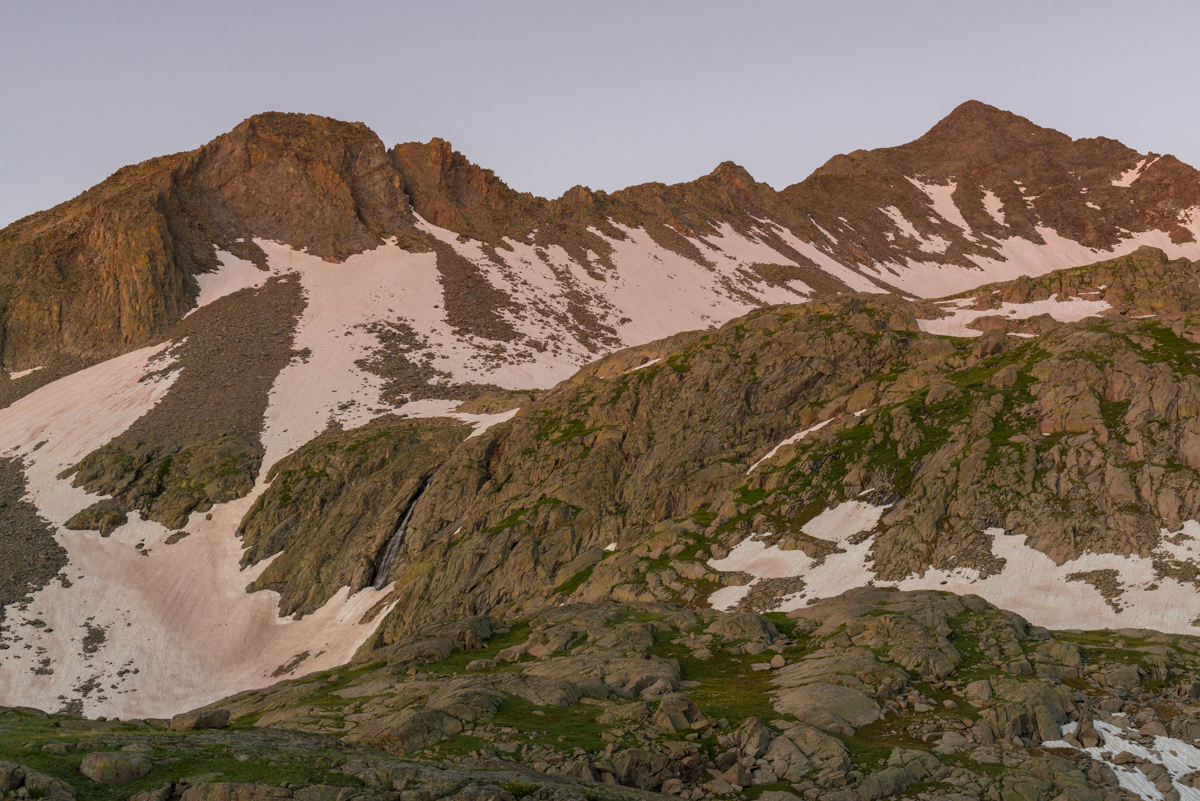
The early light from the sunrise was looking good behind us, constantly changing the amazing beauty of Lizard Head Peak. I could not stop looking.
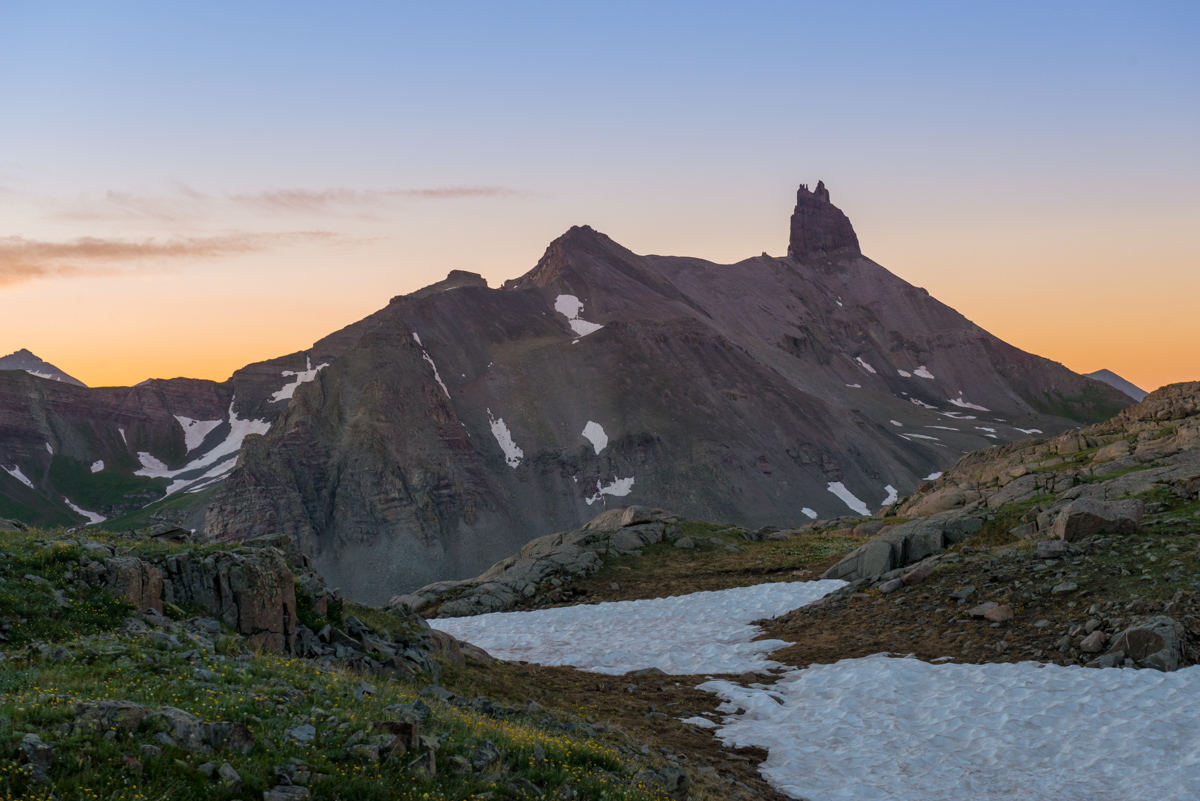
Finally, the sun hit in full force and illuminated all of Gladstone and created some wonderful light for this reflection in the lake.
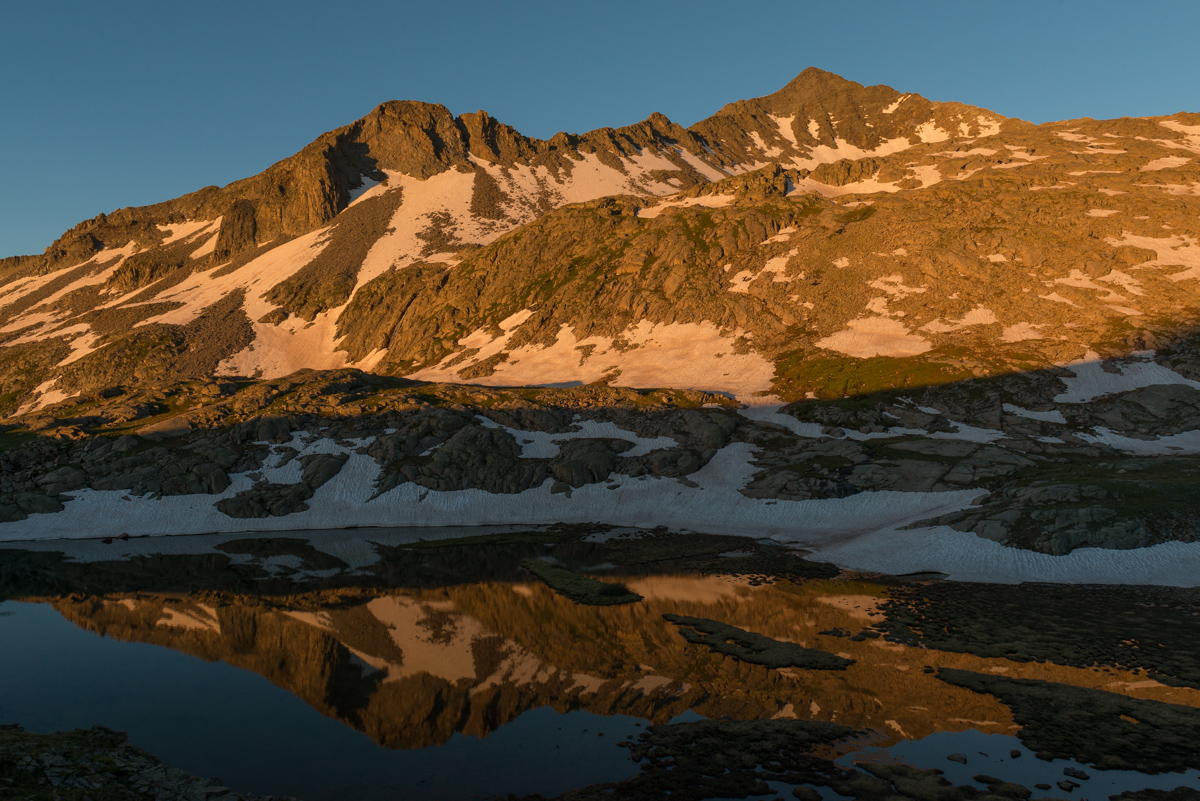
Lizard Head Peak kept looking better and better behind us, and I could not help but stop and take photos - it was truly fabulous.
I'm sure Silas was sick of me constantly looking back, but I think we were both pretty stoked to have this basin to ourselves to witness this great sunrise.
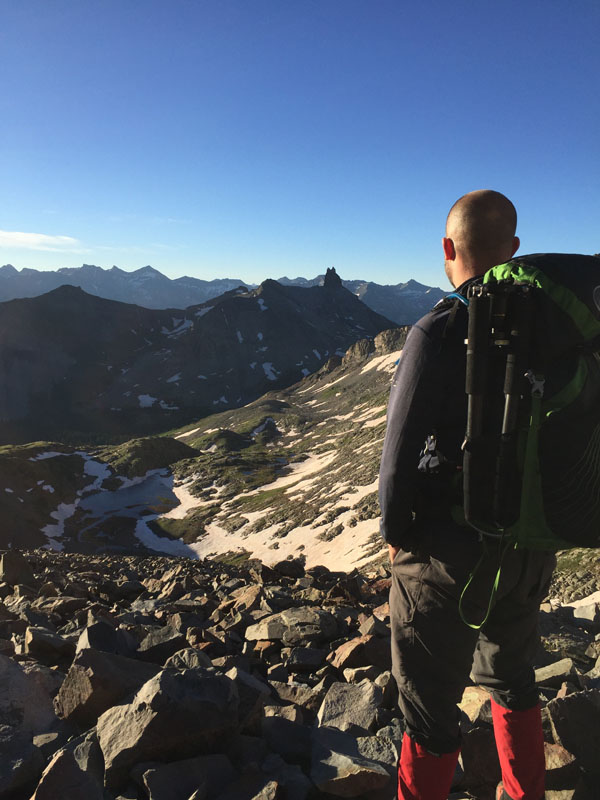
Silas kept her gaze above at Gladstone and the nasty, crumbly ridgeline between Wilson Peak and Gladstone. It was intimindating for sure.
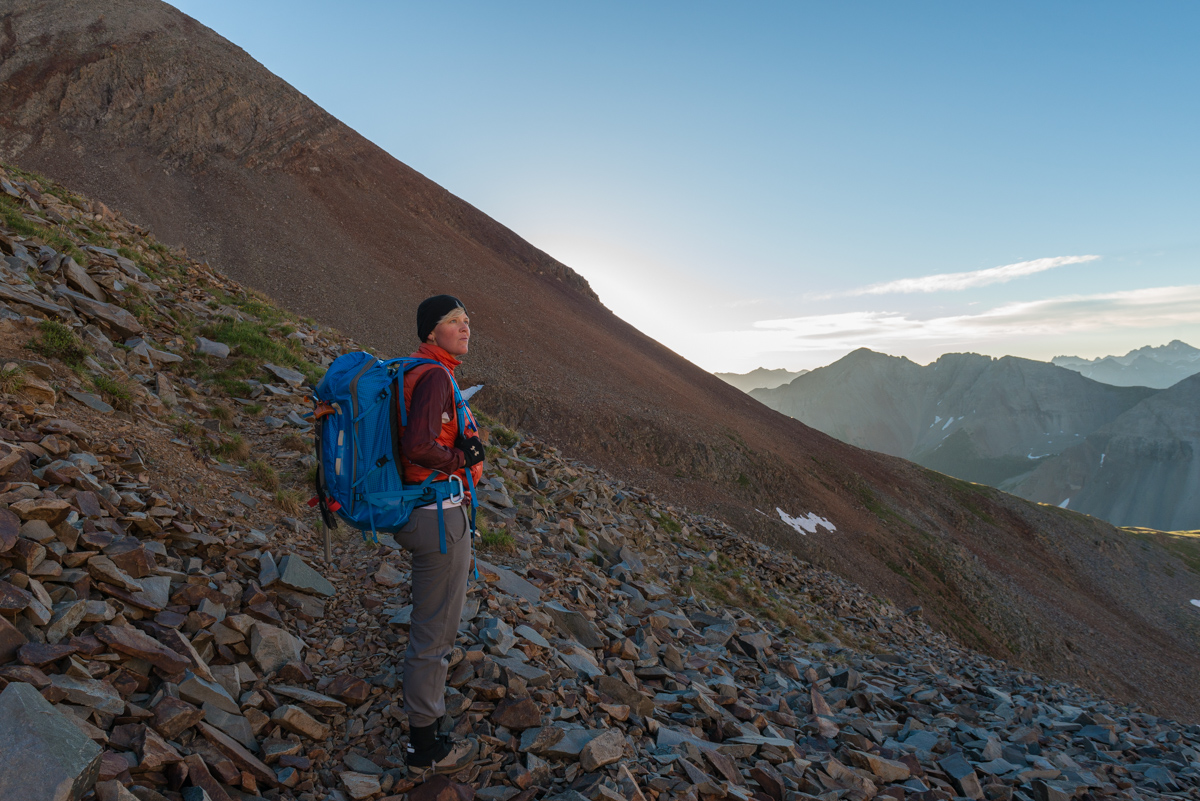
More sunrise beauty behind us - this time with the gorgeous Ice Lake Basin peaks including U.S. Grant, Pilot Knob, Golden Horn, and Vermillion showing up to the left of Lizard Head Peak. I was paying close attention to those peaks since my plan was to hit Ice Lake Basin the following weekend. What an amazing thing it is to live this close to such incredible scenery.
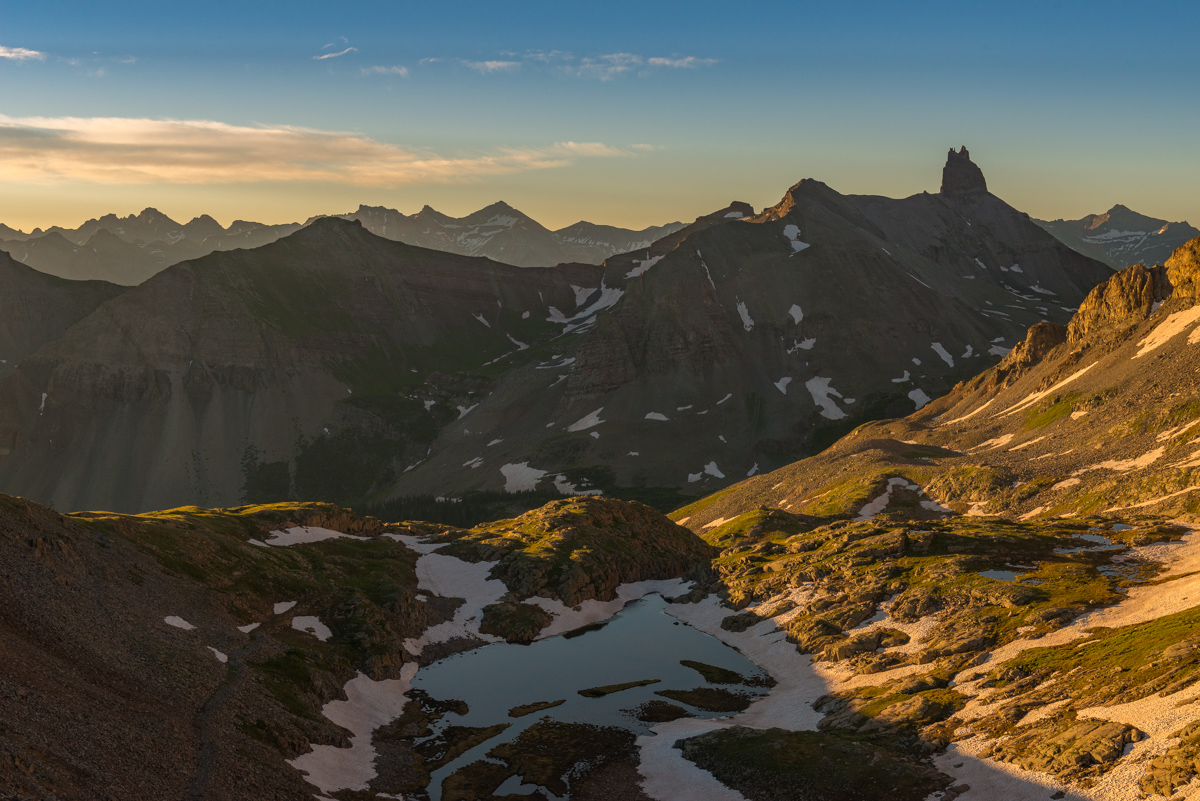
Alas, we continued up the long steep slopes of Bilk Basin, heading towards the most southernly weakest point between Gladstone and Wilson Peak.
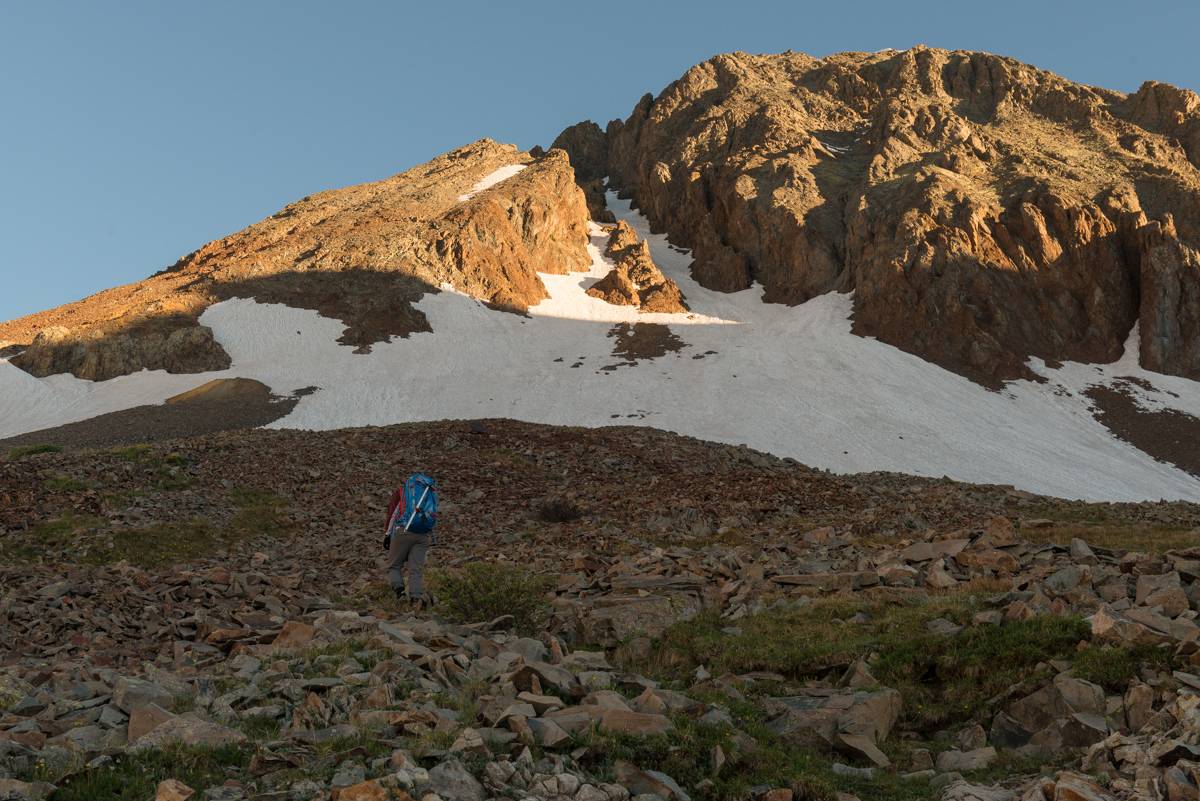
As we climbed higher into the remote basin, Mount Wilson finally came into view just left of our target on the ridge. We had a lot of snow between us and Gladstone and knew we had some snow travel in our future. Fortunately, we had both brought ice axes and did some mental preparation for some snow travel. I even spent some time refreshing my memory for snow travel by reading a couple pages of Freedom of the Hills before leaving home. Actually, that probably saved my life. More on that later.
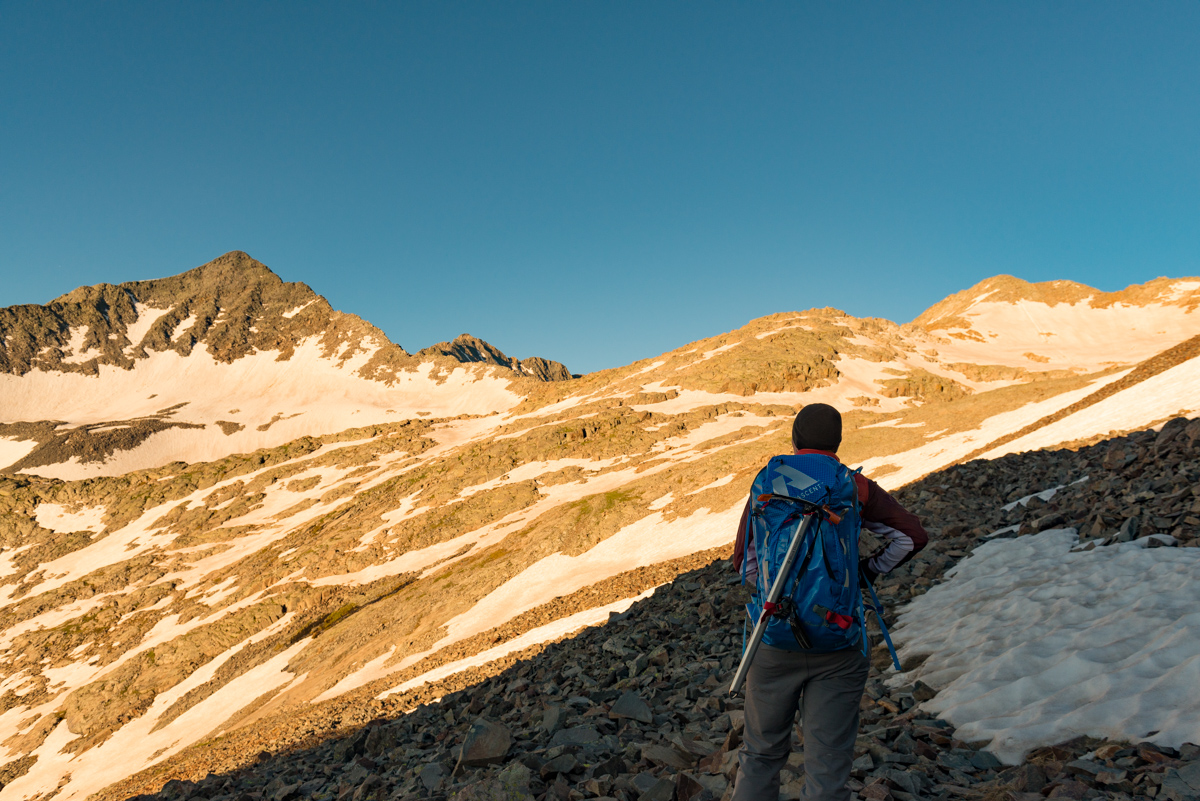
Finally, the sun came into view and I took advantage by getting a nice sunstar photo looking back east.
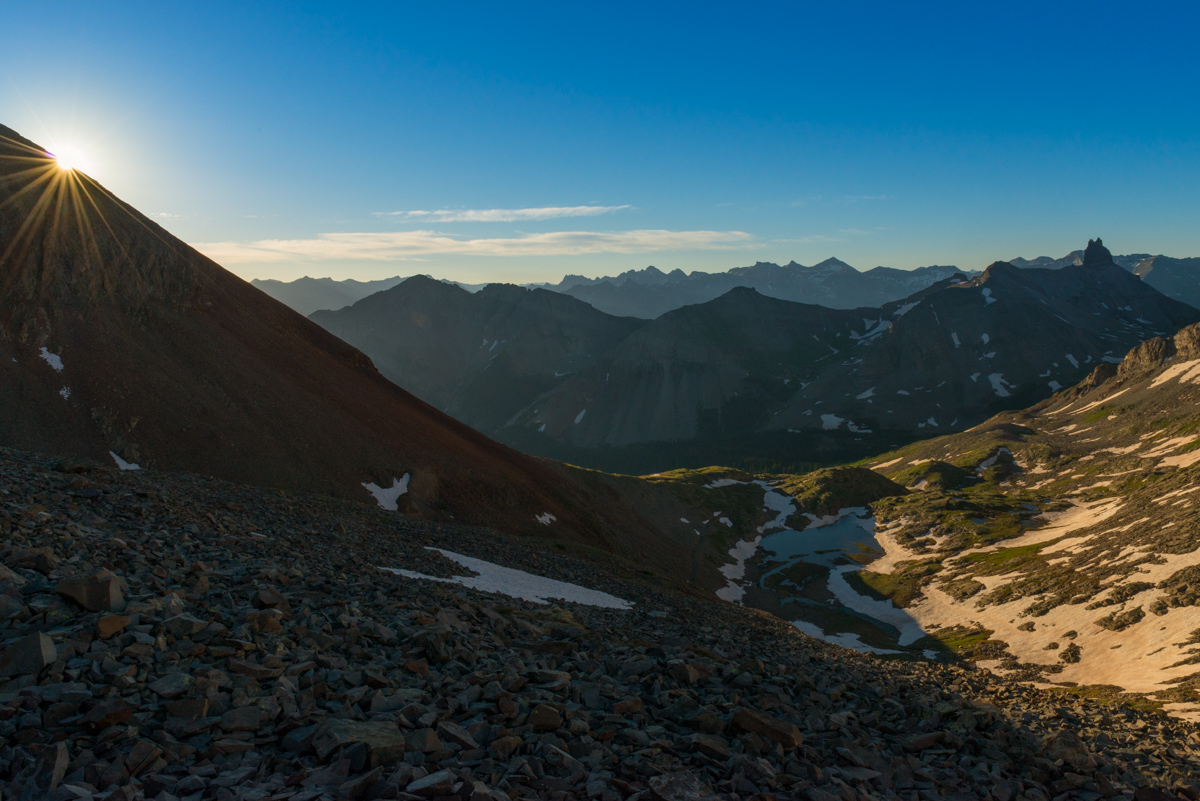
Silas also enjoyed the view of Lizard Head and the Ice Lakes peaks to our east. It was hard not to stare, honestly.
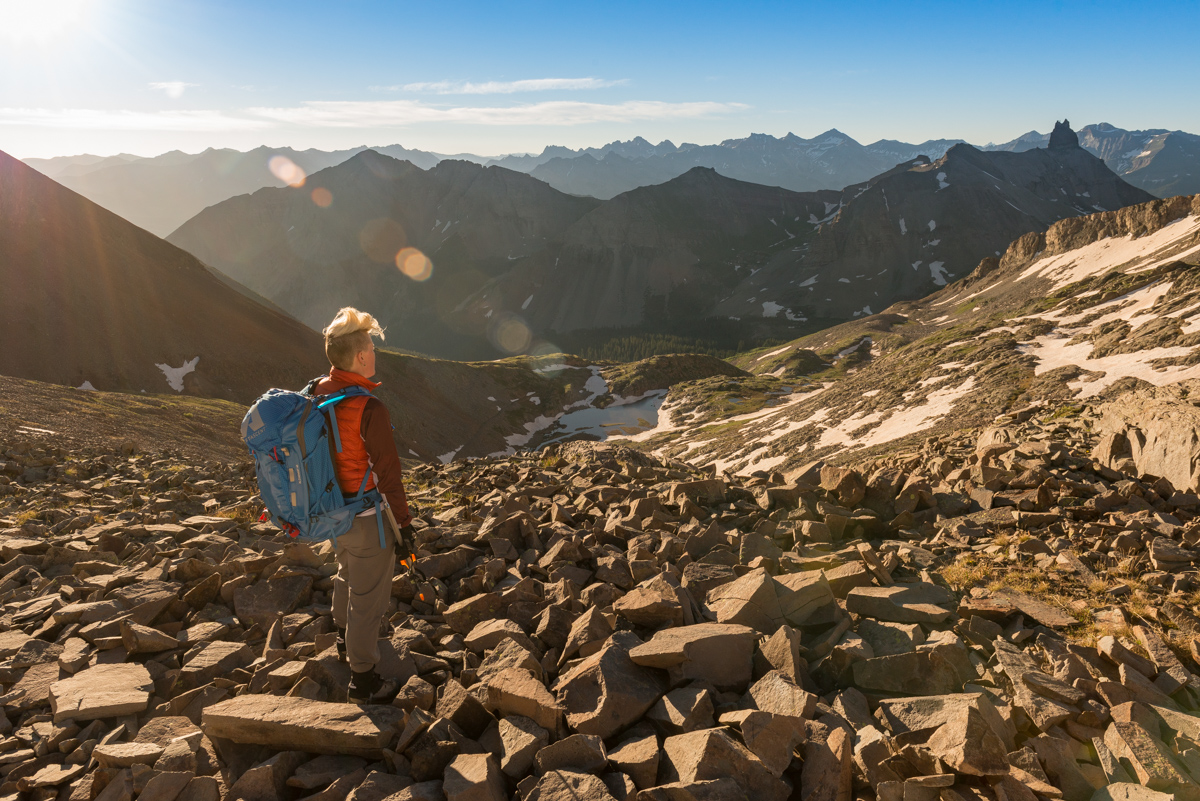
Climbing higher and higher into Bilk Basin and closer to our 1st objective. Silas weighs our route and contemplates life...
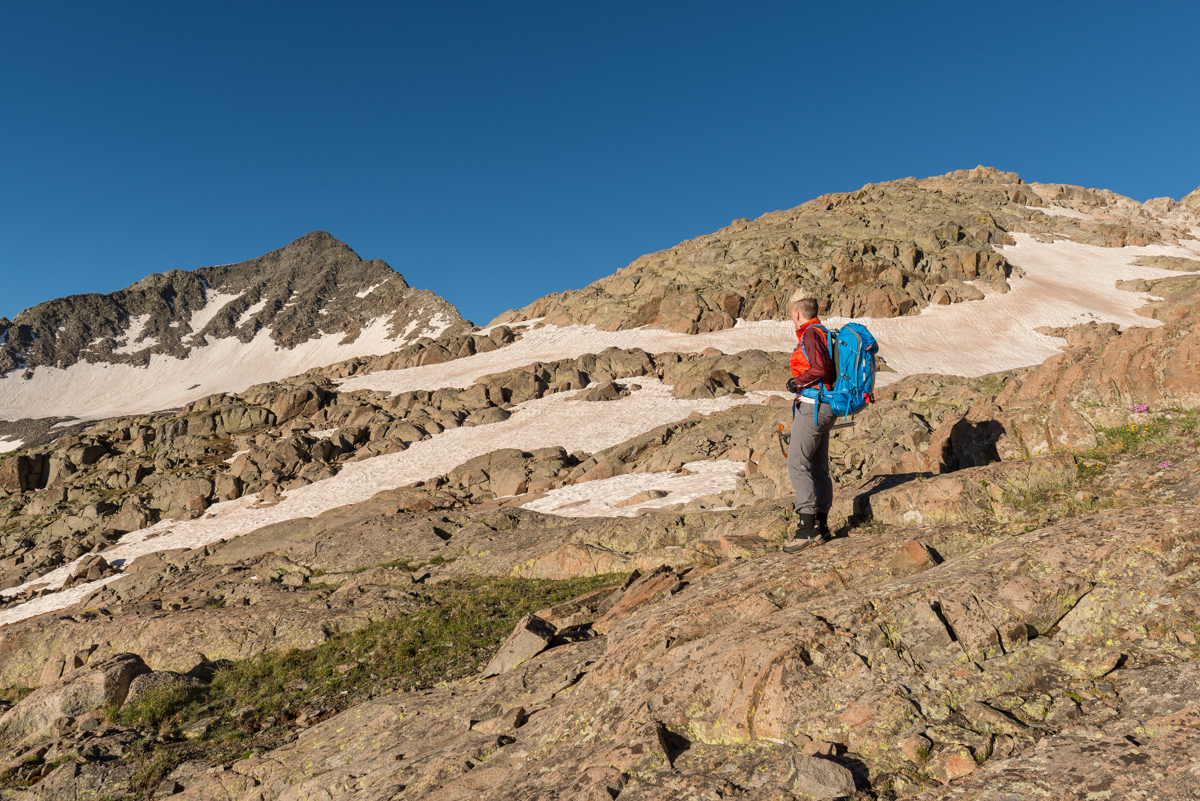
The snow travel began in full effect. The snow at this point was quite hard and finding our footing was a challenge. We did not bring crampons, which was fine. We just took our time and slowly ascended carefully.
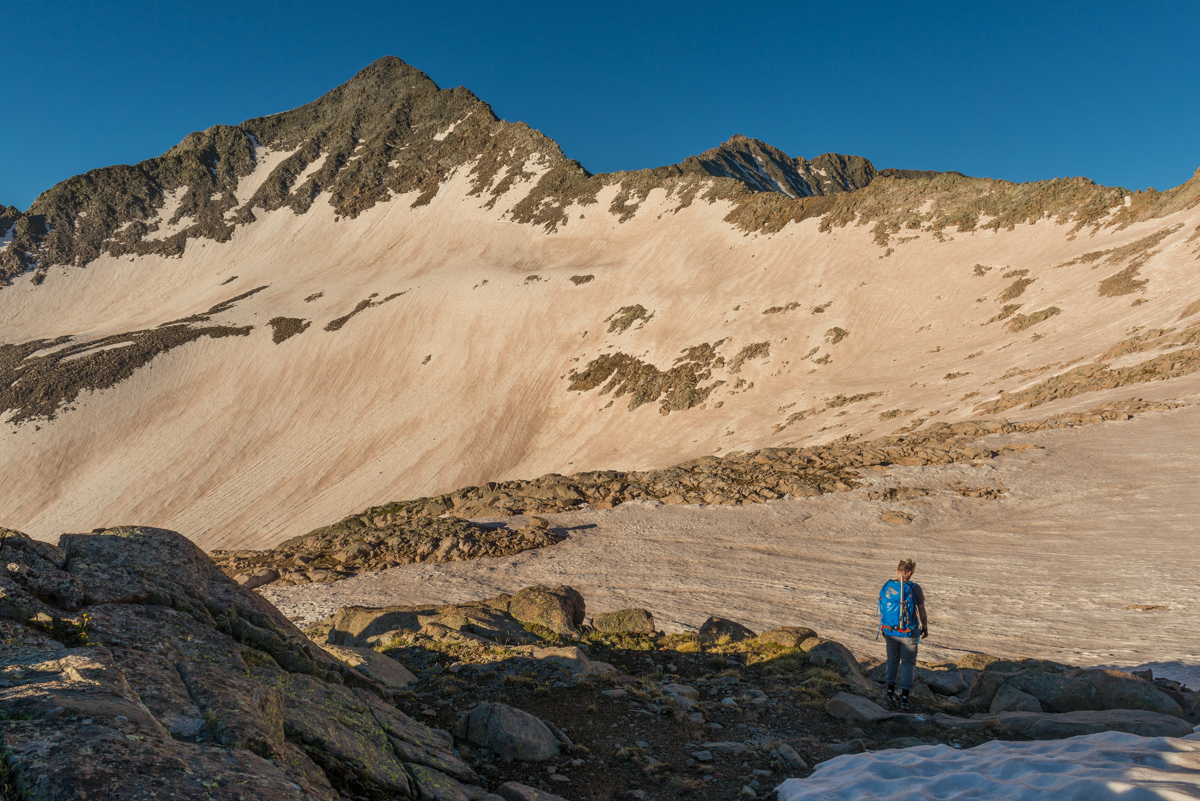
Just a leisurely stroll up a giant snowfield...
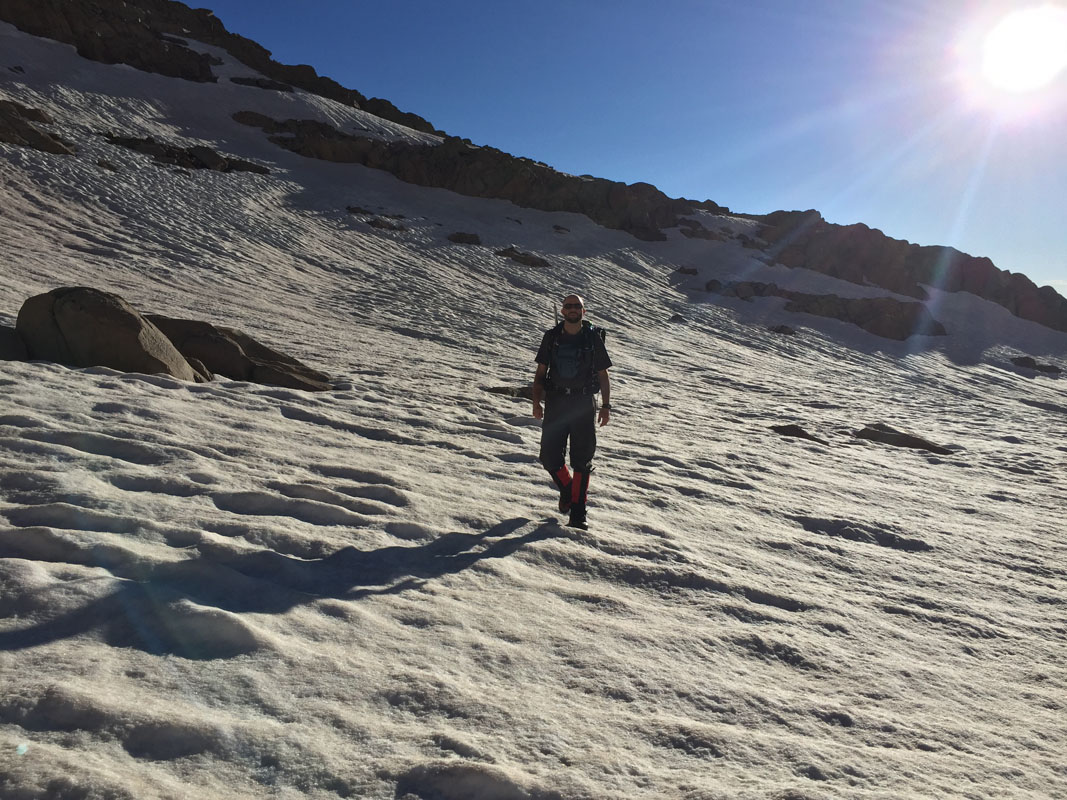
The snow was quite blinding in the early sun, but it was quite warn and there was no wind at all. I had a feeling that this snow would be quite soft later in the day. We contined towards our destination - the notch just above and left of Silas in the photo below.
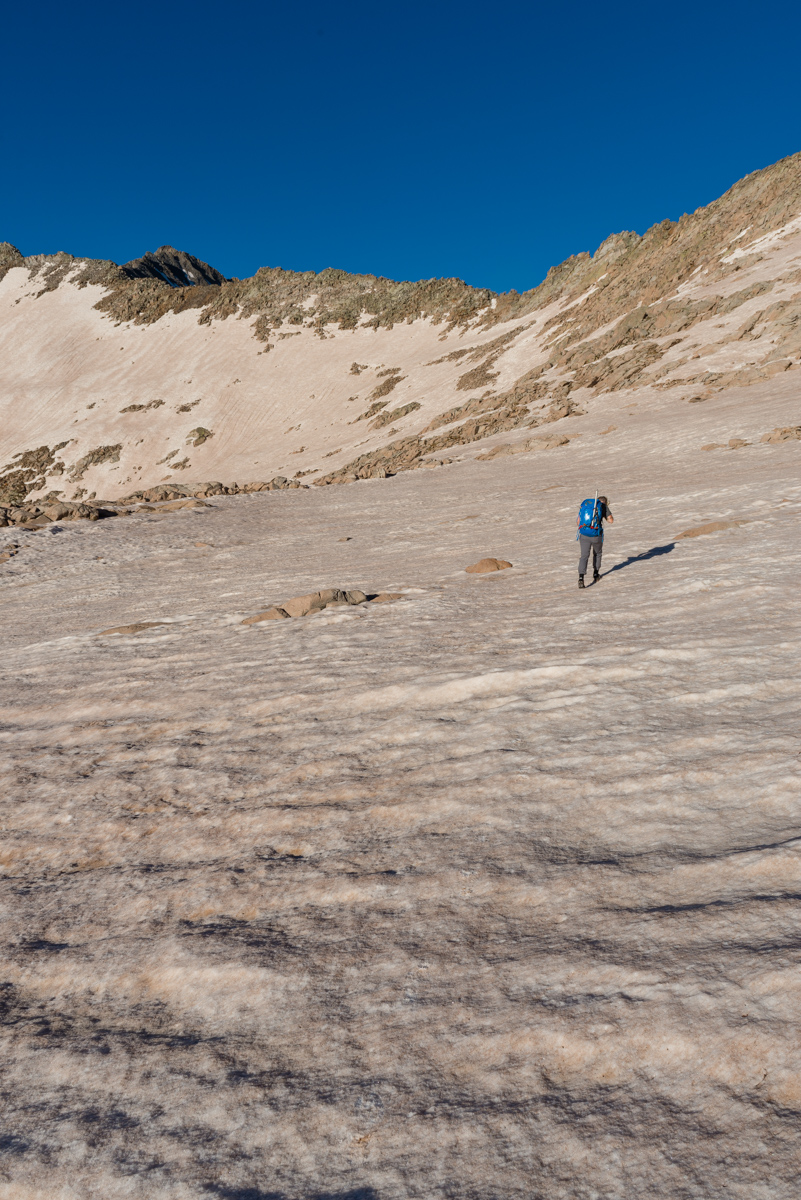
Without much trouble, we reached the Gladstone Peak - Wilson Peak saddle and enjoyed views of Navajo Basin to the west. I was really happy we chose Bilk Basin - the view on the way up was really quite a bit better than that of both the Navajo Basin and the Rock of Ages routes, in my opinion.
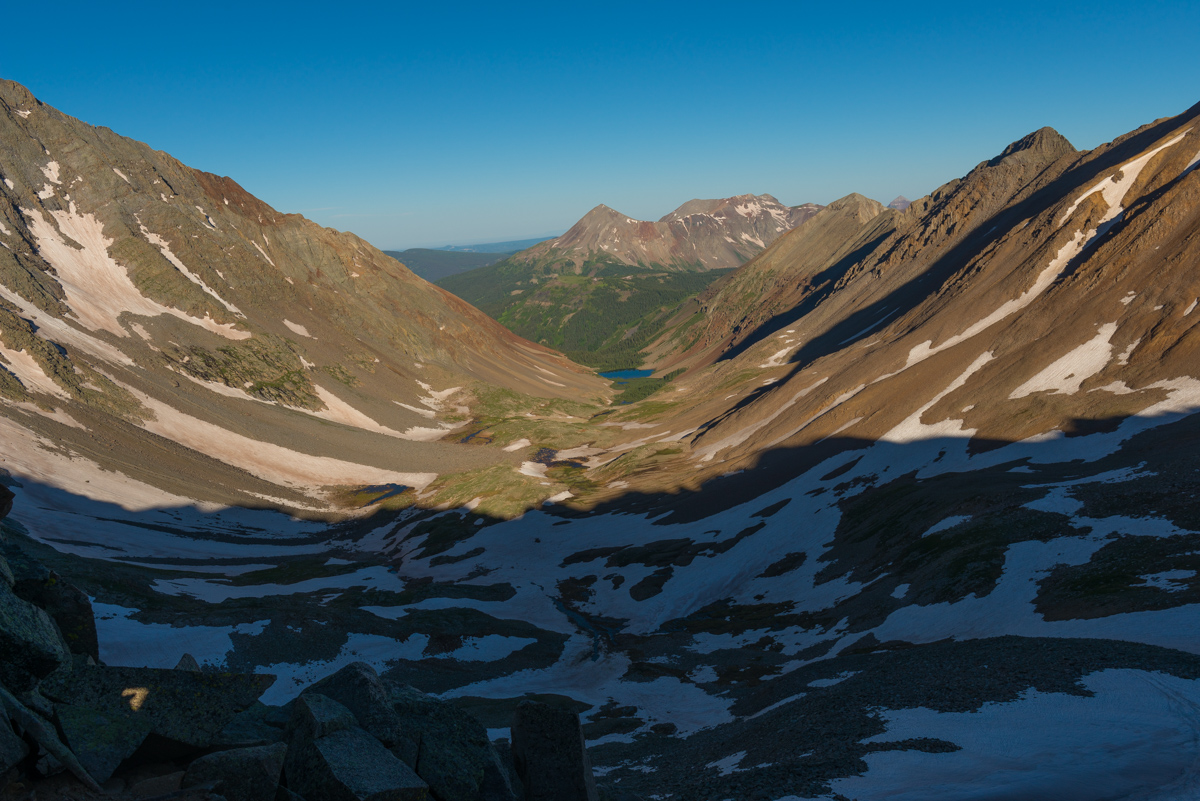
It was time to gear up. We both donned our helmets and mentally prepared for the ridge. I had read a lot of horror stories about this ridge up Gladstone and knew that we needed to remain vigilant throughout the morning to stay safe. I also decided it was a good time to finally use my GoPro that my wife bought me. I attached it to my helmet and we set sail.
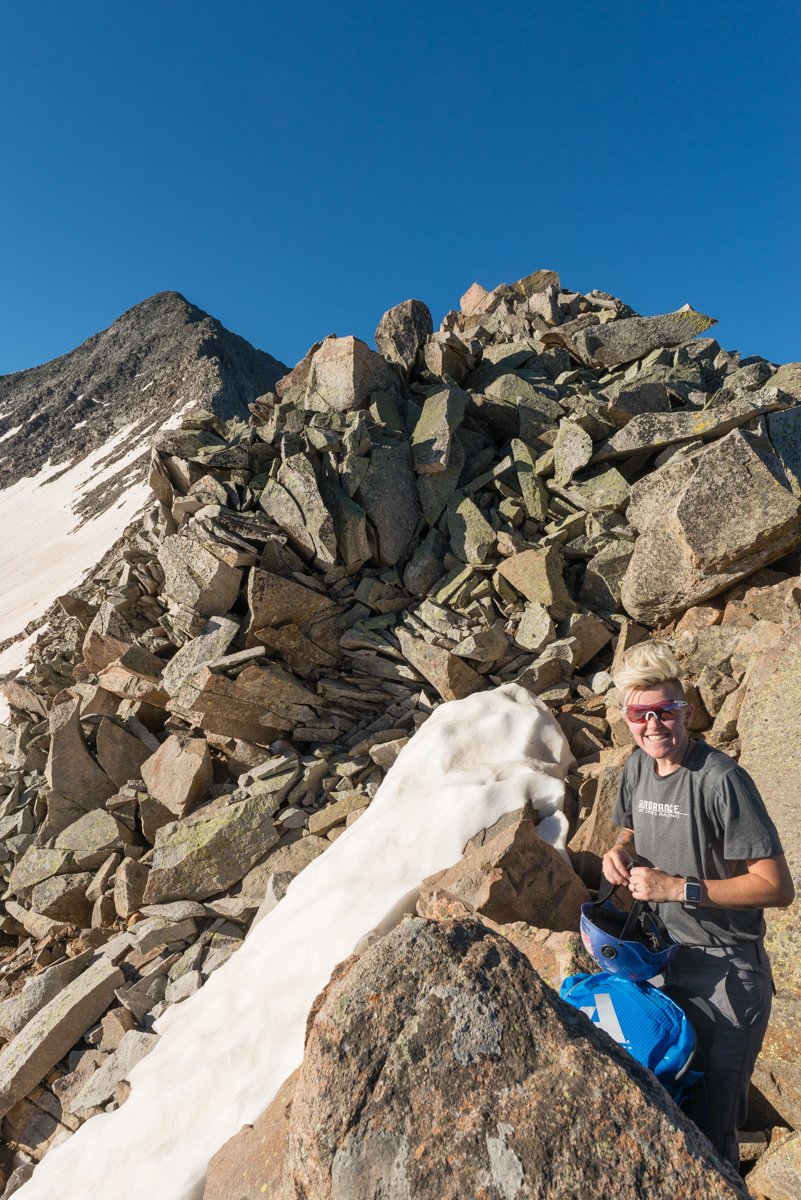
Let's rock! It was good to be doing a hardcore scramble again. I love this type of stuff. Unfortunately, this particular scramble was frought with potential peril.
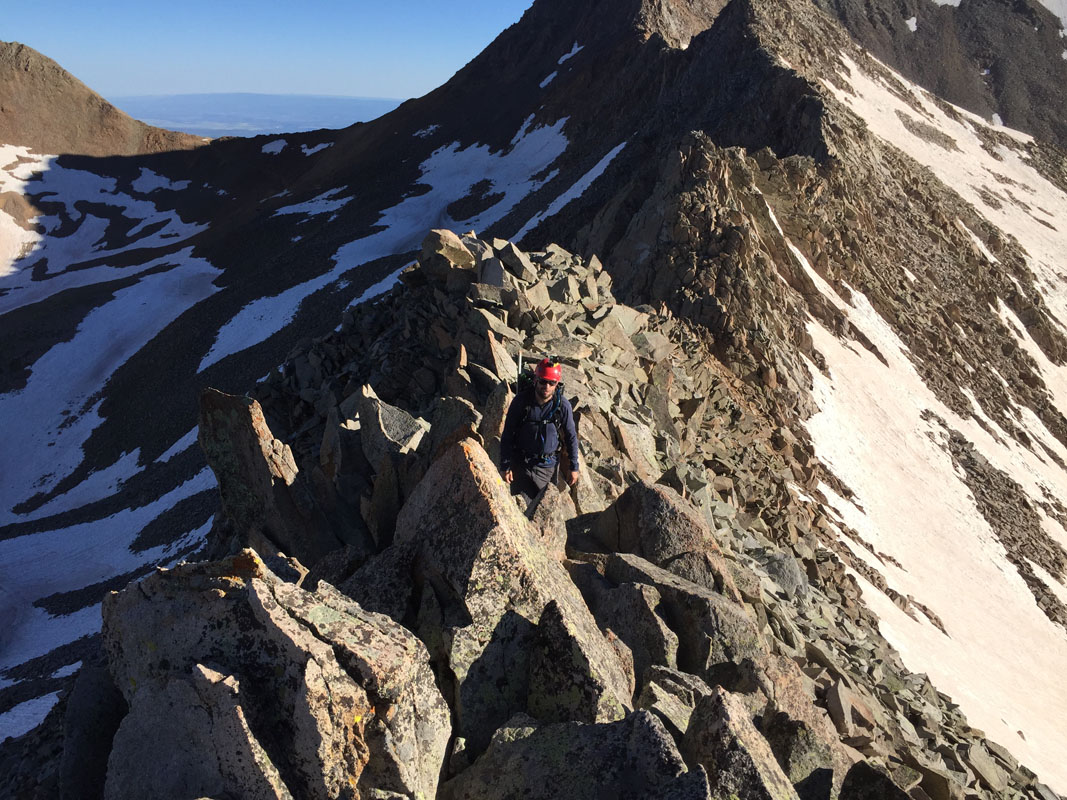
The rock on the way up Gladstone was chossy, loose garbage. Every time I looked up to find the next rock to step on, my thought was, "there's that rock, which is held up by that rock, which is held up by that rock, which holds up this rock." It was mentally exhausing to say the least. I tested every step, every hold, and kicked rocks before placing my weight on them. I was also extra careful to watch Silas as he ascended, making sure I could dodge a rock at any time. I'm so glad I did... because as you can see in the GoPro video below, I had a near miss that would have been very harmful, perhaps fatal. This video gives you a taste of the journey up Gladstone. I have about 40 minutes of footage that I condensed into 3-4 minutes. The video is a bit shaky - so be warned! I smoothed it out a bit which caused some strange effects, but I think it a bit more watchable now.
The high risk climbs like this always feel good when you reach the top, but for this one, I had a pretty bad feeling the whole time we were on top because I knew we had to go back down the same way and it was not something I looked forward to. Alas, we enjoyed the summit and our company while some people were yelling in joy from over on Mount Wilson. Wilson Peak loomed in the distance to the north and I was apprehensive to give it a go at this point. I was running really low on water and my body felt a bit tired from the near miss.
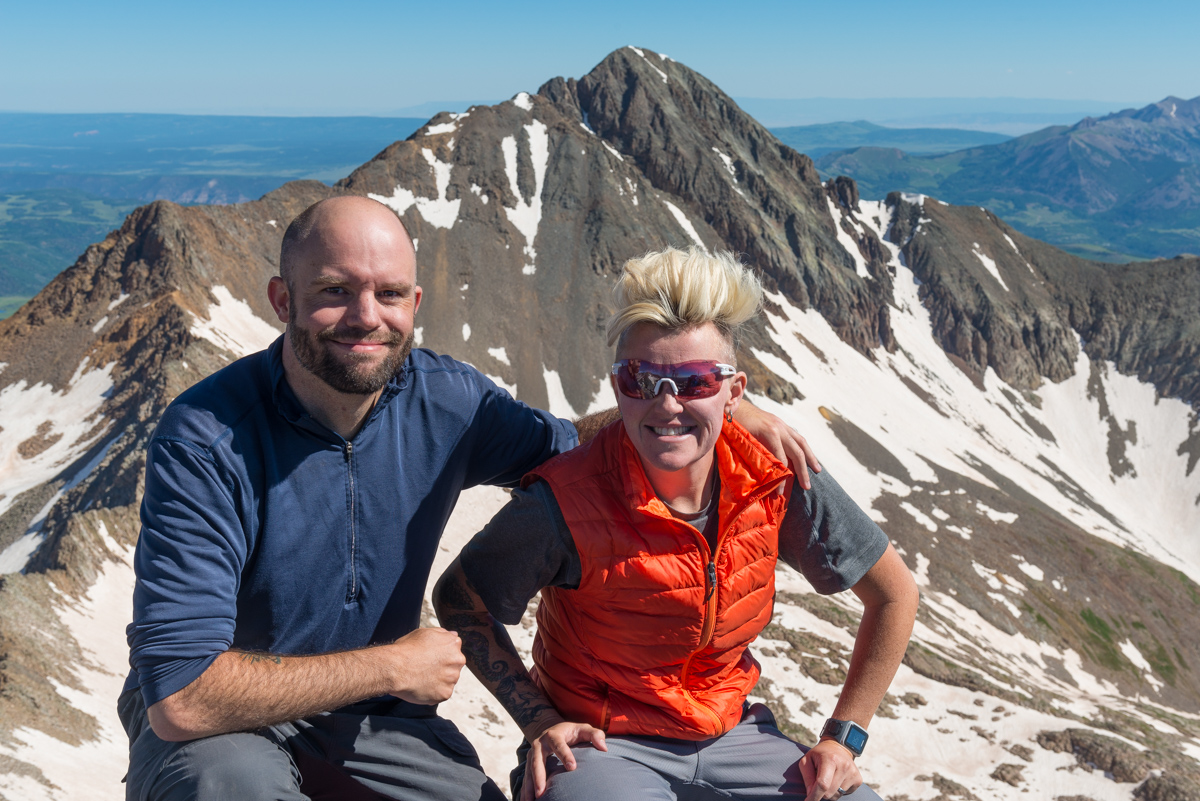
A 360 summit panorama from Gladstone...

One of my favorite features to stare at from up here was Lizard Head Peak and the long shadow it cast below with a sea of amazing mountains behind. Really tough to beat.
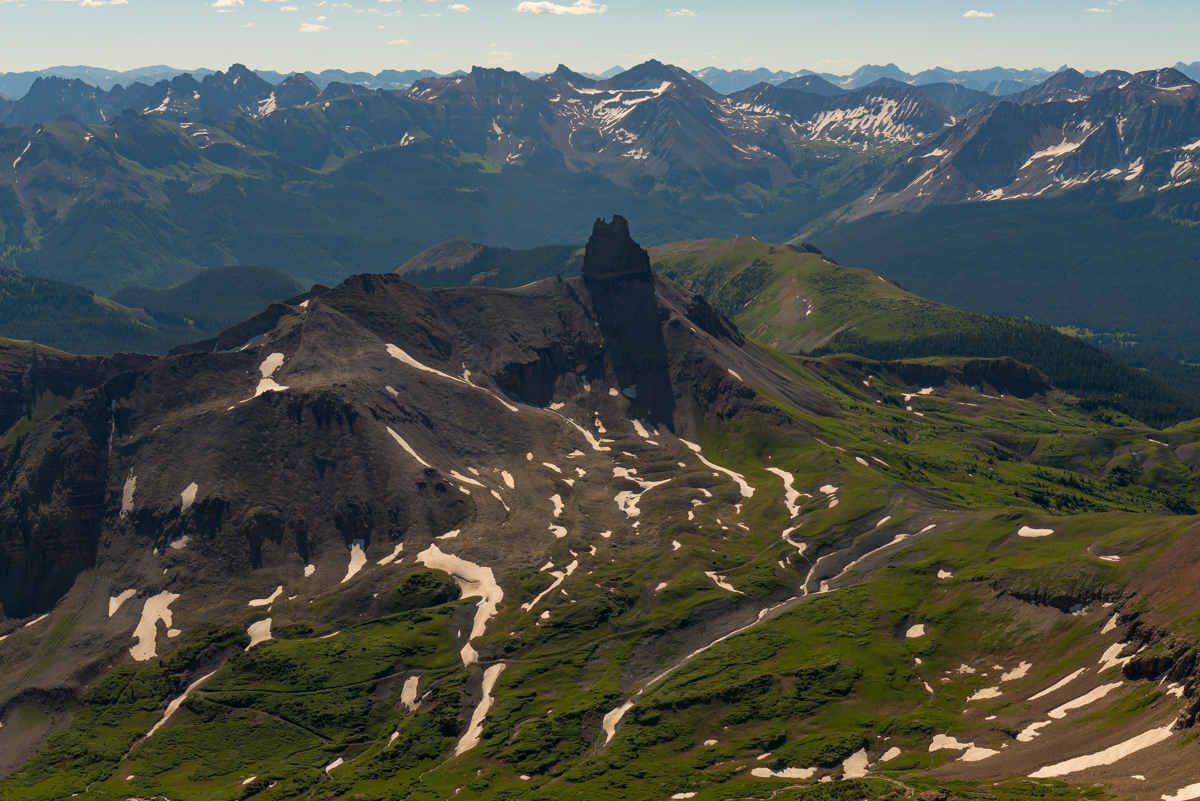
Also visible were Dallas Peak, Mount Sneffels (left of center), Teakettle (center), Potosi, Wetterhorn, and Uncompahgre (right of center), all above the town of Telluride. Pretty amazing view from this part of Colorado, for sure.
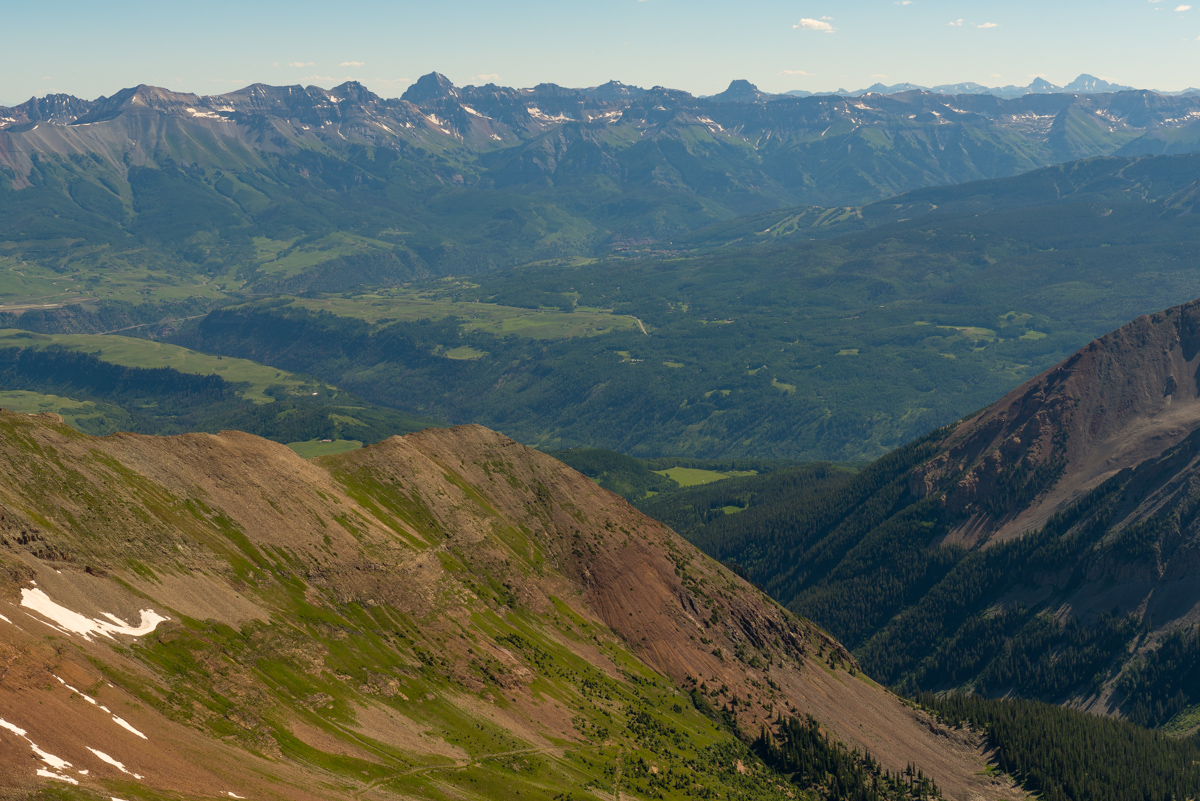
After enjoying the summit for awhile and posting updates to our loved ones, we decided to head down. For the way down, we stayed high on the ridge the entire way, which proved to be more challenging in some ways but much, much more stable than on the way up, where we decided to dodge left below the ridge (which in retrospect was a mistake). We also decided to see how we both felt once reaching the saddle again and decide on Wilson Peak from there. Since I was basically out of water, it was going to be an interesting decision. The views east were great so I was pretty happy no matter what.
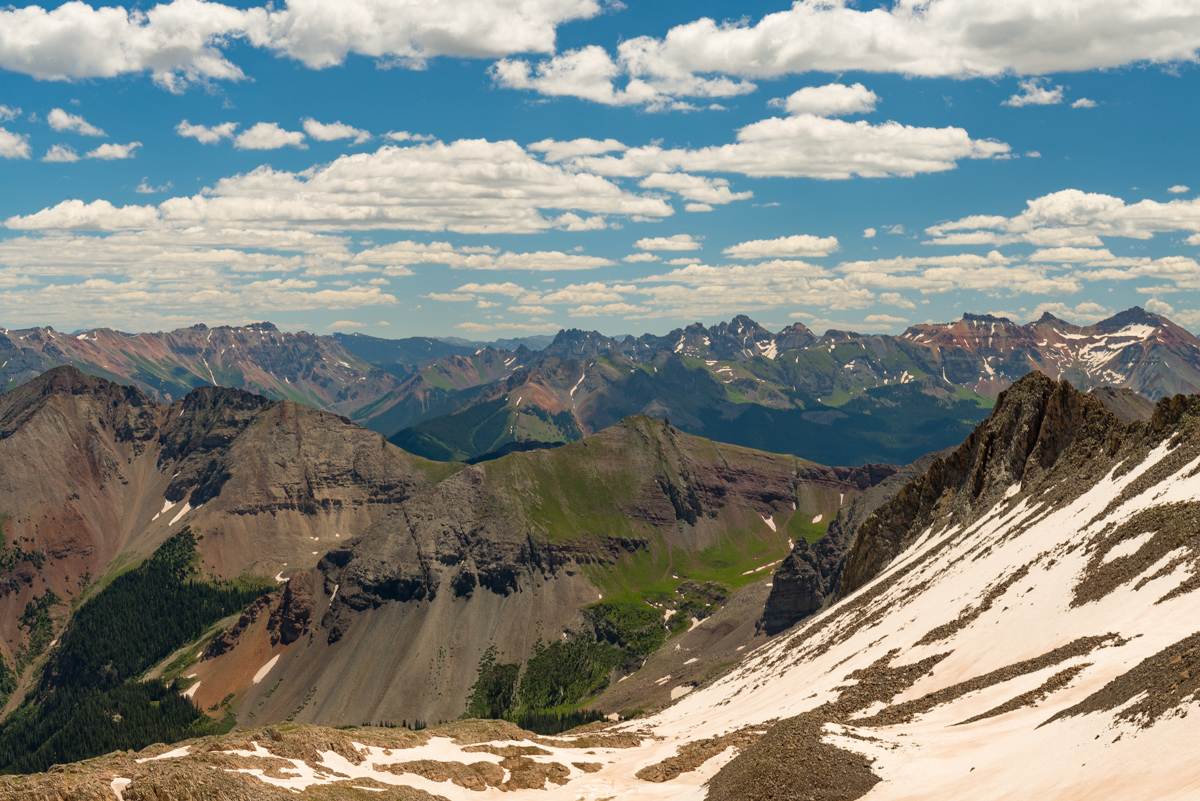
More awesome views looking east on the way down...
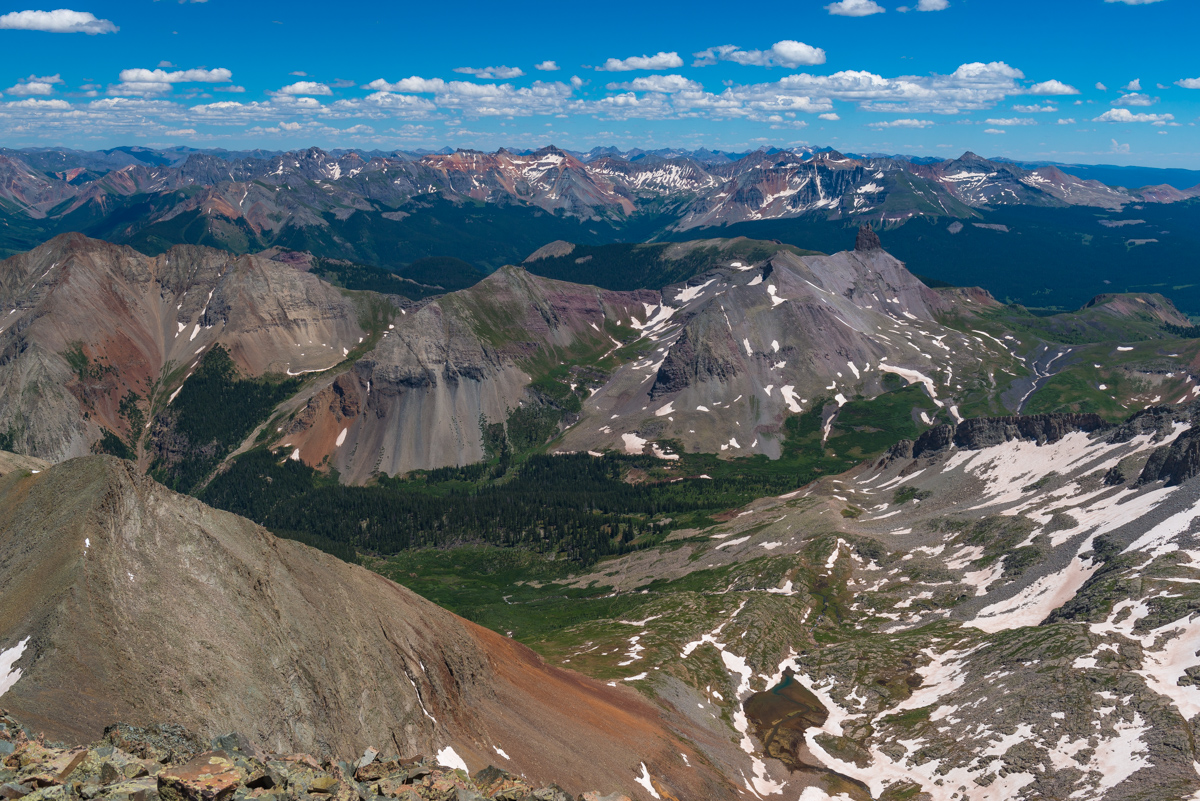
Being goofy...
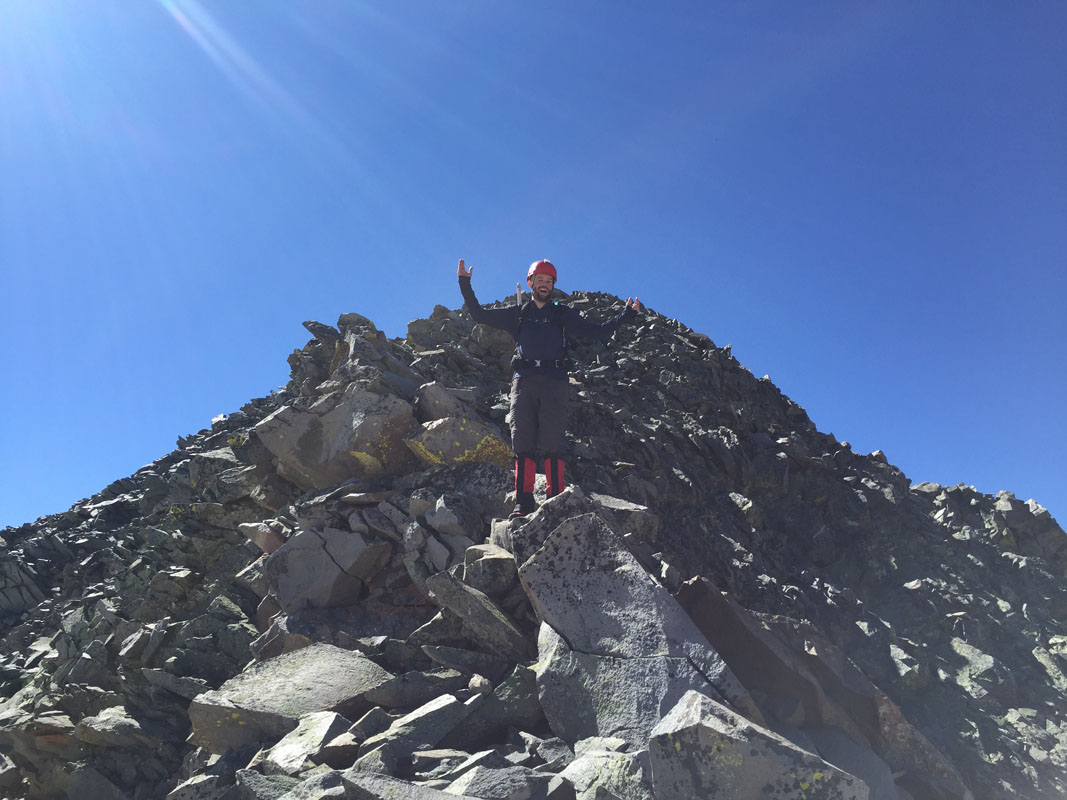
There was a really awesome section on the way down which had a pretty committing move up a sheer face that probably saved us a lot of downclimbing into the nasty section of the ridge. Here is a glimpse of that section which I think was one of the highlights of the whole day.
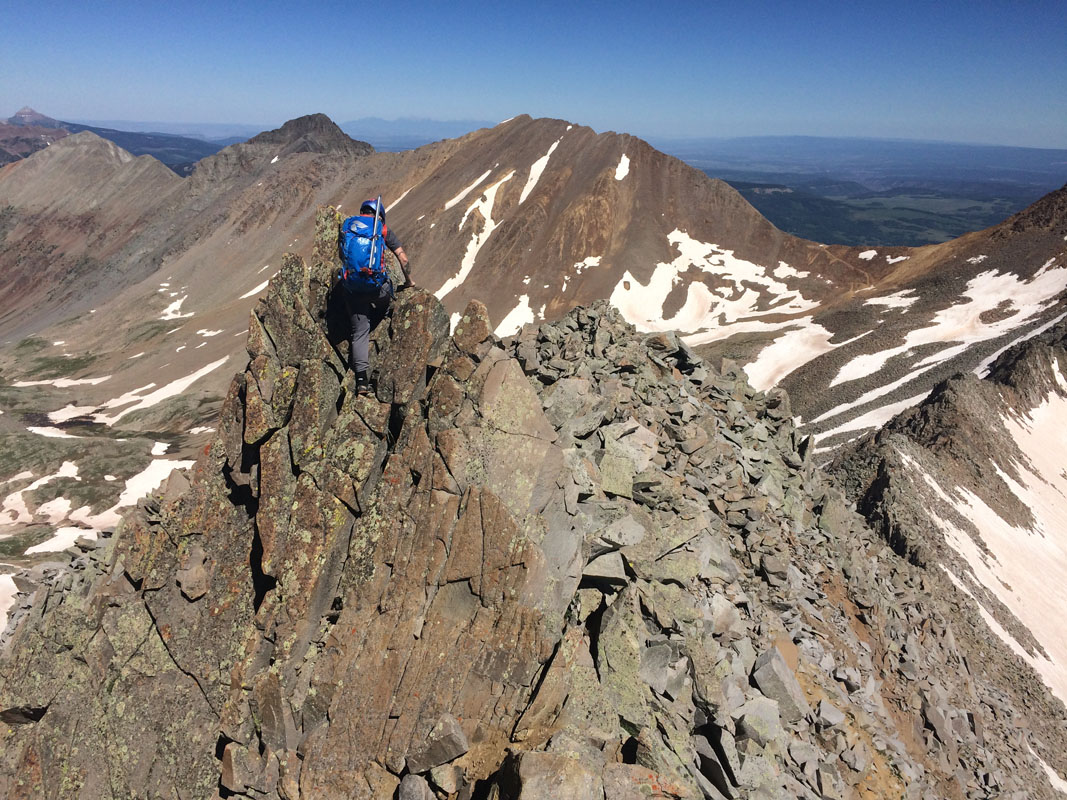
The way down was tricky to say the least. I had to do some interesting manuevers to get across some sections.
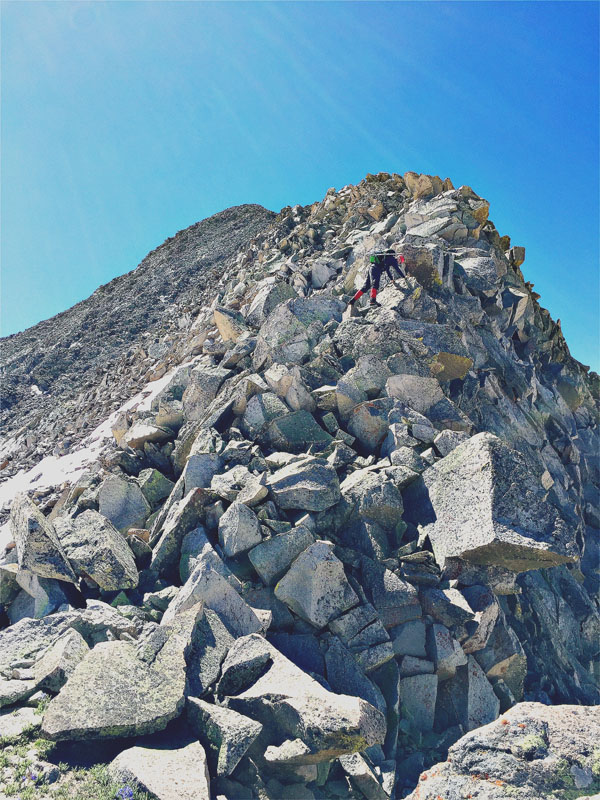
We found ourselves at the top of a gully filled with snow and decided it made sense to fill up my Camelbak with snow and try to get it to melt so that I had water. It actually worked pretty well. We packed the Camelbak very tightly and after awhile it did melt some (about an ounze every 15 minutes. After every sip, I blew hot air back into the tube and the reservior, which helped facilitate the melting process. It was at this point we decided that we would keep going up to Wilson Peak.
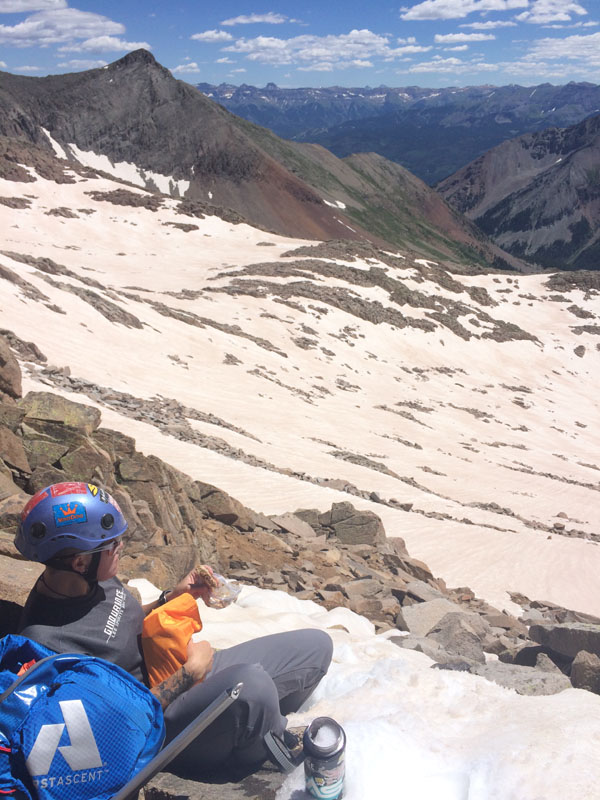
To get to Wilson, we had to go around a small un-ranked 13er between Gladstone and the Rock of Ages saddle. Roach recommends dropping into the Navajo Basin side, but we thought that the Bilk Basin side looked more doable on the snow. I don't regret the decision to do that; however, the snow was steep and soft and made for slow travel with our ice axes. At one point, Silas started to slide and had to self-arrest, which worked like a charm.
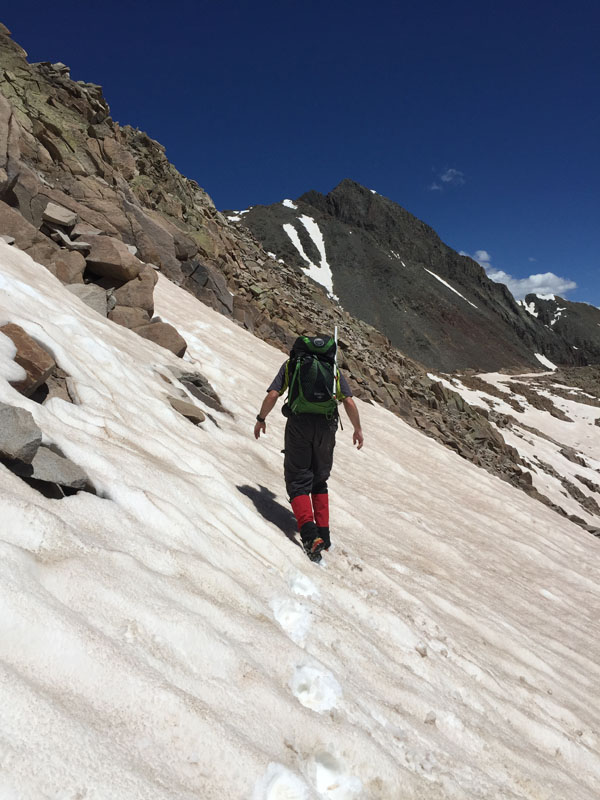
Crossing snowfields sideways is just awkward and slow. Some sections were totally melted and made for uncomfortable and surprising post holing (which sucked)... and other sections were harder and more dangerous. I really dislike snow travel.
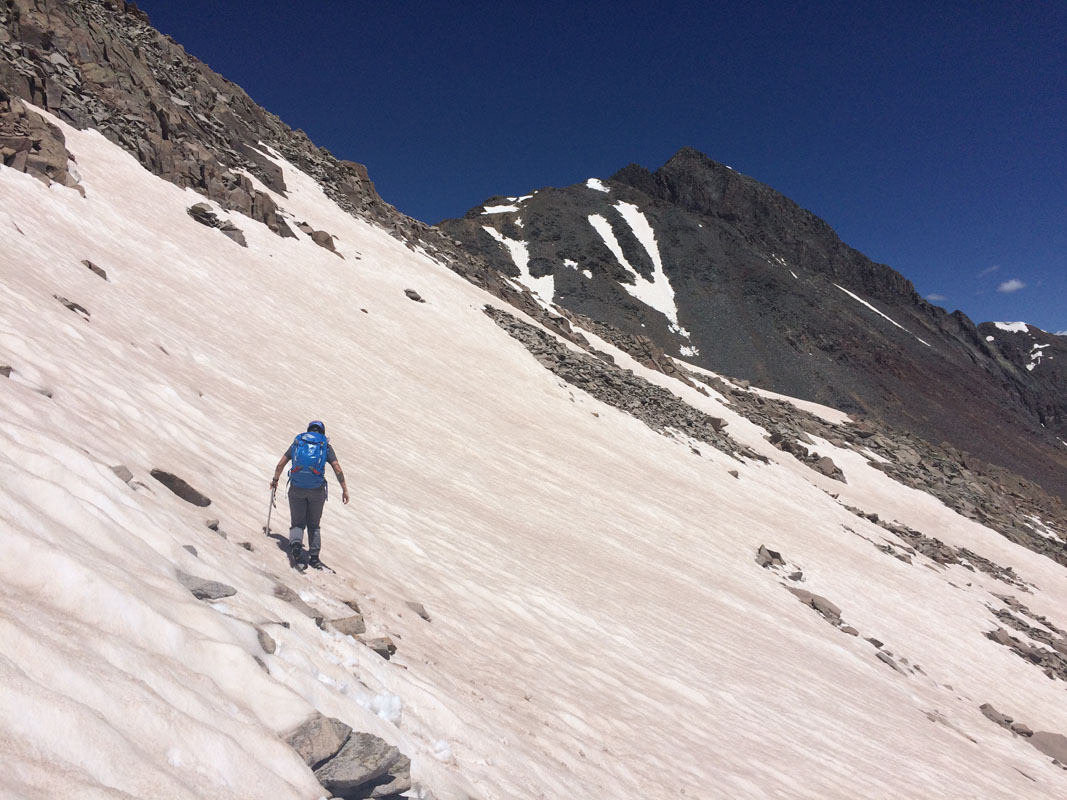
Silas looked bad-ass though...
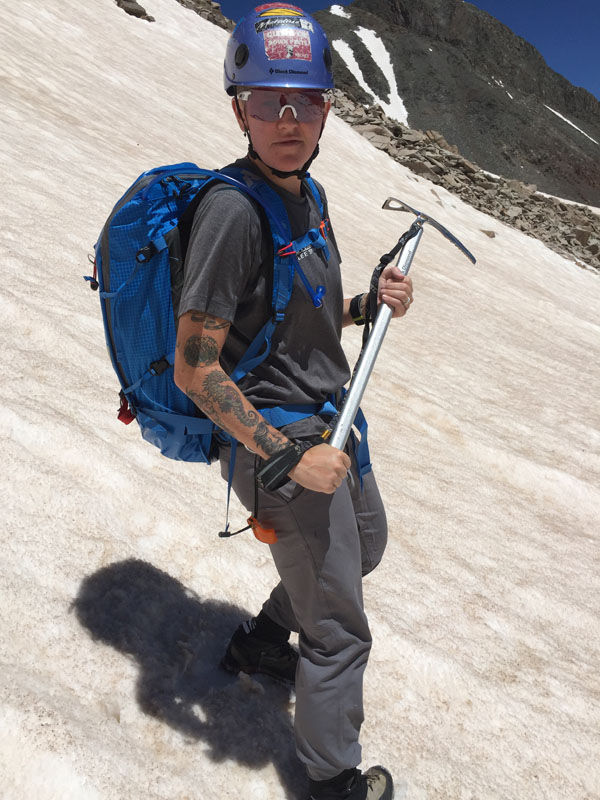
We finally made it to the Rock of Ages saddle and committed to going up Wilson Peak. We passed a lot of people on the way, none of which were wearing helmets, which was a little surprising given the looseness and seriousness of this climb. To each their own, I guess.
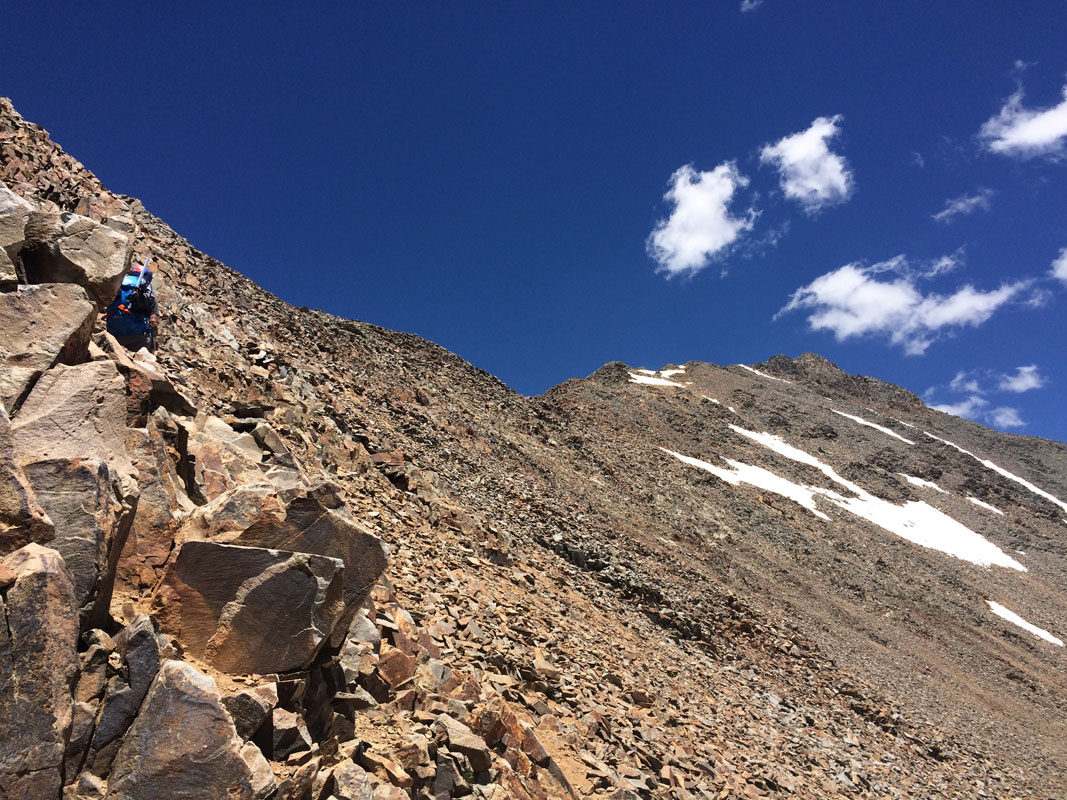
Near the top of Wilson Peak, Silas got to hang out with a Marmot.
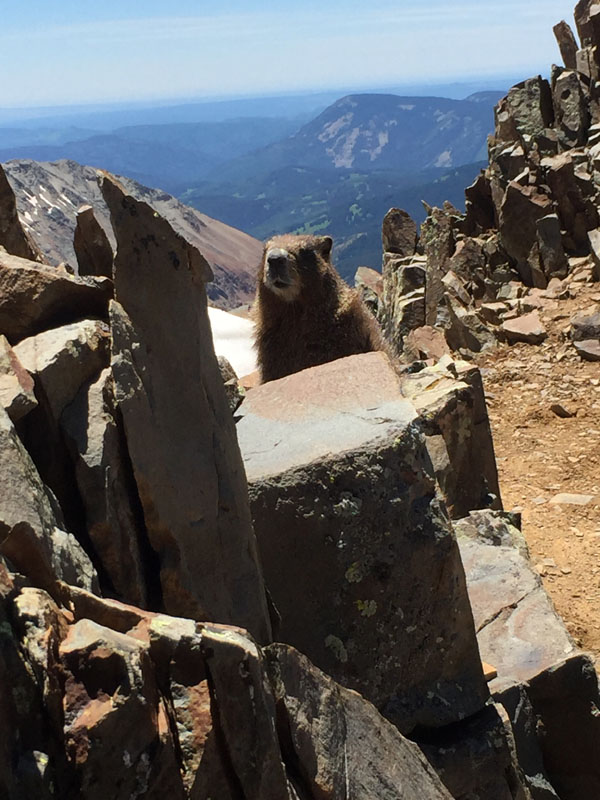
Wilson Peak is probably one of the more challenging and enjoyable 14ers. This was my second time up and I still found it to be quite fun, even after a very long day on Gladstone already under the belt. The rock on Wilson Peak is mostly picked through and the loose stuff mostly kicked or pulled down off the mountain. It still demands respect; however, and the sheer steepness of the final section is a real nail-biter. The consequences of any mistakes would be fatal for sure.
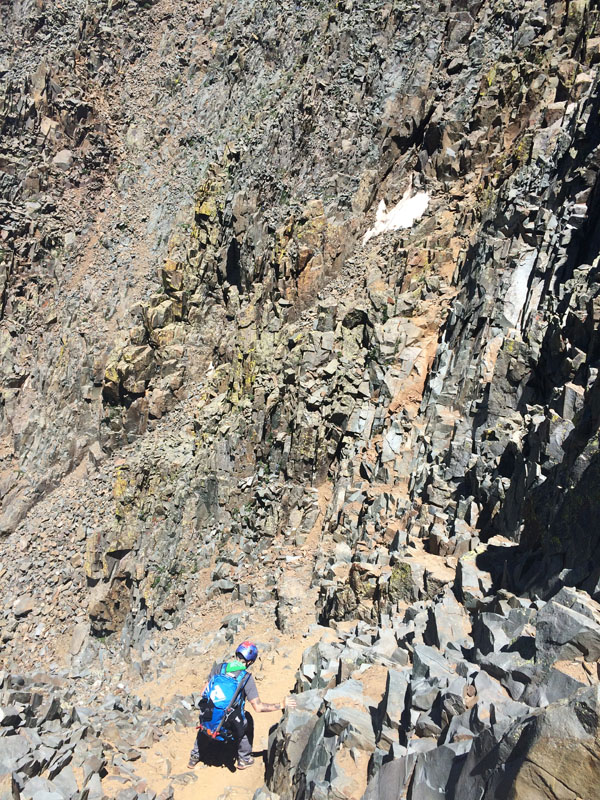
Silas topped out on Wilson Peak just before me and I was able to snap a quick shot on my cell phone of that moment - pretty awesome - two peaks in one day.
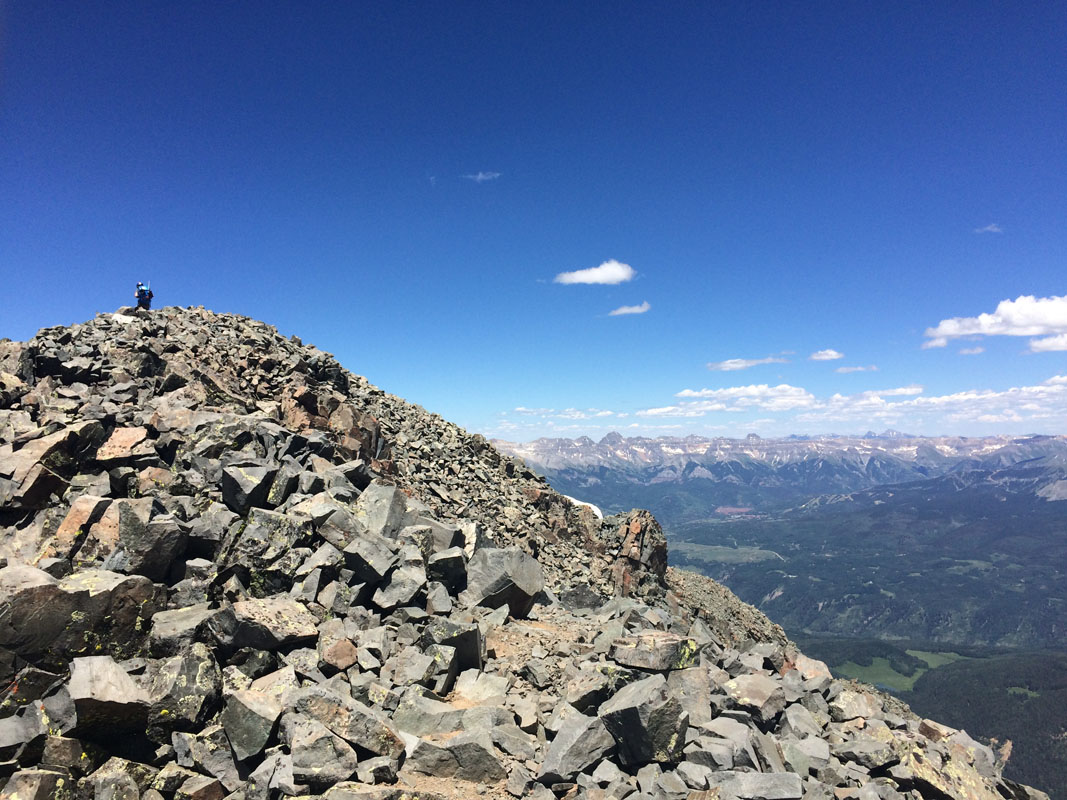
I setup the tripod and we got a self-timer shot of us celebrating.
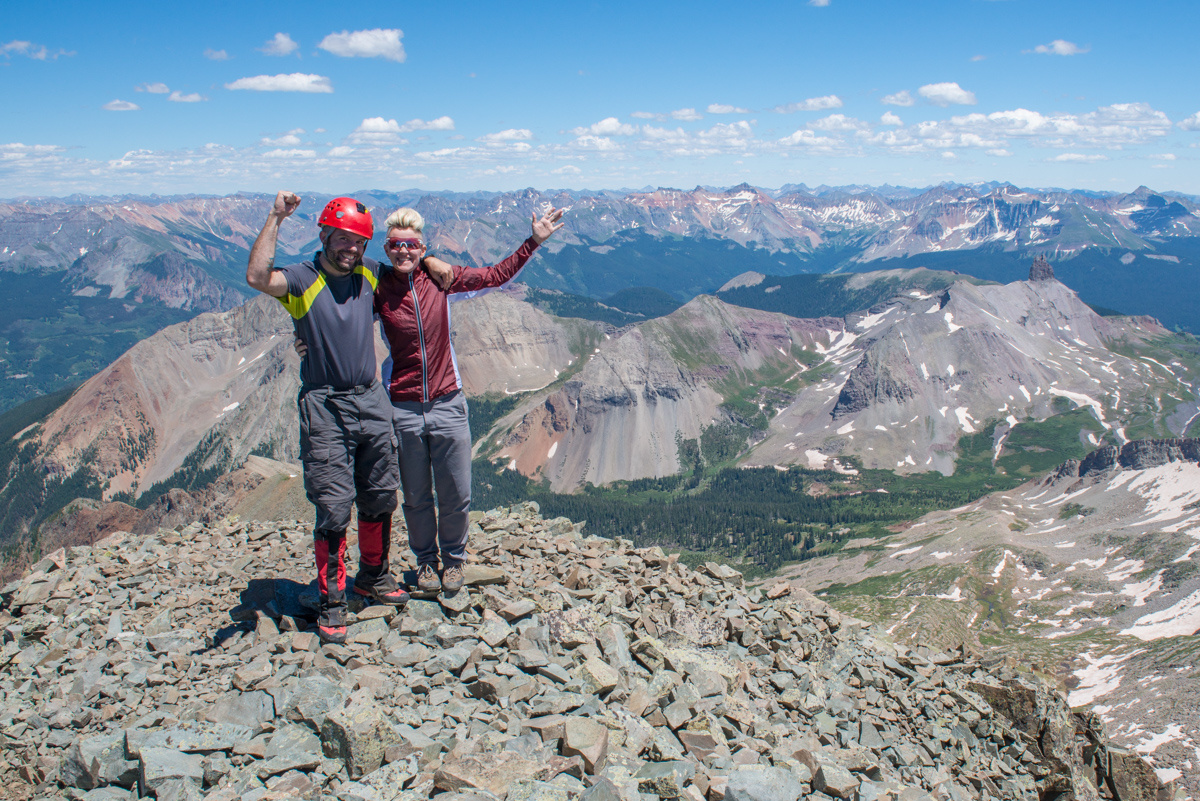
We spent very little time on top and headed back down. Our plan was to take the Wilson Peak trail down just before the Rock of Ages saddle where it meets up with snow that decends into Bilk Basin and to glisade down from there. The plan, while super smart, was not devoid of risk, as I later found out. We reached the snow field and Silas went first. Silas used his axe and feet to keep the brakes on and made it down about 300 feet without issue. I followed on the same path (mistake #1) and sat down in the snow, readied my axe, and started to go. After mere seconds, my speed increased behind a point where I could slow myself with my axe and I began to worry. I knew that I was out of control and heading straight for Silas. This was bad. I'm not sure why, but I remained calm (maybe I read that in Freedom of the Hills) and did not yell or scream even though I was careening out of control towards Silas. I dug my elbows and feet in - nothing. It hurt like a bitch. Per what I read in Freedom of the Hills for an uncontrolled slide, I flipped over on my chest and planted my axe deep into the snow with the long end going into the snow and my hands firmly holding onto the axe part. It worked! I stopped immediately. Silas said he was going to take video of me but before he knew it, I was right next to him. Yep - that's because I was travelling at like 30 miles an hour down the hillside. Two close calls in one day - not OK. We carefully decended the rest of the snow without incident. I grew tired from the lack of water, and I had also run out of food. Fantastic. Way to prepare! We finally reached running water above the lake at the creek that feeds Bilk Basin and we stopped to refill our water. I had fortunately brought my water filter with me (which I usually don't do) and I began to engorge myself with sweet, sweet water. Too much of it... like a half gallon. Whoops. Now I felt sick from drinking too much water too quickly. Not my best day. When we reached the lake, I stopped to vomit, another first. Nothing really came out but it still sucked just the same. I thought we were done with the shenannagins until we reached the creek crossing from earlier in the morning. Guess what? It was about 3 feet higher from all of the snow melt! Fantastic. We both knew we had to keep going down and look for another way to cross. The below photo shows just how much water was coming down...
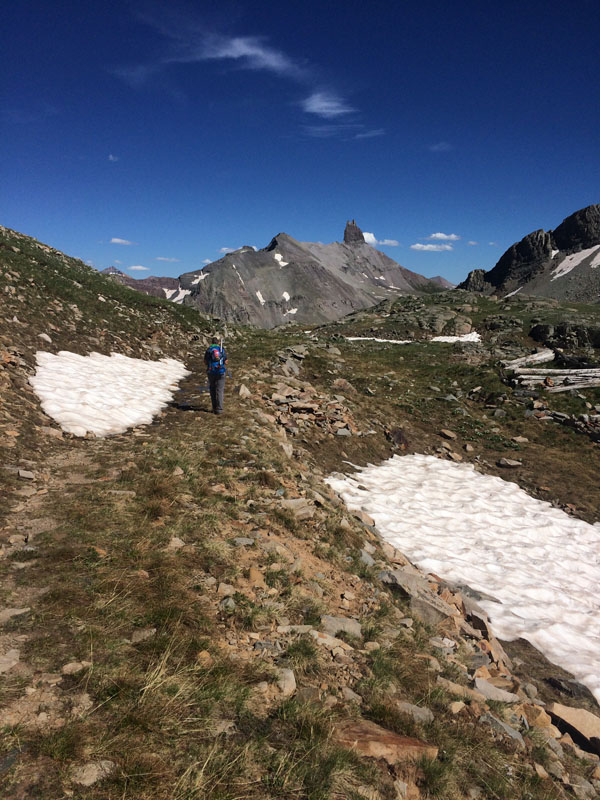 |
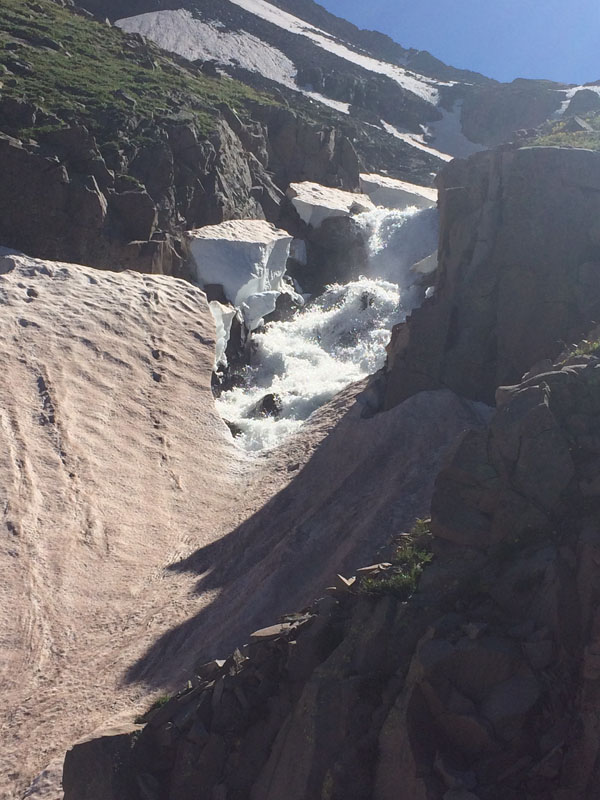 |
Unfortunately, we never did find another place to cross and had to go all the way back down to the start of the basin through Willows and fallen trees. It was a slog. We were both absolutely destroyed, mentally and physically. We had to climb all the way back up about 200-300 feet to our campsite through an area without a trail. Awesome. When we got to the top of the hill to the feint trail leading to our campsite, I vomited again. Excellent. We reached camp and Silas hooked me up with some electrolyte water. That shit works! I was feeling great after about 20 minutes of rest and ready to rock and roll again, excited for photographing sunset. Unbelievable. Sunset looked like it was going to be a total dud. The first "wave" of light after the sun set was pretty dull, some weak yellows and golds in the sky... then out of nowhere I looked back and saw the sky filled with small clouds all turning pink and purple. I ran out to a decent spot out of camp and barely had enough time to snap off this shot of sunset... which faded after only 2-3 minutes. We ate dinner and celebrated our accomplishments.
After dinner, I was totally exhausted. I knew that I really wanted to get some Milky Way photographs over Lizard Head Peak, but was not sure if I could make it long enough awake to pull it off. I slowly hiked up the hill to the south of our camp to find a spot. I was so exhausted after finding my spot to shoot that I set up my camera on my tripod, found a spot to lay down in the grass, and set my alarm on my phone to wake up two hours later so I could not miss the amazing night sky scene. This one did not disappoint - the dark skies of Southwest Colorado are not easily surpassed in quality. The position of the Galactic Core above Lizard Head's impressive massif was just about perfect with the dimly illuminated moon shining just the right amount of light onto Lizard Head Peak. This is a single exposure shot using the Nikon D800, using the 14-24 f/2.8 lens at f/2.8 at 24mm for 15 seconds at ISO 6400 and in-camera noise reduction.
I also was able to shoot some pretty nice panoramas, sweeping from right to left, getting 13,113 ft. Lizard Head Peak (right), 12,930 ft. Sunshine Mountain (center), and all of the Mount Sneffels area peaks in one photograph, above Telluride.
Lastly, I went for it all, getting Wilson Peak in the mix in a 360 degree panorama. The clouds were a really awesome compliment to the Milky Way.

I was pleased with my efforts to capture the night sky and head back to camp to get some much needed sleep. We decided to sleep in and then hike out, which meant Silas would have to return another day to get Mount Wilson. The "trail" down Bilk Basin from the Lizard Head trail was non-existent. We had to cross through some really huge fallen trees before we reached the creek again and trail out. Add in yet another memorable experience, why not?
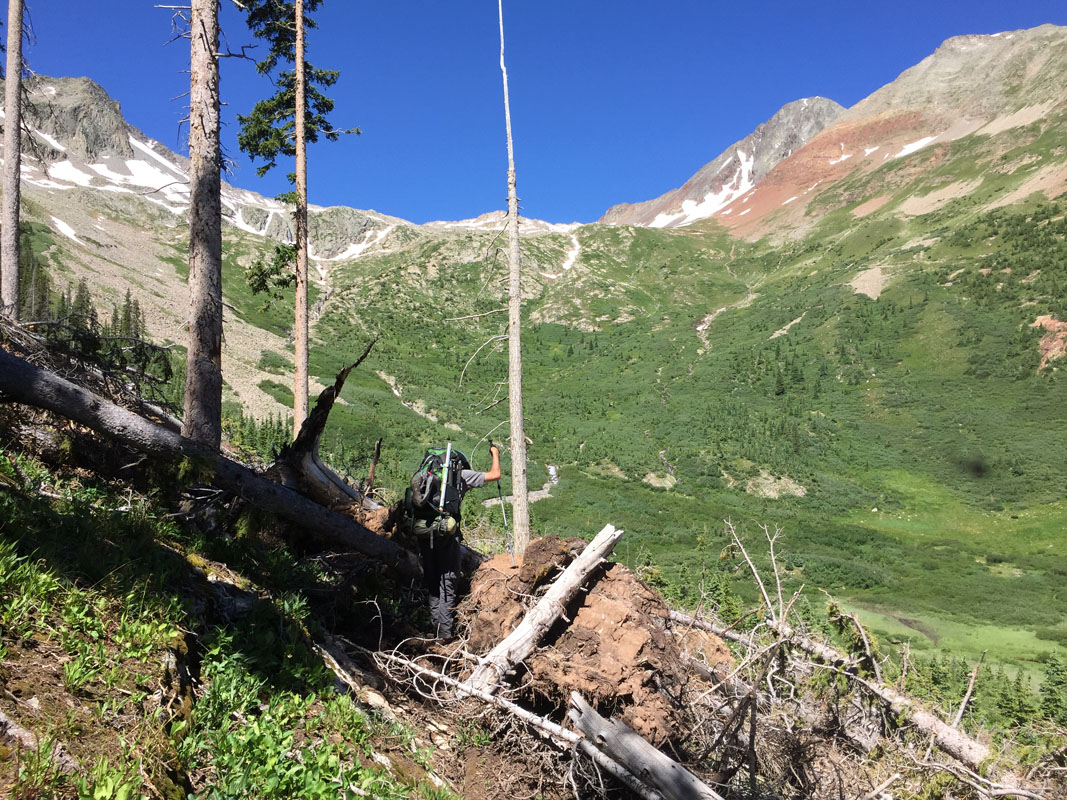
We cruised down the Sunshine Mesa trail in no time, passing some day hikers on the way. We settled on Tellurde Brewing for our final stop to get some brews and to commemorate our unforgettable backpacking adventure before heading home.
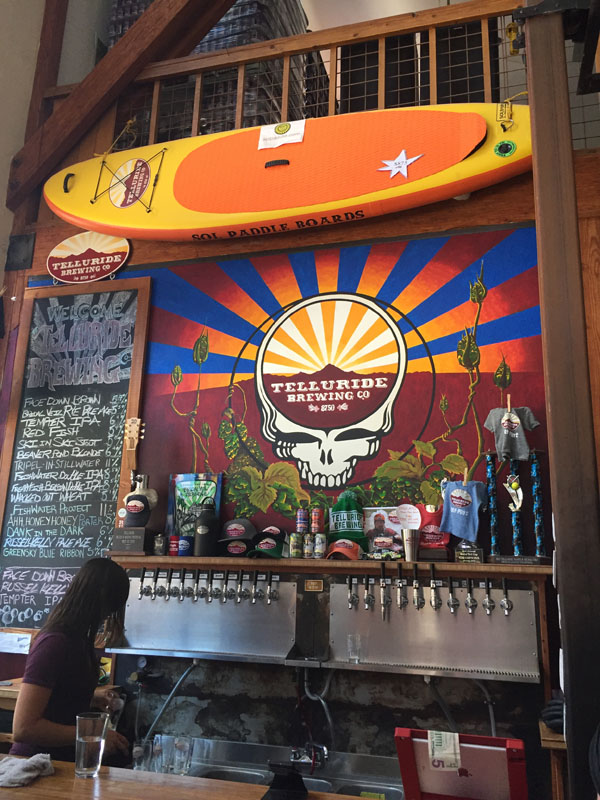
Tellurude Brewing has some fantastic beers! I think my favorite was the Freshwater Double IPA or the Brown on nitro. Yum!
You can view and download my GPS track from Gaia GPS HERE. Hope that it is useful!
Adventure to Jones Mountain from American Basin
After an amazing day of rigorous hiking which culminated in a successful summit of Half Peak by Sarah Musick and I, we slept at our fantastic campsite in the picturesque valley below Cuba Gulch, near Lake City, Colorado. Instead of taking the longer, more scenic (and steeper) route to Jones Mountain via Cataract Gulch near our campsite, Sarah and I opted to drive over to American Basin and approach Jones Mountain from that side. Usually, climbers looking to summit Jones Mountain approach it from Silverton; however, because Sarah and I were already on the Lake City side of Engineer Pass and were driving a Suburu Forester, we decided to take an alternative route. I had researched our route ahead of time by consulting the out-of-print and quite handy 13er guidebook by Gerry Roach. Upon arrival at the American Basin trailhead for Handies, Sarah and I set-up camp and she decided to quickly hike up Handies since she had never done it before. I decided to stay behind and rest my legs. My ankle was still quite sore from my basketball injury two months prior and my legs were feeling pretty heavy yet from our climb up Half Peak. I spent the afternoon napping by my camera while taking a time-lapse video of wildflowers in American Basin. Upon Sarah's return from Handies we celebrated by opening up some Odell Myrcenary, one of my favorite Imperial IPAs. Good stuff.
After enjoying our beverages, I convinced Sarah to hike up American Basin with me for some photography. The clouds were setting up nicely for sunset and I found a sweet little waterfall which made a nice combination with American Peak in the background. Sarah shot a quick panorama of me setting up a shot in the basin with her phone which depicts the scene quite well I think.
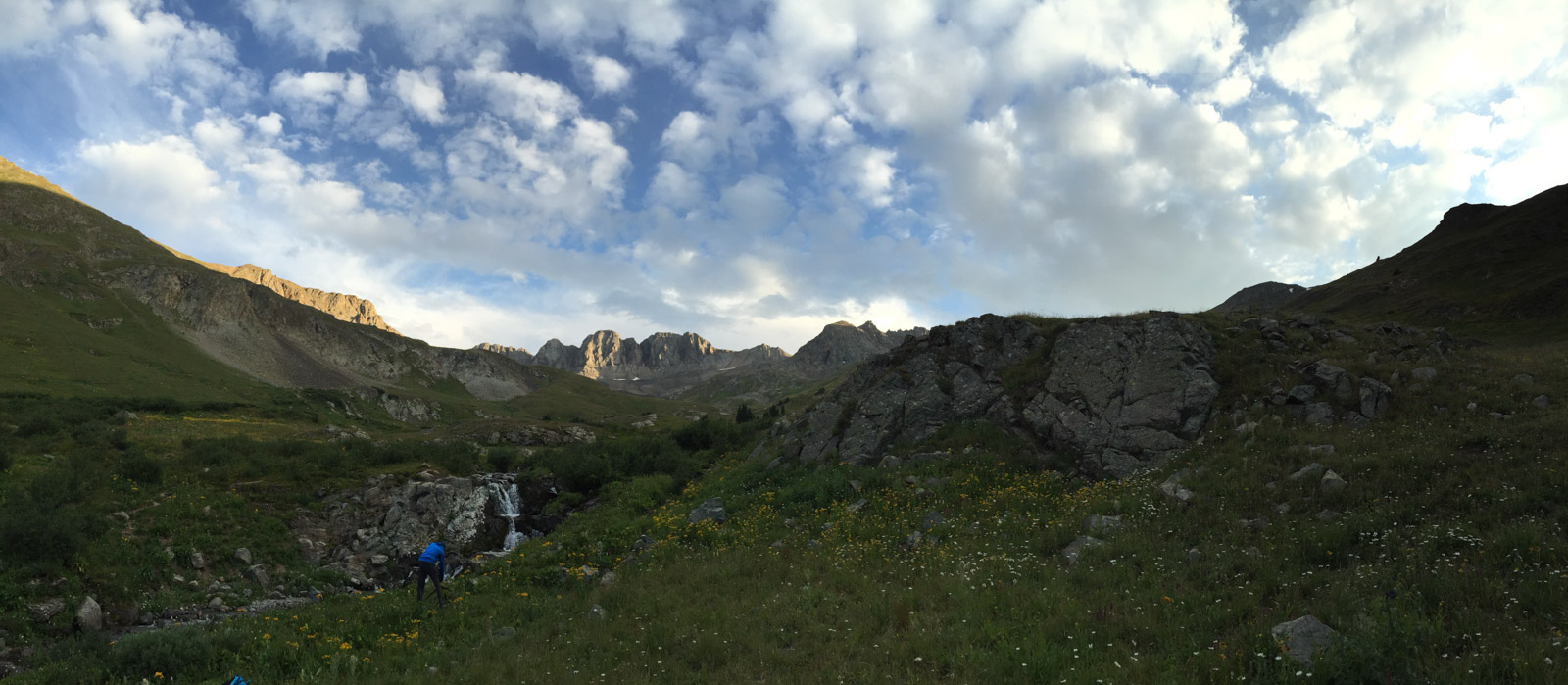
And here's the shot I was setting up to take...
I also decided to hang out past sunset and well into the night in order to get some night photos. I always wanted to get a Milky Way selfie and I thought this spot would be perfect for that shot.
I also set-up for a Milky Way panorama from this spot, relying on the faint light of the moon to light up the hillside.
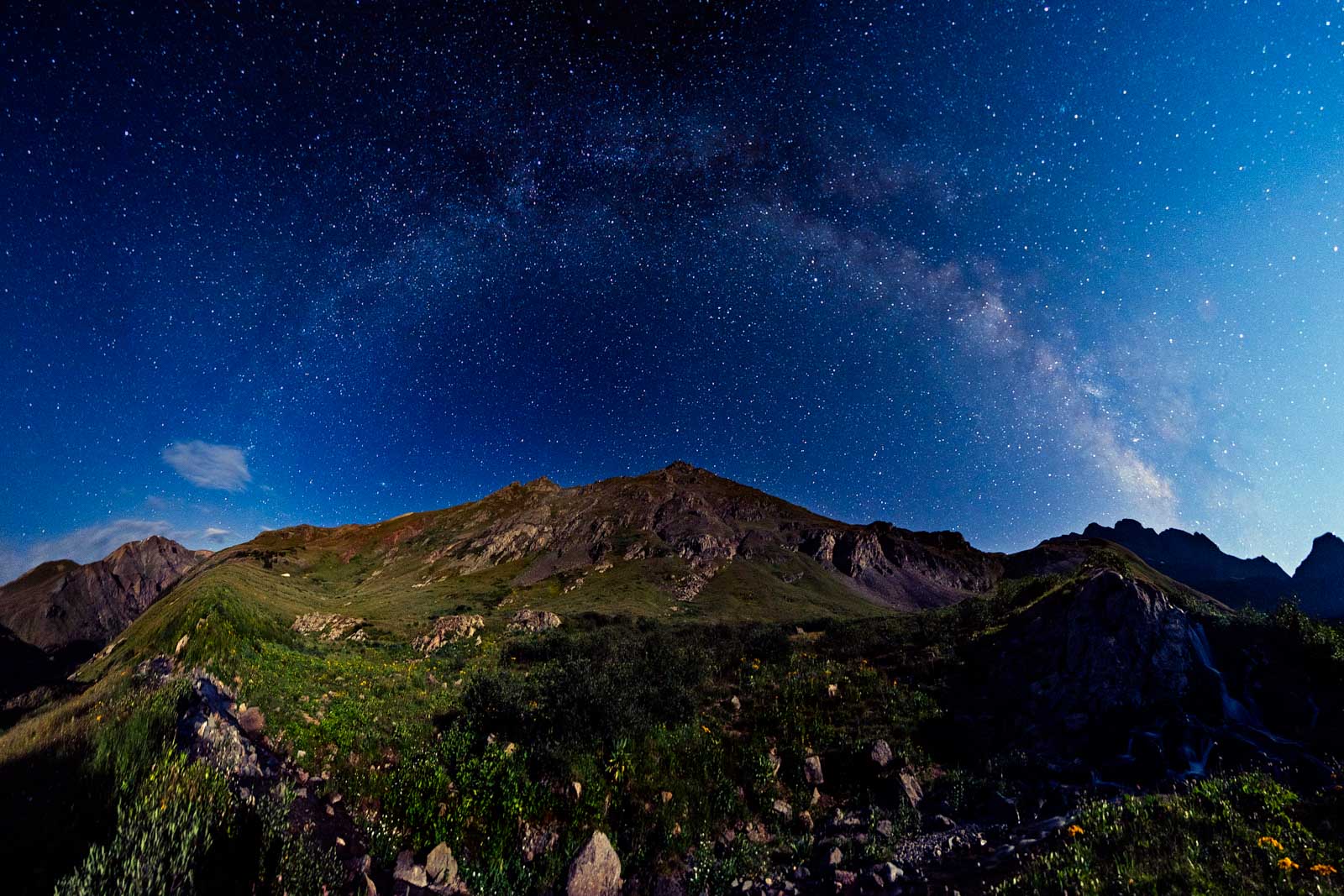
After freezing my hind quarters off, I decided to head back to camp and hit the sleeping bag for some sleep. Knowing the weather would be great, we decided we would start early enough to get some photographs of the basin at sunrise, but not so early that we would be hiking in the dark. Our route took us up the main Handies Peak trail and then off-route for most of the rest of the day. After hiking about 1/4 of the way up Handies, we split off the trail and started our leisurely stroll up the fragile tundra and wildflowers below American Peak. As the sun began to rise, American Peak began to light up with sweet alpenglow.
The view of UN 13,535 behind us wasn't so bad either...
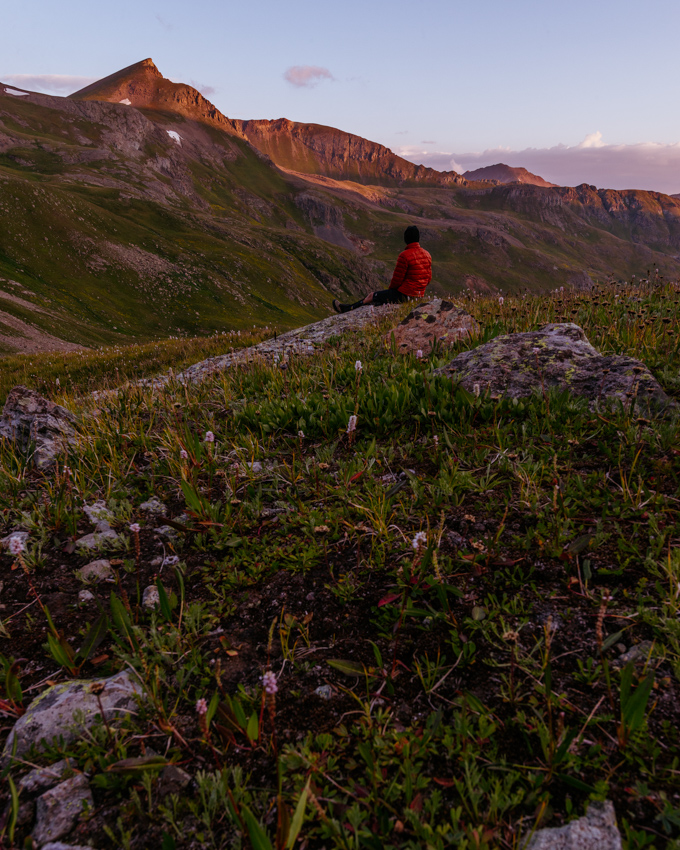
After enjoying the awesome sunrise, we began to head up the un-trailed section to the west saddle of American Peak. Our target was the lighter colored rocks as seen below. We planned to just bushwhack our way up the side of the mountain.
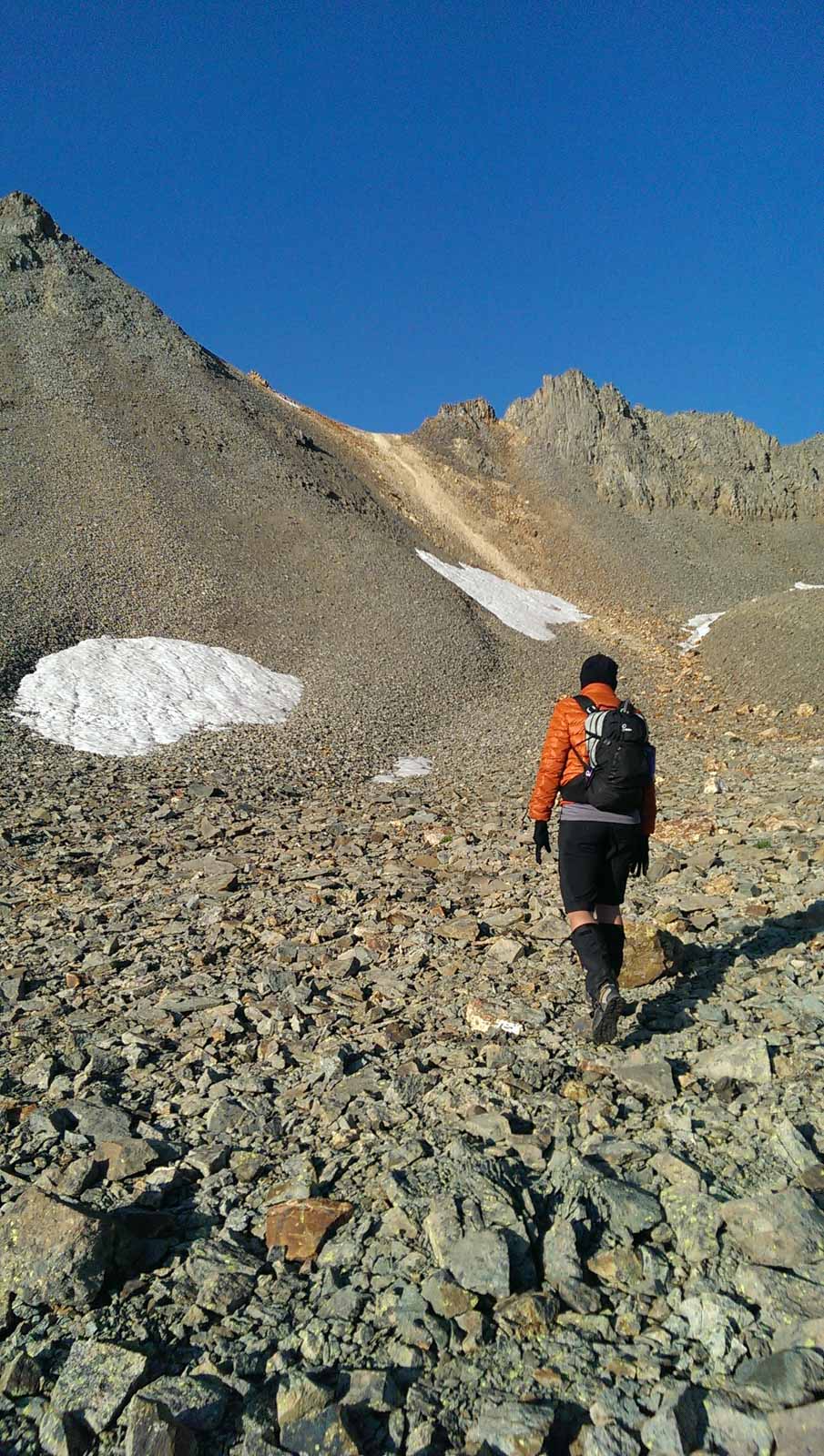
The climb was not too bad - the hardest section was the loose scree and dirt just below the saddle.
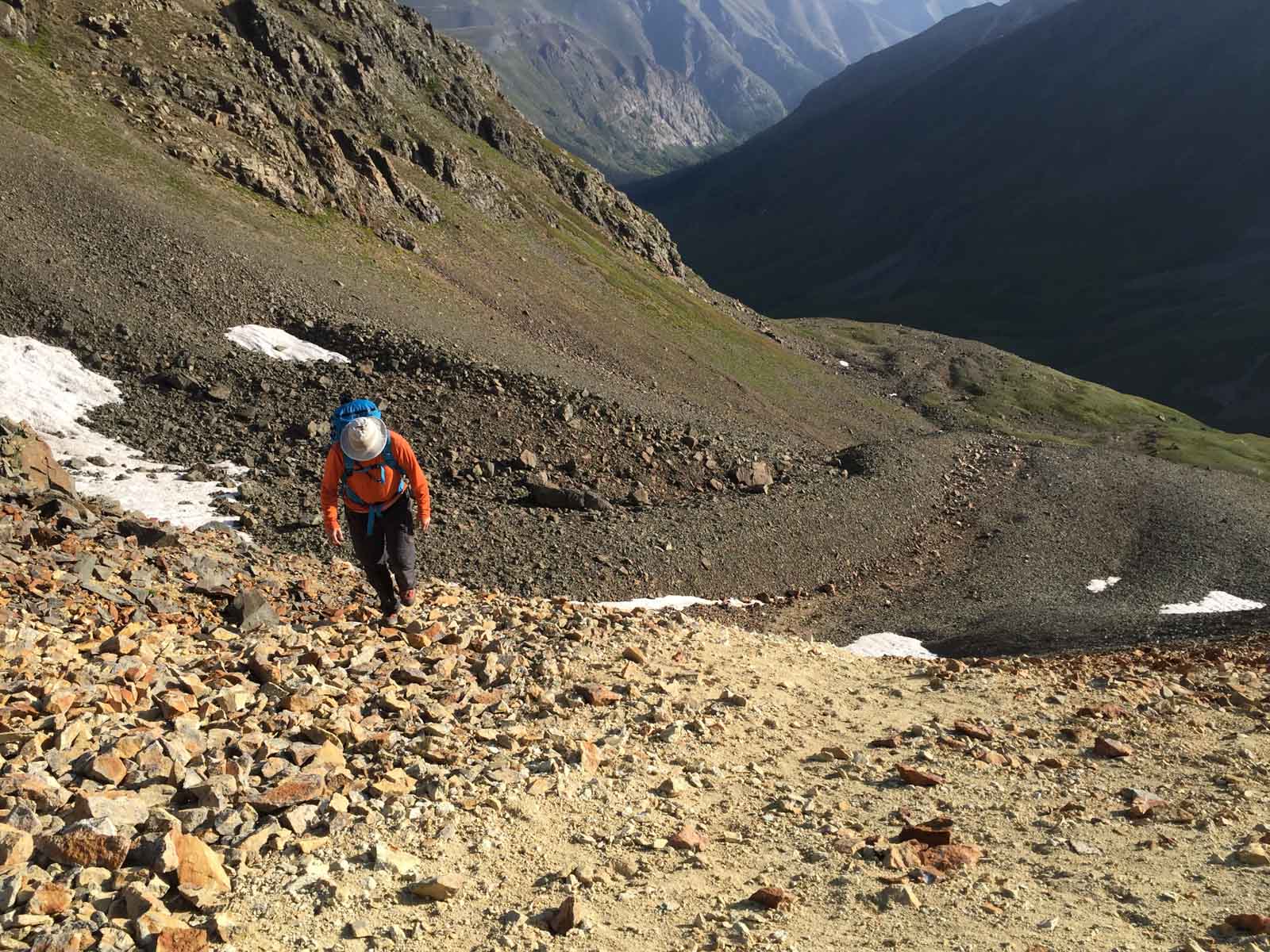
We were quite excited to reach the saddle and get our first glimpses of Jones Mountain.
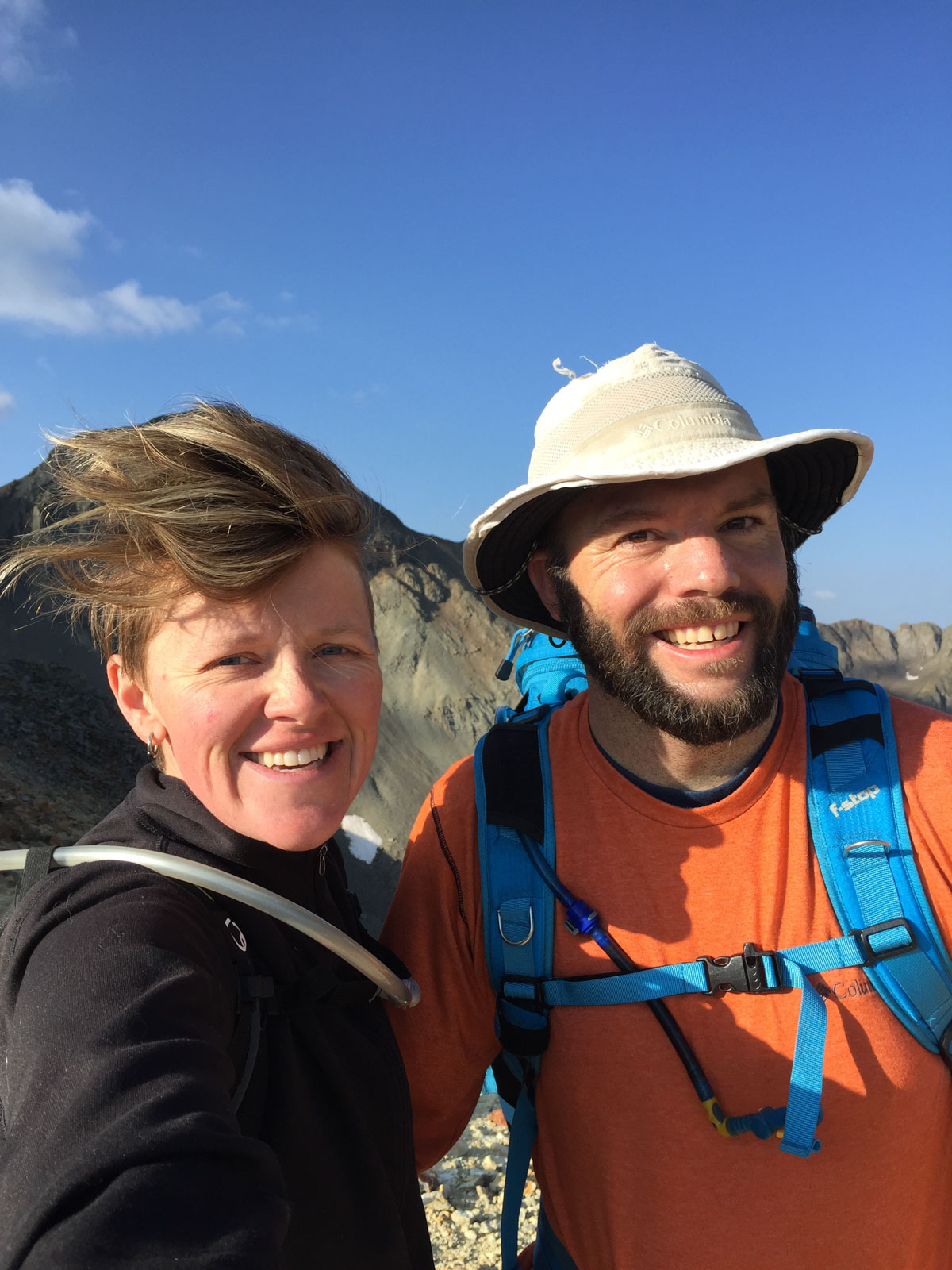
Our route took us up a very faint trail to the ridge between American Peak (left) and Jones Mountain (right). The hiking was pretty easy going.
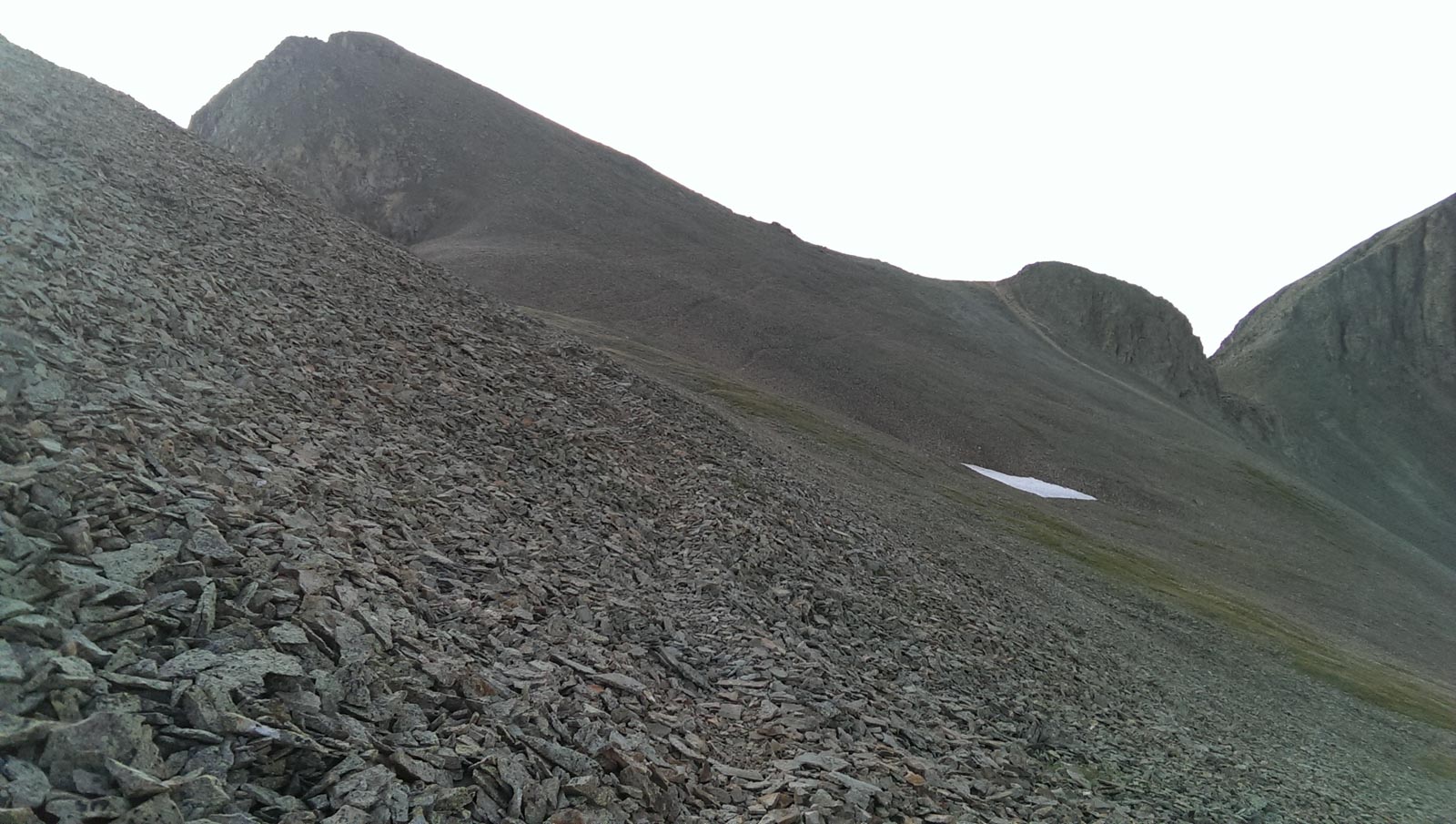
Once we were between Jones and American the views opened up a bit and we could see just how rugged Jones looked from this vantage. The summit of Jones is seen at the far right.
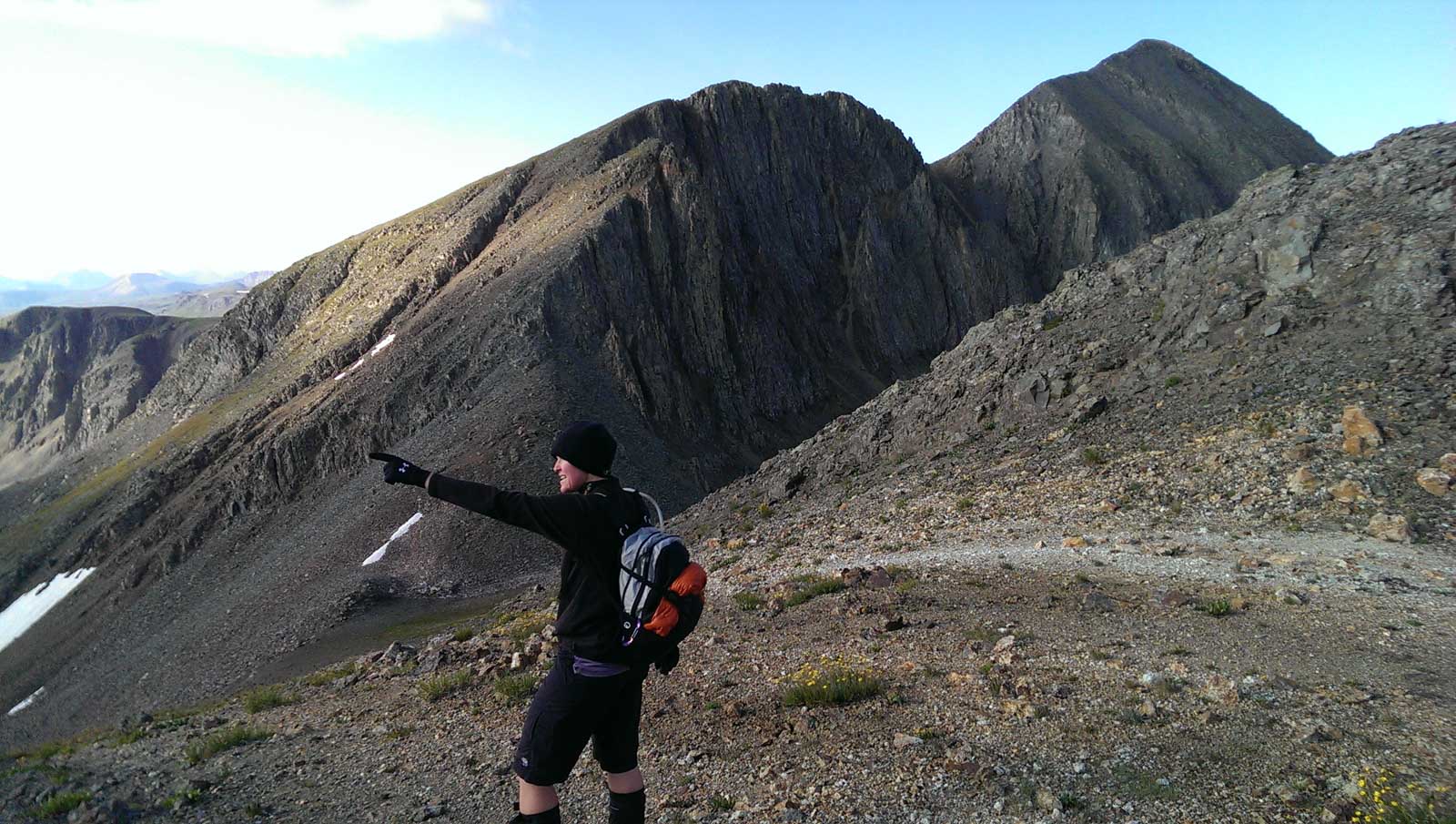
We headed down (and then up again)...
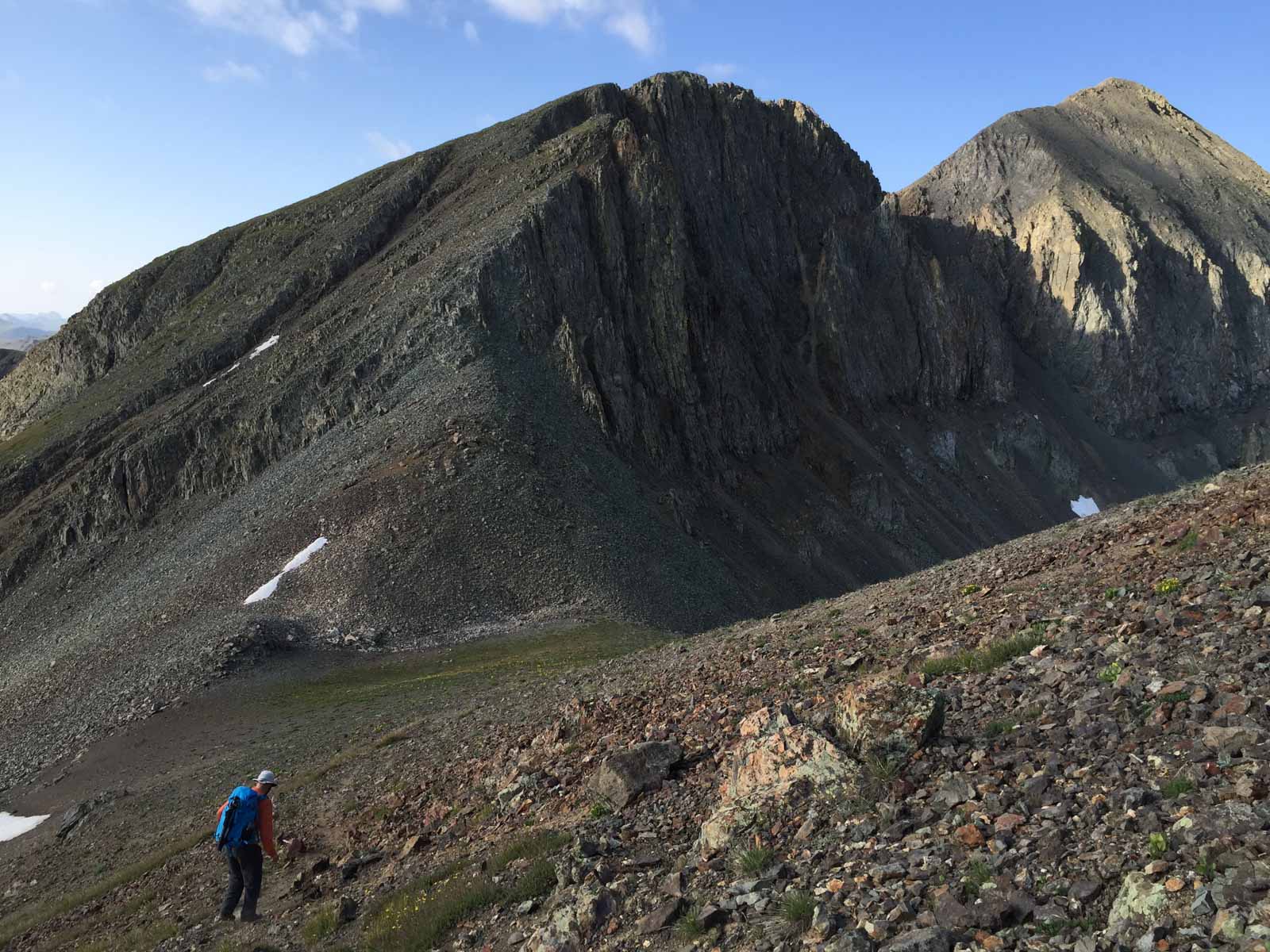
Upon reaching the summit of Jones Mountain, we ran into another hiker and his dog. My mind was blown when I realized that the other hiker was Mike Megorden, a friend of mine from high school! We played on the high school football team together. Pretty small world!
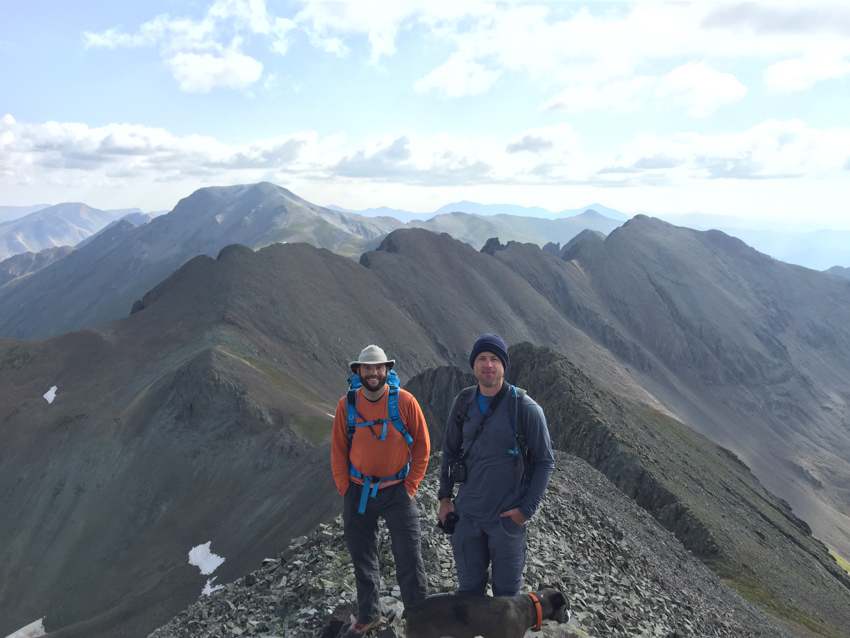
Sarah and I celebrated our 16th summit together with views of the Grenadiers and Needles behind us. What an amazing view. Oh, how I had missed this part of Colorado!
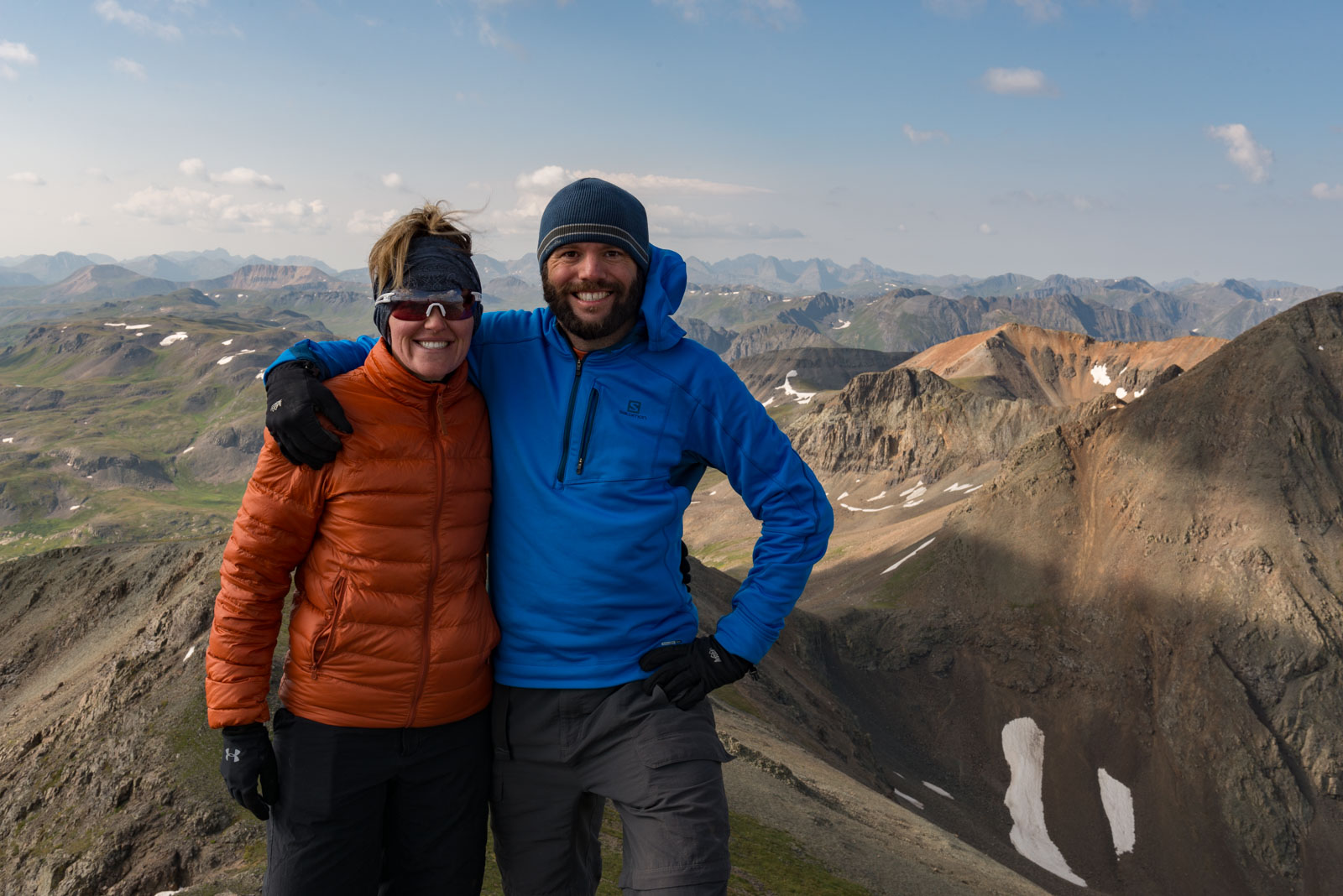
I set-up my tripod and shot some panoramas using my telephoto lens. The air was still a bit hazy, which added some interesting tones to the photos. Looking south.
Looking south-east.
Looking east. You can see the rugged ridgeline of American Peak.
Looking north east - featuring Uncompahgre and Wetterhorn.
Looking north.
Looking north-west.
Zoomed in on Uncompahgre and Wetterhorn. I think this one would look pretty nice printed large.
After enjoying the views we decided to head back down. We were contemplating American Peak and would need to make a decision when we hit the American - Jones ridge. The weather was looking 50/50.
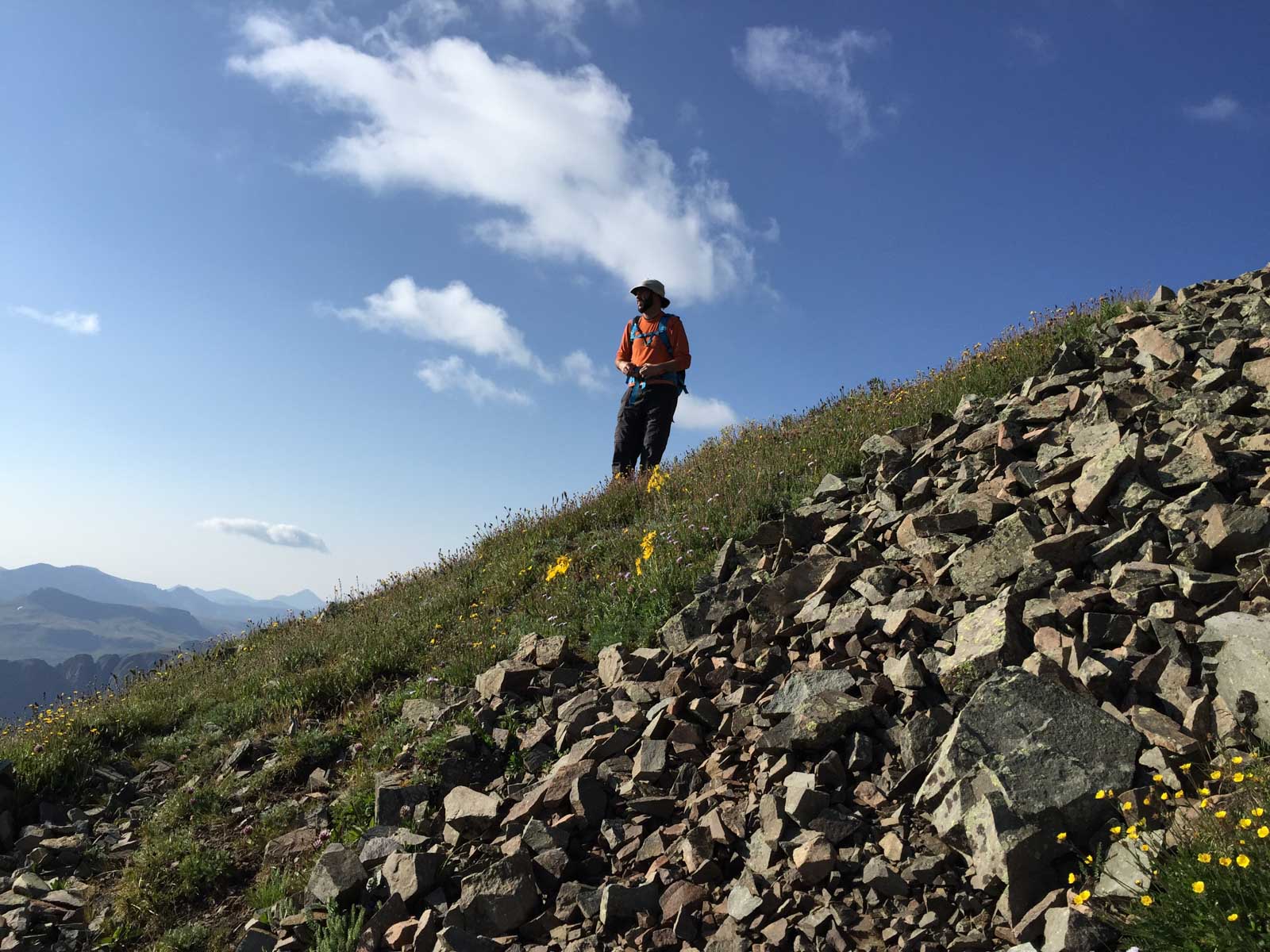
A glimpse sideways at Jones' north face reveals how rugged it really is.
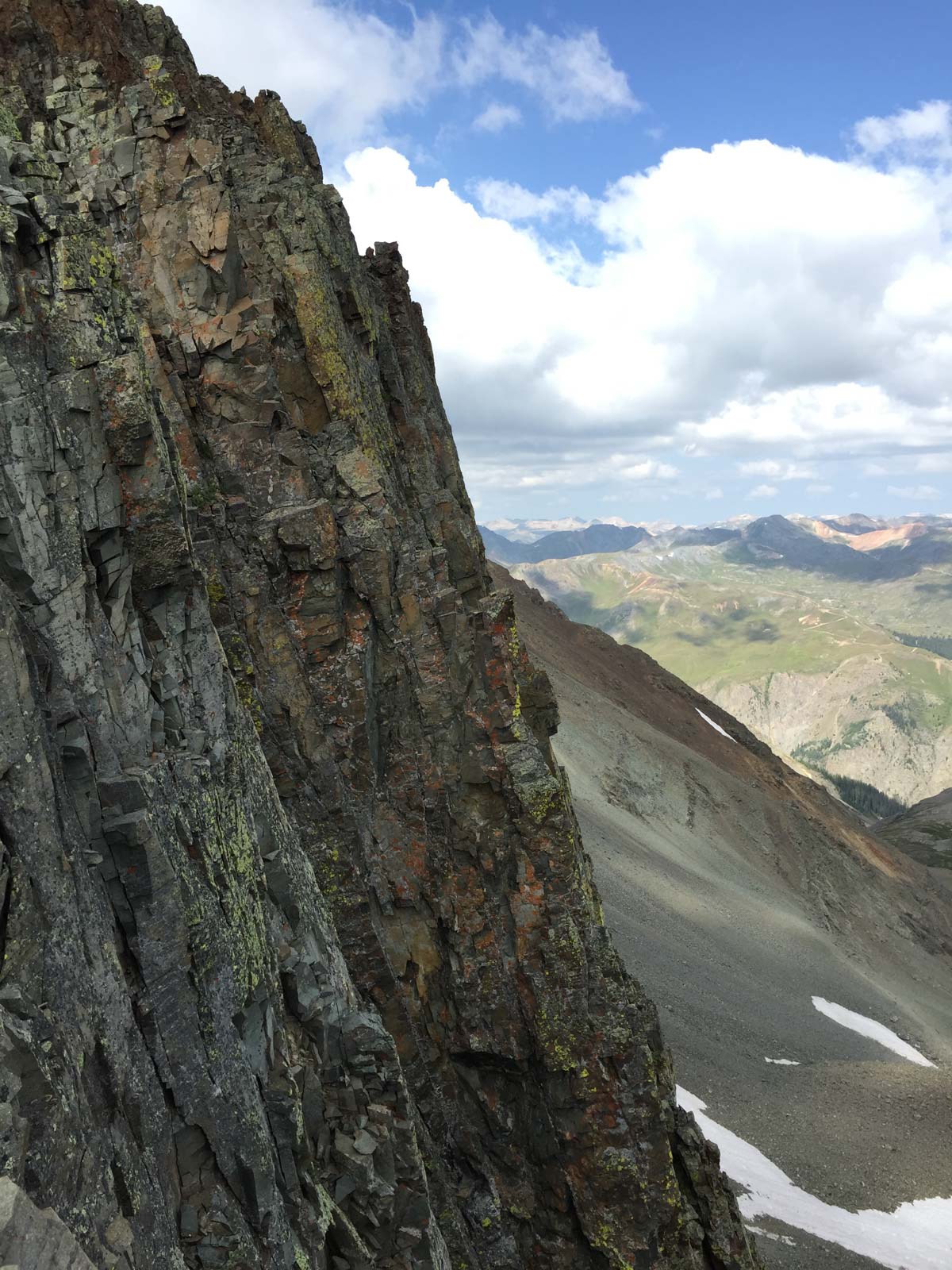
I was pretty amazed at how great the flowers still looked for this time of year. Here's a shot of some alpine sunflowers with Jones in the background.
Sarah and I rested at the ridge and decided not to take on American Peak - the weather was starting to look a bit questionable; however, the tundra was quite inviting for nap-time.
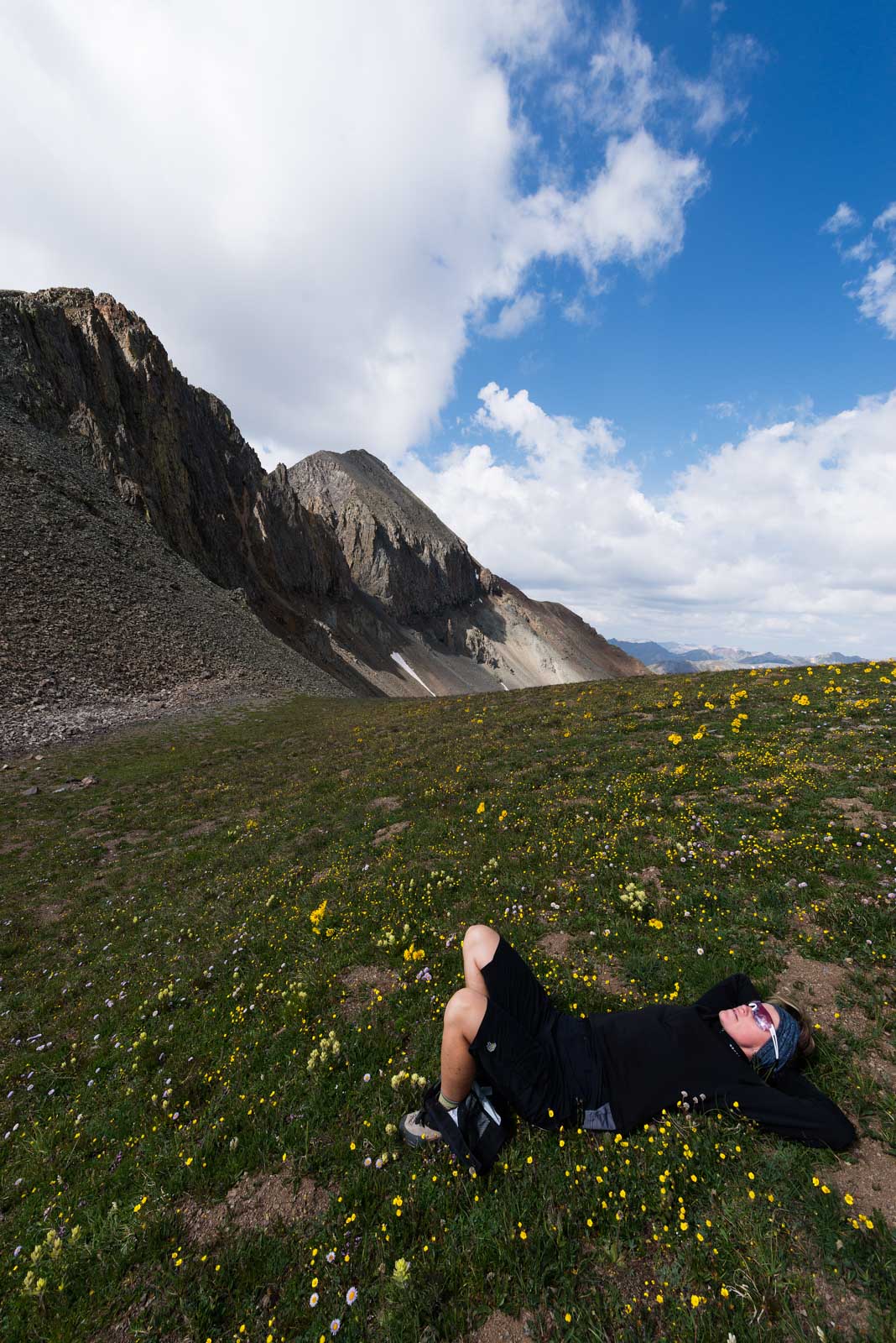
Sarah and I took our time heading back, enjoying the great scenery on the way.
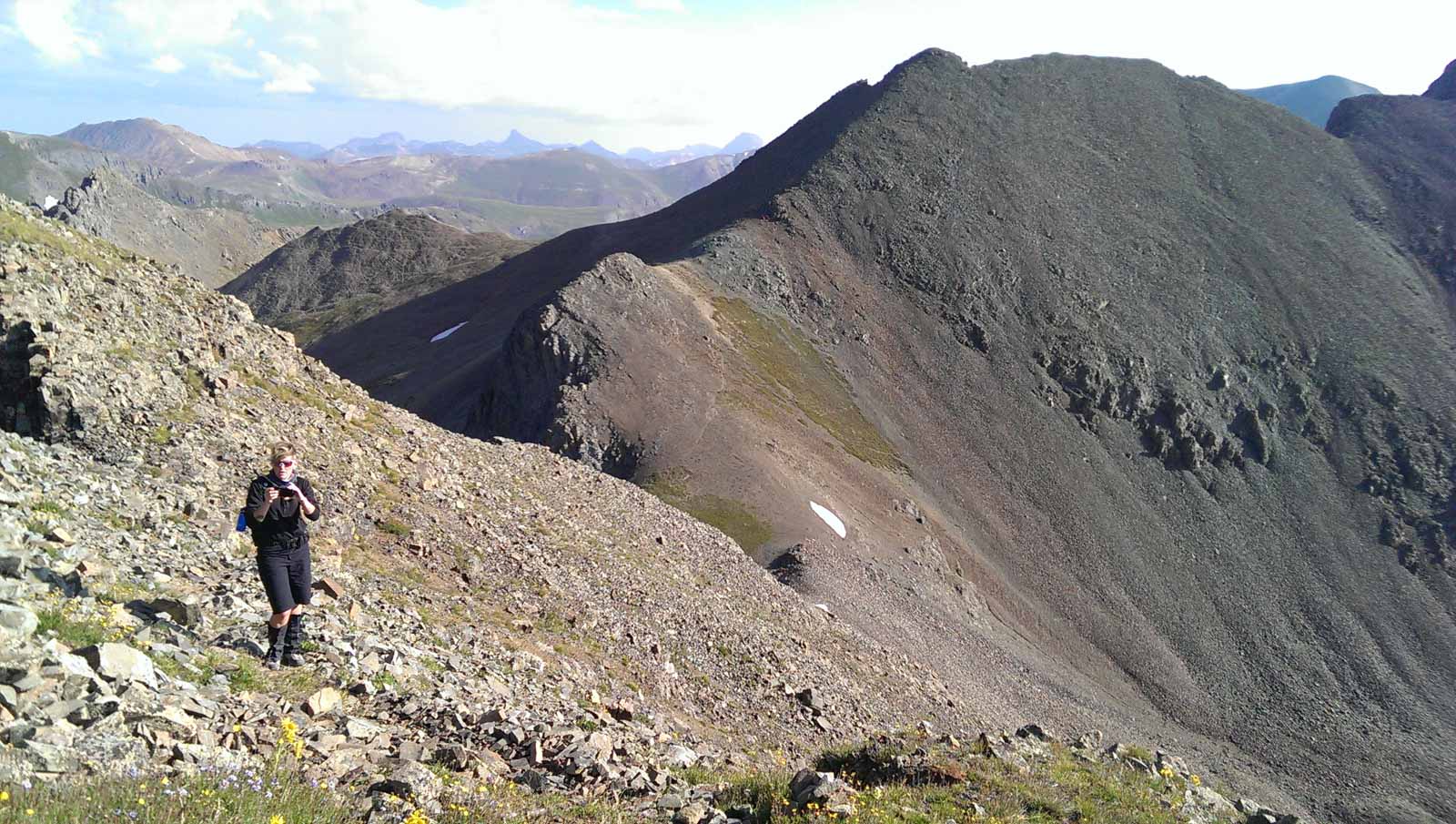
Back on the American Basin side, we ran into a huge field of wildflowers which I had to stop and take photos of. I really want to go back and get this same shot at sunset or sunrise someday. Here's a shot Sarah took of me composing my photo.
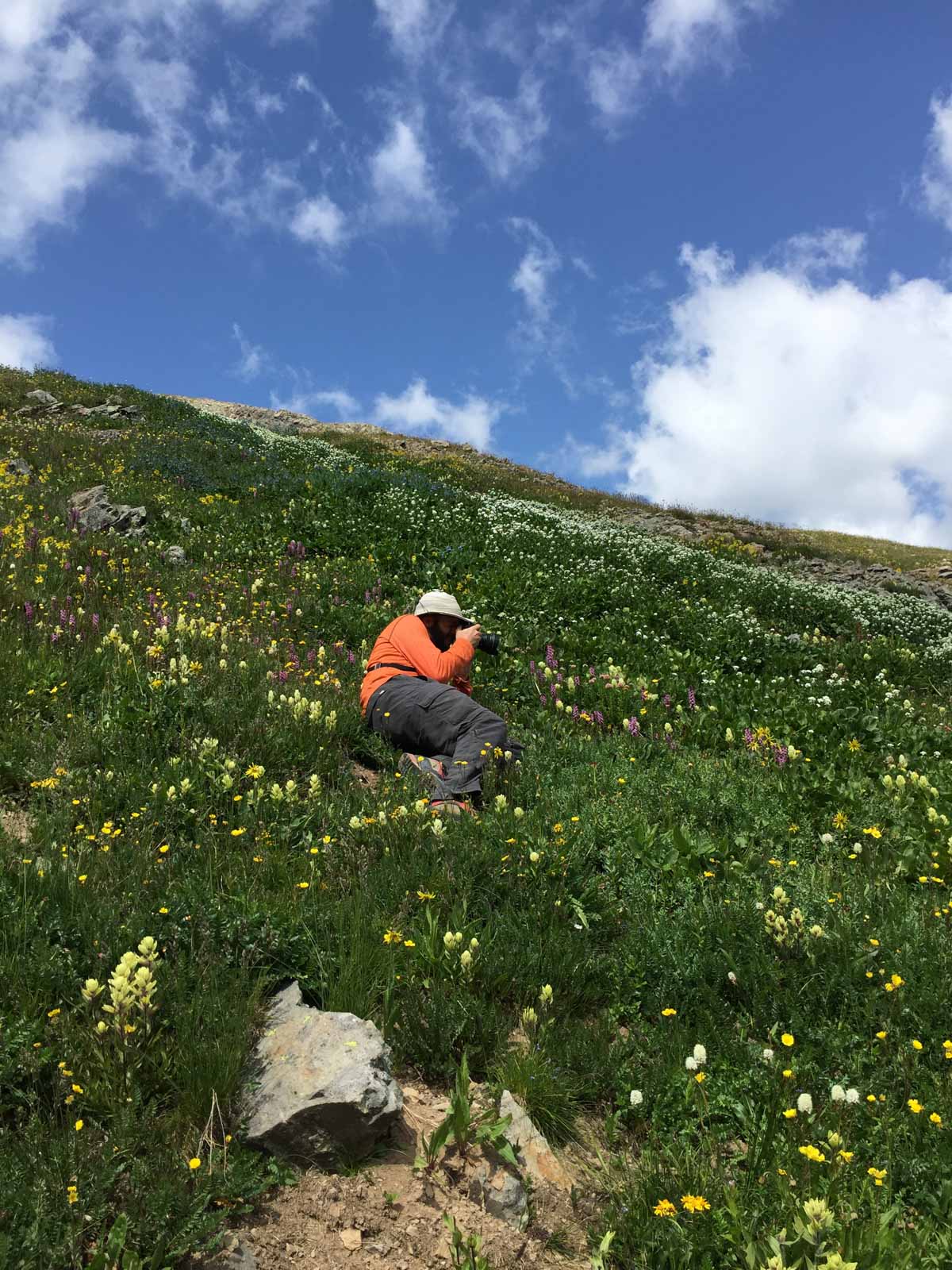
And the crown jewel shot of the day - a mix of awesome wildflowers with the shoulder of Handies Peak in the background at the right. American Basin truly is one of the best spots in Colorado.
Sarah and I got back to our campsite and packed up. We decided to drive back to Lake City and up Nellie Creek for our next adventure: Uncompahgre Peak. I had done Uncompahgre back in 2000 with my dad, but was excited to see if I could get some photos at sunrise from the top. We cracked open some more tasty Odell brews and prepared for our next adventure...
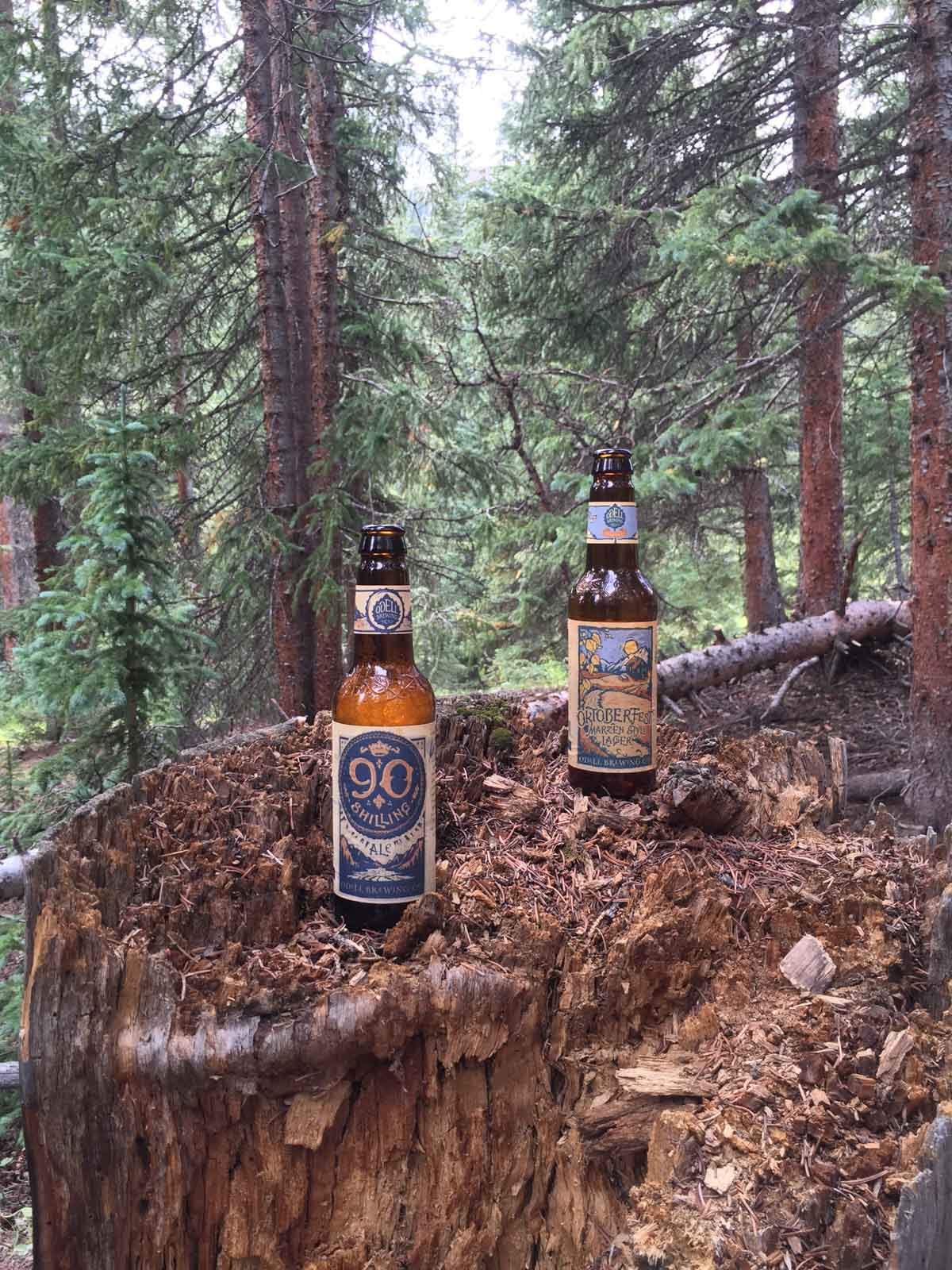
I hope you enjoyed following along for this adventure up Jones Mountain. Next up: Colorado 14er Uncompahgre.
Perseid Meteor Shower at Ice Lake Basin and a climb of Vermillion Peak
When the dates for the 2013 Perseid Meteor Shower were released, I knew I wanted to schedule some time in a very remote location to capitolize on the opportunity to capture as many meteor shower photos as possible. I did a little research and took a look at my remaining Colorado Centennials that were left to climb and enthusiastically declared that the Ice Lake Basin would be the perfect location. I knew that the trip would be amazing for a photographer, but perhaps boring for someone that is not into photography. I reached out to my friend Ryan Fonkert to see if he would be interested in joining me on a tour-de-Ice-Lake-Basin to shoot the Perseids and to climb Vermillion Peak. Without any hesitation he said he would join me.
Photographing meteor showers has only recently been something I've wanted to do, and my first successful foray into that realm of photography was back in December 2012 for the Gemind Meteor Shower, where I was able to come away with this photo:
Ice Lake Basin has long been on my radar as a location to visit. Ideally, I wanted to visit the area during the peak of wildflower season due to the idyllic photograpy opportunities afforded at the upper Ice Lake. Unfortunately, the Perseid Meteor Shower falls in mid-August, so this time would have to mostly be a scouting mission for wildflower-style photos.
Ryan and I carved out a chunk of time on our calendars to coincide with the Perseid Meteor Shower peak; we went with Sunday, August 11th through Wednesday, August 14th, knowing the Perseids would peak on Monday night, but also allowing us some flexibility in case of weather or other uncontrollable variables. We made preparations to spend three nights at 11,000 ft and higher, with weather forecasts showing significant rain and/or snow. Sunday afternoon we gathered at my house and departed for the long journey from Colorado Springs to Silverton via Highway 50. I was particularly excited for this trip for a billion reasons, one main reason being that Ryan and I had a ton of interests and world views in common. We were both atheists, both photography geeks, both vegetarians, and both fairly liberal in our political beliefs (don't hold it against us). It was going to be great to be able to chat about all of those awesome topics while camped in one of Colorado's premeir backpacking destinations.
We stopped in Montrose for dinner and wound up at Denny's. How sad for two vegetarians. I'm going to have to do more research before the next time I pass through Montrose needing food. The waitress looked at me really oddly when I asked her to withhold the giant sausage that came with my breakfast skillet, but the food was decent enough and the high sodium would probably be a benefit for the hike in. Since both Ryan and I were mostly heading in to do major photography work, our packs were insanely heavy. I was carrying a similar load as to what I had taken up Grizzly Peak a few months prior, with the additon of a couple more lenses and some large filters for my Nikon 14-24 lens.
Ryan and I were able to reach the turn-off for the South Mineral Creek Trailhead, located just two miles north of Silverton on Highway 550 at around 9 PM. We opted for the short-cut along the Clear Lake Road as described in Roach, which shaves off about a mile and a half total for the hike in and out of the Ice Lake Basin. We loaded up our packs (mine was just over 60 pounds) and head out. We were immediately greeted by the loud and insane waterfall described in Roach, which was highly enjoyable to cross beneath in the dark with 60 pounds on my back.
Here is a full list of photography equipment that I brought on this trip and the approximate weight of each item. I purchased a new tripod and ballhead for this trip alone, because my other tripod, while solid, was quite heavy. The new tripod and ballhead weighed less than half as the old setup, which helped some on weight, no doubt.
| Item | Weight (lbs) |
| Feisol Tournament CT-3442 Tripod w/ Photo Clam Pro Gold II Easy PQR Ballhead | 3.3 |
| Nikon D800 DSLR w/ Kirk L-Bracket | 2.8 |
| Nikon 14-24 f/2.8 Lens | 2.0 |
| Nikon 24-70 f/2.8 Lens | 2.0 |
| Nikon 50mm f/1.4 D Lens | 0.5 |
| Nikon 105mm f/2.8 D Micro Lens | 1.5 |
| Fotodiox Wonderpano Filter Kit w/ 5-stop ND filter & 6x8 grad ND for Nikon 14-24 lens | 2.0 |
| Nikon 300mm f/4 D Lens | 3.0 |
| 1.4x Teleconverter | 0.5 |
| Total | 17.6 |
The skies were quite clear on the hike in and we were thinkng we would be afforded some great opportunities to capture some meteor photos on the very first night; however, mother nature had other thoughts in mind. The hike in was quite uneventful until we reached what we believed was the lower Ice Lake Basin. I took out my very bright Brinkman light, which I use for light painting of distant foregrounds for astrophotography. The light was able to show us the area and we headed towards the very upper section of the lower basin. After some wandering in the dark, we stumbled upon an amazing campsite right next to the creek and a huge waterfall nestled at the very edge of the basin. The campsite was equipped with a ready-made bear-bag tree and someone had even salvaged some old mining equipment to form a nice metal bench next to the fire-ring, which we never did use. We setup our camp in the dark quickly so that we could venture out to photograph some meteors; however, by the time we finished setting-up, clouds had already moved into the basin, obscuring our view of the stars above. I was able to get one kind of cool photo of the night skies the first night while utilizing the Brinkman light to illuminate a distant mountain-top to our north east.
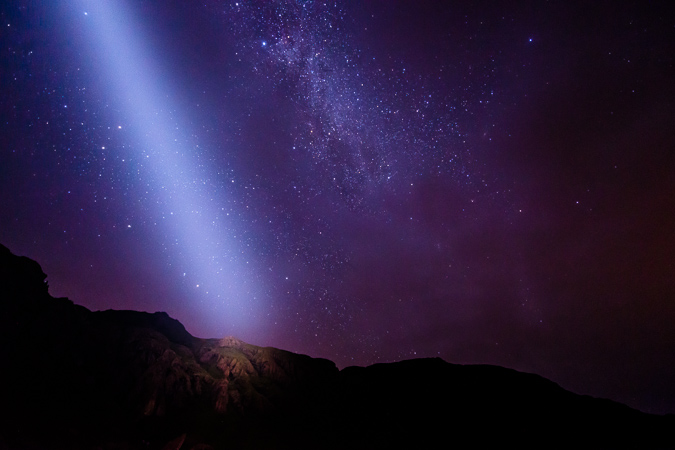
After a failed attempt of photographing the night sky, we decided to hit the sack and see what the next day would bring. We awoke pretty early and the sky was already filling with dark clouds. Sure enough, the sound of thunder came early, around 9 AM and we were more or less stuck to our camp area for the duration of the day. Not that we were complaining though, Ice Lake Basin is a pretty great place to be "stuck" for the day. We had pockets of sunshine and decent weather, so we kept going out around the basin for short photography hikes and then back to camp when weather became nasty. This yielded both Ryan and I many opportunities to capture some great images, especially of the ubiquitous waterfalls that were in the lower basin. It was one of the most awesome places I had ever camped, and I am eager to return, no question.
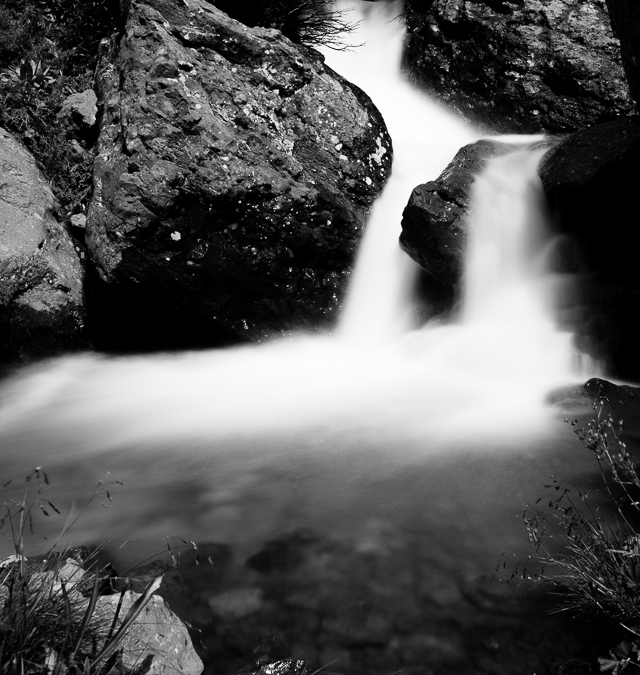
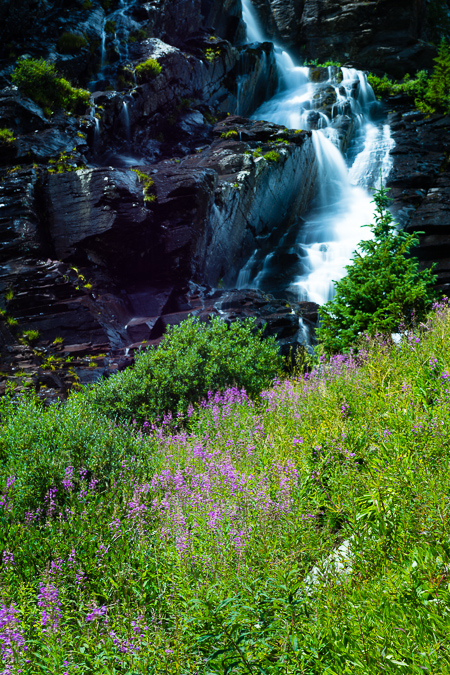 As I mentioned before, our campsite was nestled against the headwall of the upper basin and was directly below a huge series of waterfalls that terminated in a huge field of wildflowers. It was really quite the scene and kept our minds off of the occasional thunder we would hear above. I took advantage of my 9-stop ND filter for taking photos of the waterfall and enjoyed the challenge of the changing light. There were endless opportunities to take photos of the waterfalls and I think I could have probably spent an entire day looking for a better composition or angle. I know Ryan came away with some real stunners too.
As I mentioned before, our campsite was nestled against the headwall of the upper basin and was directly below a huge series of waterfalls that terminated in a huge field of wildflowers. It was really quite the scene and kept our minds off of the occasional thunder we would hear above. I took advantage of my 9-stop ND filter for taking photos of the waterfall and enjoyed the challenge of the changing light. There were endless opportunities to take photos of the waterfalls and I think I could have probably spent an entire day looking for a better composition or angle. I know Ryan came away with some real stunners too.
Ryan ventured off across the basin to photograph his own waterfalls while I tended to the huge one behind our campsite.
I tried a variety of spots near our campsite and ventured quite closely to the incredible series of waterfalls that came from the upper basin just above us to the west. I don't generally processing in black and white a lot, so I decided to shoot for black and white instead of color for the waterfalls, focusing more on the available light vs. the colors in the area. It proved to be a great way to study the subject and yielded some fairly good results I think. I loved the textures and lines that intertwined between both the rocks and the moving water and really loved how the ND filter treated the scene with a silky smooth aura.
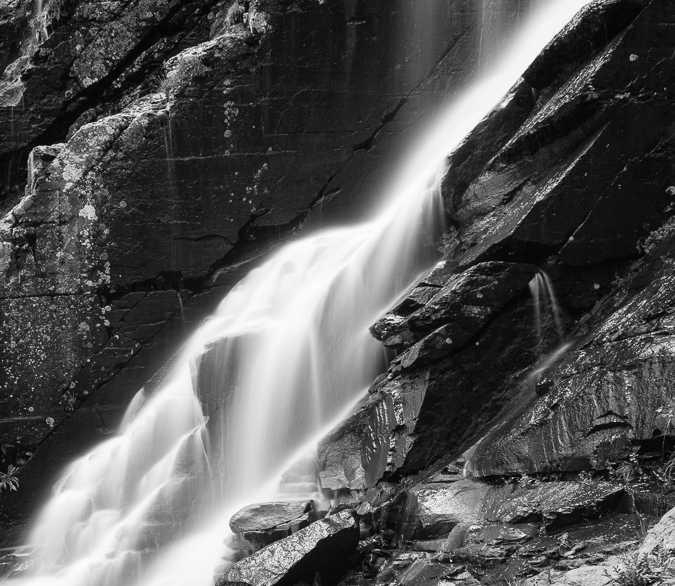
Black and White waterfalls taken with a 9-stop ND filter - a study in light and texture.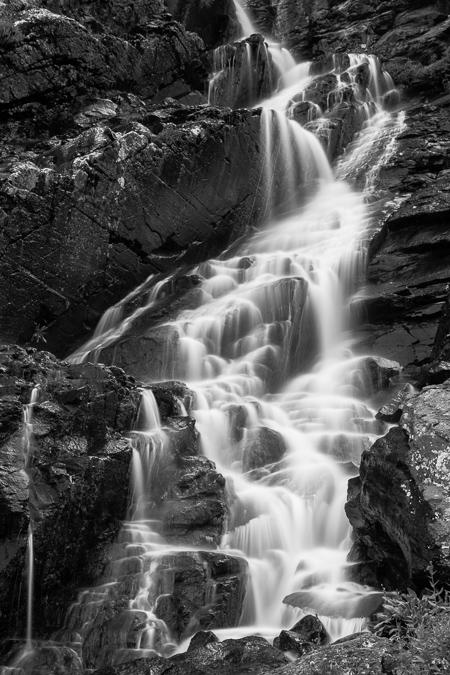
Ryan and I had a lot of time to kill due to the less-than-stellar weather in the basin, so we took turns taking shots of each other. Here's Ryan sporting his Sony and Minolta equipment and myself rocking the Nikon gear on the new tripod.
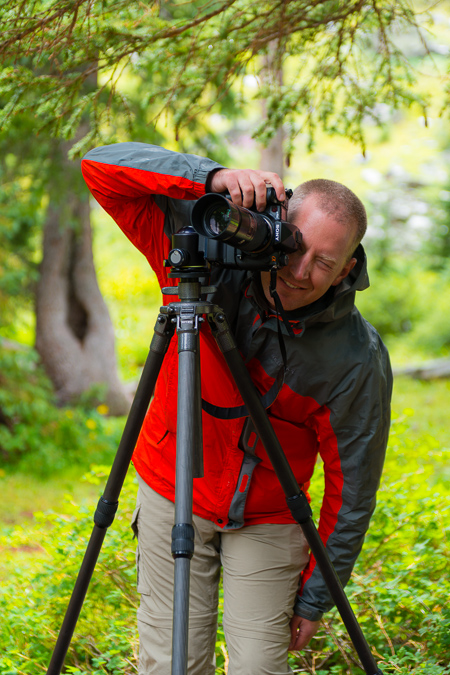 |
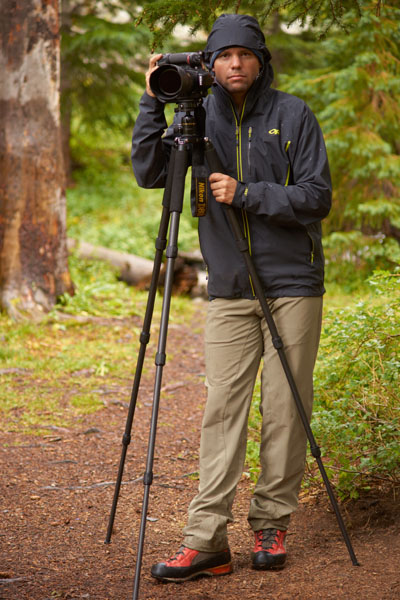 |
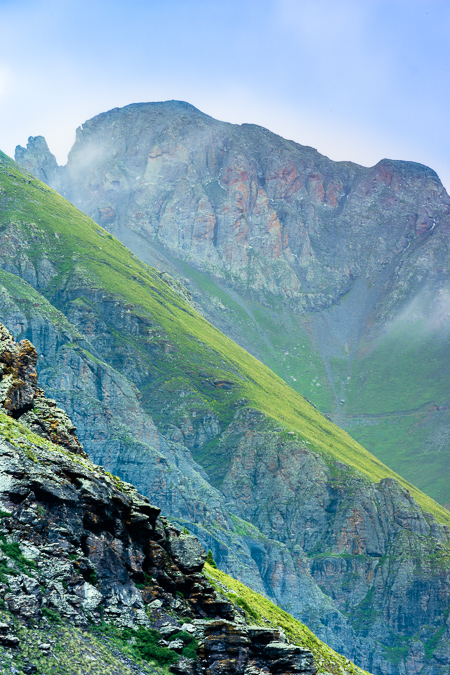
The "on again-off again" weather was both annoying and awesome. On one hand, it kept us close to camp, but on the other hand, it kept bringing in some interesting light and photography subjects to keep us busy. The heavy moisture in the air had created a lot of cool fog-like features in the valley below. Water vapor would rise up from the valley and up into the mountains across the valley from us. As we watched the weather continually change, the temperature kept fluctuating as well, keeping us on our toes and in and out of various layers. It also gave us some opportunity to widdle down on the over-abundance of food we both brought into the valley with us.
Even though the peak of wildflower season had passed, I was quite impressed with the quanitity and quality of wildflowers in the lower basin. I spotted all kinds of amazing flowers, including the Indian Paintbrush, Rocky Mountain Columbine, Mountain Bluebells, Parry's Primrose, Rose Crown, and more. I felt pretty happy to have brought the 105mm macro lens as I'd always wanted to get a nice macro shot of an Indian Paintbrush, so I ventured off to find the best one near our campsite. I found a few good subjects close-by and captured a few decent shots of one.
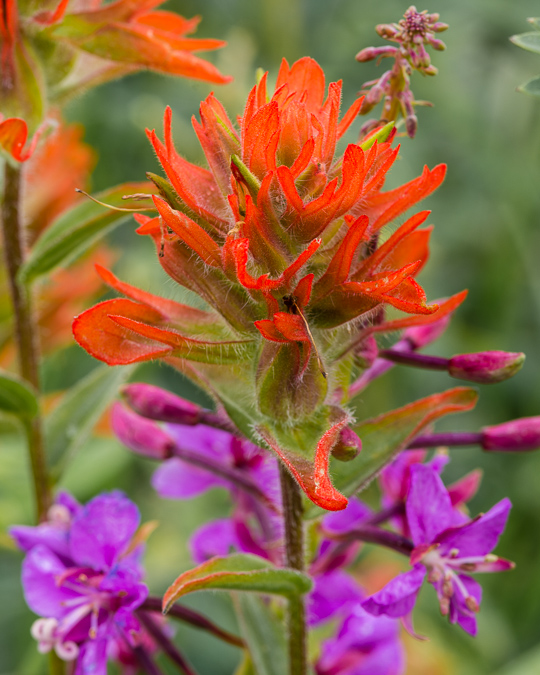
As the light shifted and the day progressed, I kept my eyes on a huge field of purple wildflowers up the hill from us. The sun shifted perfectly and I ran up to get some photos there. I was even lucky enough to get a rainbow in the photo, which was a huge bonus, no doubt. The field also looked out into the distance at one of the more impressive peaks of the area - Sultan Mountain.
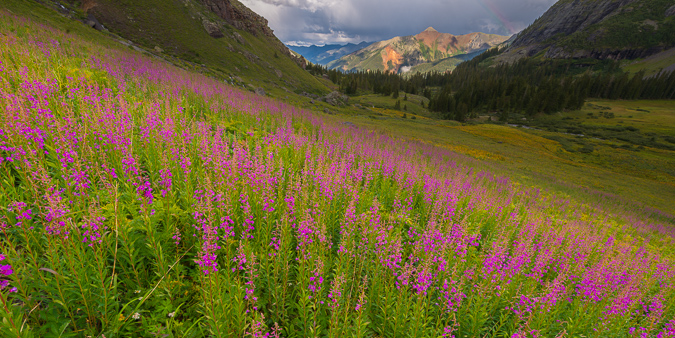
As the storms passed over, I grabbed a self-photo from the wildflower field. What a peaceful place.
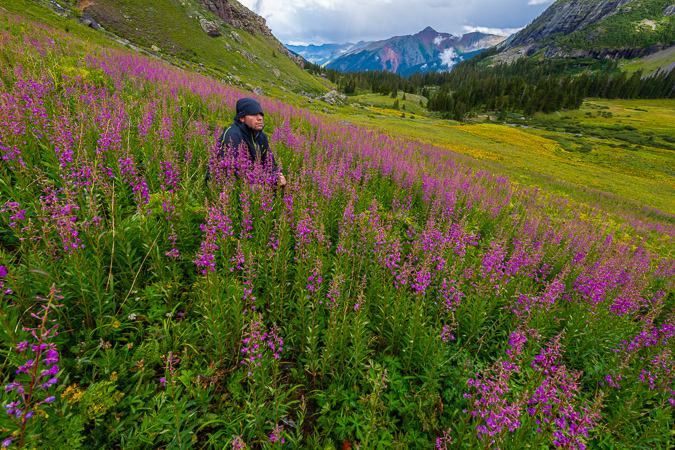
At this point, Ryan joined up with me from the area he was photographing from near the huge string of skinnier waterfalls across the basin from our campsite. He told me I could probably get some awesome shots over there with my ND filter, so I headed that direction, but not before he fired off a hero shot of me carrying my gear.
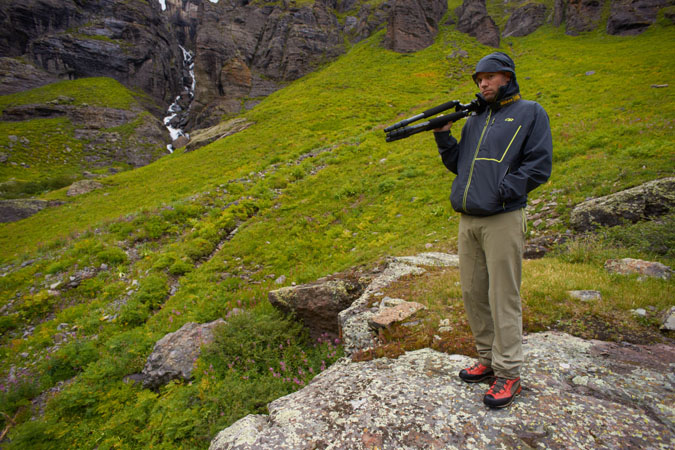
I headed on over to the fast-moving waterfall system up the hill from us and found some amazing scenery there - wildflowers galore with a raging waterfall, including more of those purple flowers and some Columbine as well.
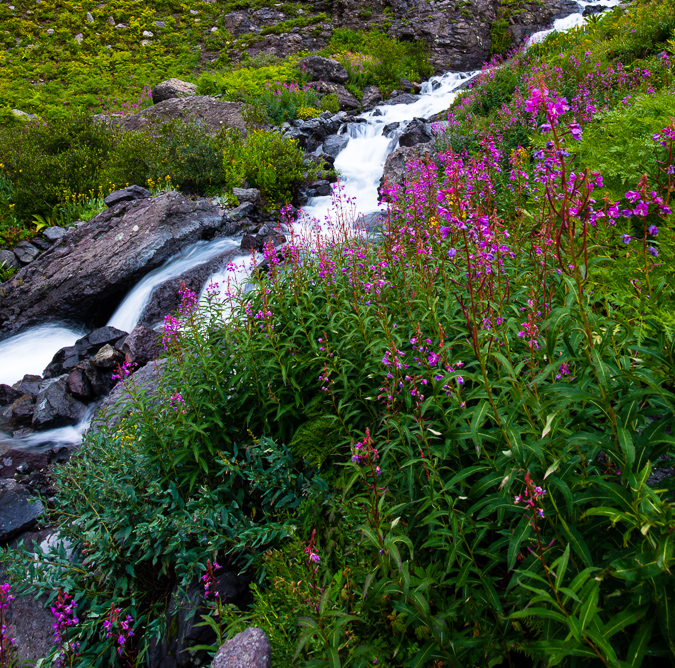
I had to climb onto a really precarious island with cliffs and waterfalls on each side to get this shot of these magnificent Columbine.
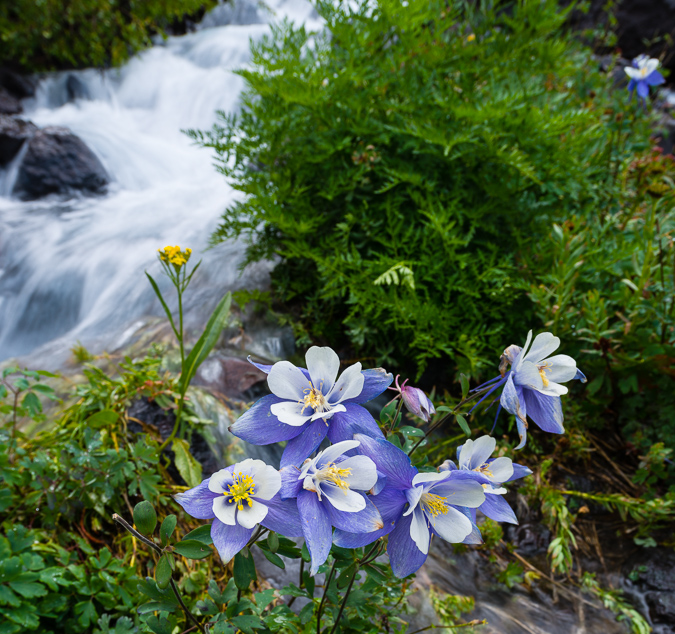
I headed on back down towards camp and noticed the light continue to improve through sunset. I decided this would be the perfect opportunity to finally get to use my Fotodiox Wonderpana Filter system for the Nikon 14-24. As you may or may not know, the Nikon 14-24 is probably the best full-frame wide angle lens you can get, but it has one major flaw - it is unable to take filters since the lens hood is built into the lens. To compensate for this, you have to get elaborate and complicated filter systems if you want to use filters on this amazing lens. Filters are pretty important for certain applications like the highly dynamic light at sunrise or sunset, where the sky is very bright but the foreground is dark. To adjust for this, you use what are called graduated neutral density filters which basically are dark on top and clear at the bottom, allowing you to expose for the foreground and still get a perfect exposure on the brighter sky. This worked out pefectly for this sunset shot I took from the stream.
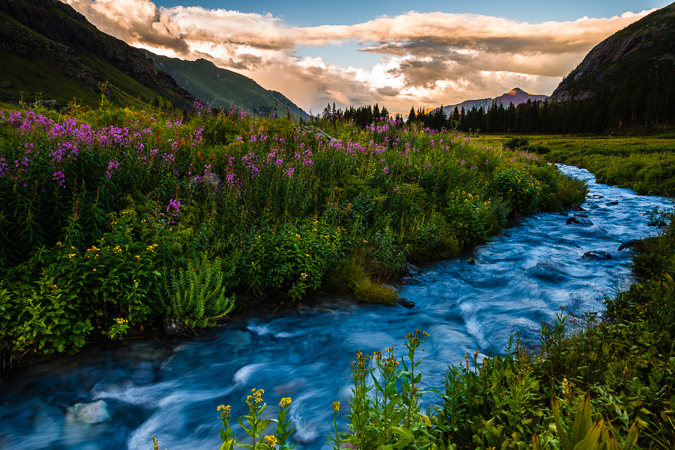
After getting some dinner and packing some of our things away, we kept a close eye on the clouds above, knowing that this second night would be the peak of the meteor shower. The clouds began to clear out, so we decided to head up into the upper basin and find a good spot to get shots of the Perseids. The hike up to Ice Lake from our campsite was pretty easy and finding the lake was no problem at all, even in the dark. As we set-up for our photos, we began to get nervous as the clouds began to return and we could see lightning in the distance to our north and west. Not good! Either way, I wanted a few shots from this area at night, so I set-up my tripod and got a few photos. The moon had not quite set yet but was behind some clouds, which made for a wicked silhouette of Golden Horn.
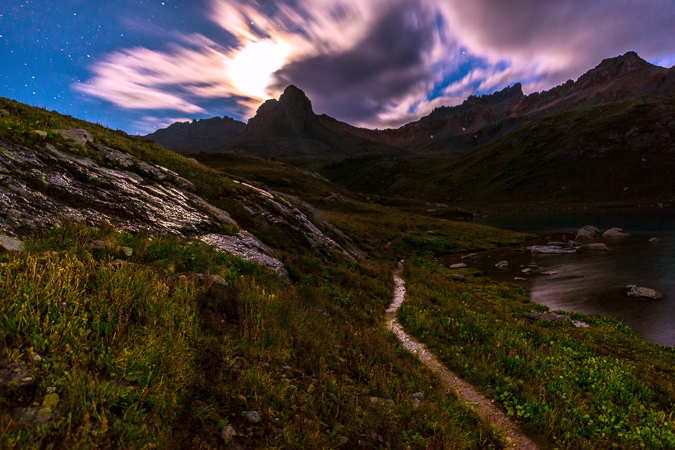
Additionally, the Milky Way made a brief appearance as well with the moon lighting up the passing clouds above.
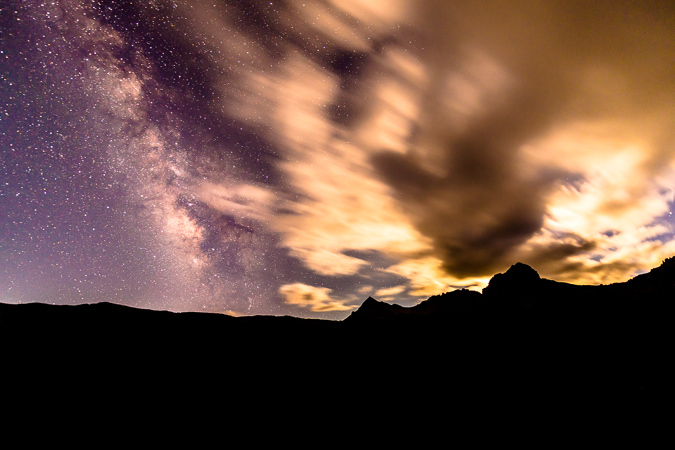
Having seen some lightning and not really knowing how our luck would last, we decided to make the safe decision and head back down towards our campsite, which was very frustrating. I was hoping to setup at the shores of the lake for my meteor shower photos, so I was a bit disappointed; however, about halfway back down from the upper basin we noticed that the clouds had decided to dissipate, so we found a safe and acceptable spot with a nice clear view to the north and east where the Perseid Meteor Shower was radiating from. We setup our tripods and started the fun of doing a long series over several hours to capture as many meteors as possible. The moon was still high enough to light up the foreground too, so it made for a fairly decent spot to get the meteors from. I was quite pleased with my results, netting 19 meteors in total.
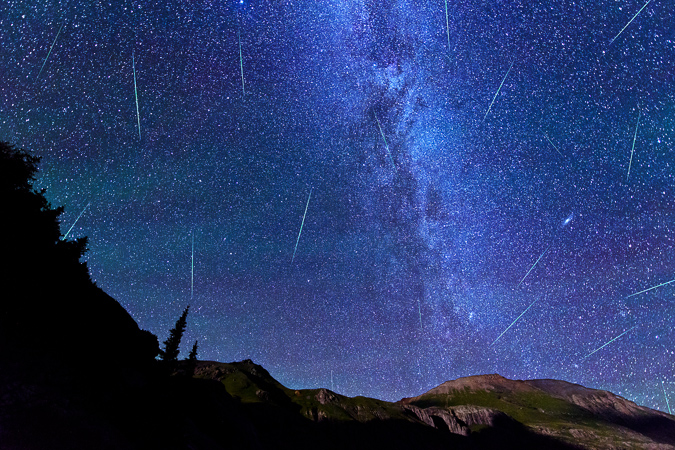
After freezing our butts off for a couple hours, we began to pack up our things, but not before I attempted a vertical panorama from horizon to horizon of the Milky Way. Before I was able to get this shot, I noticed that my lens was covered in condensation, which was a real bummer. I wondered how long it had been this way. I went into my camera to see and only a few shots were ruined. The temperature change from having the camera in my chest pack during the hike up and the very cold night must have caused the condensation - lesson learned!
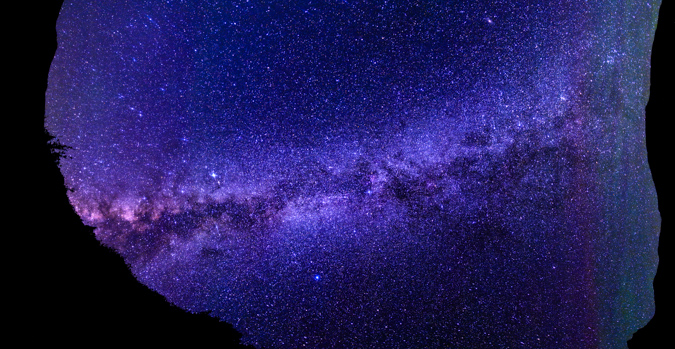
We head back down to our campsite without incident (other than some super cold toes) and went to sleep, prepared to attempt Vermillion Peak in the morning.
We got up a little later in the morning than I'm normally used to for summit attempts, but we were up really late taking photos of the meteor shower. It is always a challenge for me to balance my desires for mountaineering and my desires for photography. While they make quite a synergistic pair, they also sometimes compete with each other, mostly because of the time factor. We made it up to Ice Lake and were blown away at the beauty of this magnificent lake. I've never seen a bluer lake in all of my life.
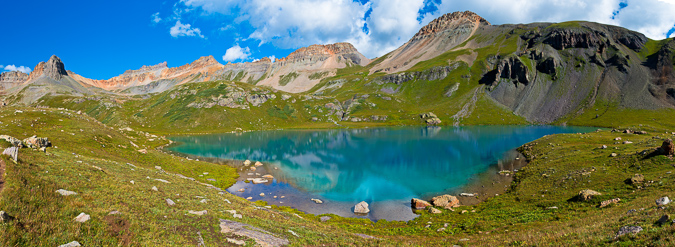
I already knew I wanted to come back to the lake another time of year and get sunrise photos with wildflowers. It was just the most insane spot!
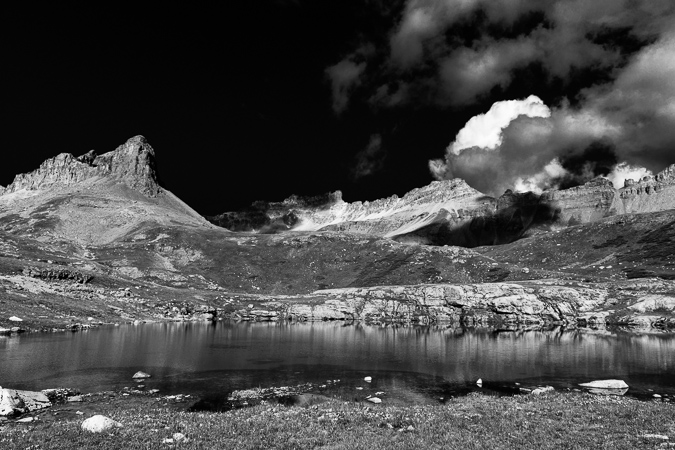
We found another small lake on our way up towards Vermillion and it was surrounded by wildflowers, including this nice Rose Crown as seen in the bottom left corner. Golden Horn made a nice reflection in the lake, and we could finally begin to make out Vermillion behind it.
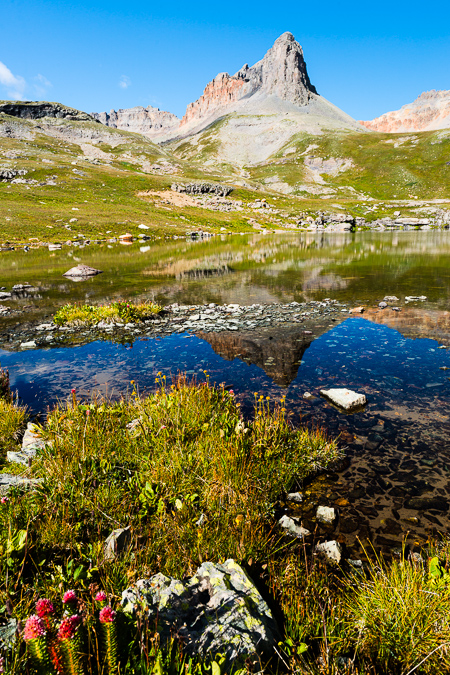
The trail ascended up into the upper basin towards Fuller Lake and the views back down at Ice Lake were intense. I was still blown away by the blue hues in the lake.
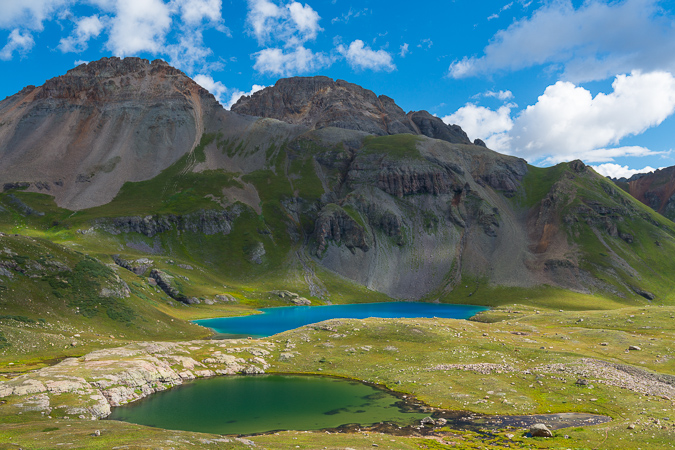
Climbing further up the trail provided some great views of Golden Horn, which demanded a great deal of respect. The naming of Golden Horn was quite apt, as the sides of it were quite golden indeed.
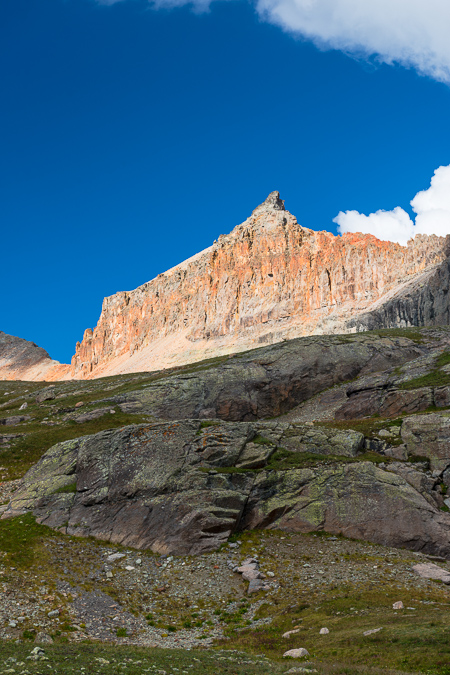 |
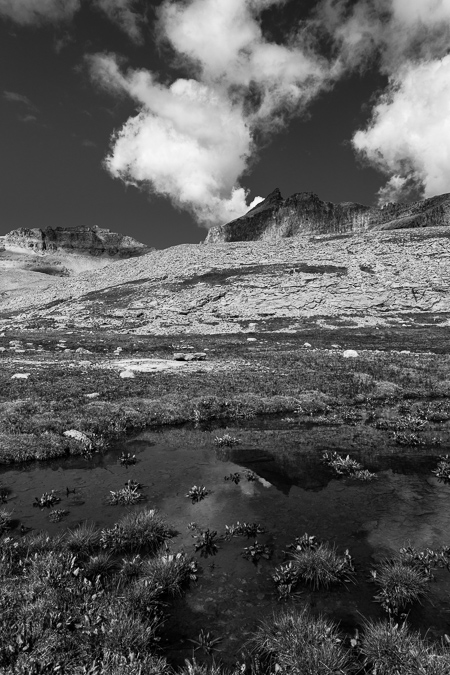 |
As we got further up the basin, we found yet another pond with Fuller Peak (left) and Vermillion (right) towering above. In addition, there was a really interesting building up there, or at least the remains of one. We speculated as to what the purpose of the building was, settling on the thought that it was probably used up into the middle of the last century for miners.
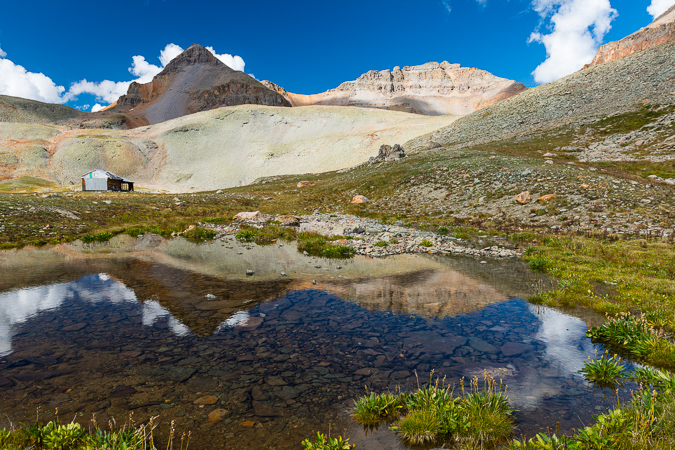
The building was in pretty good condition, with an intact roof and even some old bed springs still inside.
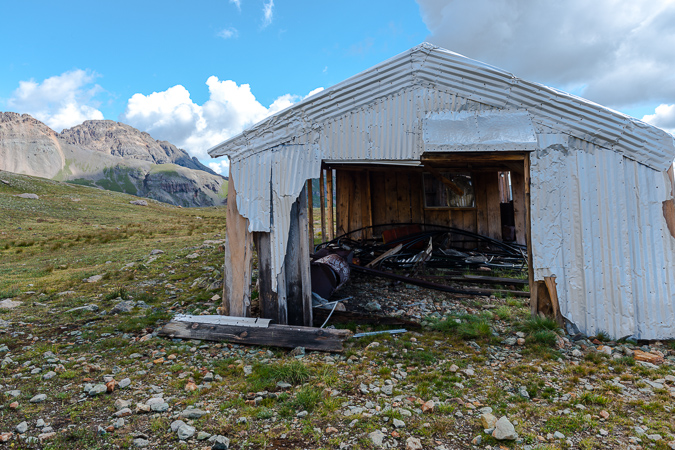
A look back over at Golden Horn revealed that weather seemed to be moving in, but it still seemed pretty spotty. We noted the weather and kept moving up the basin, weaving up a short boulder field above the structure to find a nicely worn trail with numerous cairns.
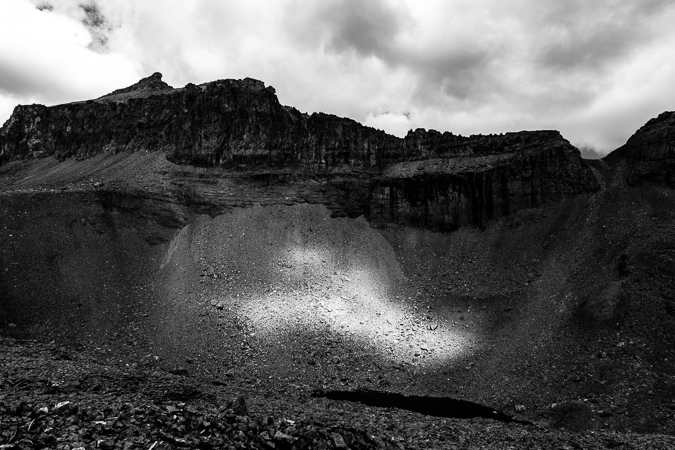
We could make out the nicely worn trail heading up to the saddle between Fuller and Vermillion, and kept heading in that direction.
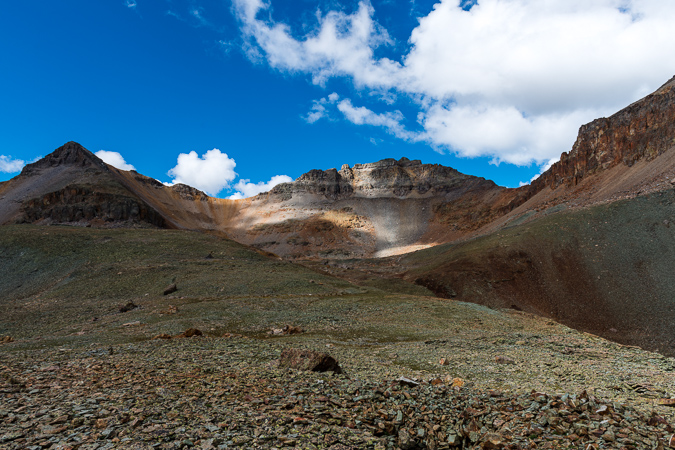
The trail brought us up a nice rocky bench towards Vermillion and was a very pleasant hike up. The clouds continued to hold, so we kept on trucking. A look back at Ryan showed I was keeping a pretty good pace. Ryan indicated to me to keep going at my own speed, so I did.
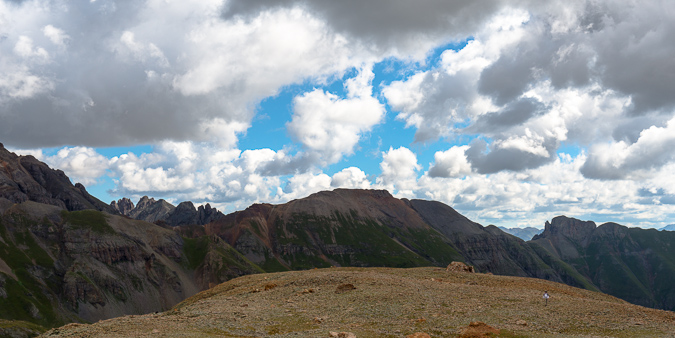
We reached a small stone fortress near the end of the trail and stopped to put on some rain gear as light graupel had begun to come down. The weather still seemed OK but I must admit I was getting a bit nervous. We continued up and lost the trail at the base of Fuller, so we began to weave across a large loose boulder field, which proved to be a huge pain in the butt to cross.
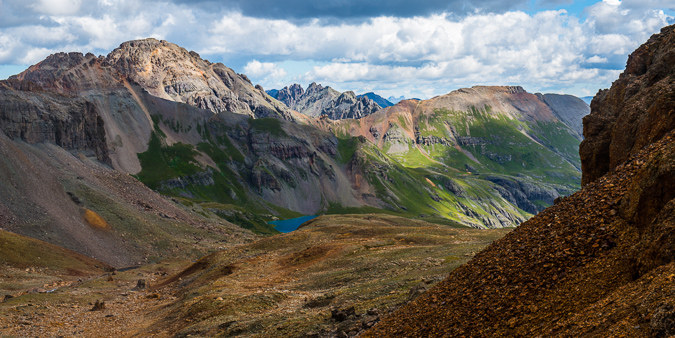
Once we were able to get through the loose and physically rigorous boulder/scree fest, we found ourselves looking down and across at the proper trail. Oh well! We made our way across the boulders to the trail without any issues.
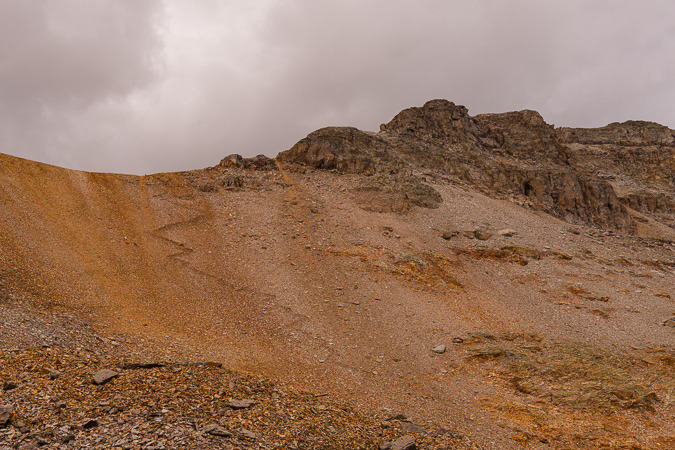
I was able to quickly make it up the saddle - my legs were feeling really great despite the lack of recent climbing I had done this year. From the saddle, I could easily make out a lot of mountains in the area, including the famous Wilsons, the distant Grenadiers and a really awesome looking peak to the south west that was covered in small bits of snow from the recent storms.
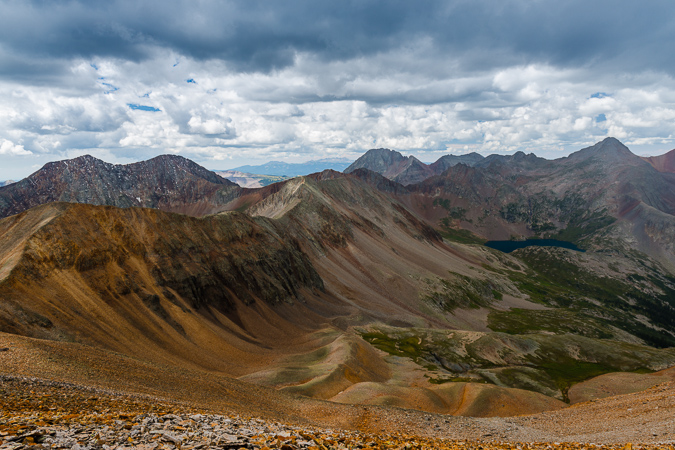
A look over at Fuller proved it was not a very long distance from the saddle, and I made tentative plans to come back and grab that peak if time and weather permitted after Vermillion. Looking back down at Ice Lake revealed Ryan's position about a quarter of the way up the trail to the saddle and all of the lakes we had passed throughout the day's journey. What an amazing view it was.
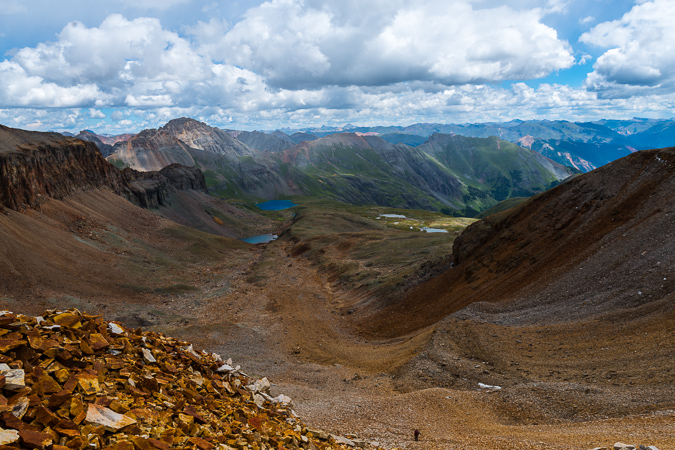
In the distance to the east I could now make out Uncompahgre and Wetterhorn, which is always a nice treat!
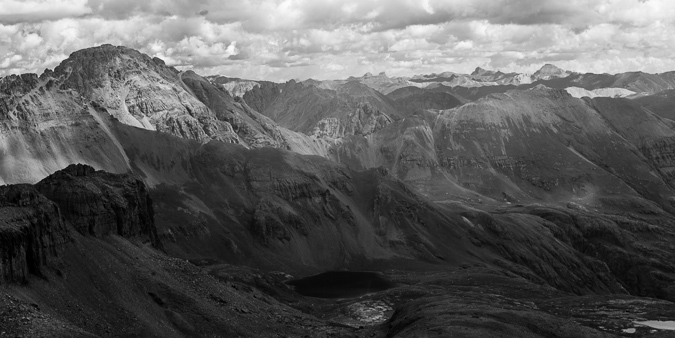
From the saddle, the trail leads up the back side of Vermillion. The trail is very well-worn and easy to follow. The rock on the back side was also very interesting.
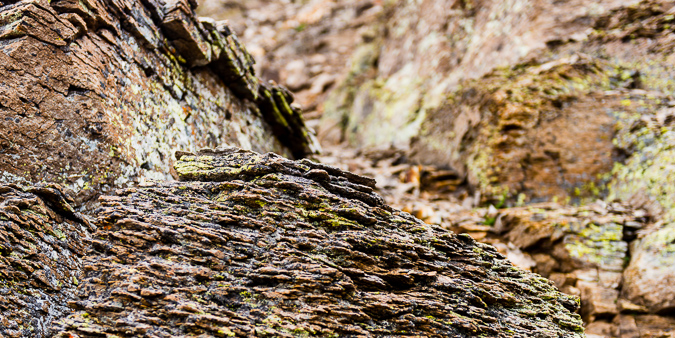
A look back down towards the saddle showed just how worn and accessible the trail really was. It was also awesome seeing the Grenadiers in the distance above the ridge.
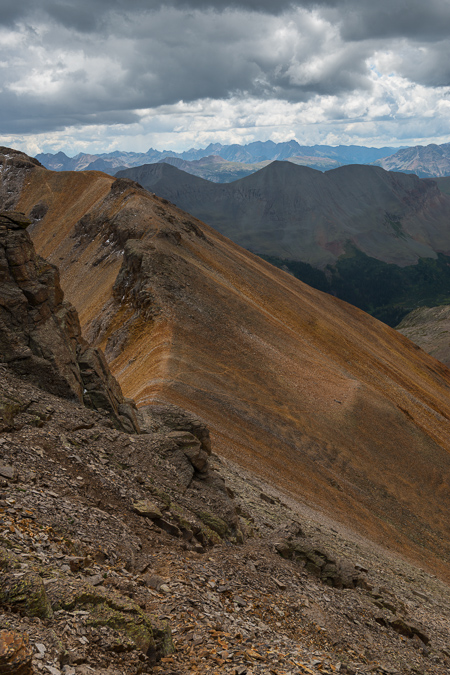
I reached an obvious end to the trail which had wrapped around the back side of Vermillion on a series of ledges and realized that it was time to head up a steep gully and onto the upper section to the summit, which was all fairly obvious to me at this point.
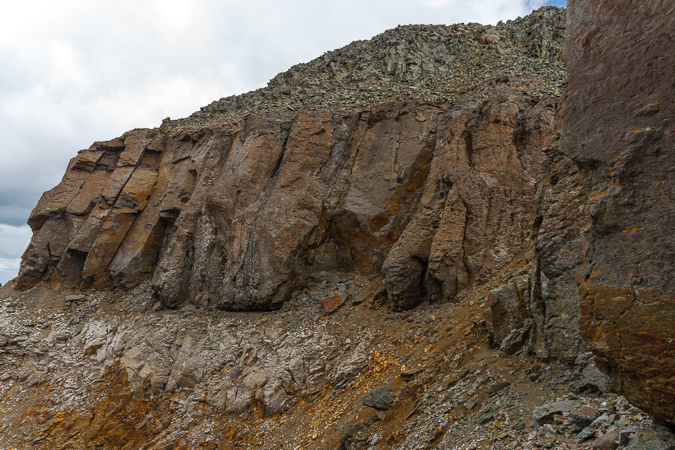
Once I reached the top of the golden gully, I looked back and down towards the awesome snow-covered mountain, which I later realized was one of the many mountains in Colorado named Grizzly.
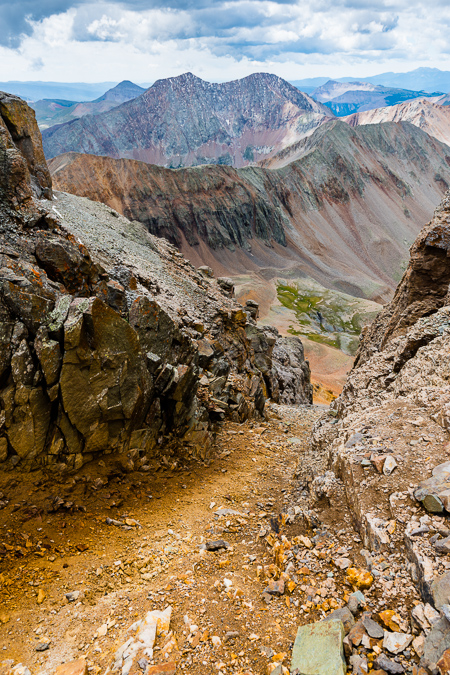
You could also make out Engineer Mountain beyond Grizzly to the south. I was able to reach the summit without any issues and was amazed at all of the green rocks on the summit. I guess it is pretty obvious why the mountain was named Vermillon.

I posed for a few self-portraits using my tripod while I watched the weather nervously. The view of Golden Horn, Pilot Knob (just to my right), Sneffels (in the distance) and other notable San Juan giants was pretty killer from Vermillion.
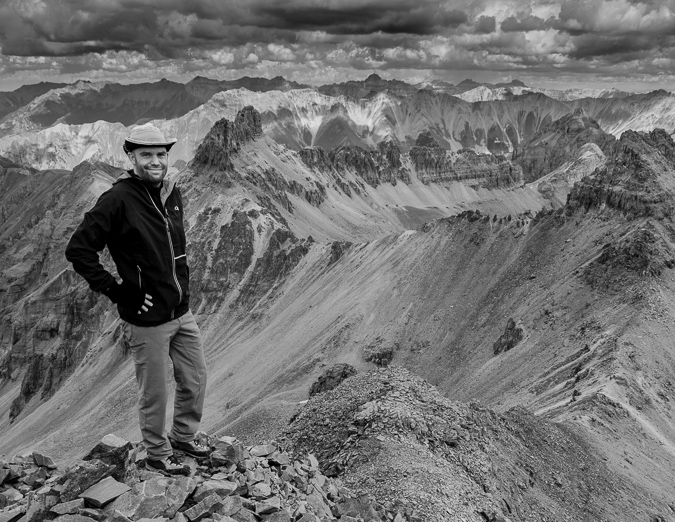
I snapped off one more set of panoramas.
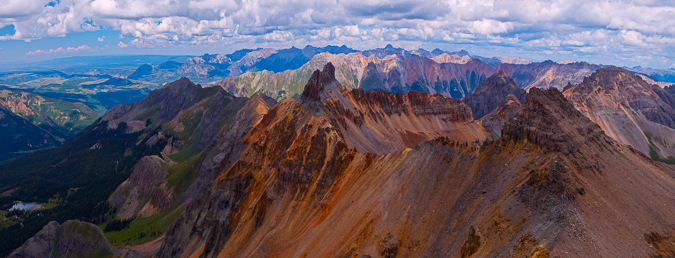
A look to the west caught my attention. Out of nowhere a giant storm had developed, with what appeared to be significant precipitation. I hastily packed my things and head back down towards the saddle. I ran into Ryan about halfway back to the saddle, where he had decided to give-up due to fatigue. The storm passed us to the south, fortunately, as seen below.
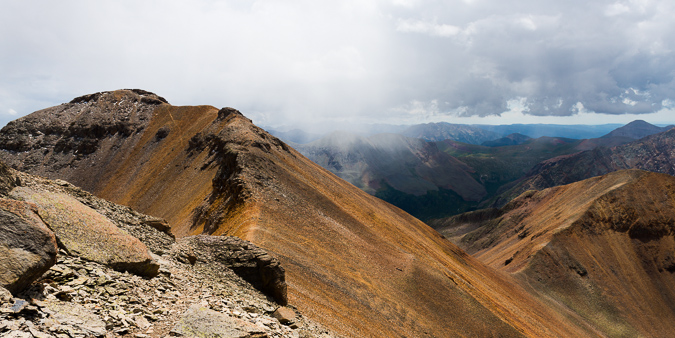
I reached the saddle fairly quickly and told Ryan I was going to head up and get Fuller really quickly. I made short order of Fully, ascending in just 10 minutes. From there, I was able to survey the basin again, with some interesting views back down towards Ice Lake and back at Vermillion.
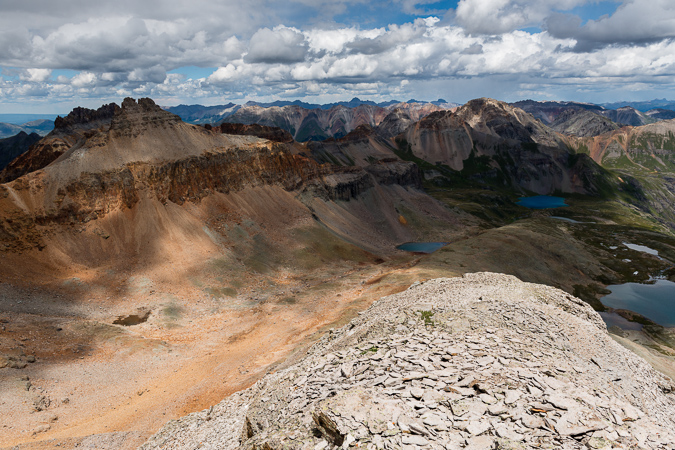
On my way back down to the saddle, I was momentarily pleased with the bright colors and contrast between the red rocks on Fuller and the green vegetation below at Lake Hope, which rested at the foot of San Miguel Peak to the west.
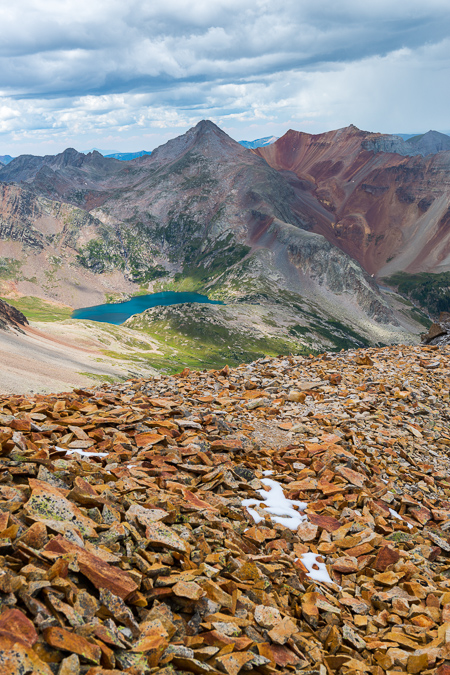
I rejoined Ryan at the saddle and we made it back over below the rock shelter that sat beneath Fuller in no time at all.
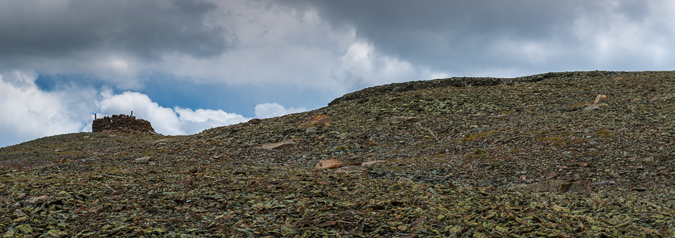
A look back at Vermillion showed Ryan and the scope of the peak we had just came down from.
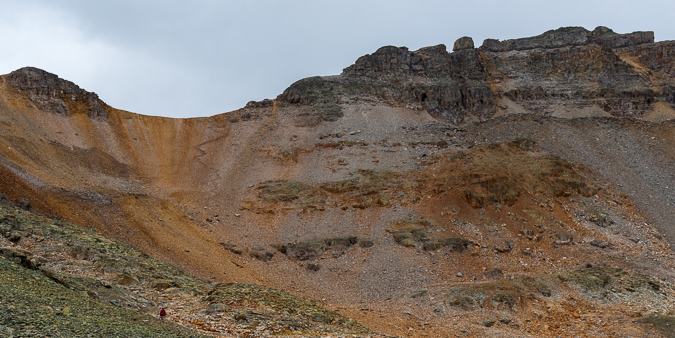
Ryan and I were amazed at just how much old mining equipment was just left up there. We saw lots of large tubing strewn about the mountain and even this handy wheelbarrow that looked to be quite old.
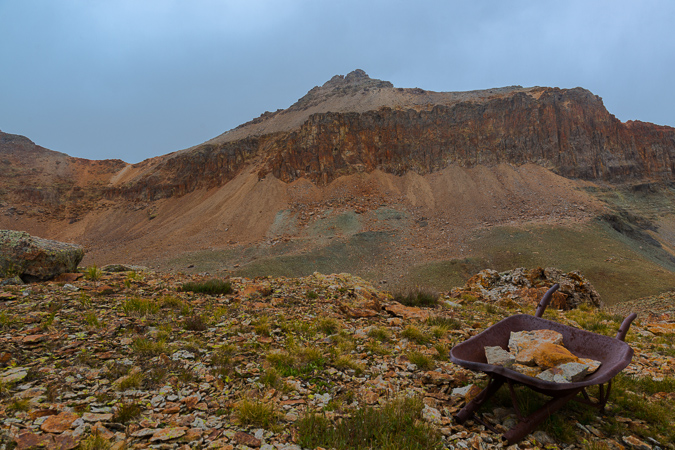
Coming down the basin was not a problem and the weather cooperated to our surprise and glee. Ryan and I took frequent stops to take photos of the area.
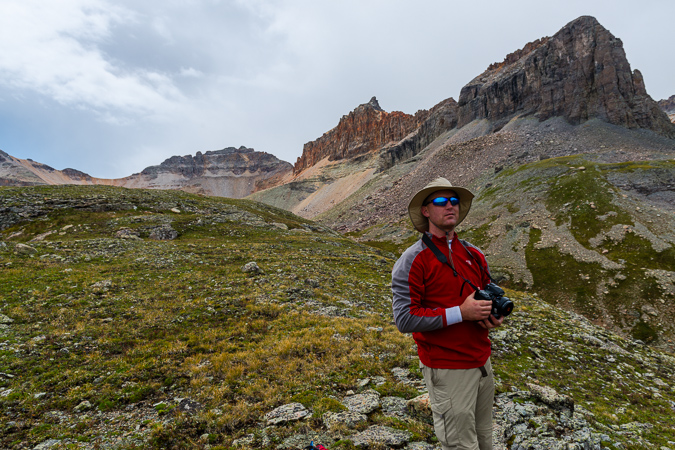
On the way down I found a very small pond with a large boulder in it that made for a nice landscape scene with Vermillion and Golden Horn reflected in the pool.
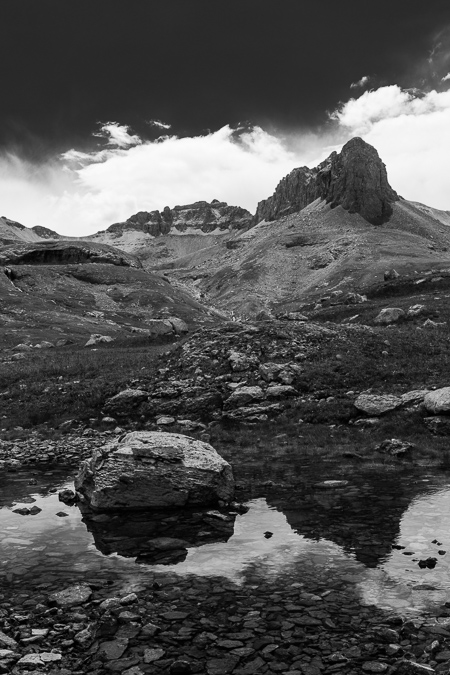
Once back down at Ice Lake itself, we stopped for some quick photos. I found some Rose Crowns and did a little focus stacking to get both the flowers and the distant peaks in focus.
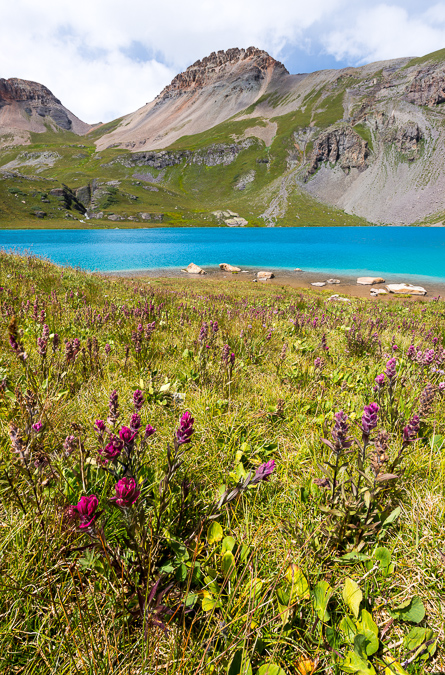
You can really see how this basin would be incredible when the flowers are at their peak. I also found some interesting rocks on the shore to photograph from, and Ryan was able to get a photo of me perched on one of the rocks preparing for a shot.
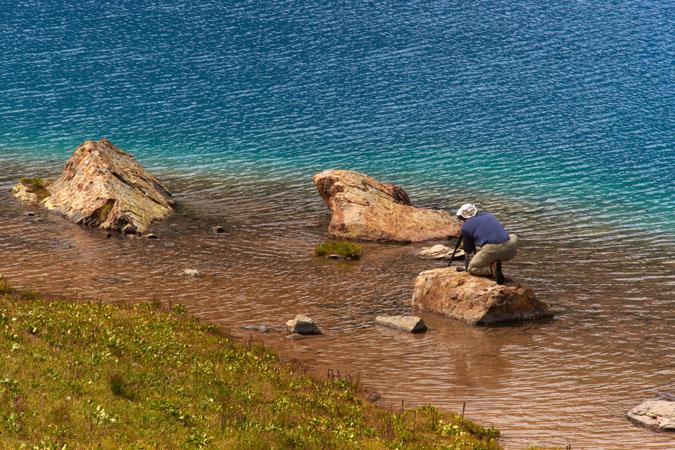
And here's the shot I was composing.
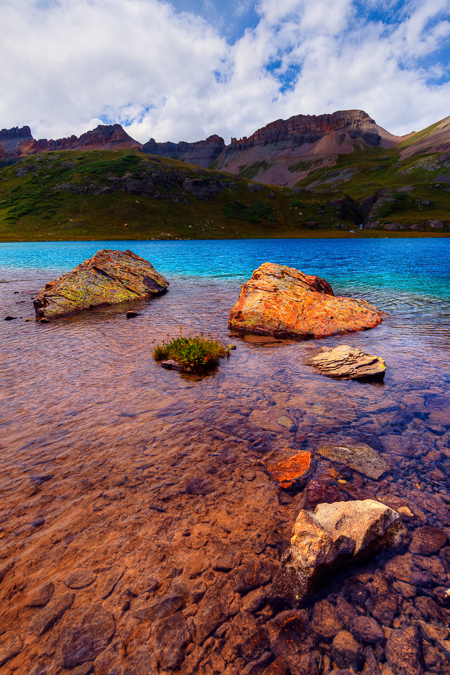
Once we finished up at the lake we head back down the trail towards camp. We found a great vantage point where we could see Sultan Mountain and the lower Ice Lake.
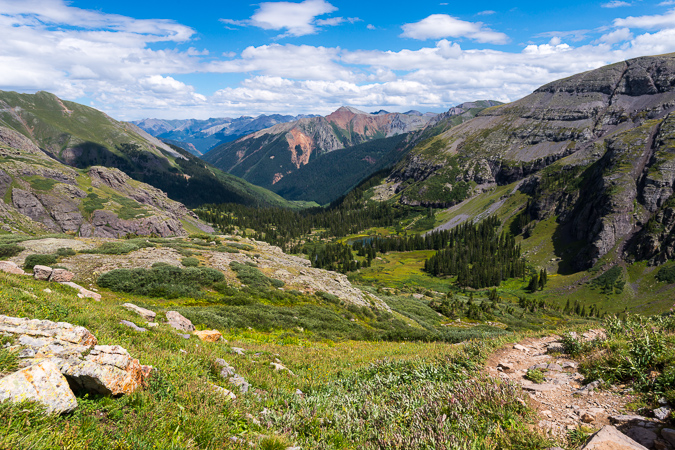
Here is a map of where we were at and what routes we took on the various days.
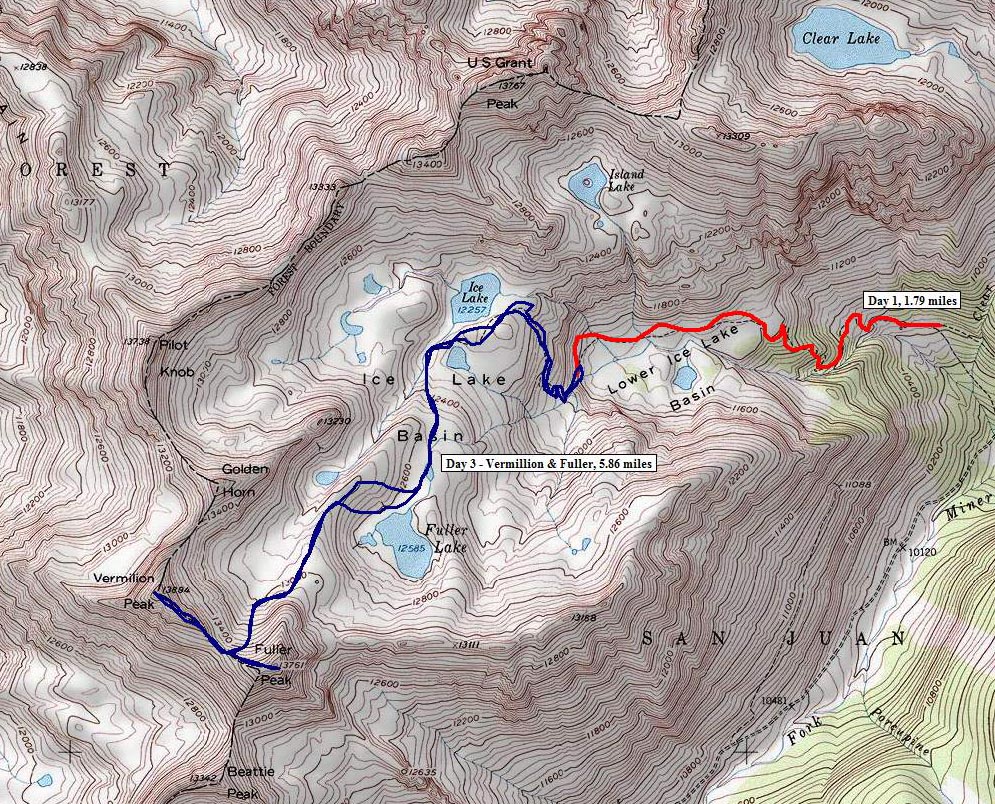
As sunset arrived in the lower basin where we were camped, I could not help but notice the great light. Sure enough, the sunset hit the clouds just right and made for a nice light show.
 Having one more night in the basin was quite the blessing. The night sky was quite clear on this last night and it made for some great star viewing. I decided to put together a few different star trails, this first one taken looking almost straight up at the sky. The stars form small looking meteors using a special processing technique.
Having one more night in the basin was quite the blessing. The night sky was quite clear on this last night and it made for some great star viewing. I decided to put together a few different star trails, this first one taken looking almost straight up at the sky. The stars form small looking meteors using a special processing technique.
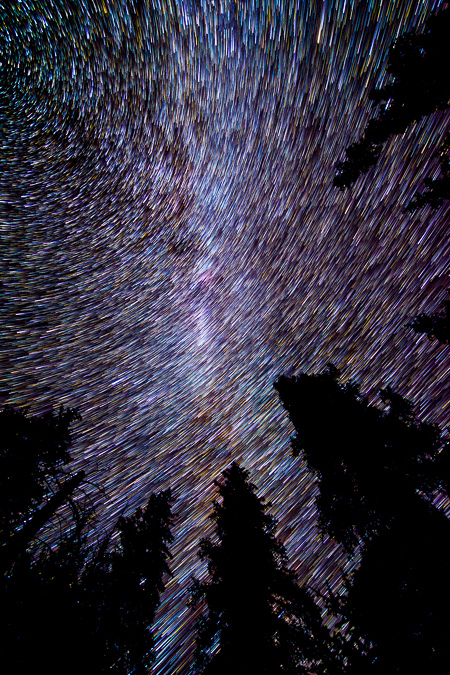
I really enjoy doing star trails with trees in the foreground. I love how the stars weave in and out of the trees.
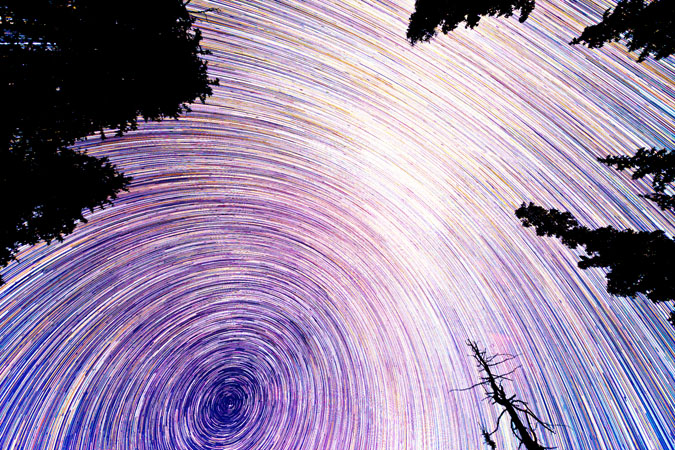
The following morning was pretty calm as we packed up. There were several marmots out and about that we could photograph while we packed and it made for a nice break between tasks.
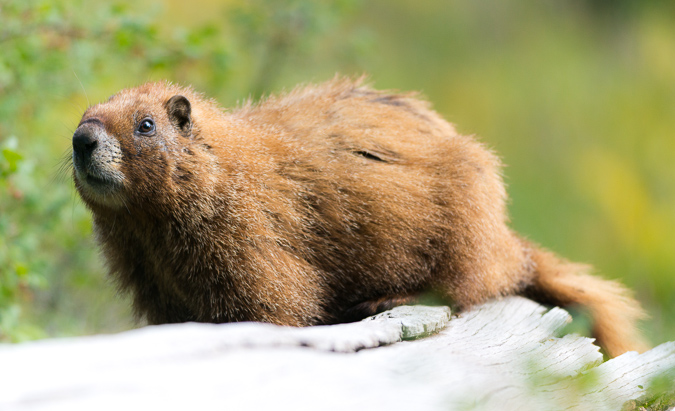
We hiked out and ran into a couple that were camped across from us in the basin. It turned out that the woman knew one of my friends that I reguarly climb with - such a small world. It was nice talking with you Becky!
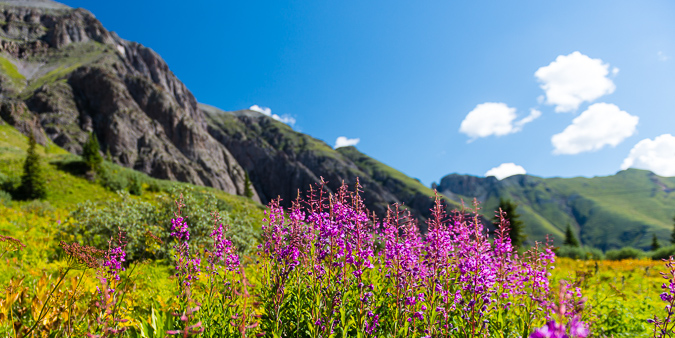
Almost back to the car and we ran into that awesome waterfall again. I had to stop and get a parting shot of it using the 9-stop ND filter.
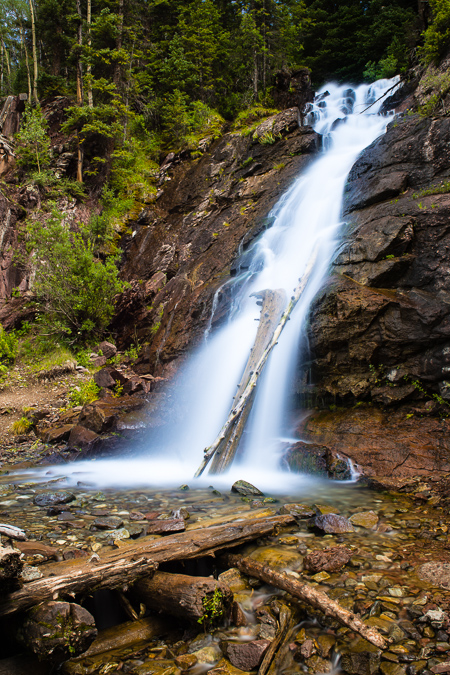
On the drive out we noticed some really cool cliff bands in the basin as well, so we had to stop to get photos of that too. It is amazing where nature will allow trees to grow.
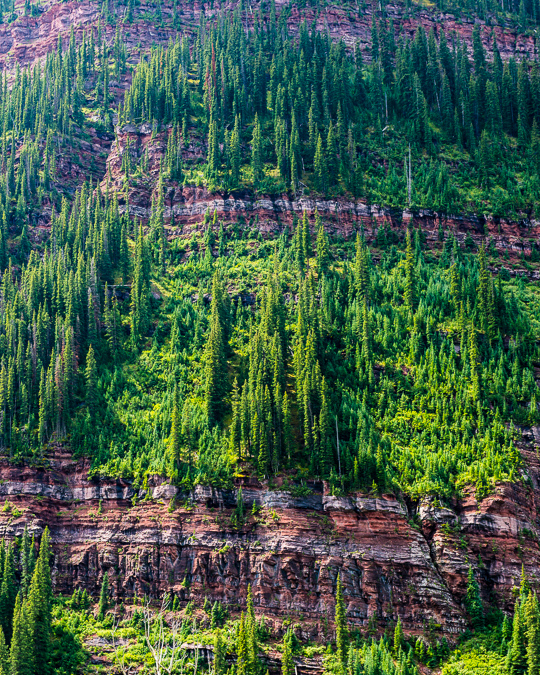
We stopped in Silverton for lunch and found a very nice restaurant called the Teller House. We were served some very tasty vegeterian burritos from their friendly staff, who filled our Odell Cutthroat Porter frequently. On the drive home, we bumped into a massive storm cell that was east of Canon City. It was one of the most impressive storm clouds I'd seen in awhile. We also learned that Manitou Springs had severe flooding while we were gone, due to the Waldo Canyon Burn Scar. What a memorable summer it had become.
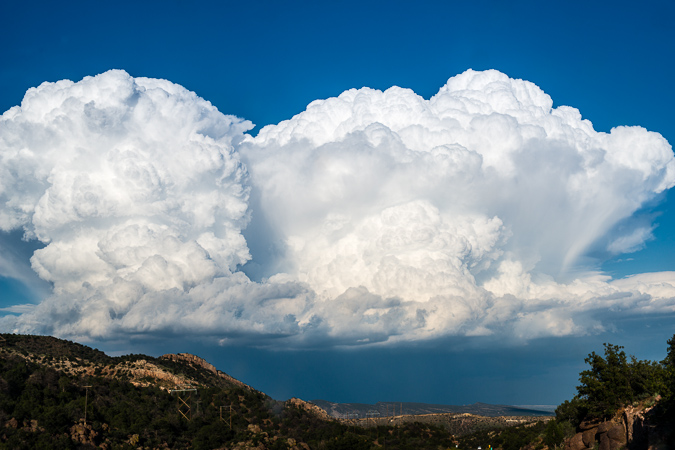
Lastly, I put together a short time-lapse video from the lower Ice Lake Basin. The first two sequences were created in-camera on my Nikon D800 and the Milky Way sequence was built using iMovie and still images. My friend Nicole Buetti allowed me to use her music for my video. Stay tuned for more time-lapse movies featuring Nicole's amazing music later this year! To hear more of her music, go check out her website!
Scaling Colorado's Highest 13er - Grizzly Peak at Sunset
Climbing mountains in solo-mode is therapy for me. While I have often espoused a deep belief that climbing mountains solo is a safety concern, there are times when the benefits outweigh the risks. I'm not sure that this particlar climb qualifies; however, I must admit, this was a truly wonderful experience that I will never regret. I decided somewhat at the last minute to take Friday off of work and climb a 13er. Having only 20 or so Centennials left to complete my quest of the highest 100 in Colorado, I have been getting more motivated to tackle the mountains left.
Grizzly Peak had always intrigued me. It is one of the few Centennials not visible from a paved road (I am fairly confident of this) and has a very remote status. Grizzly Peak is nestled deep in a valley just west of the summit of Independence Pass between Leadville and Aspen and is the most western Centennial in the Sawatch Range. There are tremendous views of the Elk Mountains from Grizzly Peak, including Pyramid Peak, the Maroon Bells, Snowmass Mountain and Capitol Peak. Grizzly Peak also carries with it the distinction of being the highest of 7 mountains in Colorado named Grizzly and the highest ranked 13er at 13,988 ft. (Sunlight Spire is higher, but is not ranked - for more on this issue see this article).
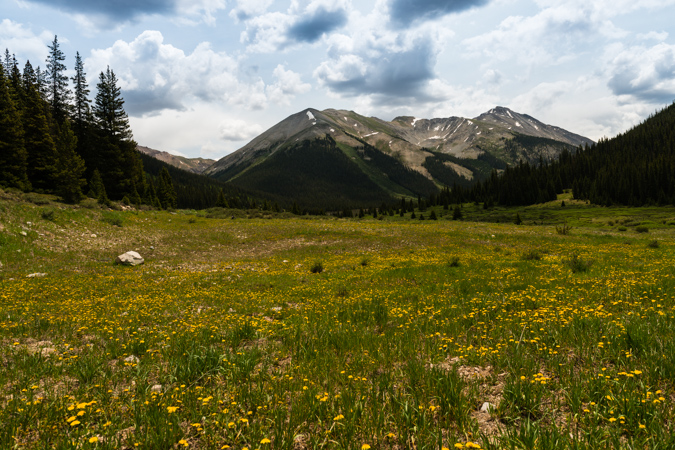
Since I would be climbing by myself, I knew I would have as much time as I needed to take photos and do some crazy photography projects from or near the summit. I chose the west route of Grizzly due to the very short length of the climb, which was very appealing for weather purposes. The plan was to drive the road to the base of the mountain Friday morning, climb the mountain, take photos of sunset from the top, and stay on the top as long as possible for a shot of the Milky Way and to do some star trails photography. According to Roach's 13er guidebook, the road is open all the way to the very base of the mountain, leaving only about 2 miles of hiking to the summit. When I reached Grizzly Reservoir, the road was closed at this point, which meant I had to add another 2 miles both ways to my hike. This was not a huge deal, but it certainly made me re-think my plan.
Being that I had nutty plans to do some extensive photography work from the summit, I packed quite heavily. I was carrying the following photography gear with me:
| Item | Weight (lbs) |
| Gitzo Carbon Fiber Tripod w/ Arca Swiss Ballhead | 6.4 |
| Nikon D800 DSLR w/ Arca Swiss Plate | 2.8 |
| Nikon 14-24 f/2.8 Lens | 2.0 |
| Nikon 24-70 f/2.8 Lens | 2.0 |
| Nikon 50mm f/1.4 D Lens | 0.5 |
| Nikon 300mm f/4 D Lens | 3.0 |
| 1.4x Teleconverter | 0.5 |
| Total | 17.2 |
I'm not especially proud of carrying all of this weight up a steep mountain, but I certainly don't regret doing it.
After I parked my Jeep near the Grizzly Reservoir campground, I head out with a pack full of camera gear and fresh legs at about 1 PM. This is not a very typical start time for me, and probably not highly recommended due to weather concerns, but I figured I would play it safe and keep an eye above for the hike in. For any photographers reading this, I decided to stick with the 24-70 f/2.8 as my walk-about lens, which worked out fairly well. The round-trip stats for this hike are 8 miles w/ 3,500 ft. of elevation gain.
The view from the road was fantastic. Lower, but very rugged 13ers adorned the valley and made for quite a nice sight on the hike in.
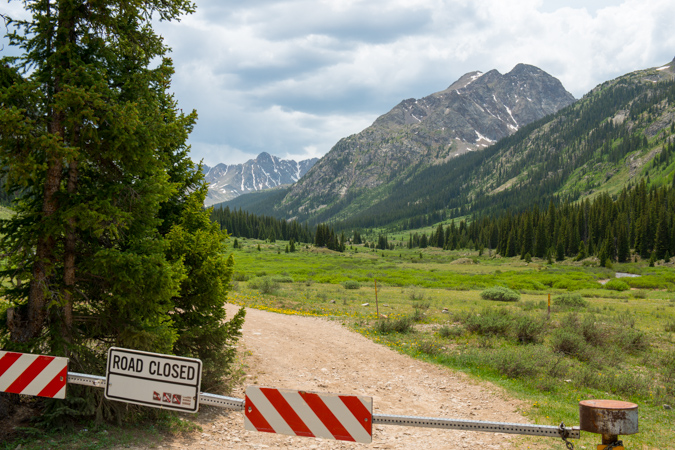
I certainly enjoyed the view but was keeping an eye on developing thunderstorms above.
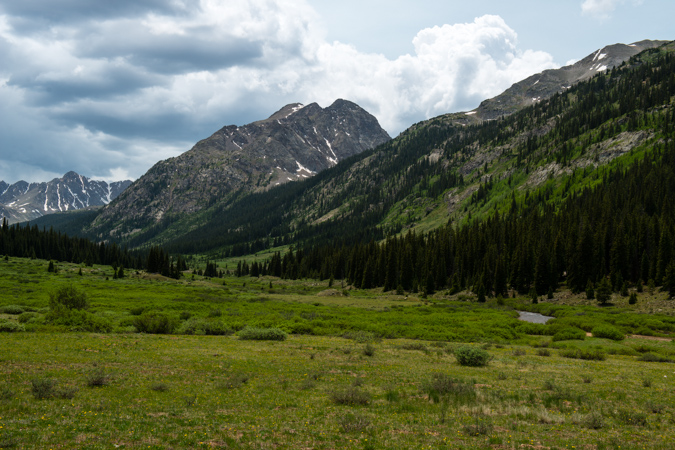
I'm usually not a fan of hiking on a road, but I could not really complain with the view I had, plus I had the Nerdist podcast to keep me entertained.
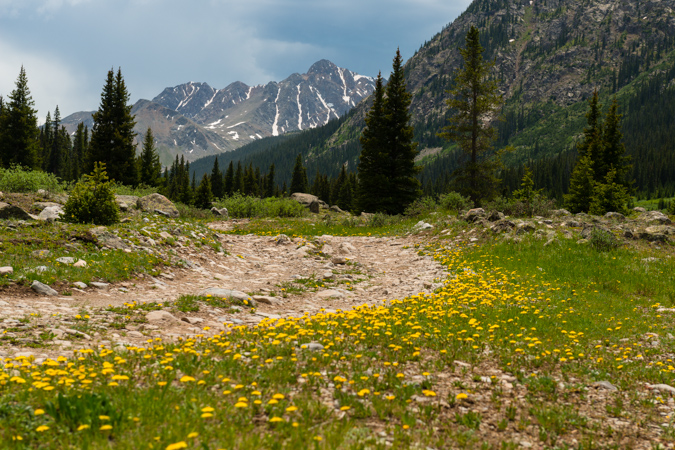
On the hike in, I was able to find some Columbine flowers growing in a small open field, making for a fun photography experiment. One thing I have been wanting to try to do is a technique called focus stacking, which allows a photographer to capture a very sharp photograph that is really the combination of multiple photographs taken at various focal points. I tried that out on these columbine flowers, which worked pretty well considering the wind was blowing (which makes focus stacking almost impossible).
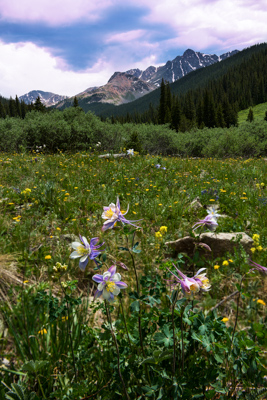
I was looking for a gully cut into the side of the mountain to my left (east), which would be my entrance point for the Grizzly Peak ascent. The mountain has no trail and is basically a steep slog up a very pretty, wild, but generally straight forward gully going up, up, up. Before reaching the gully, the rain started to come down a little, so I stopped to get a photo at this beaver pond before putting my camera away and heading up the gully.
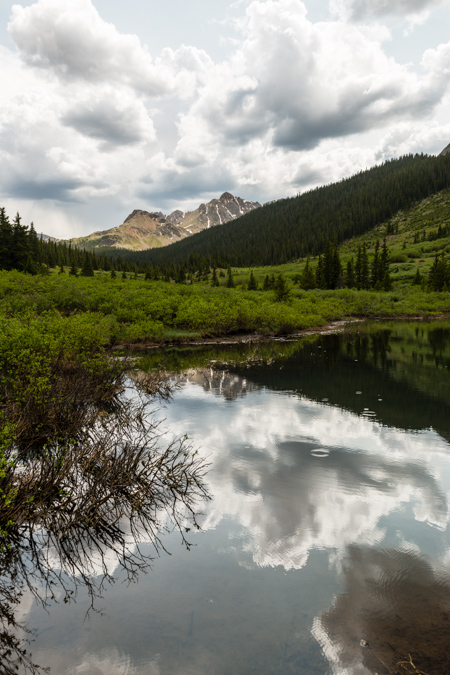
While small rain was coming down, I decided to keep my camera bag packed in my main pack to make it easier and to give me some peace of mind. As such, I was unable to take any photographs with my camera until the rain totally left and I was about a quarter of the way up Grizzly via the gully. I stopped to snap a set of photos to be later stitched into a panorama, looking west across the valley towards Truro and several un-named 13ers.
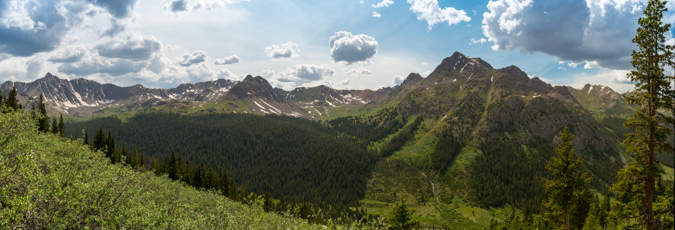
A look up at the terrain revealed just the sloggy mess I was climbing up. It was quite steep and somewhat difficult to navigate through all of the small pine trees, willow trees and rocks. I just had to pick my way up and take frequent rest breaks (I was carrying a lot of weight, haha). The Nerdist podcast of Rick Moranis made the slog a lot less painful, although my laughter probably drove wildlife away.
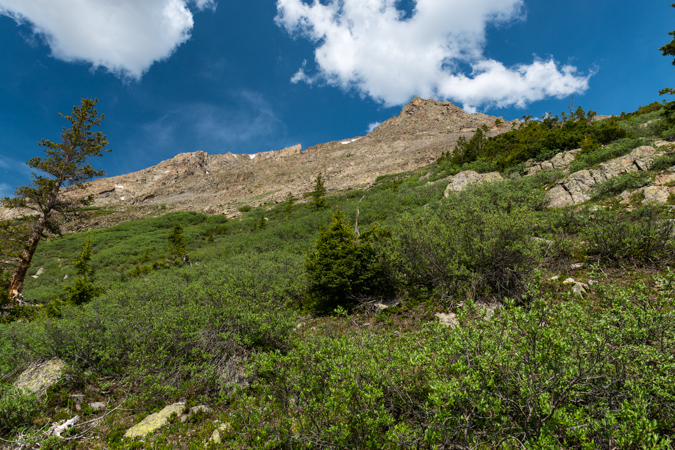
As I continued up Grizzly, the storms seemed to subside, and I was feeling a lot more comfortable about the hike up and eventual stay on the summit. A look back down the gully showed the way up and I could now see the road I hiked up from the North (right).
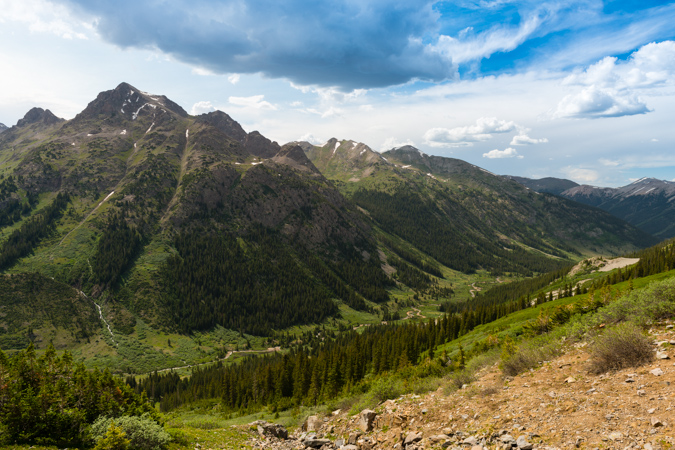
Once above treeline, the gully was pretty obvious in terms of where to go. It was mostly rock and dirt with wildflowers and boulders strewn about.
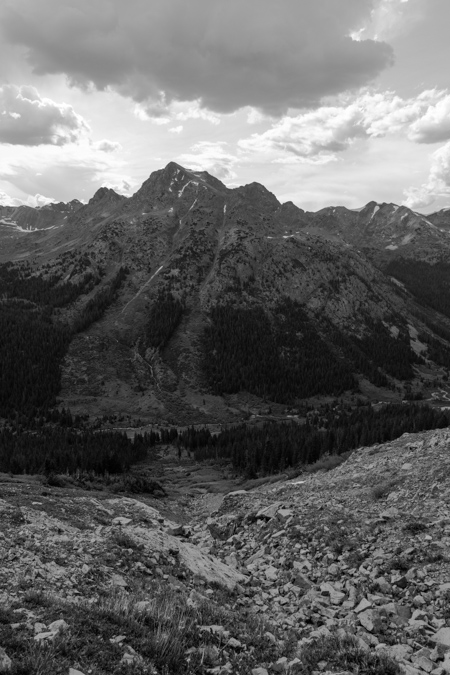
The views were pretty enjoyable in all directions. Despite some wind, I really could not complain.
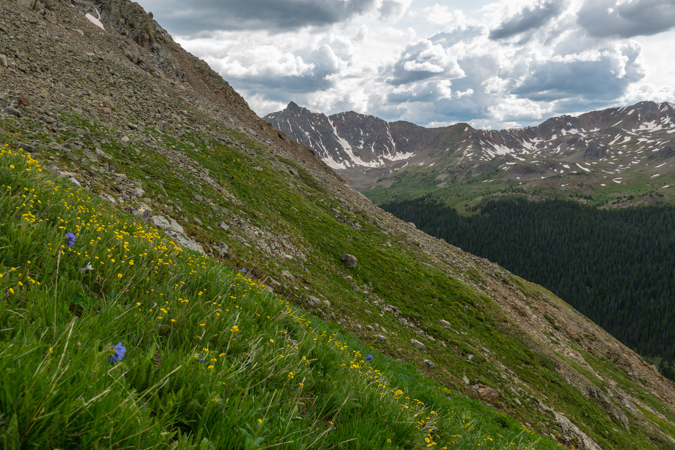
The 13ers to the west kept me looking back quite often, and the wildflowers were just too cool. They were all over the place, even above treeline, which is always awesome. I probably could have made it up the mountain in a lot less time, but I took the time to take some quality photos. This is another focus-stacked image making it so the very close flower in the foreground could be in focus as well as the distant peaks.
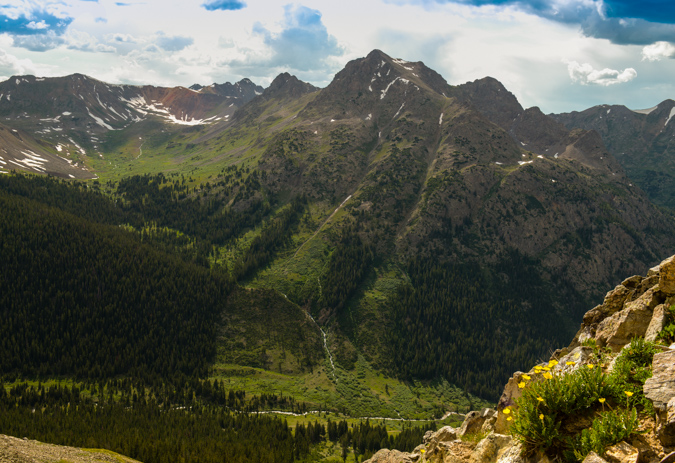
As I continued up, views of the Elk Mountains (specifically, Castle Peak) began to materialize above the horizon to the west beneath some virga coming from some small storm clouds.
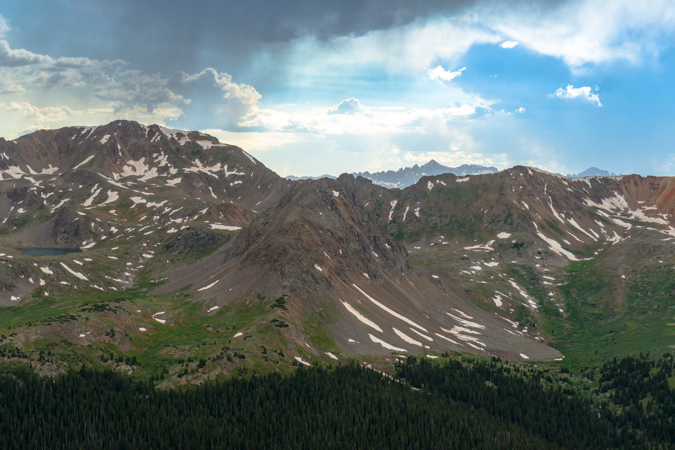
I was not worried about the weather yet - the clouds were pretty small and my new expansive views to the west indicated I should be in the clear for the remainder of the day. At this point, the climb became progressively more difficult for my weary legs. The weight of the photography equipment was really kicking my rear end and I had to take more and more breaks. The terrain was also much more difficult - not technically, but physically demanding. There were more boulder fields to contend with and the dreaded scree that takes you downhill one step for every two you take. As such, I decided to pack away my camera again so I could focus on the hike and make sure I did not fall. I finally was able to reach the saddle between Grizzly Peak and Garfield Peak as the light from the impending sunset was starting to generate some magic on the valleys below to the west and east. Seriously, if you've never done a sunset climb before, you need to - it is simply one of the most amazing experiences you can have in the high country.
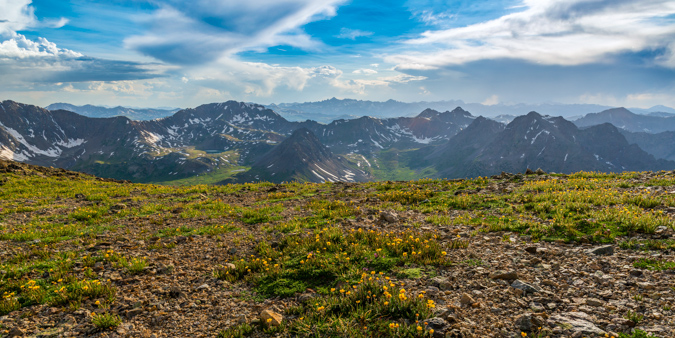
While the weather to the west was looking fabulous, the weather to the south and east was starting to look kind of nasty. I was not too concerned yet, but was keeping watch. One benefit of carrying a 5 lb tripod up a mountain is that you can do self-portraits. Here's one looking south and east towards Garfield Peak and Taylor Park (not visible).
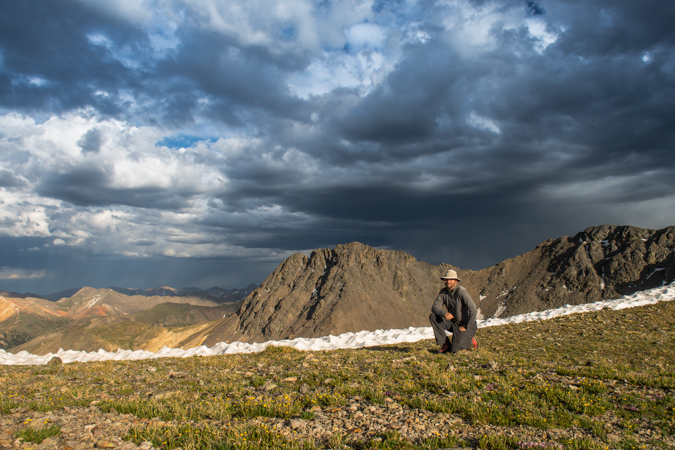
I also decided it might be fun to do a very large vertical panoramic showcasing the sky from the saddle, looking South-West-North. To the north (right) would be the summit of Grizzly Peak itself.
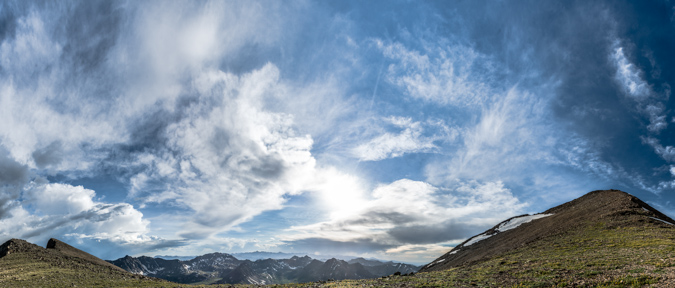
After about 20 more minutes of climbing, I was able to reach the summit of Grizzly Peak. I was greeted by an incredible view to the east and south, which included the Three Apostles and an amazing rainbow just shy of Taylor Park, where a huge thunderstorm was brewing.
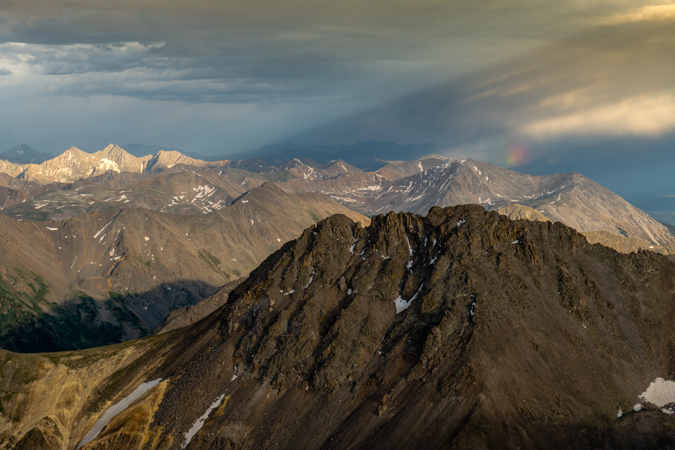
It was pretty awesome to be on top of the Continental Divide before sunset. The views were great, and that sweet rainbow stuck around for quite a long time to the northeast. The light from the sun was hitting the clouds over Taylor Park and causing some interesting streaks to appear. I signed the summit register, which was last signed by a guy I had read a trip report of from the day before. He had made a tribute to Steve Gladbach, a very accomplished and famous Colorado mountaineer who had just perished on Thunder Pyramid. I decided to also sign the book as "For Steve." I think Steve's passing weighed on every mountaineer's mind heavily, including mine. I never did get a chance to meet Steve, but we exchanged several cordial and thought-provoking messages over on 14ers.com regarding my morbid articles I write about the mountaineering deaths each year. Steve wrote a very eloquent and thoughtful post about death over there a few years ago and it always stuck in my mind. I even remember responding to his post saying that "heaven forbid you die in the mountains..." and yet - he eventually did. Steve had conquered the goals I have set for myself and I had always looked up to him, not only as an accomplished mountaineer but as a very amazing person. There are countless stories of his selfless acts and I felt a solo climb a nice tribute to his life.
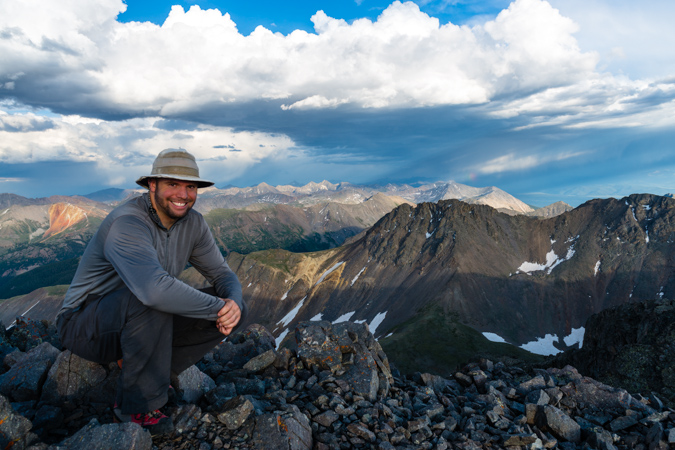
As I enjoyed the last few minutes of sunlight, I had to take advantage of my somewhat foolish decision to haul up my 300mm lens, which weighs 3 pounds on its own. I wanted to get some zoomed in shots of Ice Mountain, Pyramid Peak, the Maroon Bells and Snowmass Mountain using the 300 and a 1.4 Teleconverter, which gave me an effective focal length of 420mm.
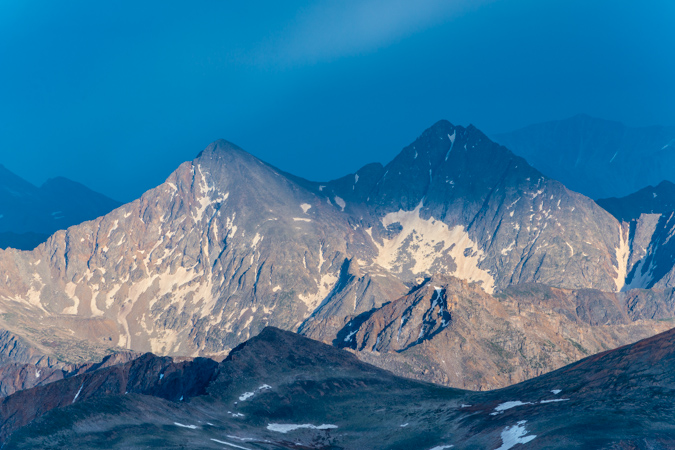
Castle and Conundrum were looking freaking awesome, with some crazy sunset light surrounding it. Thanks to Michael Colson for the correction!
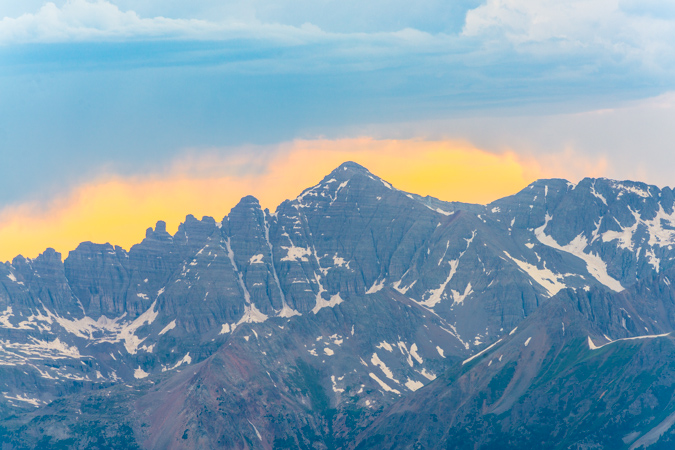
Snowmass Mountain was also looking wicked with the sunset light, giving the photo a very layered feel in black and white.
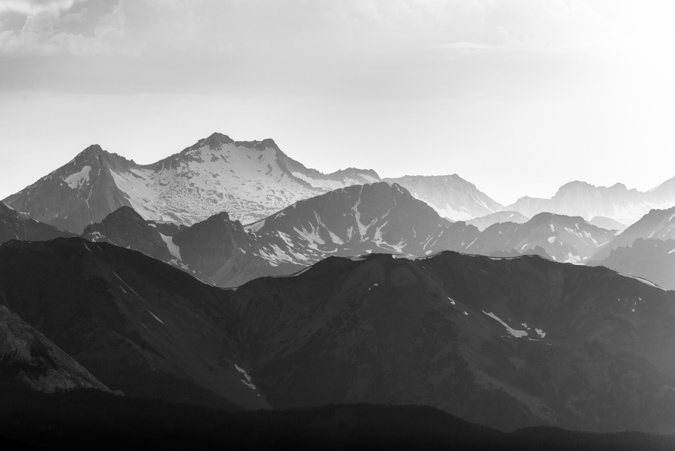
As the light continued to approach the magical photographic Golden Hour, I had some fun playing with different photos.
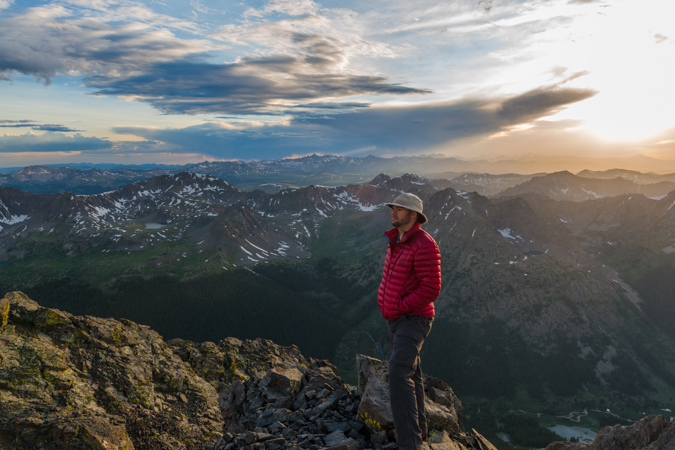
I also stitched together a massive 360 summit pano centered on the sun. This photo, being taken with the Nikon D800, is a massive file. If printed at native resolution (no loss of quality), it would span 30 feet wide. I'd love to see that. If I have time later, I'll work on an interactive 360 file so you can see this thing at a bigger resolution and zoom in.

The sun went behind some clouds but then created some nice god beams coming down near Mt. Sopris.
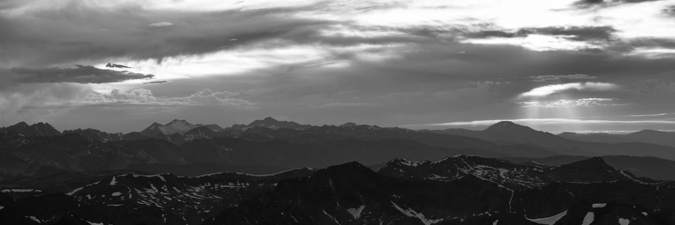
Then the sun reappeared and allowed me to snap off this photo which I think looks kind of like a Colorado flag.
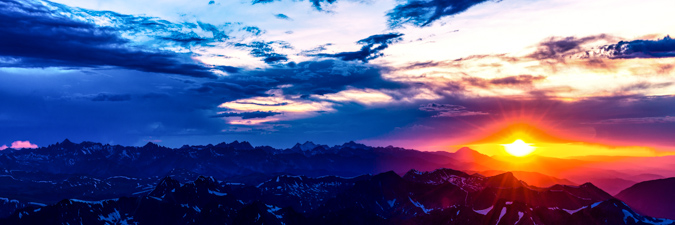
A look back to the east revealed some magic also. The light was very soft and colorful, showcasing the grand scale of La Plata Peak (left), Colorado's 5th highest mountain.
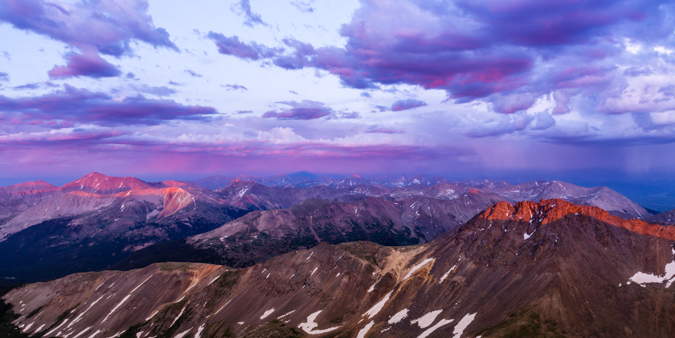
Sunset from the Continental Divide - an awesome experience. I took some artistic liberties on this next photo...
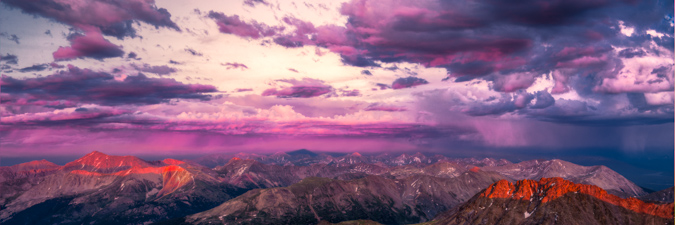
As the sun dipped below the horizon, and stood and watched the magic fade.
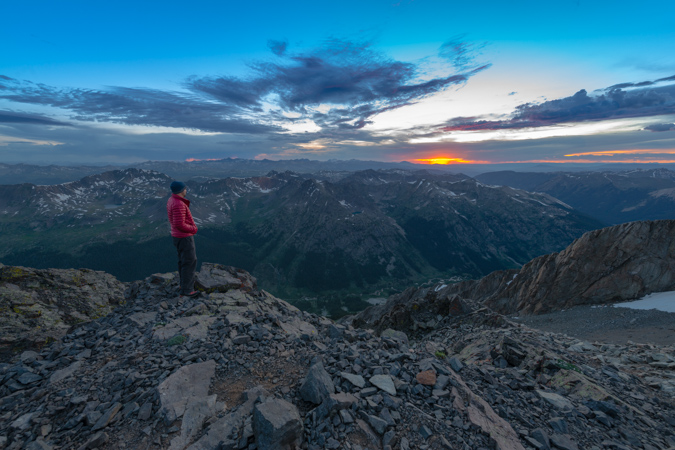
At this point, I had to make a decision. Watching the clouds to my east and south, I was getting a little nervous about the prospect of staying on top of the mountain to photograph the night sky. I was really motivated to do so, but I did not feel like it was a risk worth taking. While climbing down the mountain in the dark did not appeal to me, getting struck by lightning was even less appealing. I decided to pack up the gear and head down. The hike down was an adventure to say the least. It became quite dark very quickly, as there was no moon. I found myself in some sketchy spots where I had no recollection of that route from the hike in. I took my time and was very deliberate about each step. I was able to ride down a scree field a ways using some scree-skiing techniques and from there it was pretty much a boulder/snowfield/cliff/willow dodging fest. Downclimbing in the dark without a trail - not recommended - AT ALL. Hahahaha! It was certainly not the safest mountain climbing experience...
After reaching the road at 11 PM, I was rewarded with some insane views of the Milky Way. I set-up for some shots of the Milky Way and to my huge surprise, was able to also capture the Northern Lights! This next shot is a panoramic looking north-east-south. I just can't believe I got the Northern Lights - so awesome.
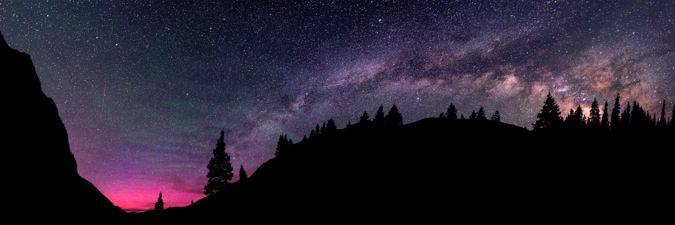
My final shot is me laying in the grass with my head-lamp, gazing into the night sky.
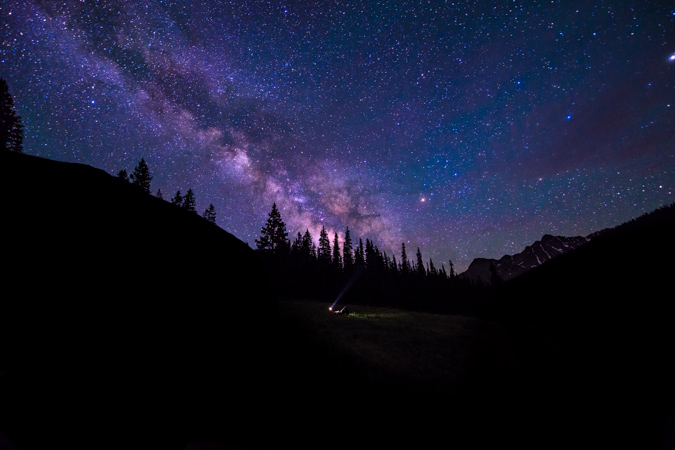
I slept under the stars at my Jeep back at the Reservoir after a long but enjoyable hike out in the dark and drove home to Colorado Springs early the next morning. What a great trip!
If you enjoyed my photos, please consider purchasing a print for your home or office. You can visit my gallery for a full showcase of my photography - if there are any photos from this trip you are specifically interested in, please do contact me.
Maroon Peak and Pyramid Peak - finishing a goal 27 years in the making
Two amazing summits; 11,060 ft. elevation gain, 21.5 miles... and a whole lotta' fun.
Introduction
Last year, I had plans to complete my long quest to climb all of Colorado’s 14ers. I had the calendar all lined up, trips planned, gear ready and my legs were in great shape. If all went to plan, I was to finish on Windom Peak after a long summer of knocking out some of Colorado’s toughest peaks. Unfortunately, as is so common in this sport of mountaineering and peak-bagging, those plans were interrupted. An unsuccessful attempt on Snowmass Mountain in June left me with one less weekend available. A complete re-arrangement of the calendar ensued and for the third straight year, my plans of climbing Maroon Peak and Pyramid Peak were delayed. However, this worked out to my advantage – as I had always dreamed of completing the 14ers on Maroon Peak and then on Pyramid Peak, which purportedly is one of the most difficult mountains as well as one of the most rewarding summits. Finally, my time had come to complete this incredible journey that started when I was six-years-old – the completion of the 14ers. Lots of hard work over the past 3 years have culminated in this moment.
Ever since I was a child, I recall being mesmerized by the Maroon Bells, for both their scenic wonder and beauty and their dangerous mystique. My dad, Ray Payne, climbed the Bells back in August 1987 and returned home regaling his conquest with stories of incredible mountaineering feats (it must have sounded insane to my then 9-year-old ears) and near-death encounters with “The Deadly Bells.” Here's an old-school shot of my dad (yellow helmet) asending Pyramid Peak, rope in tow.
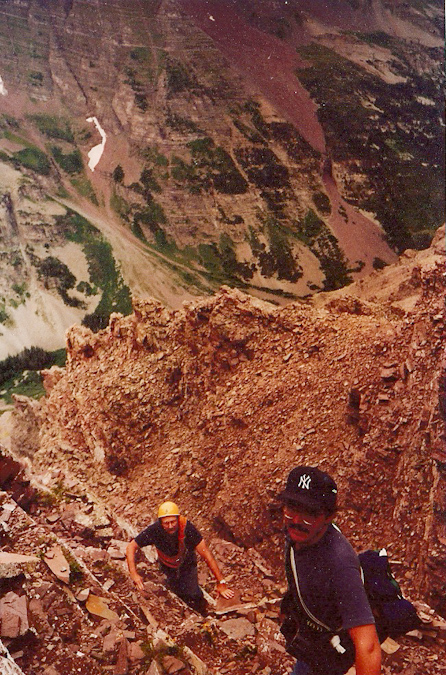
Per Wikipedia (and per my own witness of the sign), the term “Deadly Bells” refers to a U.S. Forest Service sign on the Maroon Lake access trail which calls the mountains "The Deadly Bells" and warns would-be climbers of "downsloping, loose, rotten and unstable" rock that "kills without warning". Sounds like my kind of mountain! Unlike other mountains in Colorado, the Maroon Bells are composed of metamorphic sedimentary mudstone that has hardened into rock over millions of years. This mudstone is weak and fractures readily, giving rise to dangerously loose rock along almost any route. This same mudstone is responsible for the Bells' famous and distinctive maroon color. The Bells got their "deadly" name in 1965 when eight people died in five separate accidents. Since then, many climbers have perished while attempting these dangerous peaks, including Spencer James Nelson in 2010.
In fact, just before leaving for this trip, I had learned that there was a missing hiker on the Maroon Bells. This news had cast a shadow on the trip and I had hoped he was found safely. The hiker was a New York City Paramedic named Lenny and had not reported to work. It later turned out that he took a fall and perished on North Maroon and was found the very same day we arrived.
Given the danger factor and overall awesome factor surrounding the fact that I was planning to complete the 14ers on these deadly mountains, I was quite nervous the week leading up to this trip. I think I had started packing four or five days before the trip, which is uncommon for even me and my neurotic trip planning. To make matters even worse, the trip had quite a few loose ends on the logistics side of things – originally I had planned to head-out Tuesday night with my climbing partner, Sarah, we’d climb some mountains, and then our other climbing partner, Ethan, would join us at Crater Lake on either Saturday or Sunday. Then a few wrenches got thrown into the mix – Sarah found out she had to work a cycling event on Sunday, and Ethan would be unable to join us on Friday. To make matters even more interesting, my Jeep Wrangler came up with some mechanical issues the day before we were supposed to leave. It was not looking good for team Payne. I called Sarah and we finally worked out all the details. Ethan would not be joining us after-all, and Sarah could drive. Crisis averted.
I decided to backpack using my Osprey Talon 44 instead of my regular backpacking pack – the huge and insane discontinued Dana Design Terraplane - a monstrous 95 Liter pack. Instead, I opted for the smaller 44 Liter pack so that I would force myself to take less gear and food and hopefully save some damage to my knees, which were still recovering from the massive 45 mile trip Sarah and I took last year to the Chicago Basin. To round things out, I opted to also purchase a knee brace, in hopes of preventing pain and further damage on this trip.
Choosing camera equipment for a trip such as this was a challenge, especially given the fact that I wanted to keep my over-all weight low without sacrificing my ability to take great photos. So, I opted to bring my Gitzo carbon-fiber tripod (which is quite solid and somewhat heavy despite being crafted out of carbon-fiber), Nikon D7000, a few filters, a shutter release cable (for long exposures), and two lenses – the Tokina 11-16 f/2.8 and the Nikkor 18-105 VR f/3.5-5.6. This would give me the ability to shoot very wide shots and some versatility with a zoom in the 18-105.
Day 1: The drive in
Loaded-up and ready to rock – Sarah picked me up from my house in Colorado Springs at 7 PM. We departed for our speedy adventure up Highway 24, which afforded us some pretty gruesome views of the damage caused by the Waldo Canyon Fire just the month prior. We stopped at the top of Wilkerson Pass to check-out the remnants of a thunderstorm there, hoping to capture some of that footage on film; however, all I was able to get was a long exposure of the cars driving through South Park below.

Thanks to some recon data provided by 14ers.com member Bill Wood, I knew our goal was to find the over-night parking lot just below the Maroon Lake trailhead. We found that lot at around midnight and prepared for what would become a very short 4-hour nap in the back of Sarah’s skinny pick-up truck.
Day 2: The backpack in to Crater Lake and an attempt on Maroon Peak
We were rudely awoken at around 3:45 AM by some guys next to us prepping for their hike, who were loud and even making jokes about how we were probably not too happy about how loud they were. Such is life at popular 14er trailheads, even on a Wednesday morning. We debated the night before about our intents and goals for this first day in the area, and decided to wake-up at a reasonable time (4:30 AM) to begin backpacking up into the basin to find a campsite, with the option to attempt Maroon Peak (weather dependent). We rose groggily from the truck and prepared our backpacks, which for me is always an interesting challenge with a large tripod attached. We began the hike in the dark and were passed quickly by a solo hiker looking to tackle Pyramid Peak by himself. Best of luck to that guy. The hike up towards Crater Lake was quite uneventful, and after a quick 1.5 miles, we stopped shortly before sunrise so I could quickly bushwhack up a hillside to photograph the Maroon Bells while the light was good. I did several versions at various focal lengths and lighting.

During this photo shoot, I made a nearly dire mistake when I switched lenses. I put my Tokina in my camera bag, which was attached to my chest. I forgot to zip it up, so when I leaned over, the lens rolled out onto the rocks. Fortunately, absolutely no damage was done. Close call!
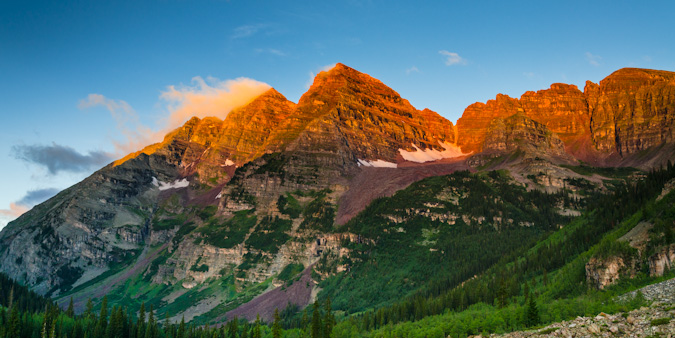
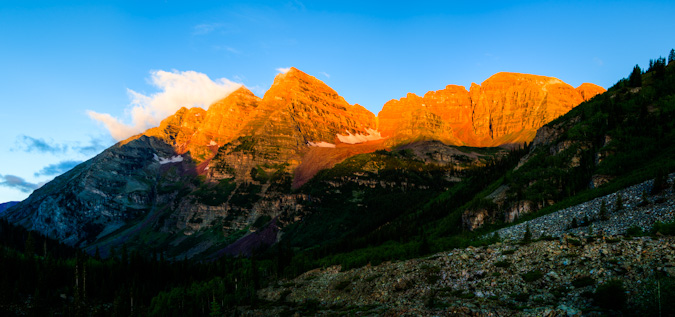
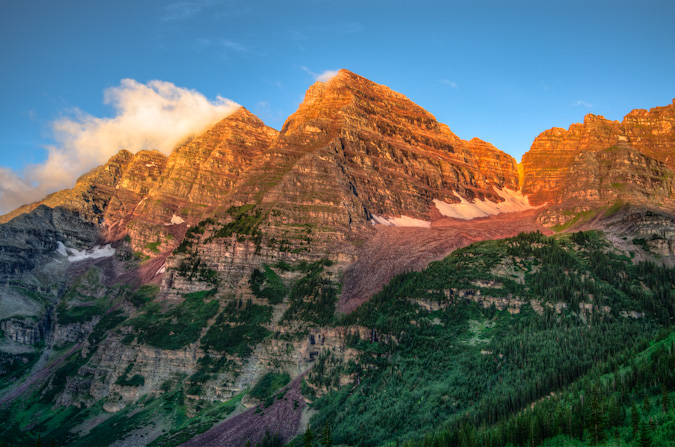
After shooting sunrise at the Maroon Bells, we made our way up the rest of the way to Crater Lake, where we would try to locate a campsite. Upon first arrival at the lake, the reflections of the Maroon Bells in the very still water and post-sunrise light were absolutely fantastic.
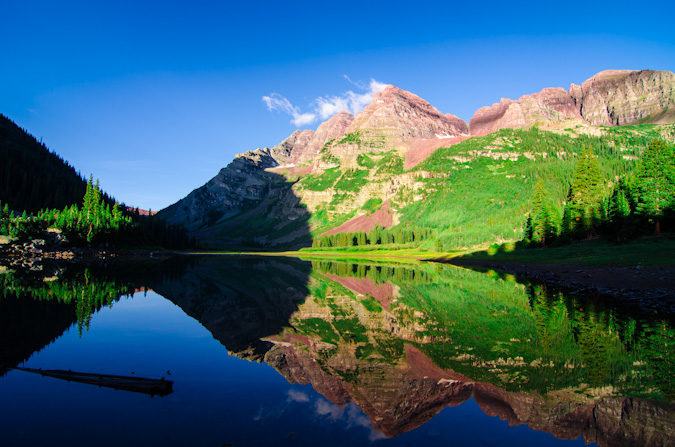
A wider view, including the Pyramid Peak massif:
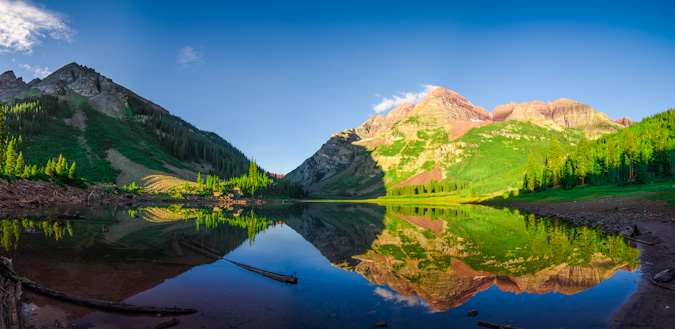
The search for a campsite was on, and I had been given some good tips from Bill Wood that we should shoot for campsites 6-11. We finally landed on campsite 9, slightly south and west of Crater Lake on a large hillside. Sarah later joked it was no wonder the campsite was open, because you have to hike up a hill away from the water to reach it.
We quickly made camp, setting-up the tent and all of our stuff, and finally had summit packs ready by 8 AM. Not exactly the best start time for a 14er of Maroon’s caliber, but we thought we’d give it a shot either way, so off we went. We followed the trail quite a long ways up the valley to the south and reached the oh-so recognizable warped tree described by the 14ers.com guide.
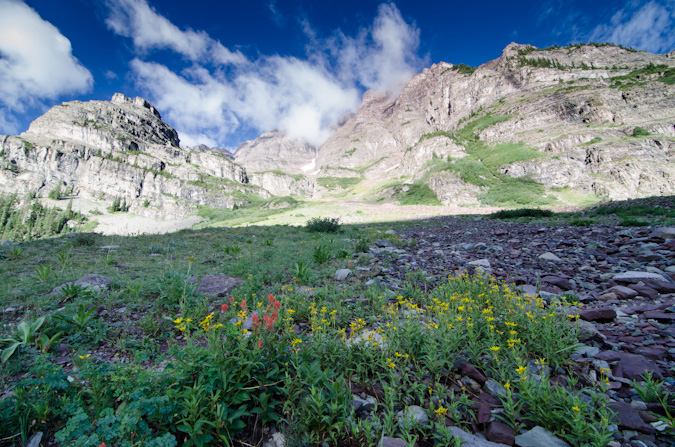
After the tree, the real work was before us, and the Maroon Peak southeast slopes trail lay before us in all of its steep glory. The trail started quite steeply, much like the Manitou Incline.
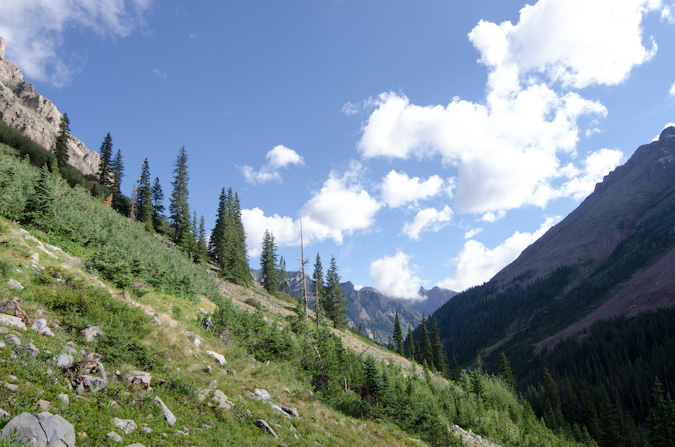
We reached well above tree-line before my stomach started to really give me issues. I could not figure out why I was not feeling well, so we stopped at around 12,400 ft. This turned out to work out just fine, because weather was starting to build above, the clouds that were hanging low all morning had never really left. I later figured out that the culprit to my stomach issue was the Cliff Bar Builder’s Bar I had ate.
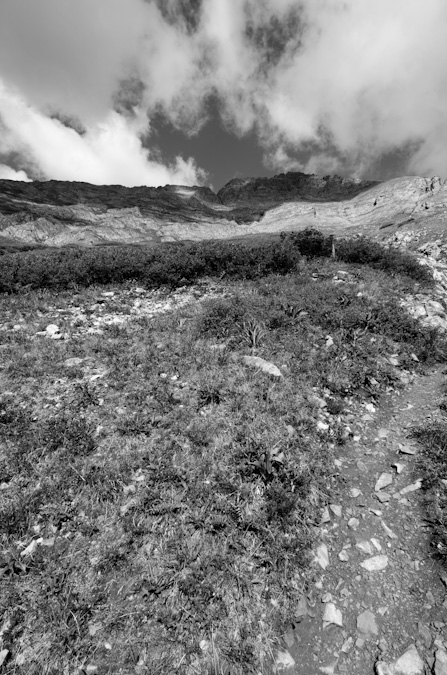
Sarah and I sat around for a bit, contemplating our options.
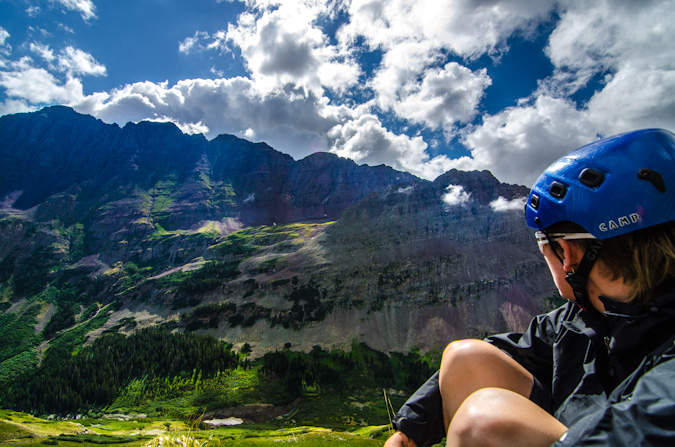
We had picked a pretty great place to stop. The views in all directions were great. We did not feel rushed at all.
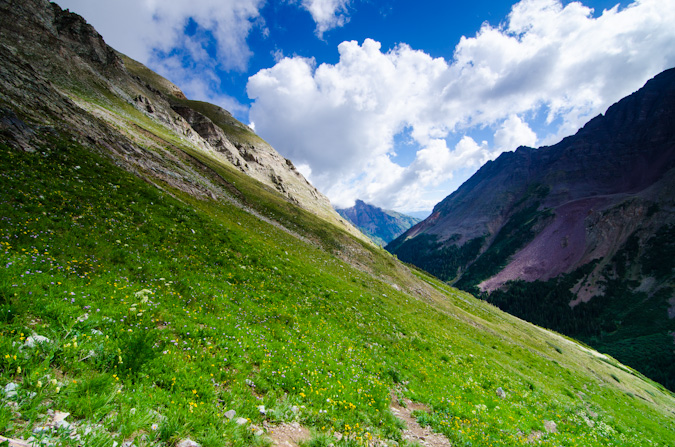
Even though my stomach was in pain, we found ourselves near a large meadow of wildflowers, which made for some fun photography.
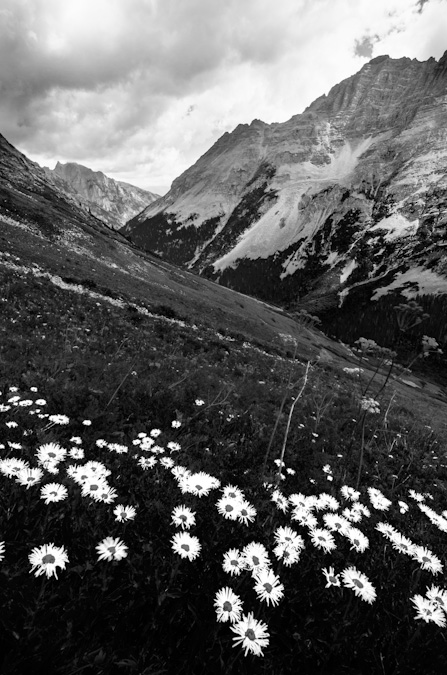
It was a really cool spot, and since it seemed were not going to do any more climbing, I took the liberty of taking a ton of shots.
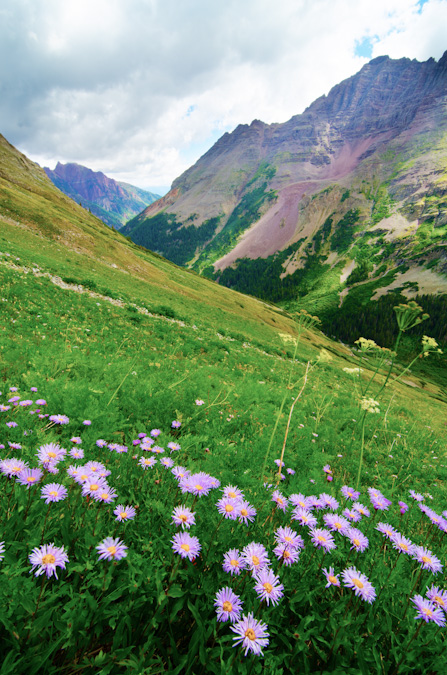
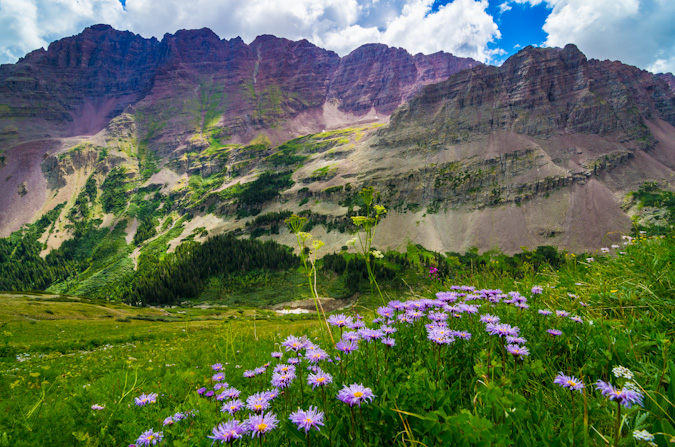
We headed on down and later ran into a group of three guys coming down as well. They were attempting Maroon as well and were turned back due to the weather just short of the ridge. These three guys were very cool, and we had a nice conversation about the area and climbing the Centennials. We all headed on down to the main trail, where we intersected two more hikers coming up to investigate the location of the Maroon Peak trail turn-off. This would not be our last encounter with these two guys, as we would later run into them twice more the following day.
Sarah and I hiked back to camp and took naps. After our short naps, we cooked up some food and I prepared my camera equipment for a walk down to Crater Lake for sunset shots and later night photography.
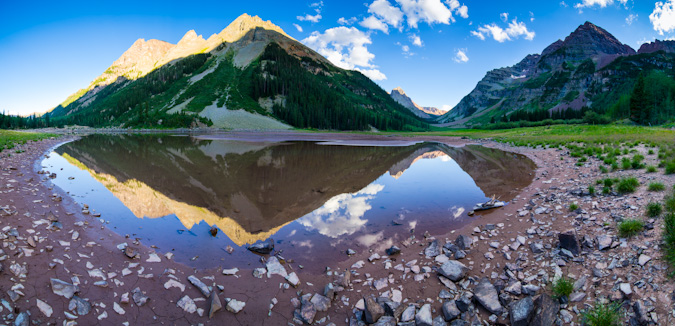
Upon arriving at the lake, I was immediately in my happy place, having many quite interesting landscape shots to attempt. I waited for the sun to set and the magic started to happen, lighting up the tips of the surrounding mountains to our East, which were part of the Pyramid Peak massif. I also tried out my ND filter and did some longer exposures of the clouds and Maroon Peak.
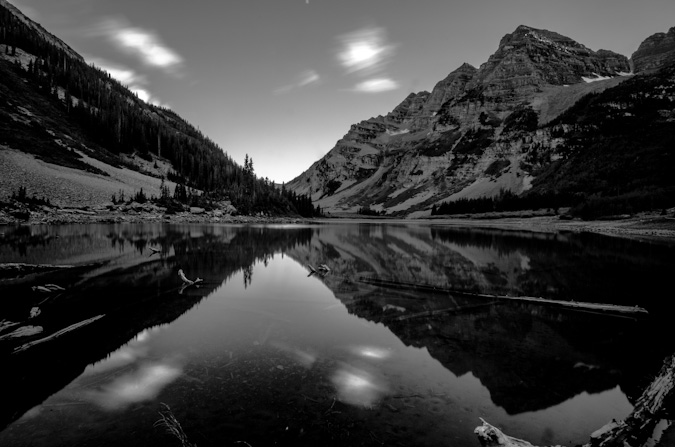
Sarah was able to sneak a shot of me geeking out on my camera.
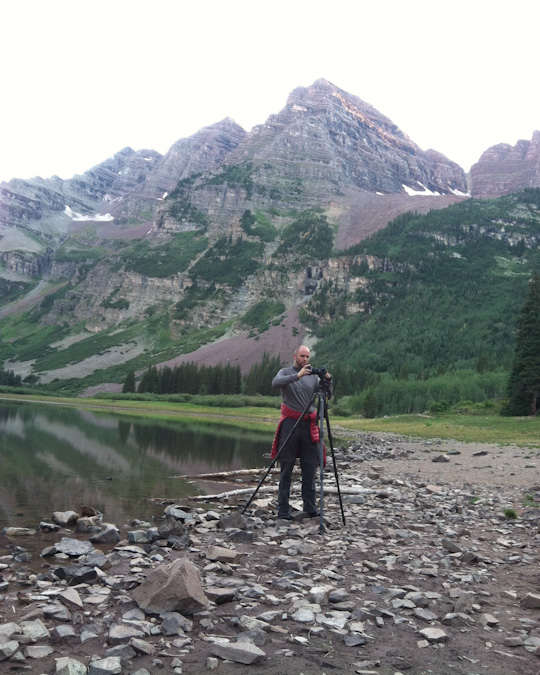
Composing the shot...
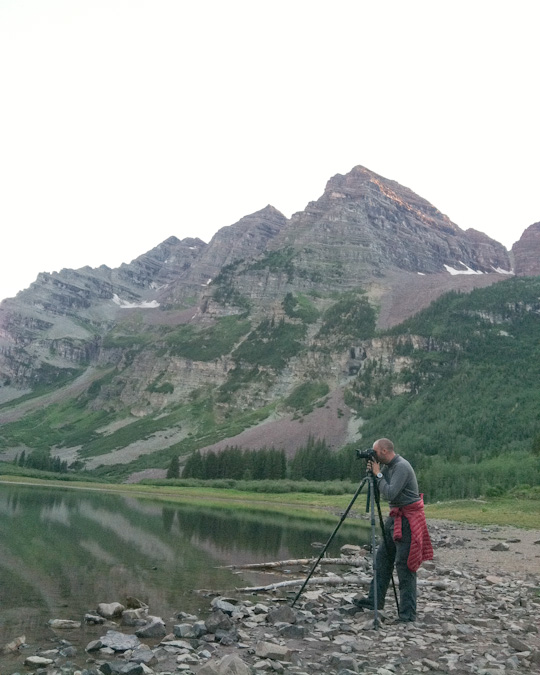
The sun was setting and the light started doing its thing.
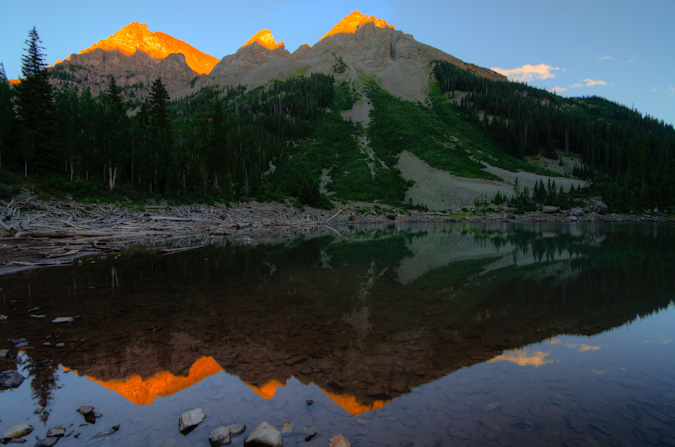
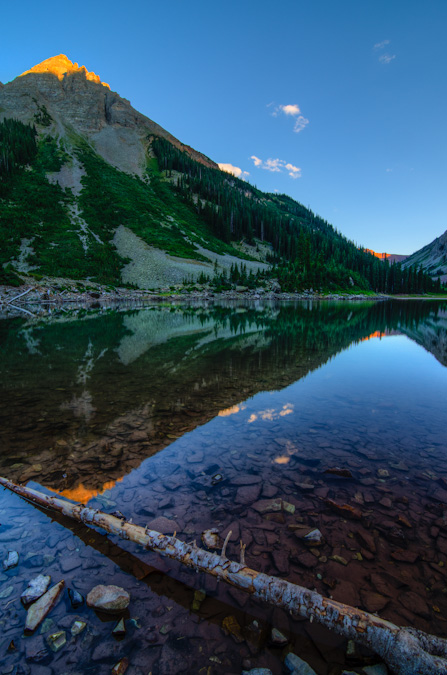
After the sun went down, Sarah went back to the tent to get some sleep. I stayed out and set-up for something I had been planning for a long time - star trails over the Maroon Bells, reflected in Crater Lake. This worked out pretty nicely, there was a group hiking in the dark up the trail and so my long exposures got their head lamps in the shot too, which I opted to keep in. The "break" in the trails is from my intervalometer stopping unexpectedly on me and me having to restart the sequence. Bummer! Still turned out great though, I think. You can see where the moon had just set over Maroon Peak's upper left cliff bands.
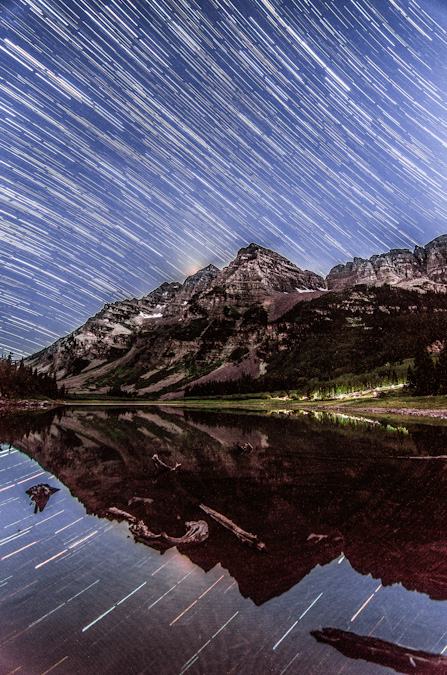
While photographing the star trails using the intervalometer on my camera, two sets of eyes appeared near me at the lake. I rose and walked closer to find two deer, one a quite large buck. I was both relieved and amazed. I’m not really sure how well I could defend myself against a mountain lion.
After shooting star trails above the Maroon Bells, I took advantage of the scene and clear night and took some fantastic shots of the Milky Way. My two favorite was this single shot of the Milky Way reflected in the lake, and the next one, which is a 9-shot panoramic of the Milky Way above the Pyramid Peak massif. Click on the single shot if you'd like to learn more or purchase it.
I just could not get over how clear the sky was!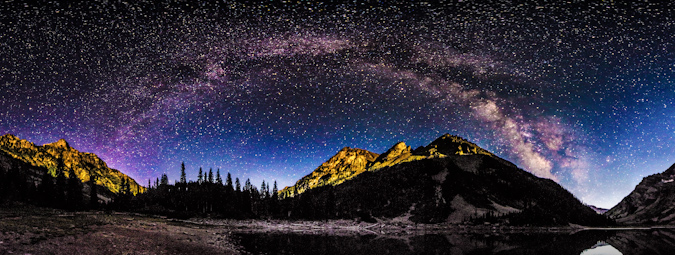
After capturing what I felt at the time were some great photos, I decided it was time to hit the sack, since our departure time for Maroon Peak was looming just a few hours away. I came back to the tent, where I found Sarah wide awake still. Apparently a field mouse had managed to find our tent and was crawling over the top of it, which kept freaking Sarah out. In fact, about 30 minutes later, the mouse bumped past the side of the tent next to Sarah’s face, which caused her to freak out and elbow me like she was trying to win a Karate match. It was awesome.
Day 3: Early start and successful summit of Maroon Peak - 14,156 ft.
Sarah’s iPhone alarm sounded off and sounded just like a self-destruct sequence, in fact, it was just like this YouTube video.
Mixed with my dream that President Obama had confiscated the valley we were in for national security reasons, and my head was all kinds of whacked out – too much, too early.
Nonetheless, we rose like zombies and hit the trail at a brisk pace at a quarter past 4 AM and head back up the valley to the Maroon Peak turn-off, in the dark. By the time we were working our way up the steep trail, the sun had begun to illuminate the mountainside and we were moving at a very steady pace.
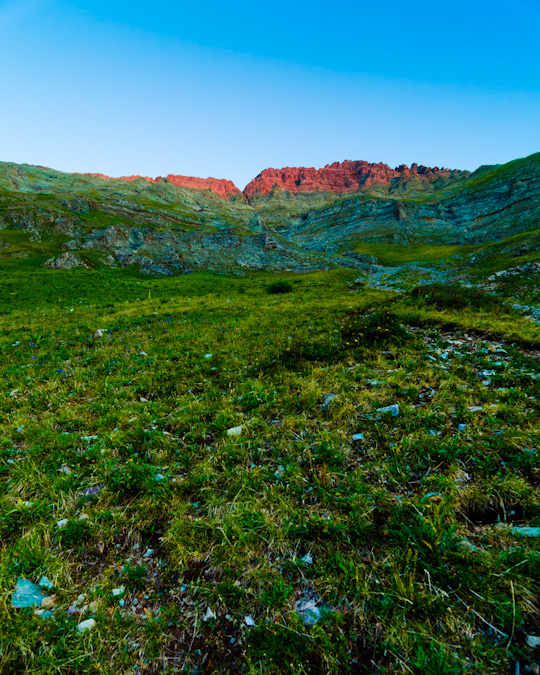
Two of the three climbers from the prior day passed us quickly, having a deadline to meet – they were extremely fast – good on them! We kept our pace going at a good rate and eventually caught up with the two gentleman from the day before that were looking for the trail.
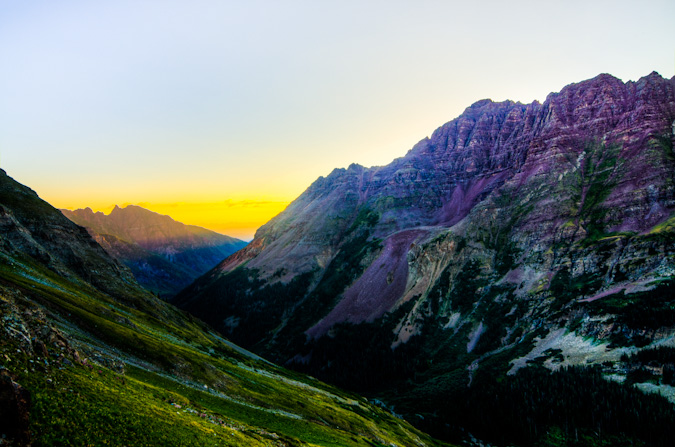
They were moving very slowly and had mentioned that there was only two others ahead of them other than the two we knew about – a photographer and their friend.
A photographer you say? This piqued my interest instantly. Who was ahead of me? Did I know them or of them?
The trail was one of the steepest I could remember. Exhausting, but a wonderful workout all the same.
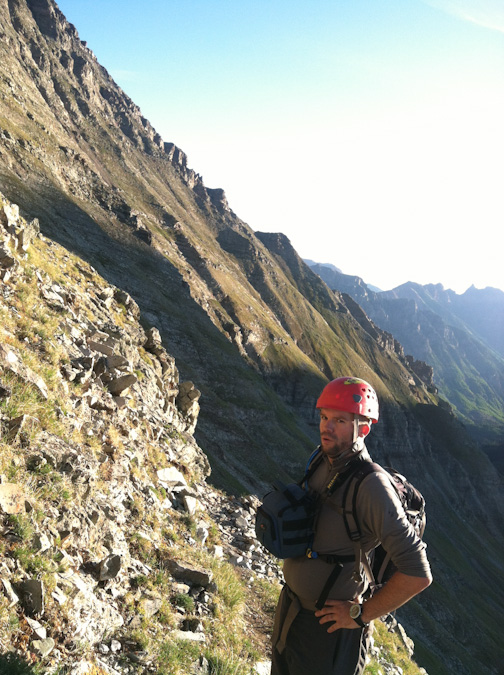
Before long at all, Sarah and I crested the ridge after 2,800 feet of grueling non-stop high angle grinding. As Bill Middlebrook describes on the 14ers.com route description, “Conquering the East Slope is a major achievement, but now the more technical terrain remains.” Indeed. Time to refuel.
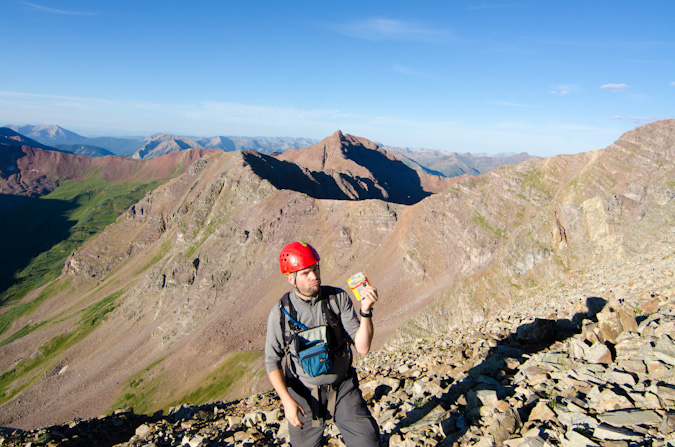
Sarah had maintained an excellent pace up Maroon Peak so far and was kicking my butt. Did I mention that while I'm at home editing photos, she's out racing single speed mountain bikes? Yeah. Wonder who's in better shape?
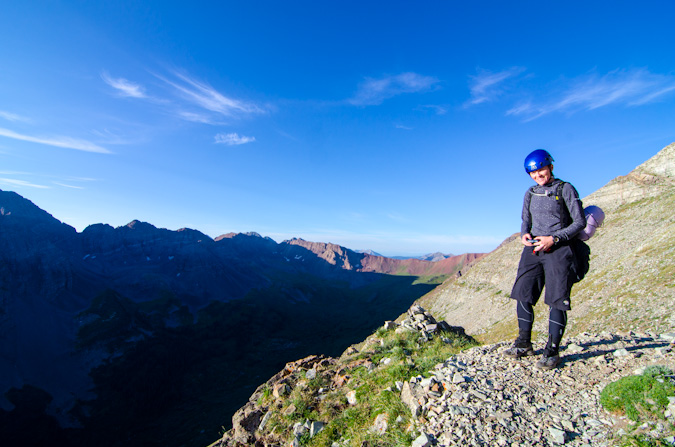
The remaining section of the ridge was more of the same; however, we had much better views of the surrounding area.
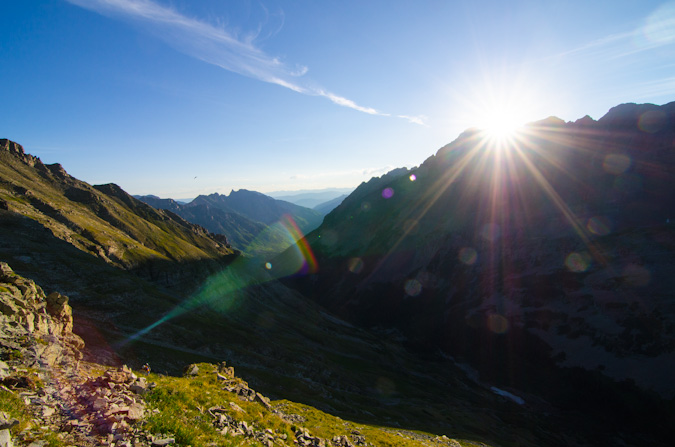
Once we reached the ridge, it was only a short section of maybe 400 feet to tackle before reaching the hard part.
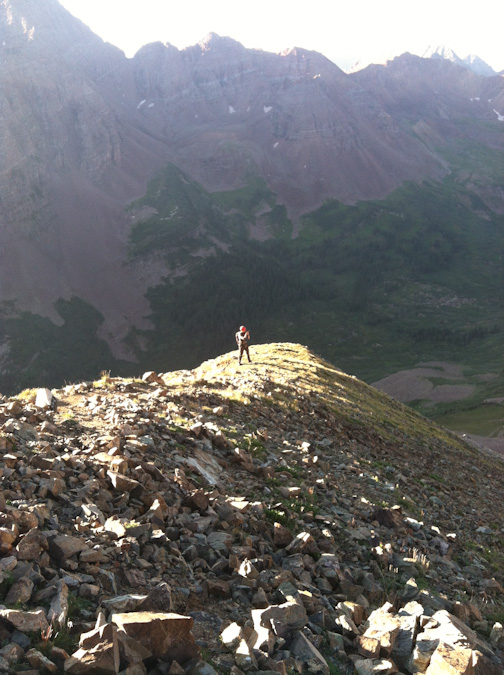
The ridge section was still fairly steep, but the excitement of seeing the rest of Maroon Peak's impressive face kept us moving quickly.
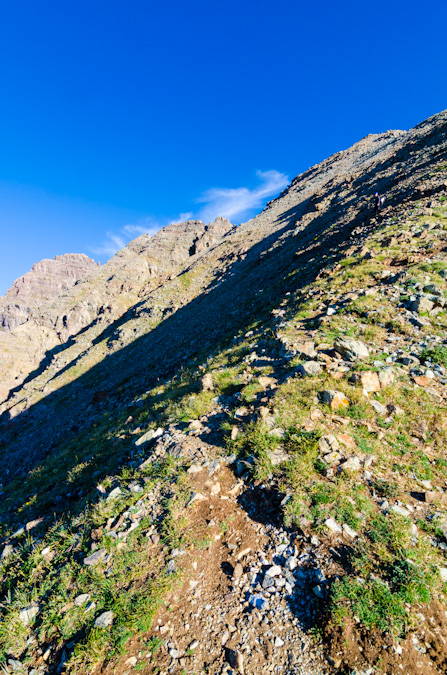
Reaching the crest of the final ridge was exhilarating as always, made especially sweet by the awesome visage of Maroon Peak, which loomed in front of us like a giant sentinel.
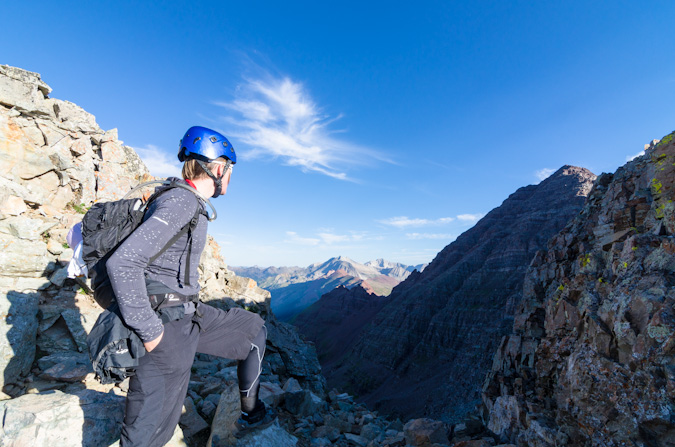
Sarah and I followed the rest of the route religiously, having had a bad experience off-route last year on Snowmass. We took a break for food, and I ate another Honey Stinger Waffle which was delicious – these things are the real deal. The fun begins.
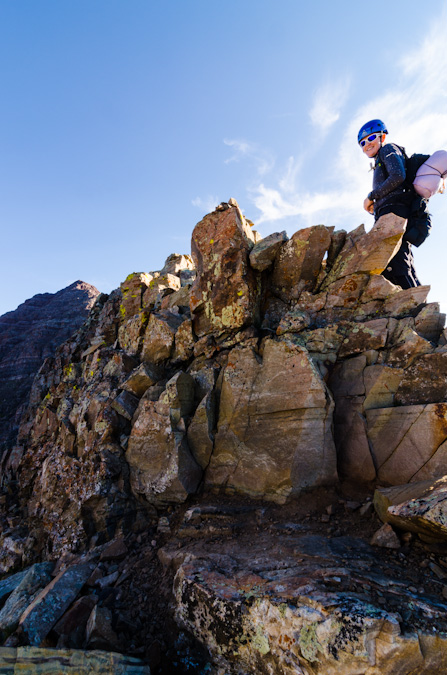
From the ridge crest, the route went very easily, much to my surprise and partial disappointment. I was expecting an epic class 3 adventure; however, Maroon Peak is more like class 2 with a sprinkle of class 3 in some lame locations. It looked intimidating as hell though.
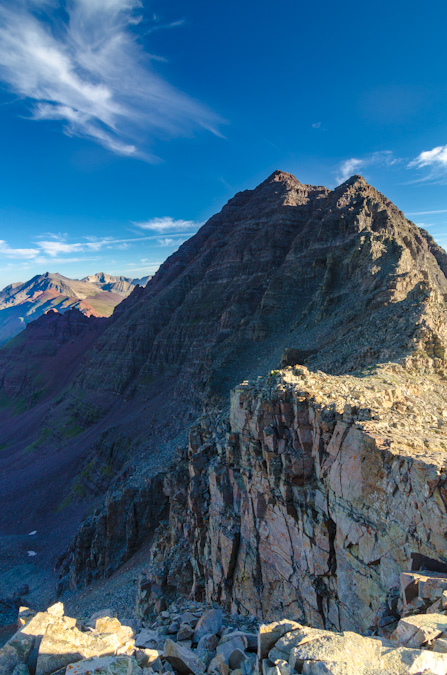
The trail is very obvious most of the route and there are actually only a few spots you need to actually make a decision and “climb.” That being said, the terrain was still quite dangerous and we were vigilant. The views... oh man. So amazing. Intense.
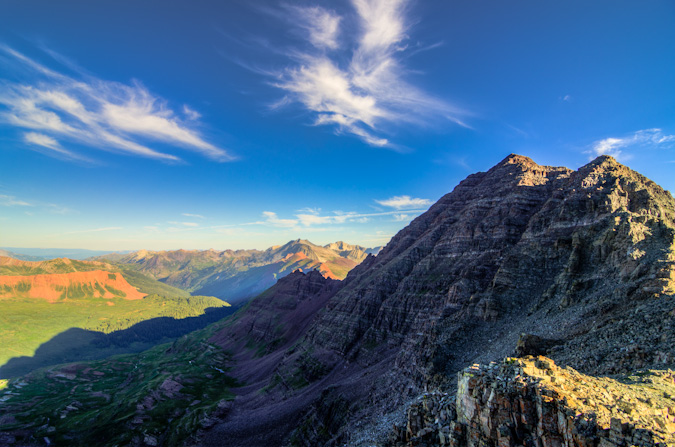
Shortly after entering the more dangerous terrain, we ran into the other companion of the two guys we had passed earlier. He wanted to know how far behind they were. He was not very thrilled to learn about their slow pace, but the weather seemed to be holding so I felt like they still had a shot.
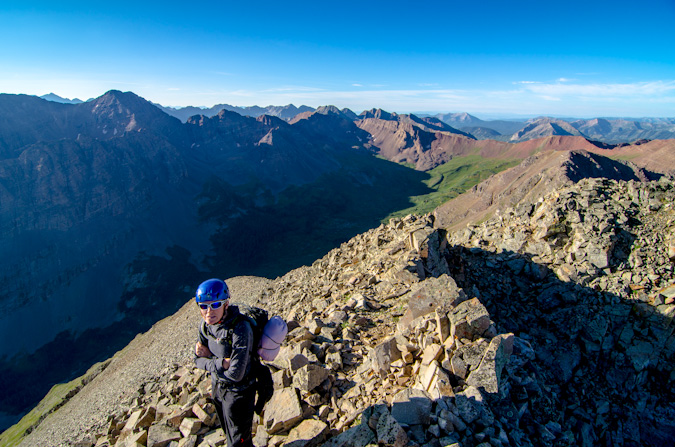
For the most part, the first section after the ridge involves following the trail up and over a bunch of small gendarmes near the ridgetop. As predicted, we found ourselves having to climb a small gully into a small and secluded alcove, which offered great views to the west.
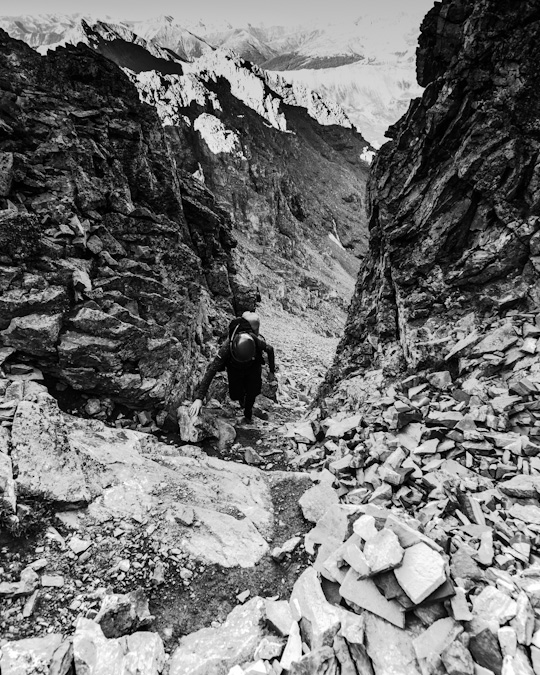
Just at the top of this gully rested our next problem - a small gully with great hand and foot holds heading up.
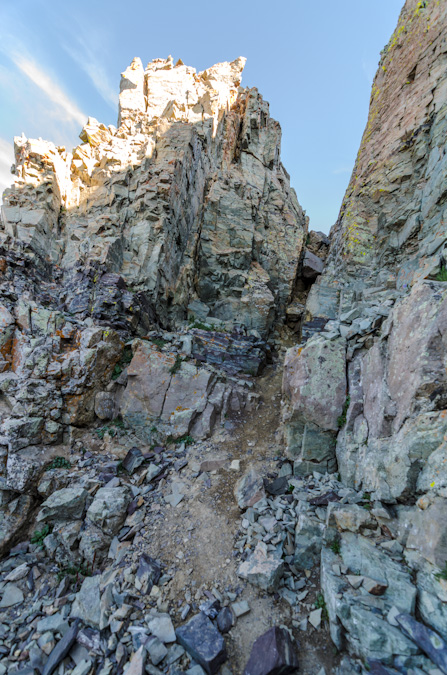
On the other side of this gully, parts of Maroon Peak were back in view. The route certainly did not look obvious from here, but it worked out.
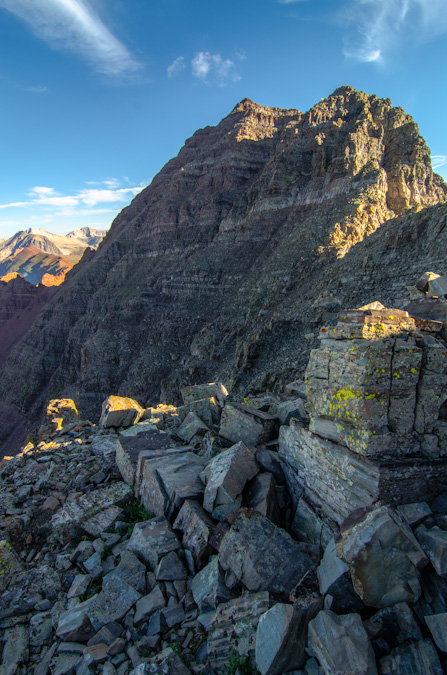
The most dangerous section was probably the set of gullies you can choose to ascend about 2/3 of the way through the route as pictured here.
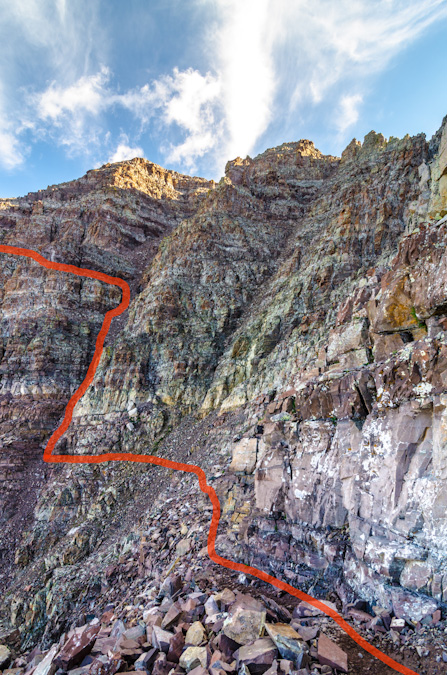
We chose to climb the second gully and then follow a ledge system to the left. I feel that under the right circumstances and a lot of climbers, this section could be quite dangerous due to rockfall. Most of the rest of the route seemed quite safe with the occasional ledge area that was exposed. It looks worse than it is, trust me. Here's a view from the top of the gully, looking back across where we had come from.
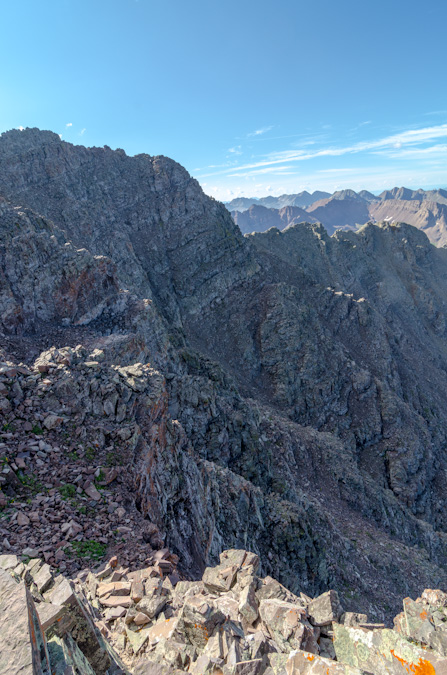
At this point it felt like a great time to stop and soak in the views. It does not get much better than this.
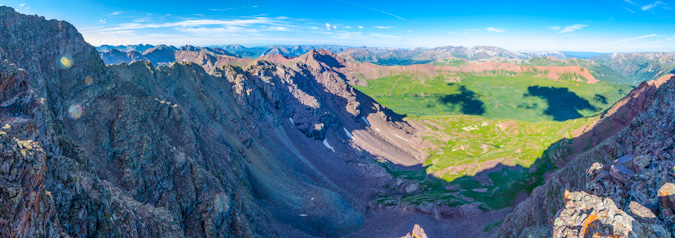
The rock features on Maroon Peak were quite remarkable and made for a wonderful hiking experience. There were many times where I kept saying to myself, "I'm really here, this is one awesome place!"
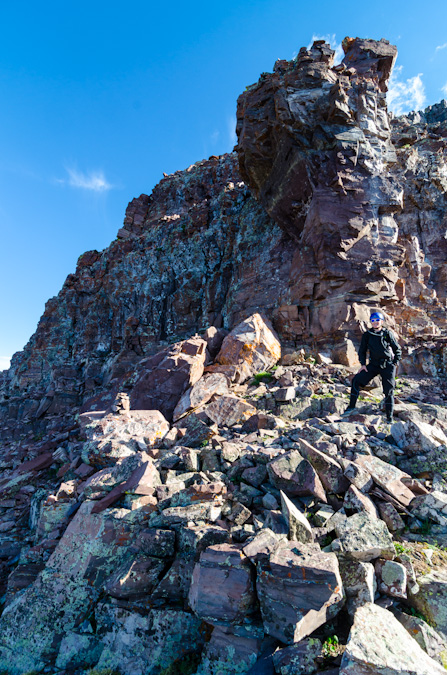
Looking up or down made you feel so small. The sheer ruggedness and steepness of these peaks is easy to appreciate.
The final stretch of the climb includes a large boring dirt and rock section that reminded me of Columbia Peak, meaning, it was fairly awful – the kind of stuff that goes two steps up and you slide one step down.
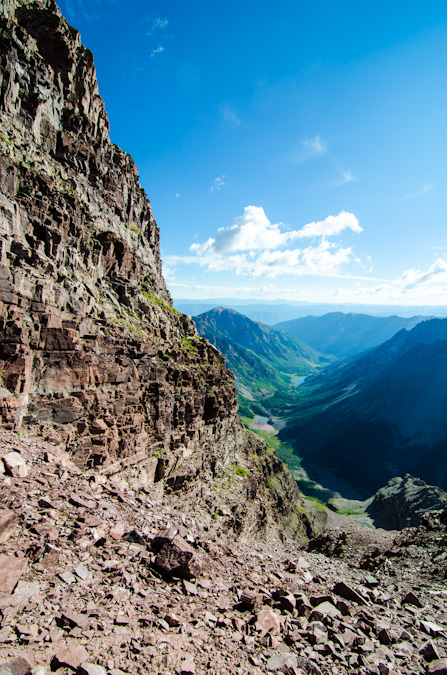
Once at the top of this area, you climb a really short but interesting ledge system onto the flank of the peak and follow a long series of quite solid and fun-to-explore ledges before reaching the final summit ridge.
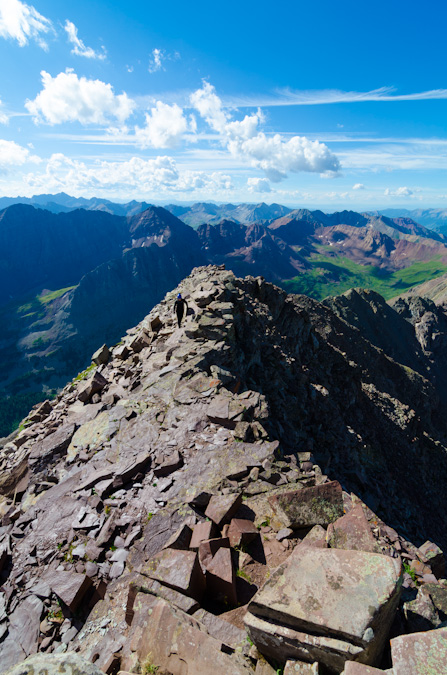
Pyramid Peak dwarfed Sarah.
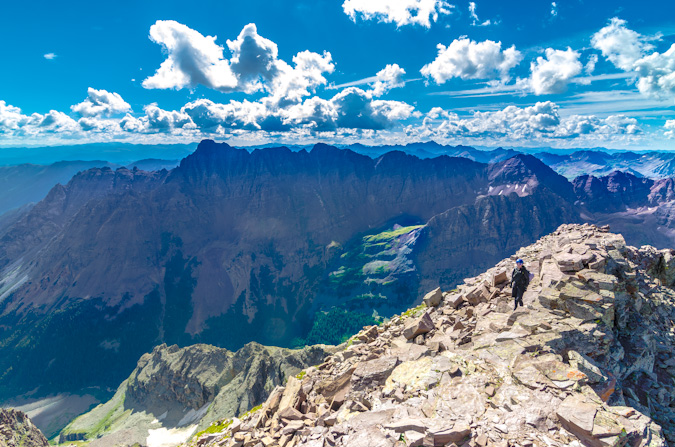
Sarah, while only equipped with an iPhone, took some awesome shots on this trip as well. One of my favorites was this one she took of my near the summit.
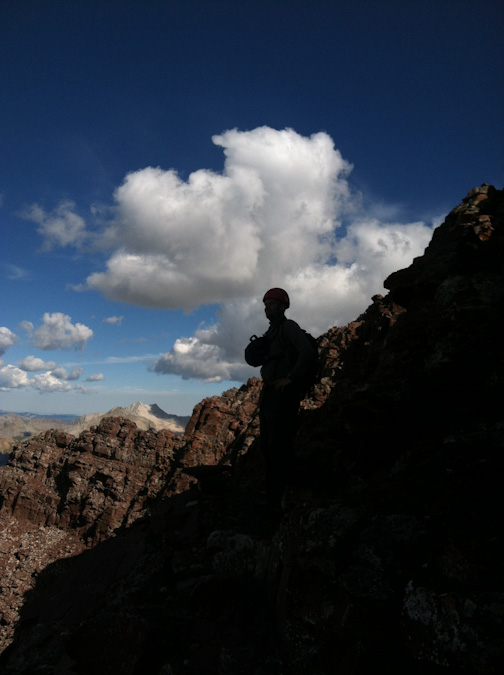
Upon reaching the final summit ridge, I saw a man with a yellow helmet on the summit, in fact, the same yellow Edelrid helmet my dad handed down to me and seen in the photos of him in this report. He yelled down at me that it “was a great photo” and to “stay put if I didn’t mind.” This must be the photographer we learned about. While I waited for the light to get right for him to take my shot, I took a high contrast shot of him and Sarah on the summit.
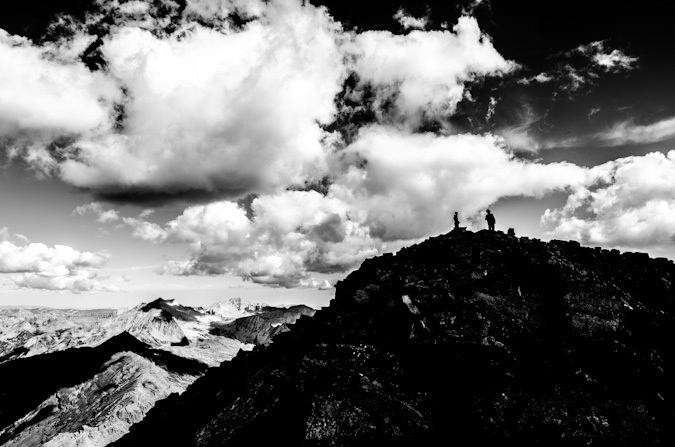
He then snapped off this cool shot of me climbing the final section to the summit.
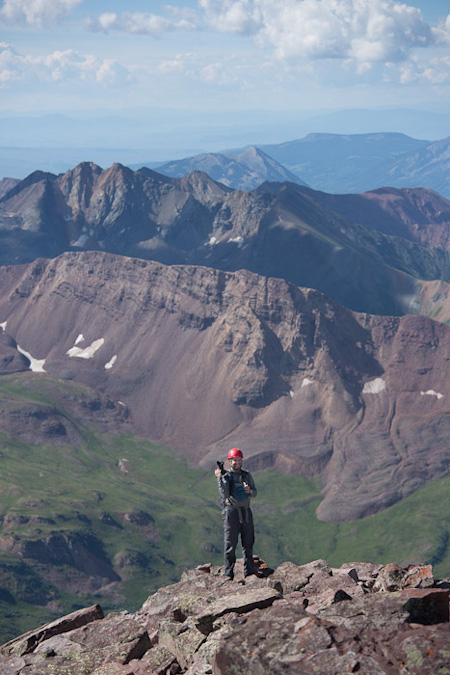
We got up to join him and he pulled out his business card. It was none other than the legendary Glenn Randall. Readers may recall Glenn’s name from an article I wrote earlier this year where I shared my thoughts on the twenty best Colorado landscape photographers. In fact, Glenn’s revered in the mountaineering-photography community as a pioneer, for, as he later explained to me, he has photographed sunrise from thirty-eight 14ers. This is a most impressive feat. Glenn explained that he was just on a recon mission today, because he was going to be doing Maroon Peak tomorrow as well to photograph sunrise from there. He was setting waypoints and familiarizing himself with the route. He had just done sunrise at Pyramid Peak the day before. Glenn’s dedication to this sub-set of photography is most impressive – in order to achieve sunrise on a peak like Maroon Peak – he would need to begin hiking at midnight and carry over 20 pounds of photography equipment with him to the summit. I was humbled to have met such a great photographer that I had modeled a great deal of my own personal work after.
Glenn gladly took our photo with Sarah's phone.
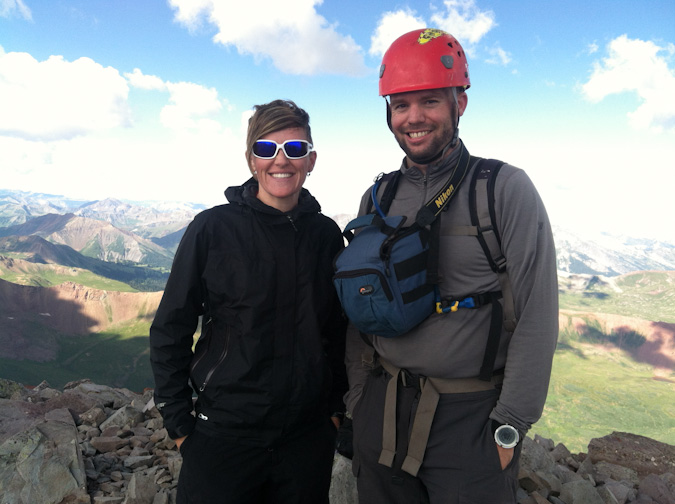
Glenn and I talked shop for quite awhile and he decided to head down. Shortly after though, two mountain goats came strolling up the side of the mountain from the descending route area with none other than Glenn behind them.
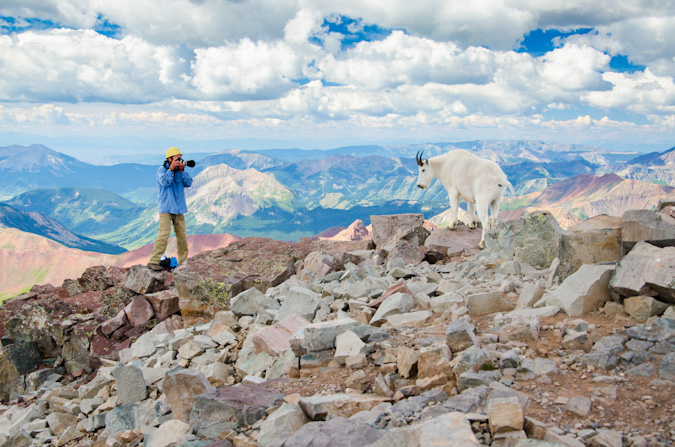
It was such a fun day on the summit, sharing the photographic experience with a true pro. I had fun composing images of the goats and of Glenn. I might be geeking-out a little, but it really was an incredible experience.
Sarah was able to get some incredible shots of all of the action too. Some of my favorites.
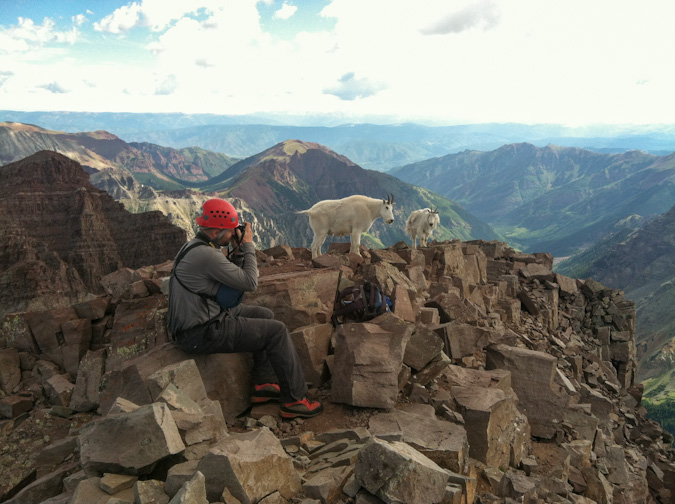
These were quite friendly goats, often coming within feet of me.
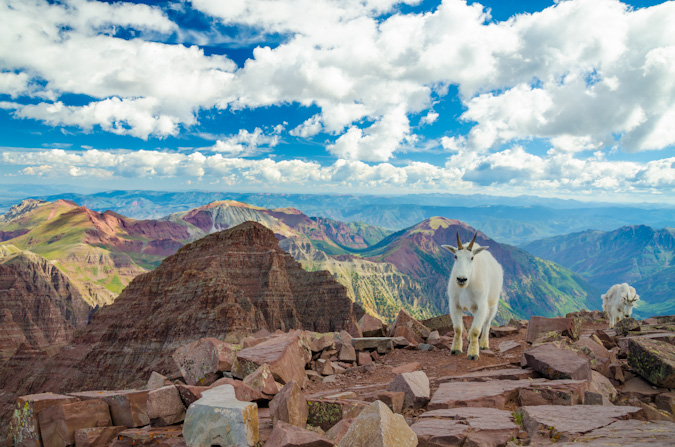
Pyramid Peak made for a killer backdrop for the goat.
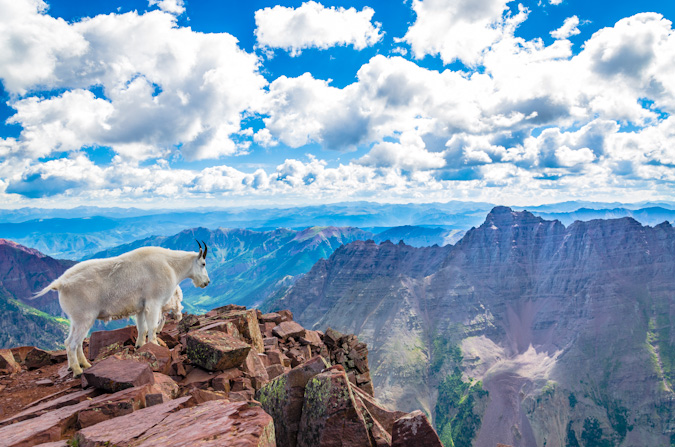
I bet Glenn got some really great shots of the goats... he was sporting a quite nice Canon Fx camera and a 70-200 lens.
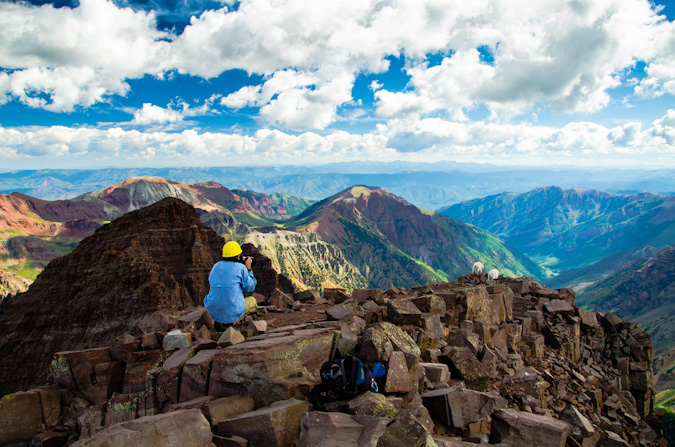
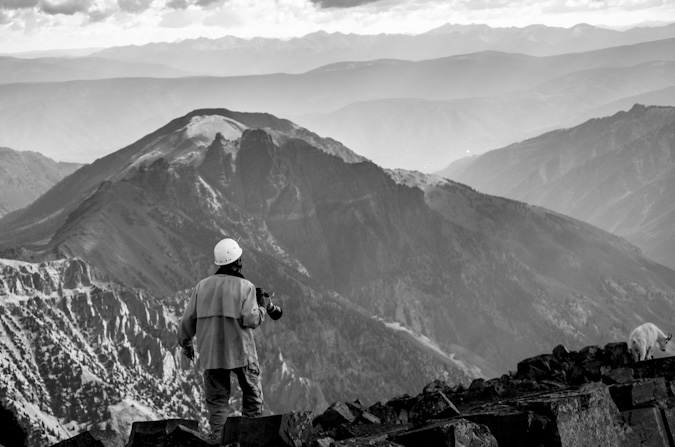
I took so many fun shots of the goats, and I hesitated to post so many here, but they turned out so great, I had to share.
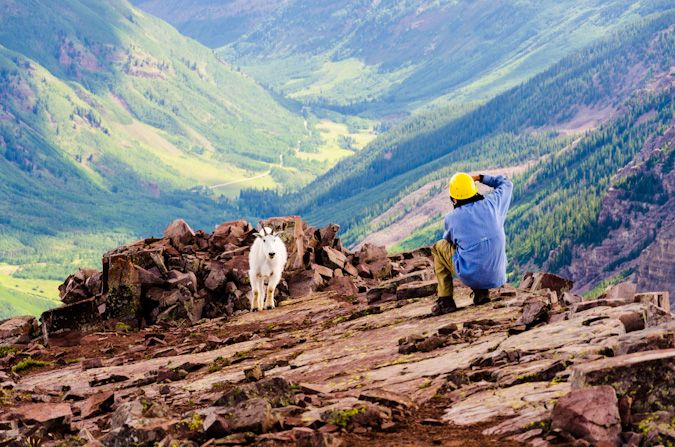
My favorite shot of the mix was this shot of this goat peering out towards Pyramid Peak, foreshadowing the day to come, where I would complete the 14ers.
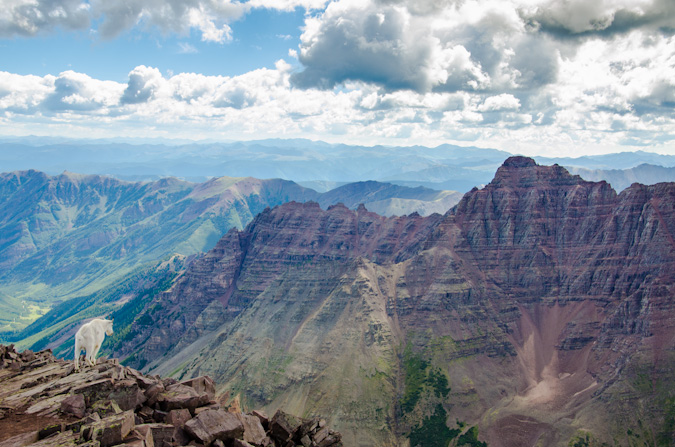
Through all the excitement, I had to stop and take some shots of Sarah and a couple panoramics.
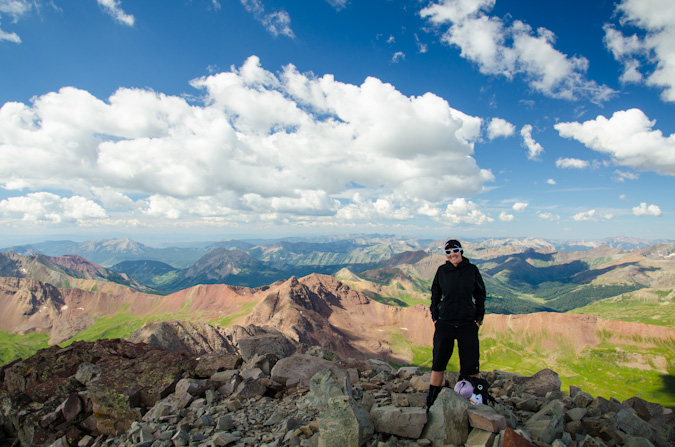
The traverse over to N. Maroon looked like a lot of fun, but it was not on the agenda.

The obligatory 360 panoramic... which demonstrated how large of a summit Maroon Peak really had... and how amazing the views around us were.

The white coilour for Thunder Pyramid stuck out like a sore thumb above Len Shoemaker ridge.
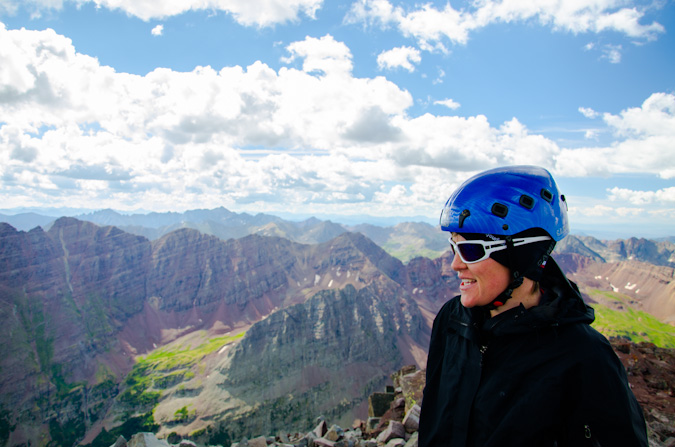
The weather began to look a little shaky after a long time spent at the summit, so we all decided to head down together. On the way down, Glenn was a really great mountaineer, concerned with safety and route selection in many of the same ways Sarah and I were. It was such an honor to spend the afternoon chatting about photography methods, gear and stories while down-climbing. I felt kind of bad for Sarah but she rolled with it and contributed a great deal to the conversation, having many stories of our mountaineering adventures to convey.
On the way down, at the earlier described gullies, we opted to go with Glenn down a different gully. I think the original gully we took on the up-climb was sturdier (the second of the two when coming up, the first of the two when coming down). Other than this small section, we sailed down the mountain’s route, eventually running into the lone guy we had encountered earlier that was waiting for his friends. Indeed, he was again waiting for his friends and explained that they were very slow and he was concerned because he said they were very set on doing the traverse between Maroon Peak and North Maroon Peak, which is very dangerous and requires a great deal of time. He asked that we try to convince his partners not to attempt the traverse based on the weather and their slow speed.
Shortly after this, we ran into the ambiguously odd duo again as Glenn tried to convey the seriousness of the traverse given their speed and the weather. They did not seem convinced this was problem for them and so I hoped that I would not be reading about them on 14ers.com in the Memoriam section (if you guys are reading, I hope you got down safely). We continued on and eventually reached the ridge safely without any issues.
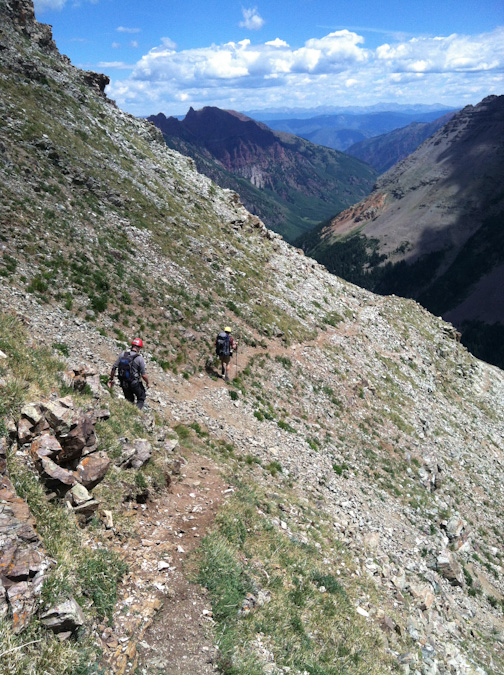
The hike down was relaxing. No threat of weather to worry about.
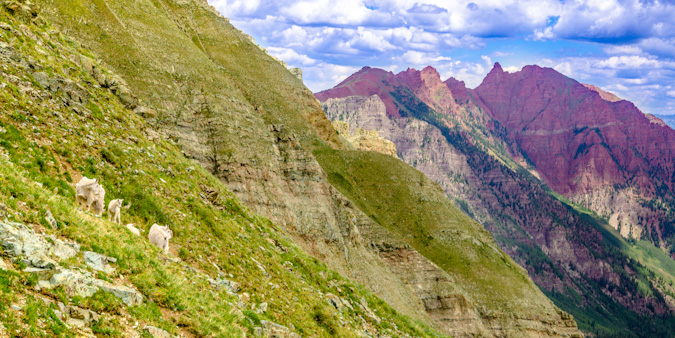
From here, we casually followed the steep trail back down from the summit, stopping occasionally to take photos of flowers and a small group of mountain goats, which consisted of two adults and two tiny baby goats (so adorable). This prompted me to wonder about the breeding habits of mountain goats and the herd consistency, so I made a mental note to read about that when I got home. I did learn that it was likely that we saw two females (nannies) with their two kids (babies) – as I learned from this almighty Wikipedia article.
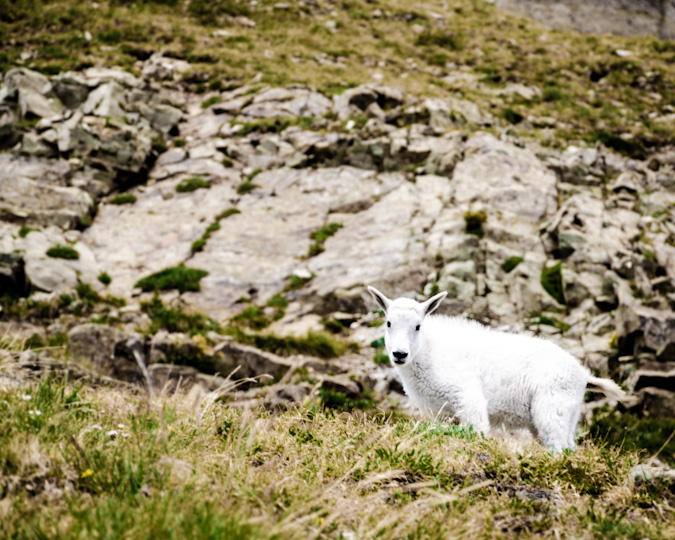
The wildflowers were so fantastic on this hike, it reminded me a little bit of the wildflowers we saw the prior year on our hike up into Lead King Basin.
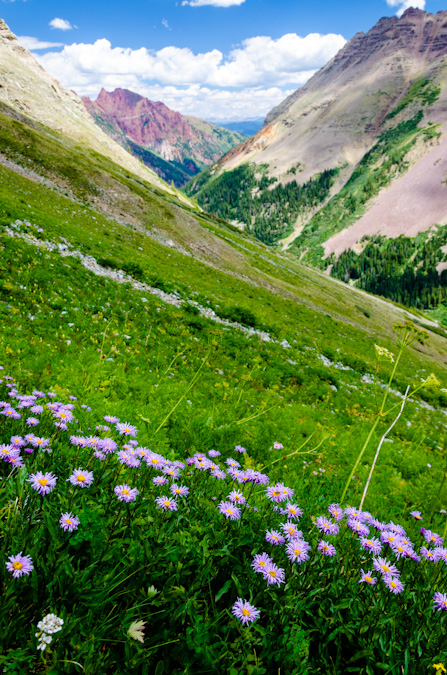
Glenn left us about halfway down to move a little faster so that he could get some rest before his epic sunrise hike. Sarah and I continued down at a decent pace and found ourselves back at camp at approximately 1:45 PM. The weather was holding quite well for the Elk Mountains, and we were starving. We cooked some food and took naps that lasted well into the late evening and eventually the night. We were certainly well rested for the next climb.
Day 4: Early start and successful summit of Pyramid Peak - 14,018 ft.
The alarm went off and we climbed out of the tent and started hiking at 4:15 for Pyramid Peak. The hike down to the lake and to the trail split off in the darkness was a fun experience as always. Once we found the turn off for Pyramid Peak, we were greeted by a couple that was heading up to do Pyramid as well. They were moving quite quickly and left us in their dust in no time at all. We were both thankful to have a really well-constructed trail to start the day on - the Colorado Fourteeners Initiative built an absolutely bomber trail up the first section of Pyramid in 2006 and it does not disappoint. The trail climbs steeply out of the valley over large boulders and is very well-maintained. Before we knew it, we were starting to get the first sunlight of the day at pre-dawn.
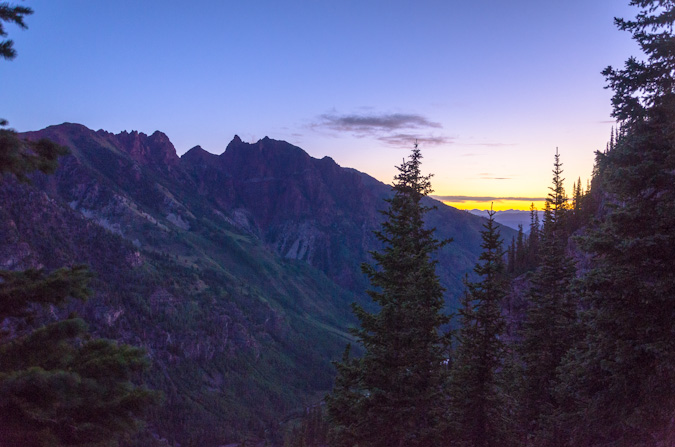
After switching back and forth up the steep slopes, the trail deposited us at the base of a giant boulder field, nick-named the "Ampitheater" due to the fact that it has three of its four sides surrounded by steep sections of Pyramid Peak.
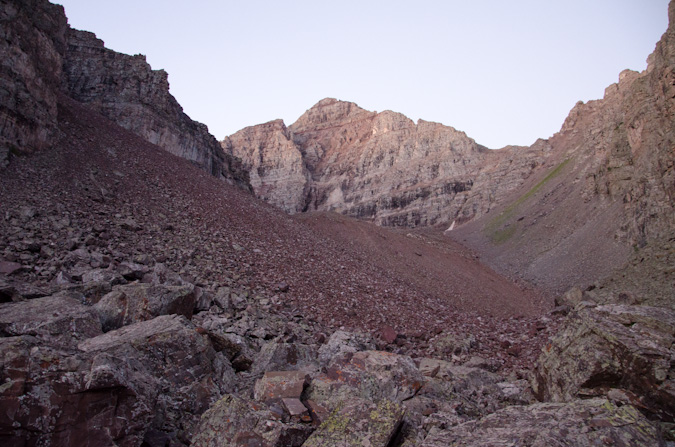
As we rose up the Ampitheater, the views to the north became better and better, with the soft light of sunrise illuminating the surrounding peaks.
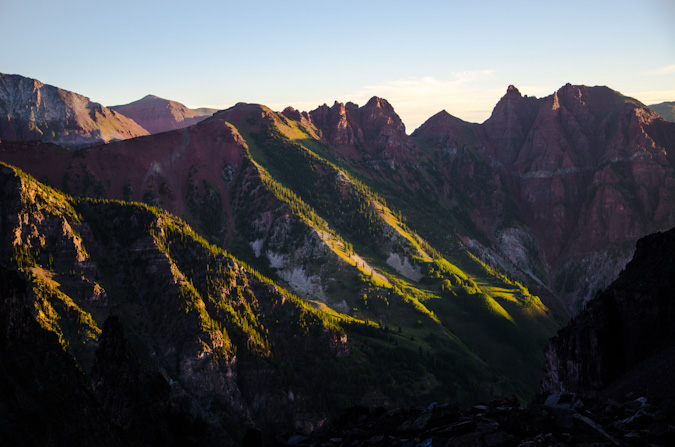
Eventually, we reached the top of the Ampitheater and were greeted with our next task, climbing up a very steep scree and dirt gully to the ridge. We were both overcome with glee over the prospect of such fun hiking (just kidding). Fortunately, the views behind us were starting to get good, with Snowmass Mountain and Capitol Peak poking above the ridgeline in the Ampitheater.
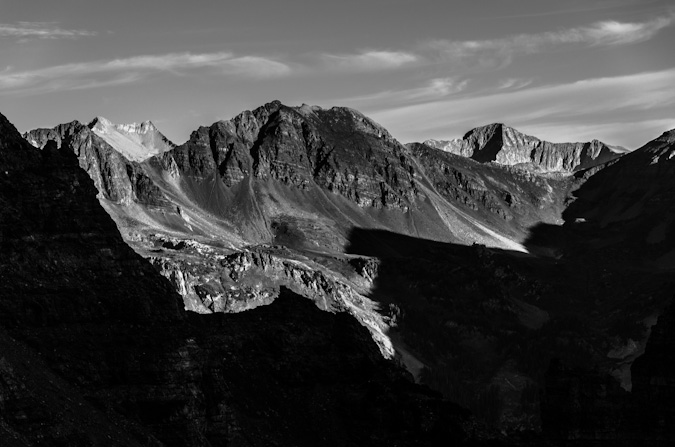
In addition to this, the clouds above were looking phenomenal, and the Maroon Bells were beginning to poke up above the ridge too.
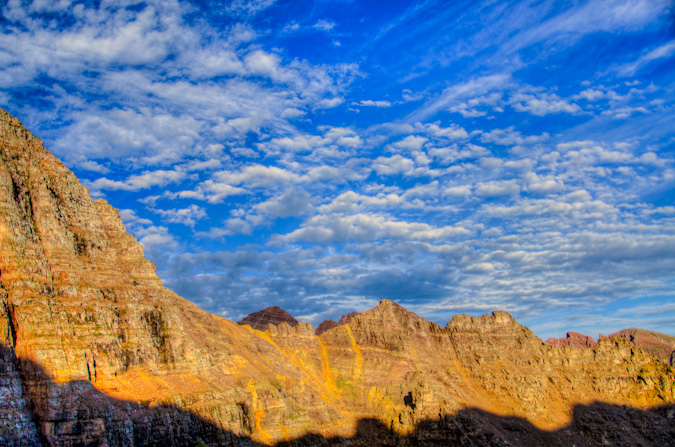
The hike up this section was gruelling to say the least. It was steep, loose and unrelenting. The occasional break to look back was worth the climb though.
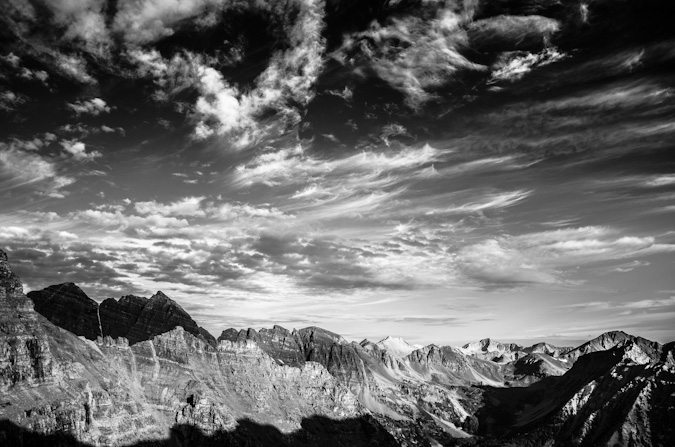
At last, we reached the top of this devilish section of climbing and our day's objective finally came into view for the first time. Pyramid Peak erupted above us like some freakish volcano. Here's a groovy photo with all of the mighty Elk 14ers in view - Pyramid, Maroon, North Maroon, Snowmass and Capitol. 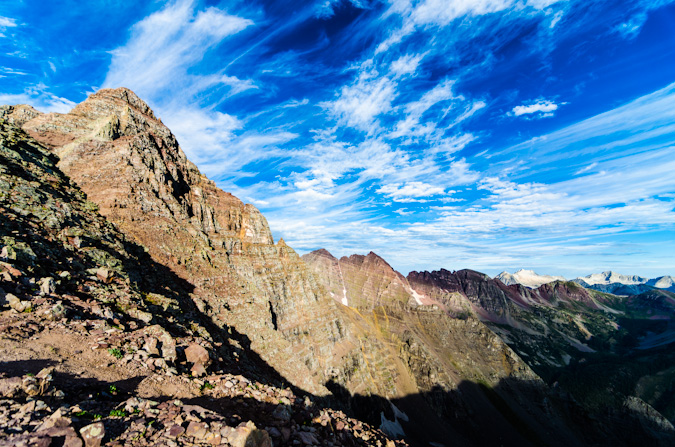
Sarah and I stopped for a bit at the top of this section to rest, eat and study up on the route. Sarah enjoyed what had become her signature staple food of the trip - PB&J on a hot dog bun. Yep. 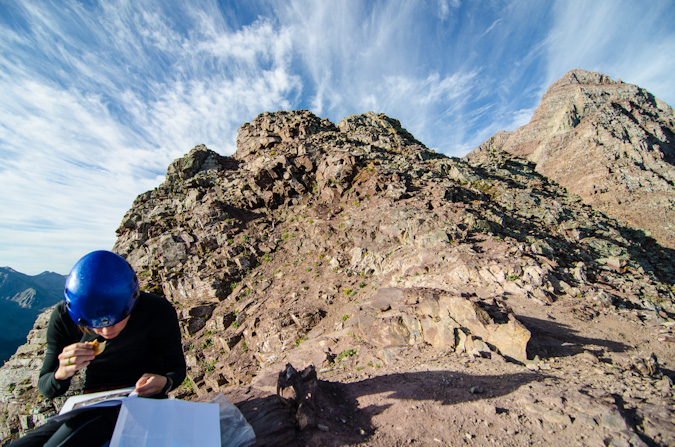
The clouds continued to provide a very dramatic feel for the whole morning.
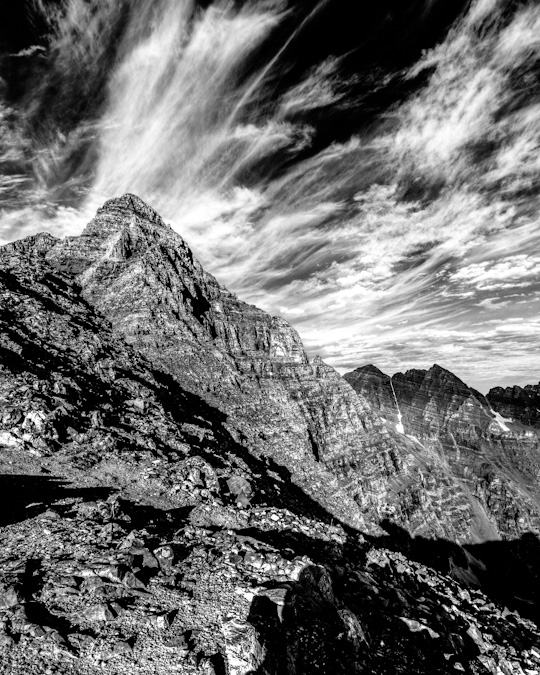
After a short rest, two climbers joined us on the saddle - they were named Doug and Martin and asked to join us for the rest of the climb so that we would not kick rocks down on each other. This seemed like a great plan to us; although at first glance, Sarah and I were both a little taken back by Doug's bicycle helmet. Fortunately, it turned out he would be one of the safest climbers I've been with.
Doug snapped off a group photo for Sarah and I and we departed for the difficult section of the climb.
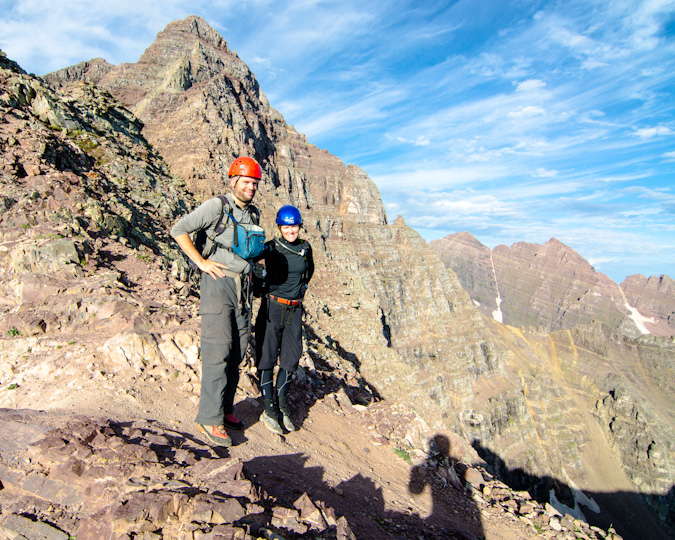
The route was quite obvious for most of the remaining part of the climb, with several cairns and a clear trail in many sections. At one point, we found ourselves at a section that was a huge crevasse in the trail, which totally reminded me a photo I remembered seeing of my dad when he climbed Pyramid Peak. Indeed, the crevasse was jumped by me both up and down. Here's a photo from the 1980s of my dad jumping a similar crevasse.
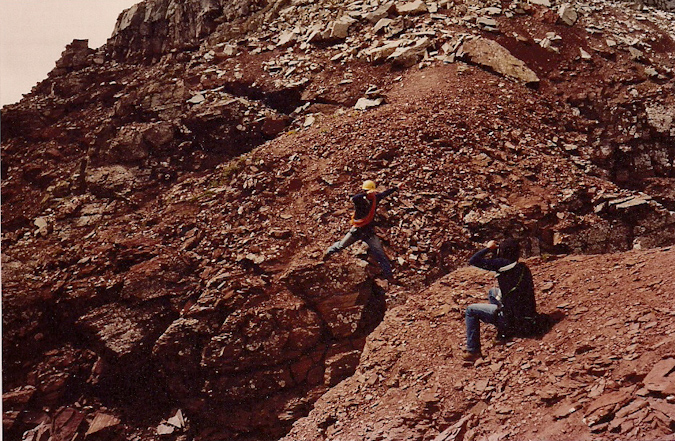
We reached the infamous "ledge" which proved to be a challenge with my camera bag affixed to my chest. Sarah captured this photo of me being quite relaxed while crossing, with camera in hand.
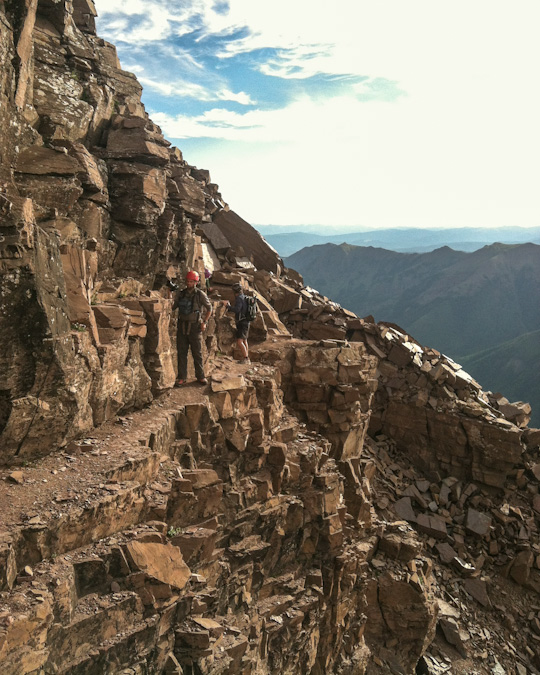
I had the camera out for a reason though, as I wanted to get a closer shot of Doug and Martin crossing this awesome section.
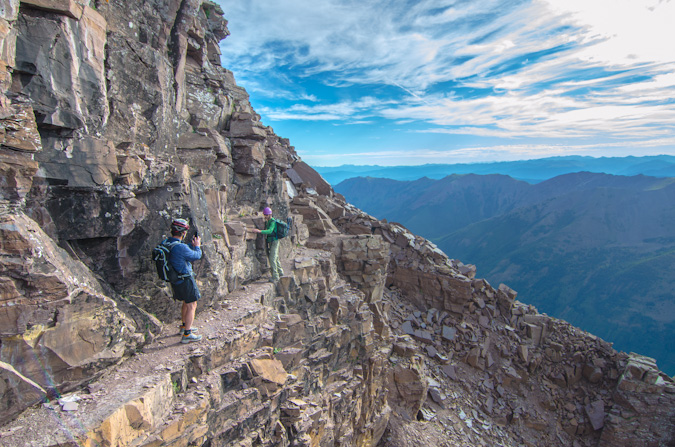
At last, we reached the infamous green gully, which turned to be the most enjoyable section to upclimb. It was quite solid and easy going, with little to no loose rocks to contend with. It was very steep though, and a miscalculation would prove fatal. Climbing to the top of this section was quite a lot of fun.
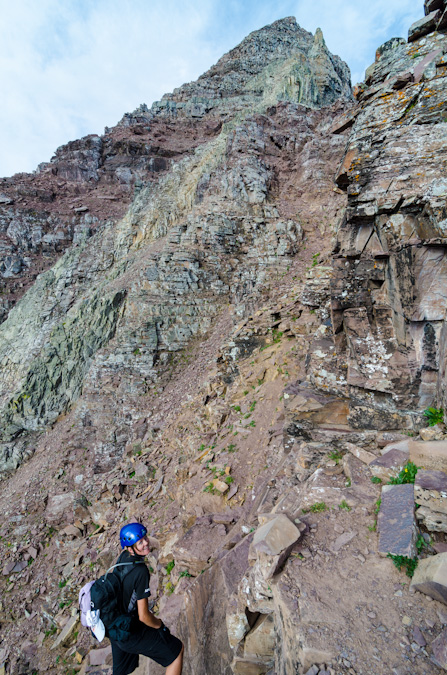
We then reached what many consider to be the crux of this route up Pyramid Peak, a section where you can choose between a very exposed class 3 section or an unexposed but more dangerous class 5 section. Coming down from this area were the two climbers we met earlier in the morning near the lake - they had already summited and were coming down, so we waited for them before continuing. As a group, we had a nice discussion about the route and the other two climbers departed.
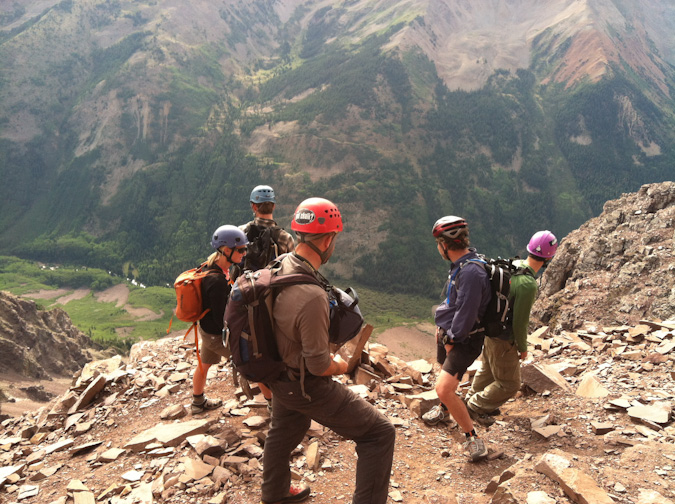
The crux move was spicy but nothing too hard. I thought the summit block on Mt. Wilson was harder and more exposed for sure. The rest of the climb was as simple as weaving our way up cairned sections of ledges. Before we knew it, we were on the summit. Sarah was up first and captured a photo of me summiting my last 14er.
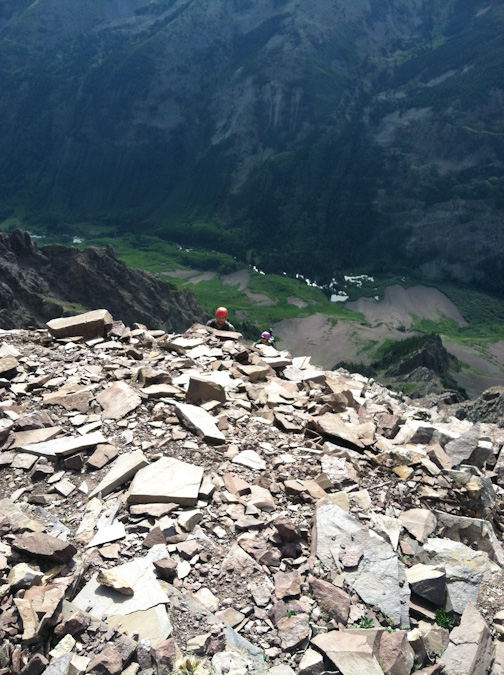
As I reached the top, I took one last look back behind me at the east Elks - they looked so good.
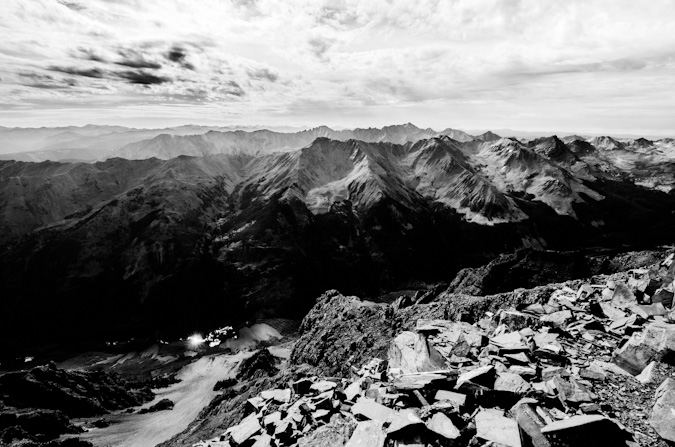
The feeling was surreal, exciting, sad, happy and relieving, all at the same time. It was a flood of feelings for sure, but they were all welcome feelings. I felt like I had accomplished something quite remarkable (even though thousands have done it before me). Perhaps it had something to do with the length of the time it took to finish, or the length of the time I had had the goal. Either way - it was pretty darn awesome! Sarah gave me a big hug and then dropped a huge surprise on me. She prefaced the surprise with the something like the following words, "Angela wanted me to give this to you when you got to the top... I ensured it was not a divorce letter or anything like that, but don't shoot the messenger!"
She then handed me a white folded envelope with my name on it. Inside was the most thoughtful, humorous and loving message I could ever ask for from my wife. Sarah said, "she said you might cry." Which of course, I did a little.
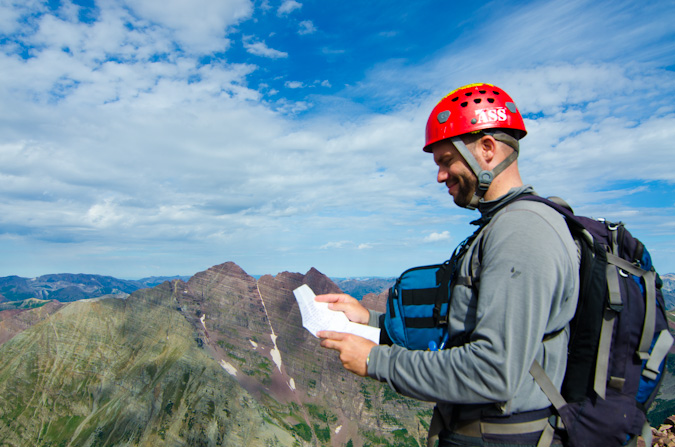
Sarah and I celebrated the amazing day and basked in all of the glory that I knew would come from the views from Pyramid Peak. It was the perfect mountain to finish on. The views of the Maroon Bells, Len Shoemaker ridge, Snowmass Mountain, Capitol, Castle, Conundrum, Cathedral and the rest of the killer Elk Mountains were absolutely surreal and wonderful.
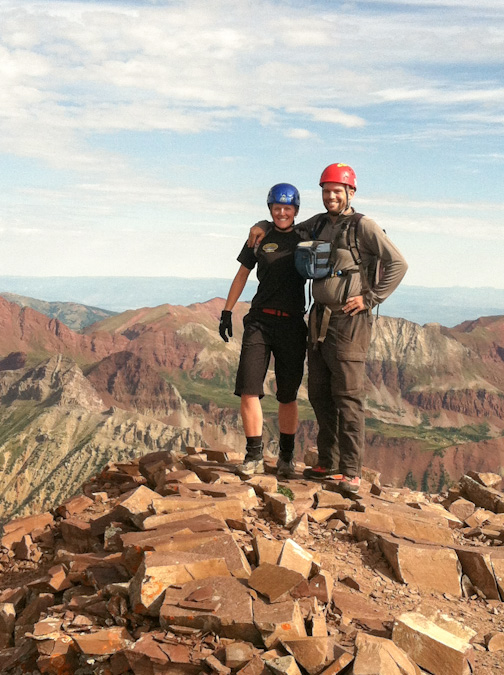
The famous Pyramid Peak diving board was a very inviting spot for photos, and Sarah decided to go surfing. I did an HDR and a non-HDR of this, for fun. You can mouse-over or click to see the non-HDR version.
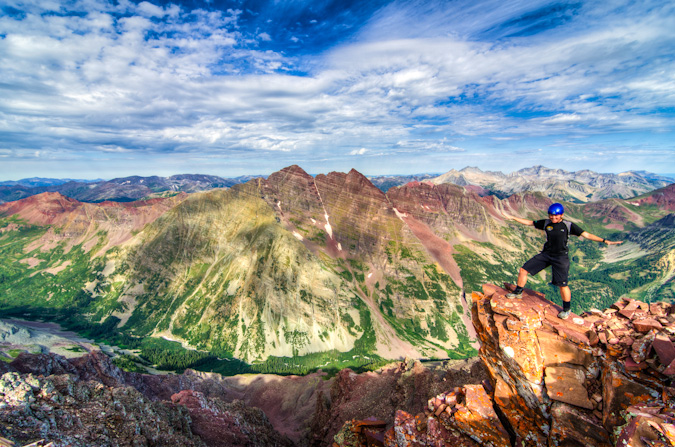
...and my celebratory pose!
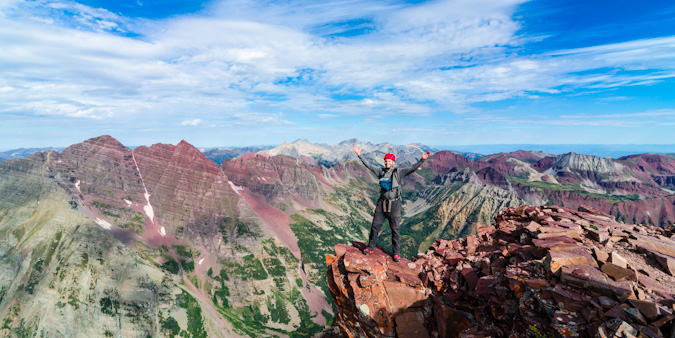
It felt like a small little party up there, spirits were high, weather was looking good, and the views were to die for.
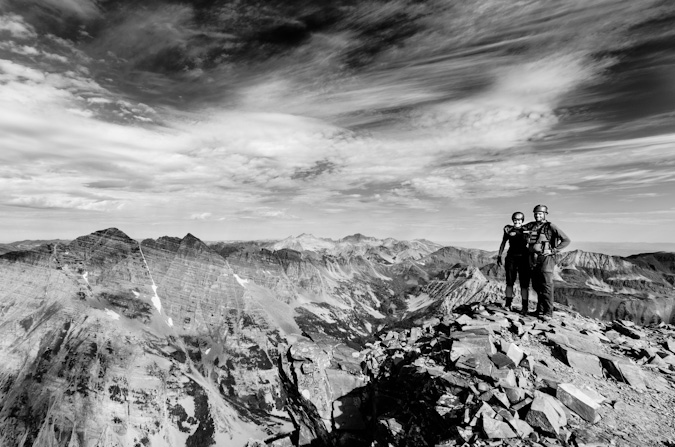
After some food, I fired off a 360 degree panoramic from the summit. One of my favorites to date.

The same 360 degree pano made for a wonderful planet too... for more on those see this article...
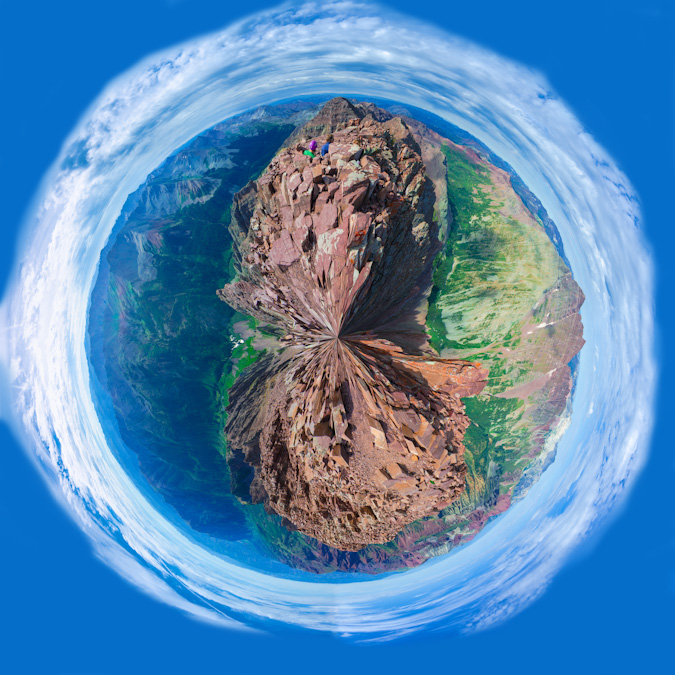
One of Sarah's more awesome traditions is that every Friday she wears a tie and takes a photo of it. This Friday would be no exception!
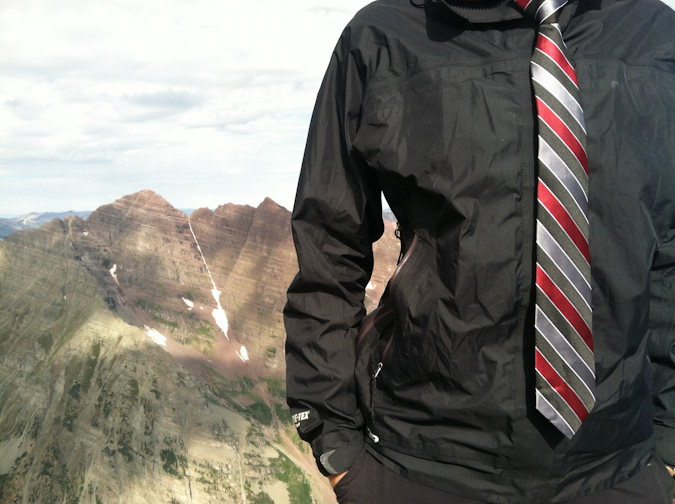
Weather was starting to build to the west, so we decided to start to pack up our stuff. I still was in awe of the sheer nature of the valley below - how steep the walls were, how amazing the features of the rock were. I'm not religious at all, but this is as close as you can get to a religious experience.
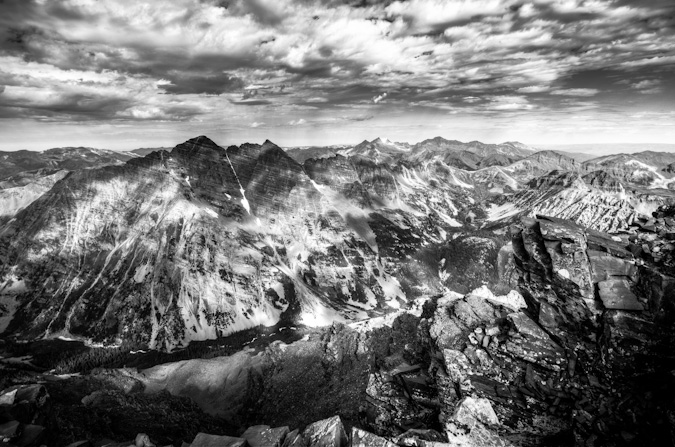
Before we left, I wanted one more parting shot from Pyramid with the USGS marker.
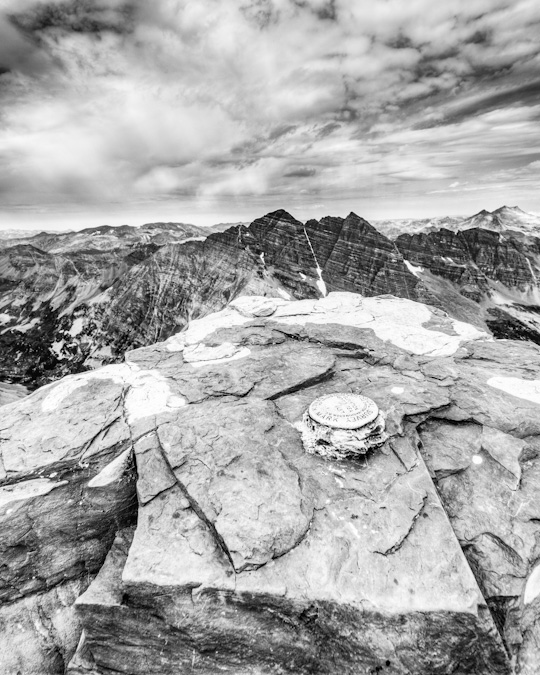
Downclimbing Pyramid Peak was slow going. It always feels much more awkward to downclimb the steeper terrain and Pyramid was no exception. Our group took special care not to dislodge any rocks onto each other and we staggered our decents and ensured we were each clear of a run-out section before the next person started. It was pretty fun climbing though.
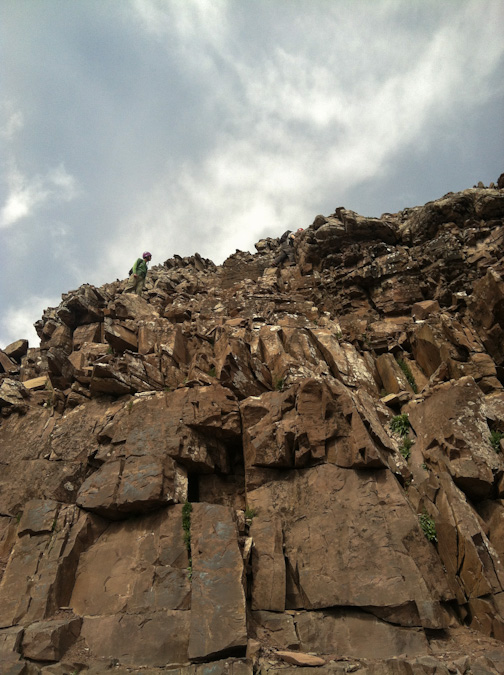
Pyramid was one steep mountain, with lots of loose rock to beware of.
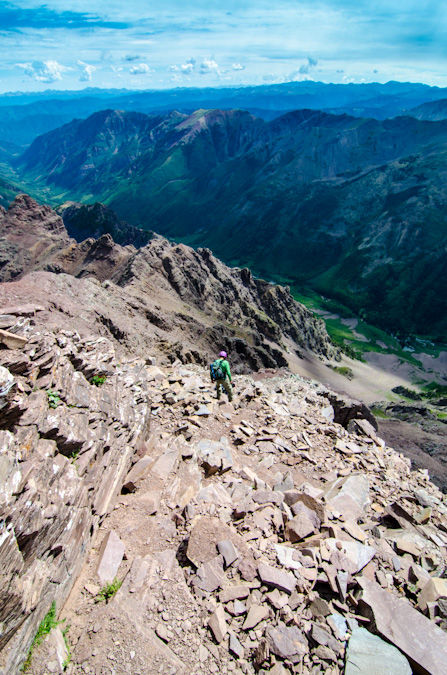
I was still amazed at how rugged the terrain was on Pyramid - it looks so unclimbable from all directions, and even when you're up there it feels quite surreal.
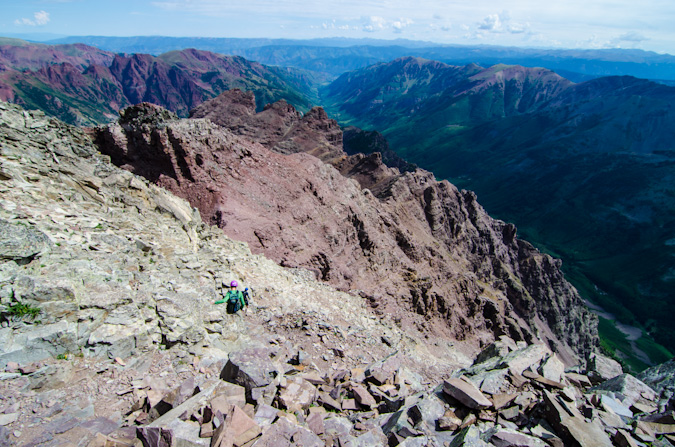
The slowest and most challenging part of the downclimb was the green gully. We took turns decending into sections and just as we reached the bottom of it, small rain drops started to slowly fall. We had made it through the hard sections just in time.
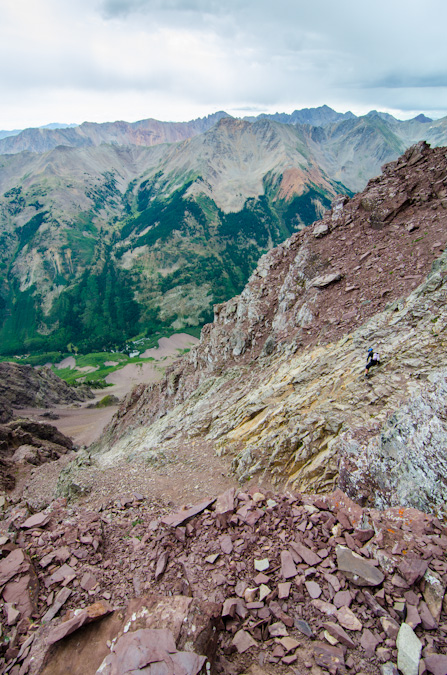
Luckily for us, the rain lasted only a short time and we were able to reach the saddle quickly and safely. Upon arrival, we were greeted by a lone mountain goat, who was probably licking up the urine others had deposited there earlier in the day...
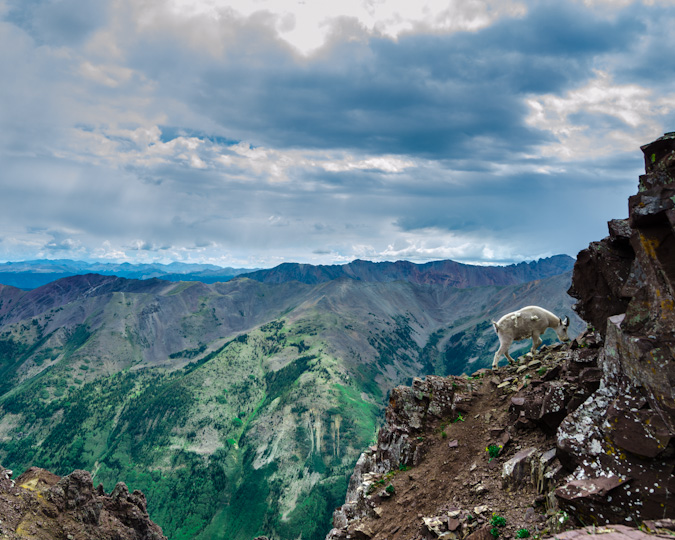
This mountain goat was quite photogenic and decided to pose just for me on the rocks above.
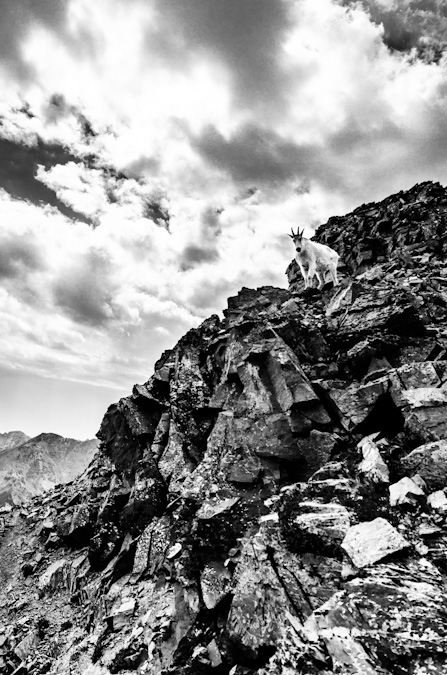
After enjoying the company of the goat, we decided to head on down the most wonderfully exciting and enjoyable dirt and scree fest that was the descent off of the ridge back into the Ampitheater. We both ran out of water at this point and decided to hoof it down as fast as we could, with plans of heading on out of the valley that evening. The thought of a celebratory meal in Aspen was too much to pass up. Once out of the ampitheater, the CFI trail down was quite solid. I could not really imagine how awful this trail would be before this work was done. I took one final parting shot of the Maroon Bells on the way down Pyramid.
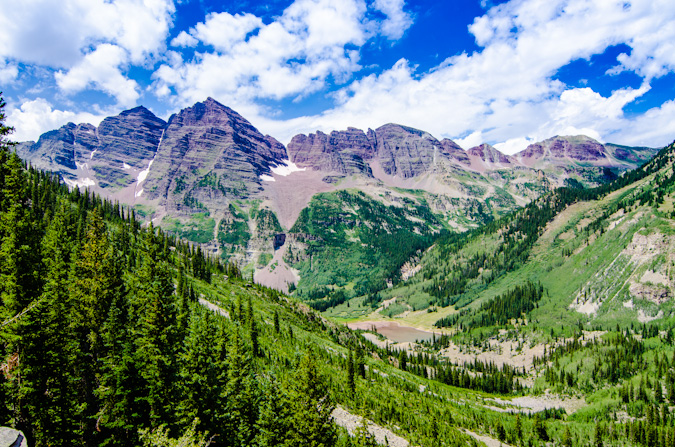
Sarah snapped off one last shot of me hiking back to camp. This is one happy dude.
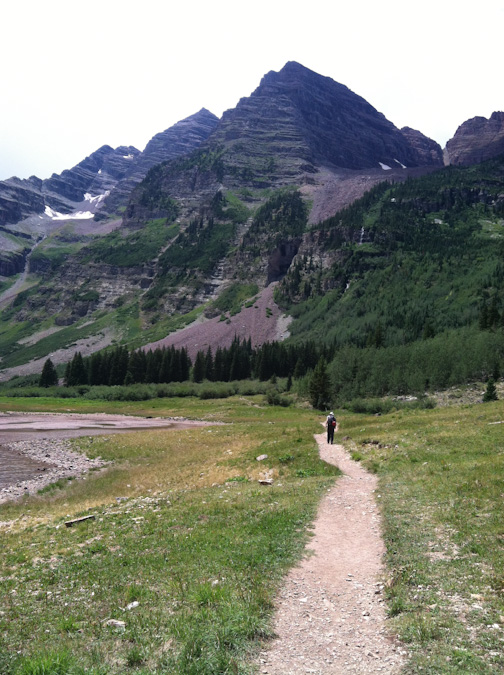
We got back to our campsite and packed up after refilling our water. Our legs were tired. Our souls were refreshed. It was time for beer and pizza. We headed out and I took one final "classic" shot of the Maroon Bells from Maroon Lake with the "Deadly Bells" sign. "DO NOT ATTEMPT IF NOT QUALIFIED."
I'm not sure if I was qualified or not, but I felt greatly accomplished and quite humbled to have experienced them either way.
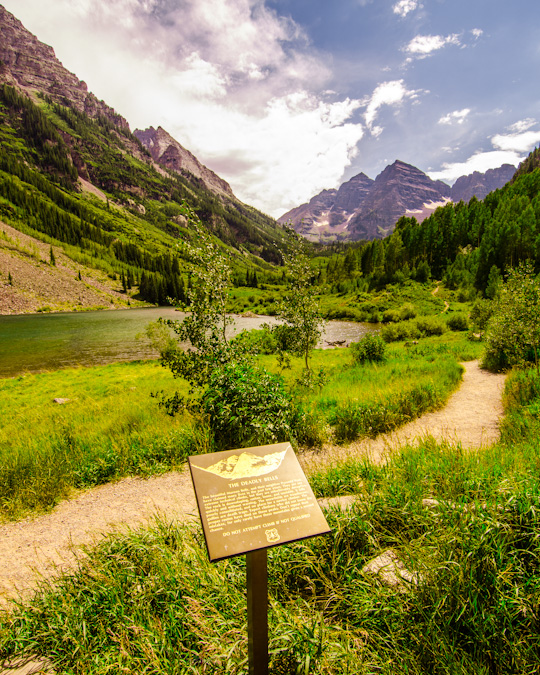
A final look at the route map. Click on it for a larger version.
We decided on a restaraunt called Mezzaluna in Aspen for our celebration dinner. I had a vegetarian pizza (did I mention I'm a vegetarian) with truffle oil and Sarah had a sausage pizza. Two margaritas were served and congratulations were in order.
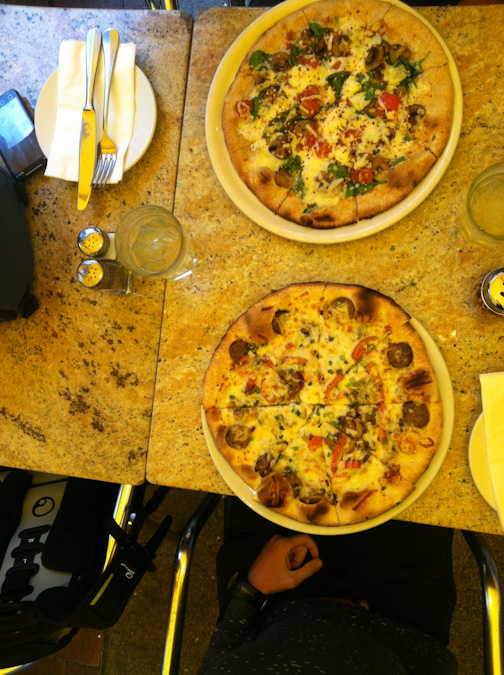
After leaving Aspen and dropping off of Independence Pass towards Buena Vista, we were greeted with a rare double rainbow, which capped off our most excellent trip in fine order. I could not have asked for a better trip, partner, or experience to finish the 14ers.
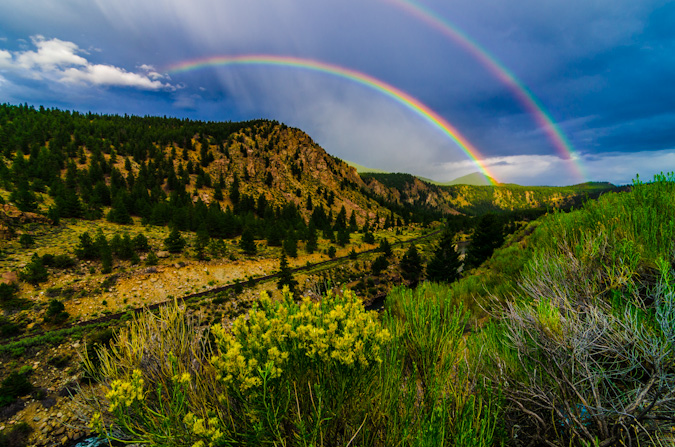
Conclusion and acknowledgements
A goal that takes 27 years to complete is one worthy of relishing, reflection and sincere acknowledgements to those that helped make it possible.
After fracturing my L5 vertabrae in 1995, I was not sure if I would ever be able to realize some of my goals. Fortunately, through hard work and incredible support from my family, I fully recovered from that and learned a great deal about work ethic. This quest for the mountains has tought me so many valuable lessons about life, about people, about myself...
Most importantly, it has taught me that despite people having severe differences of opinion on matters such as religion, politics or otherwise, something like the great mountains of Colorado can bring those people together to share in life-changing experiences that bind people unlike any other force. I hope to build on those lessons and continue to better myself as a person - my friends and family know there is plenty of room for growth.
To Sarah Musick: Thank you so much Sarah! It was such an honor to share those last two summits with you - you have been a true inspiration to me and my quest to finish. Your support over this past year has been fantastic. You are truly an amazing human being.
Of course, an achievment like this is never possible without the support of others, who are for sure some of the finest people I've had the pleasure to meet.
1. 1st - to my wife, Angela Payne (one fine Vegan chef with a killer sense of humor) - who has given me more support than I ever could have asked for - allowing me to chase my dreams is the best gift a person can give!
2. To my parents, they have been an inspiration for this life-long goal and I would have never have started without them introducing me to the mountains of Colorado at such a young age. My dad's goal to complete the highest 100 began in the 1970's and it quickly became my own goal as well.
3. To my family’s close friend – Dave LeShane – who also was on the quest for the highest 100 when I was a child – and inspired me to dream for the stars while climbing various 13ers with me as a child. Your wisdom, guidance and support over the years was like having a super-awesome uncle with bad-ass climbing stories.
4. To my regular climbing partners - Sarah Musick, Ethan Beute, Jeremy Park, and Regina Primavera (Yalegirl09) - you guys have been absolutely awesome to climb with! Your support, humor, talks, patience, insight and overall awesomeness has grounded me and reaffirmed my faith in mankind's future.
Sarah - you are one of the most amazing people I've ever met - our short but fantastic friendship has been such a blessing for me.
Ethan - our talks and hikes are always some of my most enjoyable days and most memorable experiences - I hope we can continue what I believe to be an incredible friendship!
Jeremy – while we have not done any 14ers together, we’ve known each other since high school and have been amazing friends ever since. Our epic adventure on Vestal’s Wham ridge will always be one of my fondest moments in my life!
Regina - you are one crazy, amazing and true friend! Our hikes are always a great time and I have enjoyed our talks!
5. To my other climbing partners, mostly from 14ers.com –
Terry Mathews (tmathews) - it was so great getting back into climbing with you back in 2009. Our adventures and introductions to class 3 on Crestone Needle, Crestone Peak, Blanca, Ellingwood, Kit Carson and Challenger were fantastic.
Micah (mountainmicah83)- dude – our epic day on Harvard and Columbia will never be forgotten - while I had hoped we could get out more – it was still awesome to learn rope/climbing skills from you and Matt!
Mike Vetter and Travis Arment - what can I say Mike - anyone who would drive all the way from South Dakota to climb Huron Peak with me is one awesome dude. Our adventure up Capitol Peak with the accomplished Travis Arment was unforgettable. You guys are fantastic people.
Barry Johnson (Johnson) – our climb of Shavano in 2009 was my re-introduction to the 14ers after a long hiatus – thank you for joining me on that fantastic day!
Mike (fiemus) and Bob Hay – our hike up Yale was great – learning about all of Mike's SAR stories was one of my favorite days in the hills.
Kara Bauman, Will (WillV), Alli Kolega and Tom Shaar – our climb of Mt. Wilson was absolutely wonderful! Thank you for allowing me to join you guys on such a fabulous adventure!
6. To Bill Middlebrook for creating and maintaining 14ers.com – it has been very helpful for me in this crazy pursuit.
7. All the other awesome mountaineers, climbers and hikers in this community - we need to continue to focus on our common goals and dreams.
Thank you for all for the inspiration to write these, and thank you for reading...
{fcomment}
Drinking in the Milky Way and Crushing Centennials - UN 13,832 and UN 13,811
UN 13,832 and UN 13,811 (UN = Unnamed) have been on my radar for quite a few years now. My dad and I were hoping to tackle them both back in 2009 but weather steered us elsewhere. I've also eyed them as a potentially fantastic winter climb from the Williams Creek TH, but have not had the ability to string together the time to pull that off either. So, when I figured I had the opportunity to take a vacation day and do some climbing, I quickly picked out these two gems. I coached my son's first t-ball game and then afterwards drove to Lake City for an estimated 1 AM arrival at the trailhead. I planned to meet my friend Regina there (she was coming down from Denver via Highway 285) and get a few hours of sleep before we set off to climb early Friday, June 1st.
Interestingly enough, UN 13,832 and UN 13,811 are the only two mountains of the highest hundred peaks in Colorado (Centennials) with neither an official nor unofficial name. These two fantastic thirteeners (ranked #90 & #99 respectively) are located just east of the 14ers Redcloud and Sunshine near Lake City, Colorado. If you're like me, you are wondering why these two mountains in the highest 100 are unnamed. These unnamed mountains are located within a large section of BLM (Bureau of Land Management) land, specifically, BLM's Redcloud Wilderness Study Area. According to Summitpost, "in 2004, these two mountains were "protected" from being named when the USGS turned down a proposal to christen them after two of Colorado's mountaineering pioneers, Carl Blaurock and Bill Ervin. Apparently the policy is to not approve new names of mountains within wilderness or wilderness study lands, and a competing Blaurock/Ervin naming proposal was selected for a pair of peaks in the central Sawatch Range."
With all that being said, I needed something to do to keep me awake on my drive down to Lake City... so I focused on trying to think of clever names for these two mountains. With the close proximity to Sunshine and Redcloud, I figured it might be fitting to name UN 13,832 something to do with the moon. The sun shines, then it sets... the clouds get red (Redcloud), then the moon rises. How about "Moonrise" for UN 13,832 and "Not Last" for UN 13,811 (since it's ranked #99 / 100)? Let's see if they stick anywhere.
Speaking of the moon, on the way down to Lake City, I decided that it would be pretty awesome to stop near Lake San Cristobal and get a shot of the stars and moon, so that's just what I did. I stopped right off the road heading towards the trailhead and took a 5-shot vertical pano (my camera was vertically orientated vs. horizontally oriented) of the Milky Way, moon, and Lake San Cristobal. I think it worked fabulously! Please click to see a larger version or to purchase on my photography website.
With the shot I had envisioned complete, I continued on up the road towards the trailhead. I finally reached my destination at around 12:45 AM and decided it was suitable to sleep under the stars in my sleeping bag, so I set out to do just that. Shorly after I settled in, Regina arrived and set-up her gear to do the same. I took the time to take one last set of photos (why not). This one turned out even more magical, I think. It is 7 veritical shots as a panoramic of the Milky Way over "Sundog," the 13,432 ft. mountain connected to Sunshine Peak's north ridge. The moon had just set and allowed for a great scene. I was actually inspired by another photographer's (David Kingham) photo from last month and wanted to give this a shot. Click on it to see a larger version on my photography website.
We crashed at 1:45 AM and decided to set the alarm for 5:45 AM, which came all-too quickly. There was one other hiker at the TH that started before us (and did wake me a few times by starting his car), so solitude was looking to be guaranteed. I promptly threw down some coffee soymilk (which was surprisingly good and filling) and we departed! I knew from the get-go that I wanted to do what Roach calls "Point Fever," which is to say, combining UN 13,832, UN 13,632 and UN 13,811. The route is a long but easy 12.8 miles and gains 4,727 ft. in elevation. A nice leg burner. [Colorado's Thirteeners - Roach & Roach, pg. 222]
Here is a map of the route we took from the Silver Creek TH (click for larger version):
So, that's just what we set-out to accomplish. The semi-early start granted us a nice view of Handies Peak and Whitecross Mountain across the valley. It was really great seeing them from this side since my climb of them with my dad in 2010 on Father's Day.
As we climbed on the trail, we stumbled upon an open area with boulders. I was immediately struck with a rush of nostalgia, remembering vividly coming through that part of the trail and seeing a marmot during my climb of Redcloud and Sunshine in 1987 at the age of 9. Crazy!
Before long, we were gaining altitude and came across a nice stream. It seemed the perfect spot to test out my 9-stop ND filter, so I put it on my Tokina 11-16 lens and did a very long exposure. I liked how it turned out.
As we gained elevation, parts of Redcloud came into view to our right. It was immediately taken aback by how little snow was left. It was truly remarkable. Indeed, Colorado's state-wide snowpack levels are at 2% of normal. Very dry.
Regina was setting a nice pace for us and the weather was holding up quite nicely. I had no worries about my chances of summiting both 13ers.
Before we knew it, we found ourselves gaining the ridge between UN 13,832 and Redcloud. We had also caught up from the guy that left before us that morning.
Gaining the saddle was no problem, and the views were great from there. As expected, the other hiker turned up to climb Redcloud. Solitude was guaranteed at this point. Here's a 360 degree view from the saddle, with Redcloud at far right and UN 13,832 just under the sun.
The hike from here was just long and gentle - easy class 1 / 2 stuff. Here's a view of UN 13,832 as we approached from the ridge.
Looking back at Redcloud, with Sunshine barely peaking up over the ridge.
And finally, Uncompahgre Peak came into view for us!
Heading up towards the next saddle made for easy and fun trail / ridge walking.
I was impressed by how far apart Sunshine was from Redcloud - much further than I remember.
We finally topped out on UN 13,832 at around 10:30 AM. Regina was loving the view of Wetterhorn and Uncompahgre, no doubt.
Also awesome was the view of the Grenadiers and the Needles. Eolus, Sunlight, Windom, Silex, Guardian and others all stuck out quite prominantly. This perspective really shows you how far part Eolus is from Sunlight. Pretty amazing.
I also did not mind the great view of Wetterhorn from here. Such a cool looking mountain!
Regina decided she was not going to continue over to UN 13,811, so I fired off a few more shots, including the below panoramas, and headed off for UN 13,811. Regina was going to wait for me below the saddle of Redcloud and UN 13,832.
The San Juans are truly great.
UN 13,811 was still quite a ways off, as seen from this next shot.
I began my hike over and was constantly drawn to the view of Wetterhorn and Uncompahgre. I just loved those two mountains.
UN 13,632 was one obstacle in the path to UN 13,811, so I needed to go up and over it as well.
All while still enjoying my view...
Within about an hour, I finally made it over to UN 13,811 to complete my 75th Centennial. Pretty impressive and almost there!
I snapped off a few shots for a panorama from 13,811 also , still in shock over how little snow was truly left.
The view back over to 13,832 was sobering to say the least. I was starting to feel a little tired in the legs, so I was not really looking forward to the hike back. I did however, really enjoy the surprising view of 13,832 from here.
I headed back over to UN 13,832, which was quite the demoralizing slog. I reached the saddle of Redcloud and UN 13,832 in quick order and met up with Regina at a small tarn below Redcloud Peak. THe view of Whitecross was very cool from there.
And of course Handies and Whitecross were our guides for the duration.
Regina led the way while I snapped off this super great shot of her hiking out. I think this was one of my favorites from the hike.
We crossed over a small stream that had some wildflowers growing at it. I thought it was a nice looking scene to stop and enjoy.
Before long, we had reached treeline again and Handies was all that we could make out above the trees.
The remainder of the hike went without incident. I will say that these two mountains are pretty fun. The hike is very long, but affords welcoming views of very recognizable 14ers and 13ers in the area. Solitude is almost a given, since most people in the area are there to tackle the more famous 14ers Redcloud and Sunshine. I think you will also enjoy the hike if you choose to take it.
We stopped in Gunnison on our way home for some much needed sustanance at our favorite Mexican food place on Main St. Until next time... I hope you enjoyed this trip report!
{fcomment}
Backpacking to Snowmass Lake - A Photographic Gem
When Regina and I embarked from Colorado Springs, the plan was to backpack up to Snowmass Lake and climb Snowmass Mountain, putting me within 10 climbs of completing all of the 14ers in Colorado. Unfortunately, some unforeseen circumstances prevented us from reaching the summit of Snowmass Mountain, which I will go into detail about later on. Fortunately, there was ample opportunity for photography, and that opportunity was not passed on.
For those that follow my trip reports, Regina is a friend of mine that I met through 14ers.com and our relationship could best be described as one of two siblings. My wife is 100% cool with me hiking with another woman, and if another person asks me about it, I may just roll my eyes. Now that we have that out of the way, let's move on with the report! Regina and I departed Colorado Springs on Friday June 24th and reached the Snowmass Lake trailhead at around 8 PM. We were both very psyched about our first backpacking trip of the year, and had prepared for the many possible scenarios we were anticipating, including deep snow, an ice/snow climb, and wet weather. With that being said, we both packed our snowshoes, crampons and ice axes. I was also very excited to finally test out my brand new Lowepro Toploader Zoom 50 AW camera bag, as pictured below. The idea behind the bag is that it is held to your chest by this harness and makes your DSLR easily accesible. Time would tell!
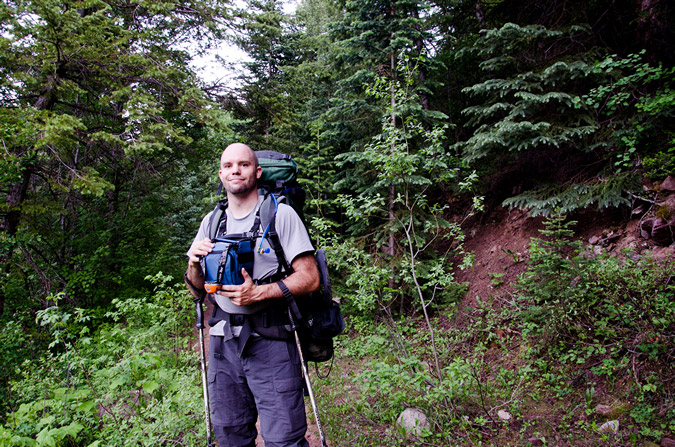
The hike up the Snowmass Lake trail (I believe it is actually referred to as the Snowmass Creek trail). takes you right into the Maroon Bells - Snowmass Wilderness Area and did not disappoint in terms of aesthetic beauty.
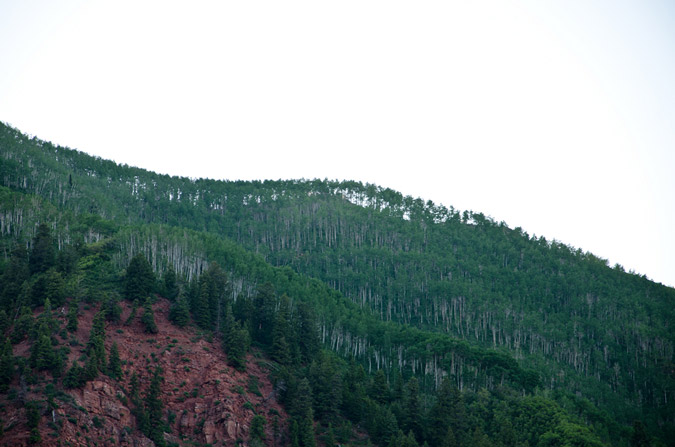
One of the things that Regina and I were concerned about was the infamous logjam crossing, where you must cross a huge stream via randomly scattered logs. This was not something we were looking forward to, given the fact that the snowmelt was particularly high this year and because we were carrying a lot of weight on our backs. About a mile into the hike, our fears of Snowmass Creek having a lot of water in it were confirmed...
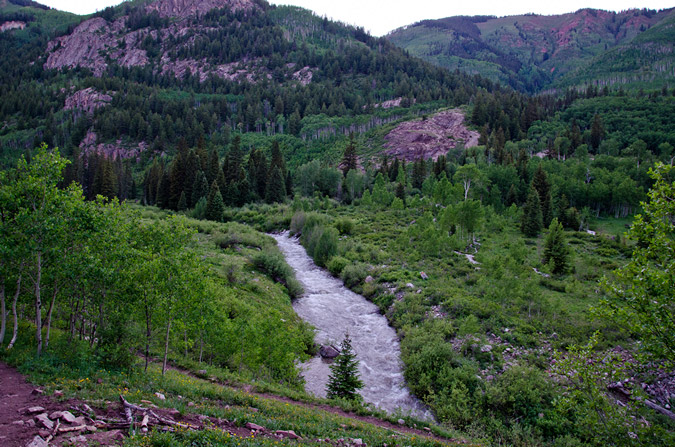
Would we be able to safely cross the logjam in the dark? The idea was quickly losing favor among the two of us; however, we kept our quick pace, which was aided by the great views of the surrounding peaks and forest.
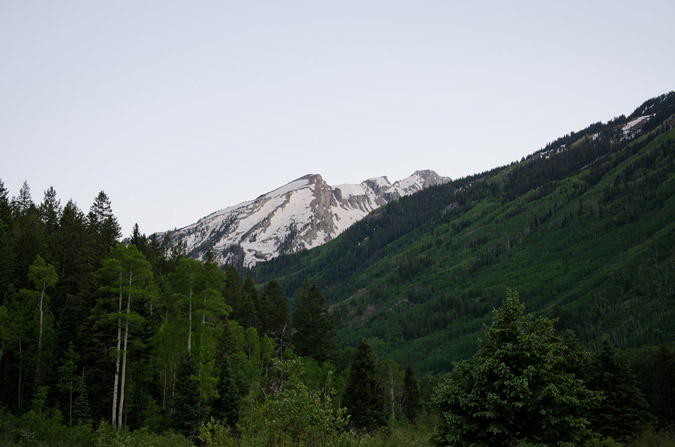
As we hiked up the trail in our heavy packs, the daylight faded quickly, and soon we were forced to employ the use of our headlamps to guide our hike.
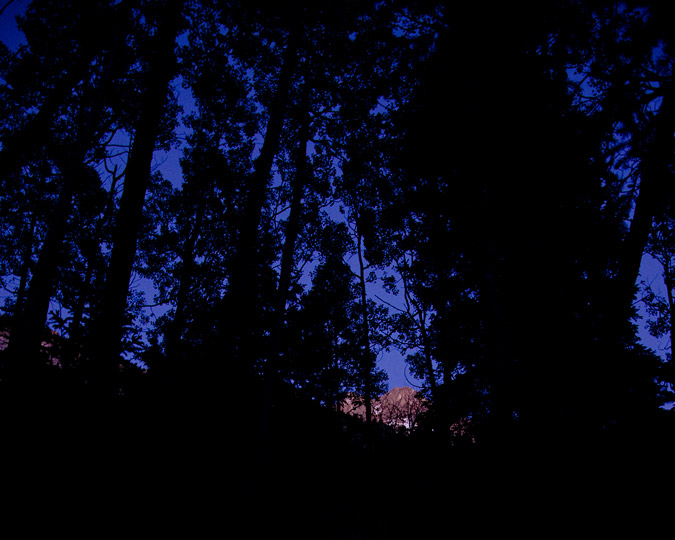
The plan was to get as far as we could in the dark before setting up camp for the night and making a go out of Snowmass Mountain the following day. From the trailhead, the lake was a good 8 miles up, which meant a good portion of our hike would be in the dark. Shortly after the sunset and the trail became dark (but before we turned on our headlamps), a dark object walked across the trail in front of Regina, which frightened us both. I quickly turned on my headlamp and discovered that it was a porcupine. We let him pass on through and continued on up the trail in the dark. Periodically, our headlamps would catch the eyes of various wildlife in the dark shadows of the night. For the most part, we identified them as deer, but given we were in the wild and it was dark, our imaginations were going in a much different direction!
After a short while, Regina began to get sick and threw up all over the trail (sorry about that to the folks that came up the next morning). Surely this would not be a portent for things to come? Regina said she felt much better, so we kept on heading up the trail in the dark. As midnight approached, we decided to stop and see where we were at. I pulled out my GPS and discovered that we were about 1/8 of a mile from the logjam - a perfect stopping spot for the night. We decided to set-up camp in one of the better campsites I've seen on any backpacking trip, right next to Snowmass Creek. Since this was her first backpacking trip, I showed Regina how to hang our food bags by nylon rope and how to setup camp.
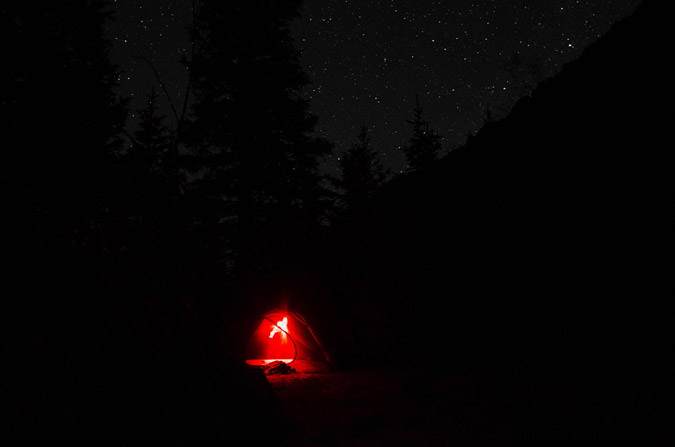
Since it was so late and because Snowmass would require crampons on hard snow, we decided the best plan would be to get plenty of rest, pack the rest of the way up to Snowmass Lake the next day, take it easy, and go to bed early for a super-early ascent of Snowmass Mountain on Sunday. We woke up the next morning at around 9 AM, listening to a group that had just came down from Snowmass Mountain talk about the logjam. They were making jokes about how the logs would sink and that people were almost falling in, etc. Was the logjam really that bad?
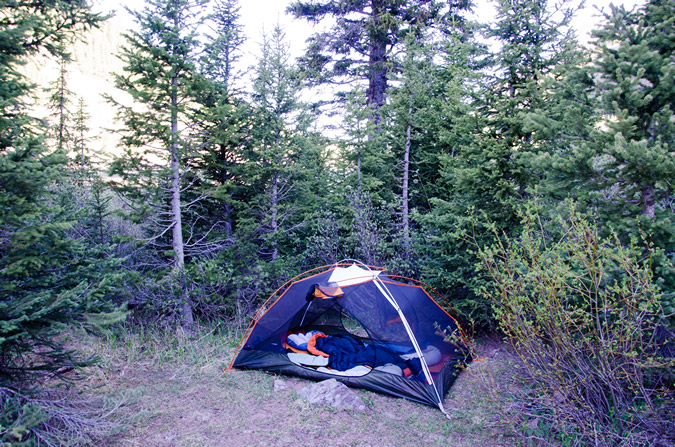
We quickly packed up and headed towards the logjam. At first sight - the logjam confirmed our worst fears - it looked incredibly daunting.
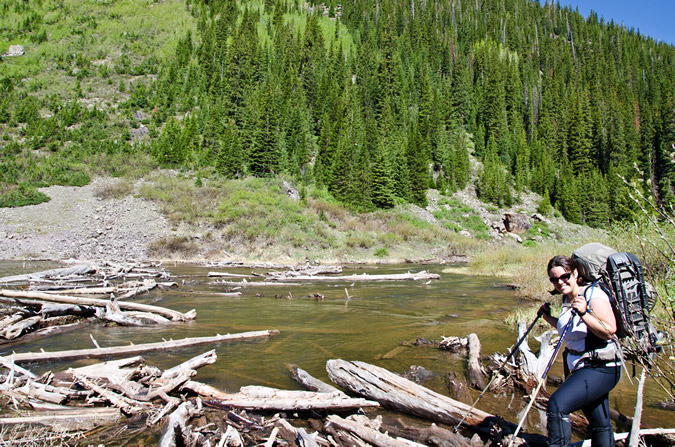
The water was about 3 or 4 feet deep in spots, and was rushing quite quickly under the logs. If the views were not so incredible, the logjam would have been a real bummer!

There was little to no consistency in the reliability of each log, and each log required a good test before we used it. Trekking poles were quite useful, but at times they gave me a false sense of security because I would put some of my weight on them when they were not secure on a log, causing me to get off balance. Care must be taken to successfully cross the logjam as it is a good 100 ft to the other side! I stopped halfway across to take a 180 degree panoramic photo to show the length of the crossing.

After successfully crossing the logjam, we quickly made our way up the trail, which followed the now wide and pristine Snowmass Creek. The whole area was like a giant beaver pond, with lakes and creeks intertwining with the beauty of the Elk Mountains at the head of the valley. The trail quickly begins to work uphill again and soon views of the pristine valley below can be made.
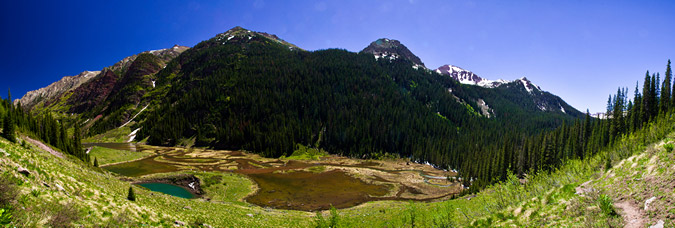
The rock in the mountainside was quite red, a clear indication that the Maroon Bells were closeby.
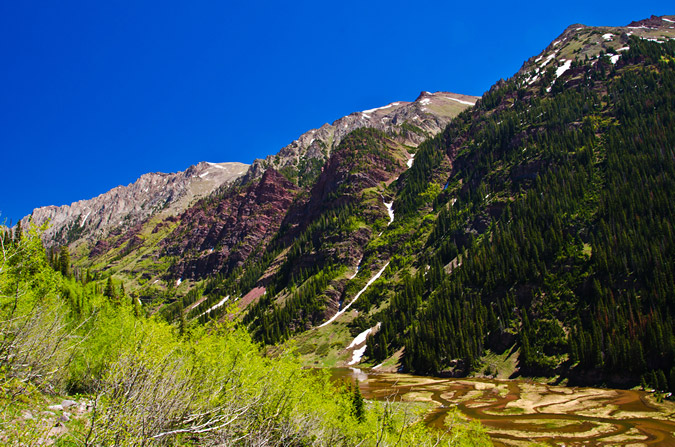
The trail quickly weaved into the trees towards Snowmass Lake above and to the east, and we were quickly reminded that there was a ton of snow in this area still. Would we finally get to use our snowshoes? Not so much - the snow as hard enough and sporadic enough that snowshoes were not required. Another trip where I packed my snowshoes for no reason! Oh well.
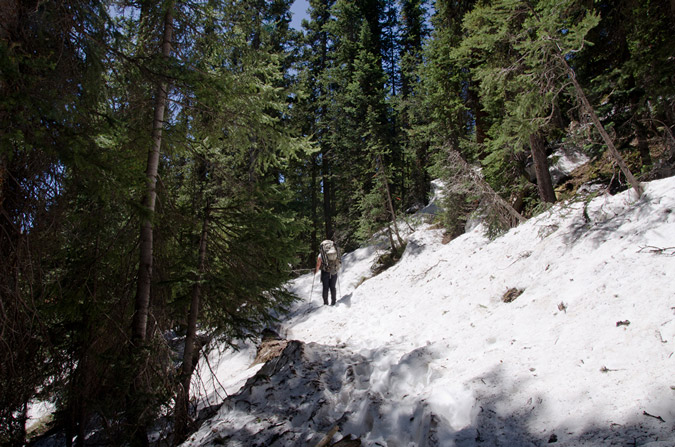
This was the hardest section of the hike, with the snow banks rising and falling throughout the trail, making travel slow and laborious with heavy packs on. Nonetheless, we arrived at the trail junction for Snowmass Lake and headed on up, following Snowmass Creek, which was quite full of water.
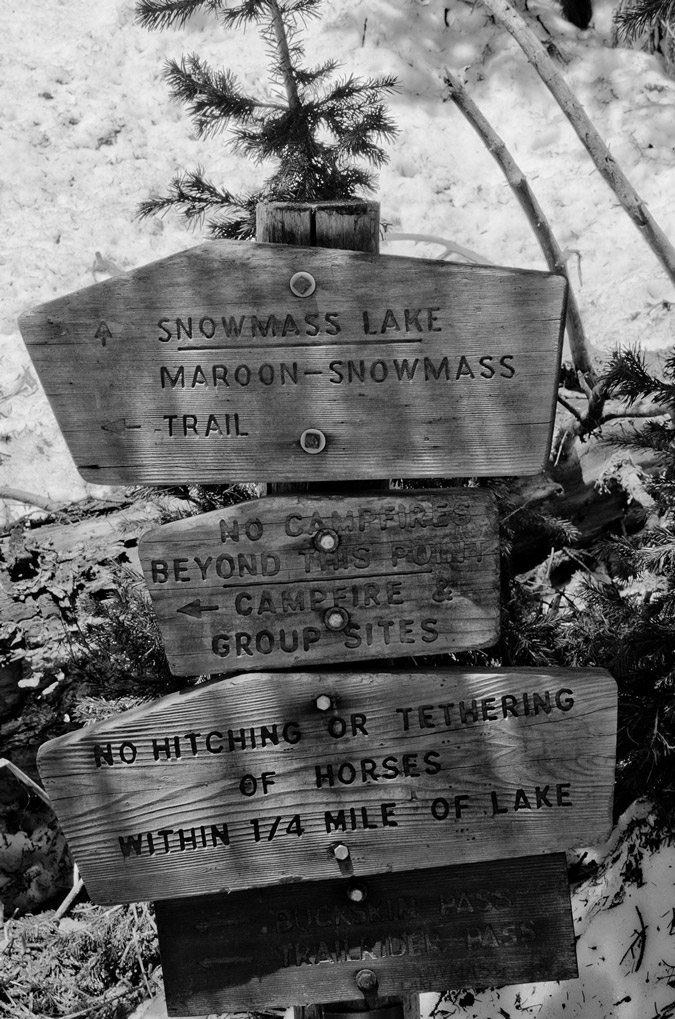
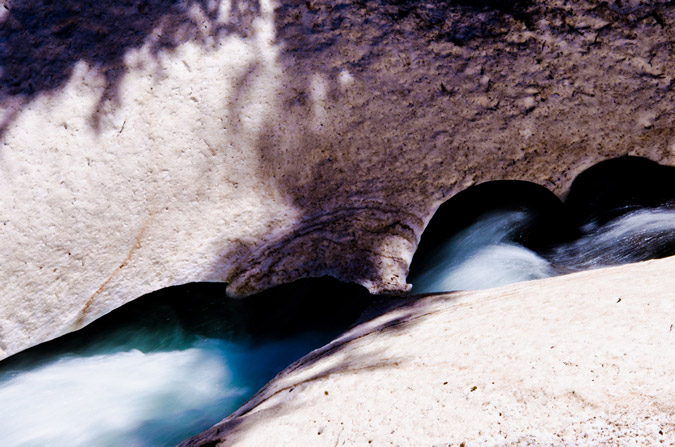
Soon, we reached a huge waterfall next to the trail, with a giant log in front of it. I decided to take a break, take my pack off, and cross onto the log to get some HDR shots of the waterfall from the middle of the log. Getting onto the log proved quite tricky, with the area around the creek full of snow and ice and dirt; however, I managed to make it onto the log without drowning or falling in. Yay for me.
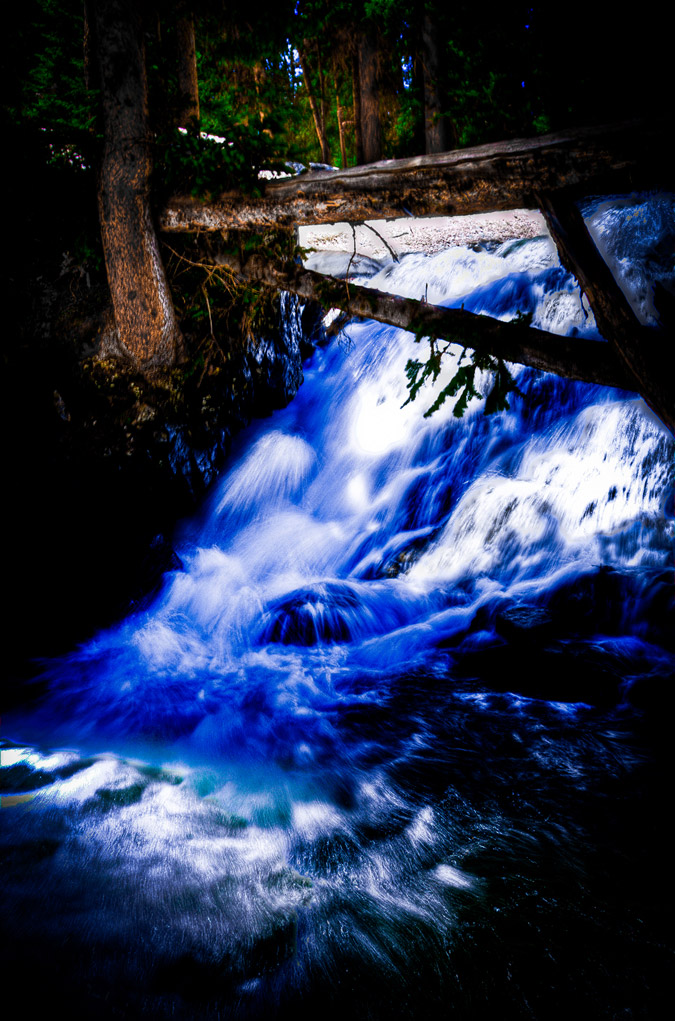
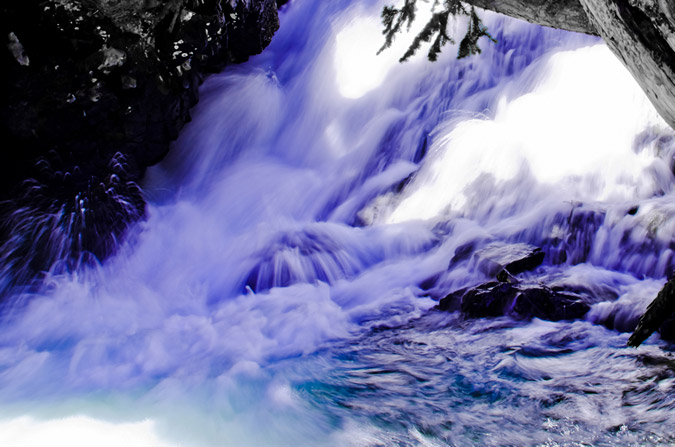
About 200 feet past this waterfall, we finally reached the head of Snowmass Creek and the first views of Snowmass Peak with Snowmass Lake in the foreground. How exciting!
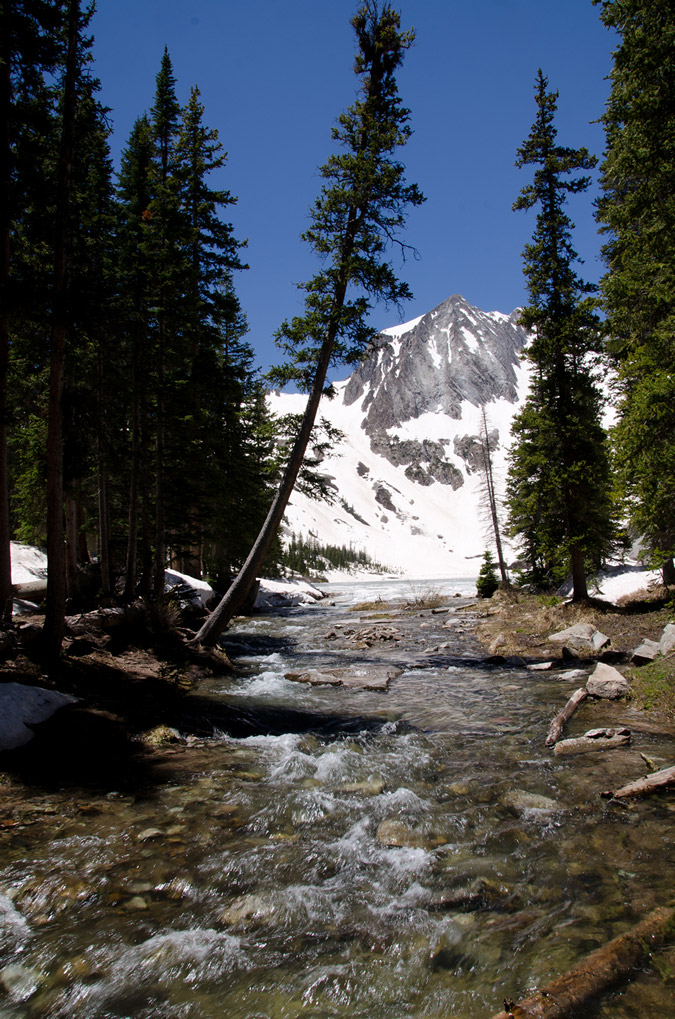
The first order of affairs was to locate a suitable campsite. Most of the area was full of deep snow, so options were quite limited. Sticking to the "100 ft away from lakes" rule proved nearly impossible due to the snow and marshy conditions. Nevertheless, we found a great spot near the lake and creek and set up for the day. It was pretty great to finally get a glimpse of Snowmass Mountain as well, which was tucked away to the right of Snowmass Peak, the lower 13er at the head of Snowmass Lake. Even better, the moon was passing just above Snowmass Mountain, making for some fun photography.
Throughout the day, the lighting shifted and the winds died down, making for better or worse photography conditions, depending on the combination of the two. For the most part, the Golden Hour proved to be the best time to shoot, which did not surprise me in the least.
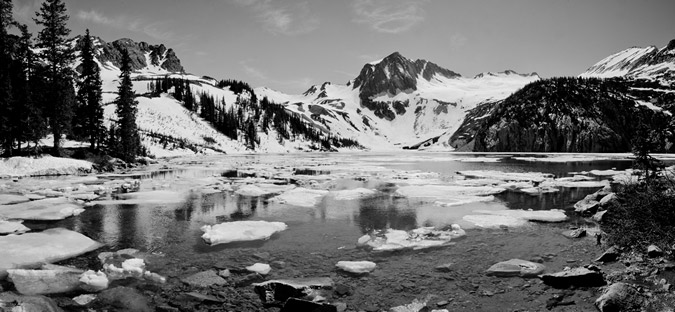
For the most part, Regina and I just kicked it at the lake for the day, watching the wildlife and the insane beauty of the lake. This also gave me the opportunity to play around with my camera and try to get some decent shots.
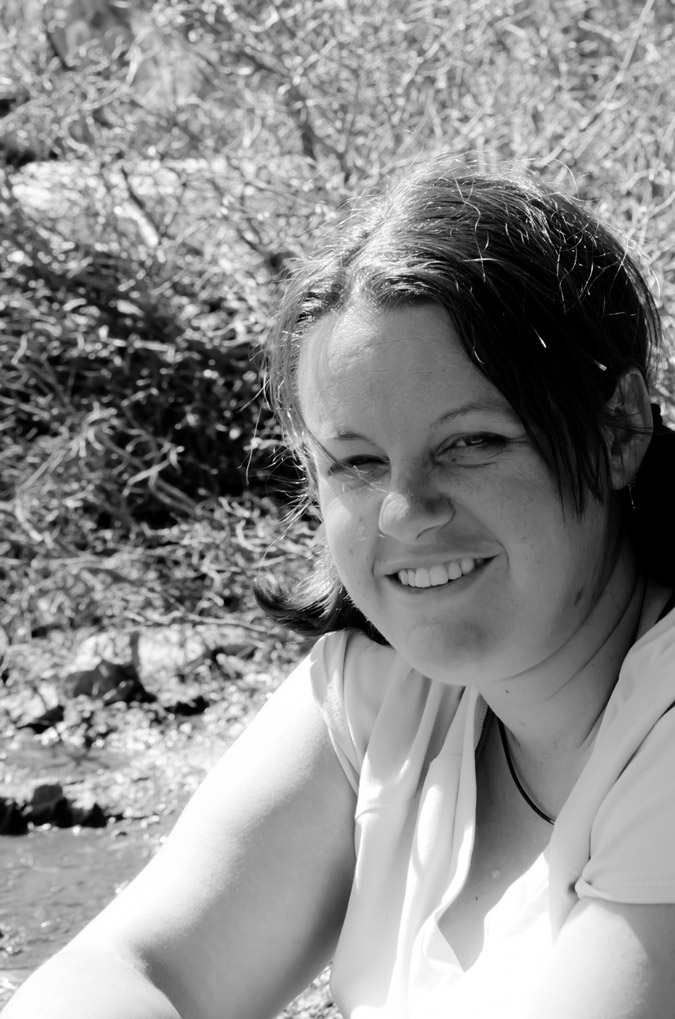
About an hour or two after we arrived at the lake, another group of gentlemen came to the lake, sporting a pistol and a Canon EOS Digital Rebel attached to a fully extended tripod. They were nice enough guys, hailing from Elizabeth, but I could not help but wonder how fun that tripod was to carry up to the lake and if they would be using the pistol for fun or for protection. I was hoping for the latter, based on my horrible experience at Huerfano Valley a couple of years ago. The two confirmed they were just hikers, not climbers, and were just there for the night.
Another hour later, two more guys came up the trail and were looking to camp nearby. One looked familiar, so I asked him if his name was Corey. He said it was - and sure enough, it was one of my Facebook friends! Corey was up at the lake with his friend Robbie as they were planning on climbing Snowmass on Sunday, the same as us. They were planning for a 4 AM start and we were planning for a 2 AM start. Regina and I talked for awhile off and on with both Corey and Robbie throughout the afternoon, getting to know each other. It is always remarkable to me how quickly people that climb 14ers can get to know each other and how, generally speaking, everyone is so friendly. It was a real pleasure sharing a campsite with them. Regina got to spend some quality time getting to know Corey:
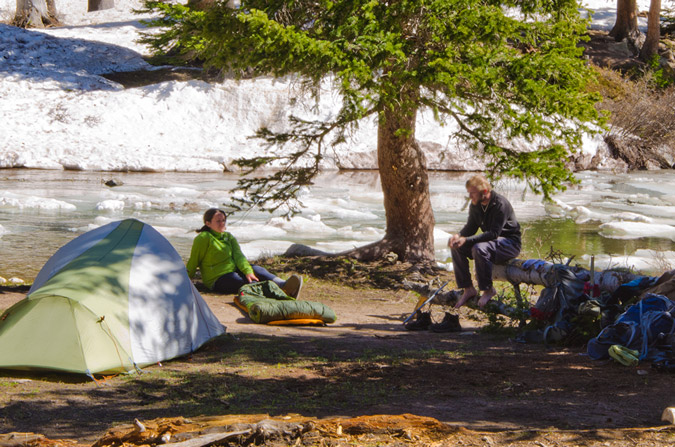
The lake was thawing out throughout the day, which was actually really fun to watch. Chunks of ice and snow would calve off of the icy glacier that was now Snowmass Lake and flow down into Snowmass Creek and out to sea. It was really fun to watch, and quite peaceful too. Soon, the sun began to get lower and lower on the horizon, which piqued my photographic instinct quickly. I was off to get as many quality shots as possible of the lake, hoping to get both HDR and standard photos. HDR has quickly become one of my more favorite photographic mediums. Its almost like opening a present at Christmas when you begin working with the files at home - you never quite know what you're going to get!
First up - the HDR version:
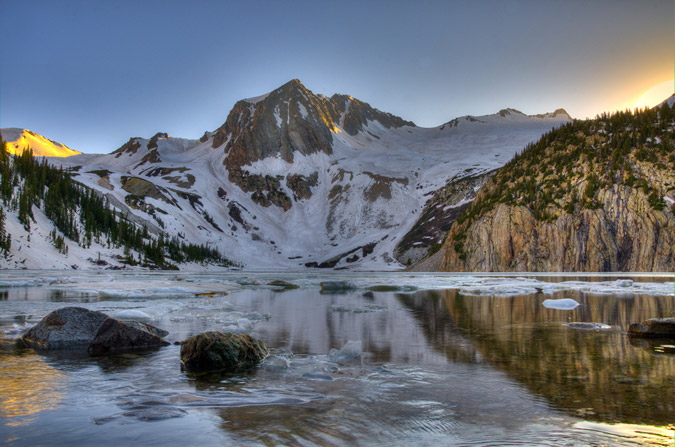
And the standard version, which won me my second Flickr Explore Award, which was quite exciting! Explore is Flickr’s Daily Artist Showcase. Every day Flickr admins choose 500 of the most interesting images determined by “interestingness”. I have placed that photo in my portfolio and for sale section if you are interested in purchasing a print.
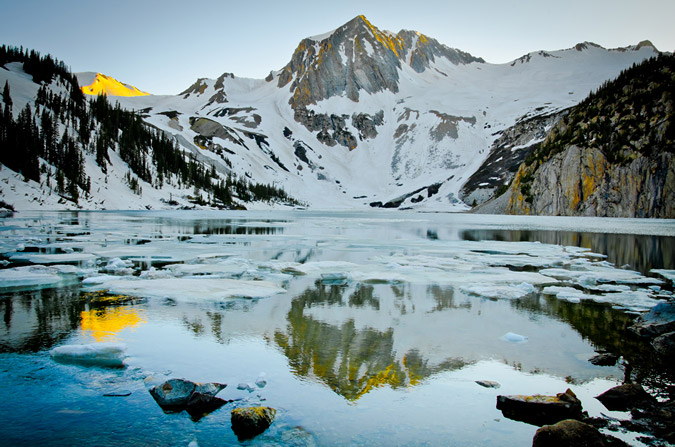
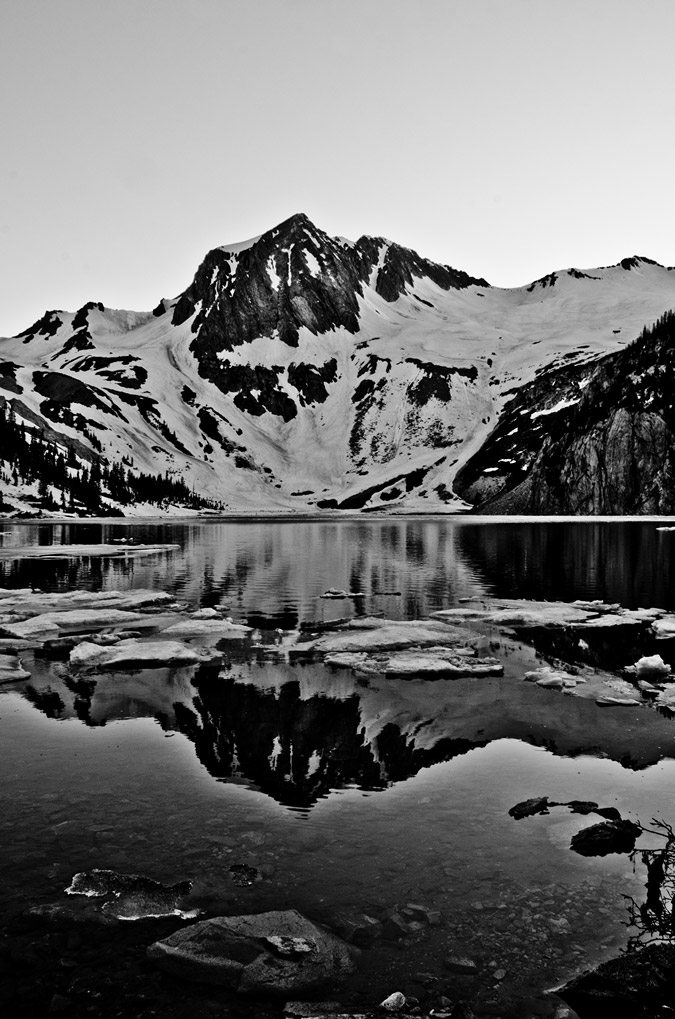 The views from the shores of the lake were outstanding. Quite possibly ranking in the top 10 views of all time for me personally. The impressive features of Snowmass Peak, paired with the crazy cliff walls below Snowmass Mountain made for quite a great spot to sit and soak it all in. To make things even more fun, close to dusk, a huge, feral, rugged looking porcupine decided he would come and hang out with us. This guy was seriously oblivious to our presence, and it was actually somewhat challenging getting him to go away without putting myself in a dangerous place.
The views from the shores of the lake were outstanding. Quite possibly ranking in the top 10 views of all time for me personally. The impressive features of Snowmass Peak, paired with the crazy cliff walls below Snowmass Mountain made for quite a great spot to sit and soak it all in. To make things even more fun, close to dusk, a huge, feral, rugged looking porcupine decided he would come and hang out with us. This guy was seriously oblivious to our presence, and it was actually somewhat challenging getting him to go away without putting myself in a dangerous place.
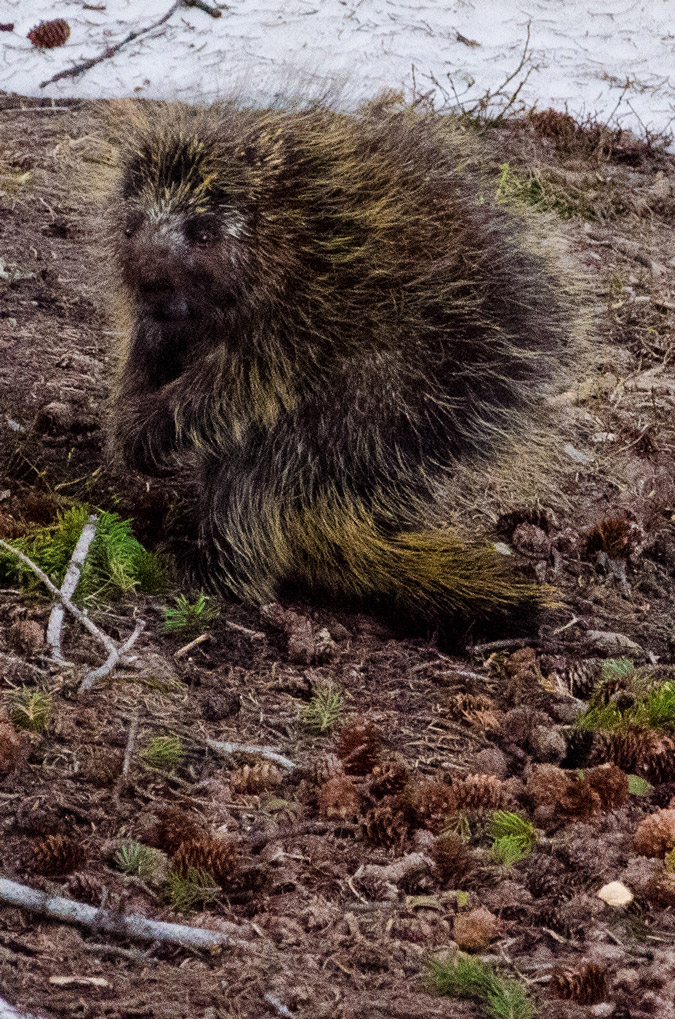
With all of the excitement over the porcupine and the heavenly sunset, I decided it was time to hit the sack. We had set our alarms for 1:45 AM, anticipating a 2 AM start. It was sadistic, I know, but we felt it was necessary given the conditions. The alarm went off and I got up fast, because I wanted to take advantage of a quick photographic opportunity to capture the Milky Way, or at least attempt it. Additionally, I was hoping that I could get some photos of the stars reflected in the lake as well. Both concepts challenged my photographic mind, and away I went to try to get some good shots. The challenge with shooting in low light, as in pitch dark, is always figuring out the best combination of aperture, ISO and shutter speed. Of course, I guess this can be said about any other form of photography, but the concepts are of particular sensitivity in low light conditions. I opted to set the camera at a slightly higher ISO (400) to increase the sensitivity of my cameras sensor. Additionally, I went for a 20 second exposure instead of a 30 second exposure since I did not want the stars to blur / move across the frame at all. Lastly, I opted to set my camera at the lowest aperture the lens would handle (f/3.5) to allow the maximum amount of light into the lens. These combinations produced fairly good results.
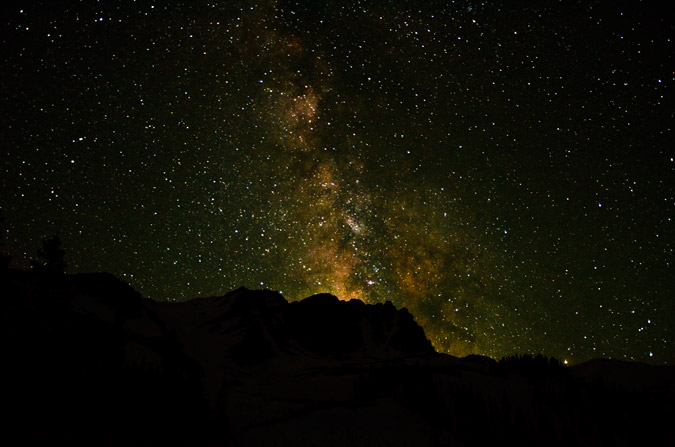
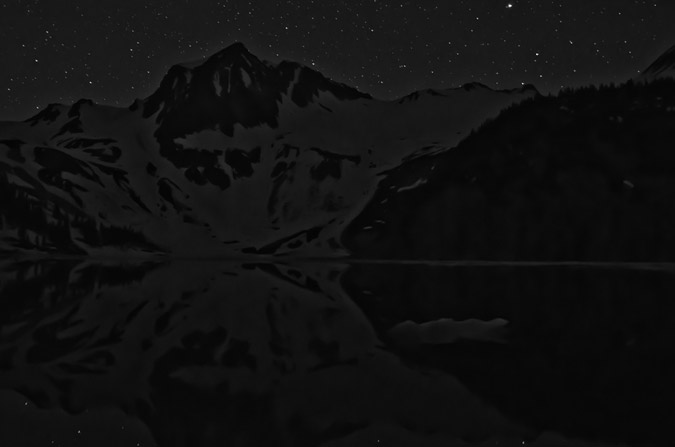
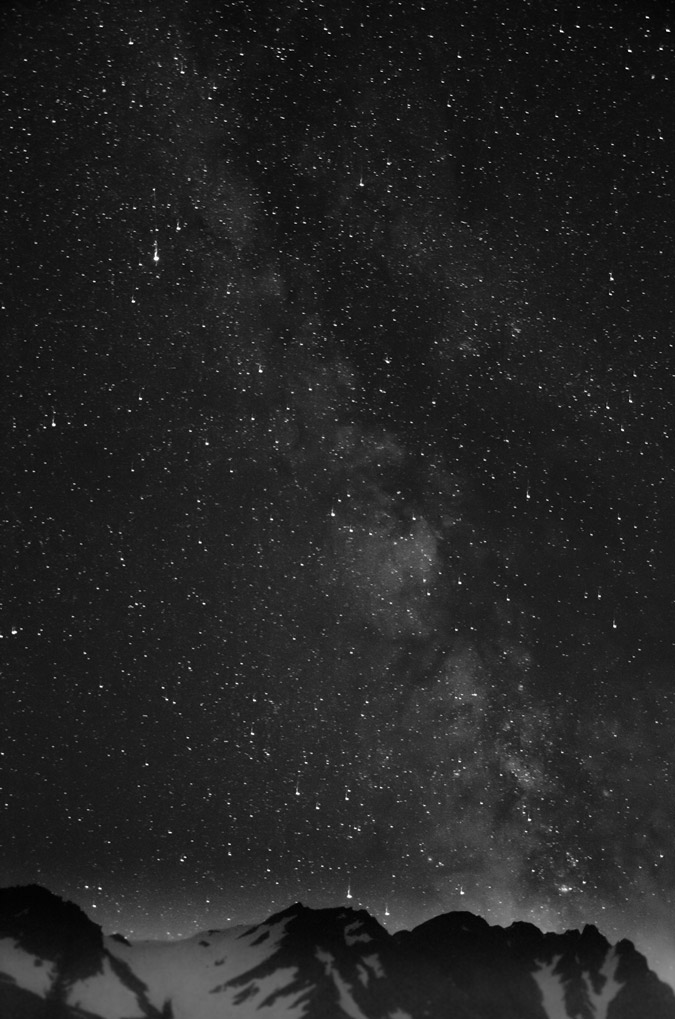 Unfortunately for me, the photographic success would not lead into climbing success. This is quite an embarrasing story for me, since I pride myself on preparation. As Regina and I wrapped around the steep snow banks to the left of Snowmass Lake, heading for Snowmass Mountain, we quickly realized that crampons would be required. No problem right!? Wrong. Shortly after putting the crampons on and continuing, my crampons would come right off my boot, necessitating frequent and long stops to get them back on. Finally, Regina and I decided that there was something wrong with my crampons and that no matter how we tried to get them to stay on my boots, they just would not stay. We decided to abort the mission at about 3:45 AM and headed back to camp. I was quite furious with myself, since I had personally tested the crampons at home, putting my boots into them, strapping them down, and making sure they fit. Apparently that effort was not as good as it could have been. It turns out, after inspection at home, that my crampons were adjusted in such a way that they were too big for my boots. Most modern crampons self-adjust their size; however, the crampons I own are hand-me-downs from my dad. Surprisingly, the same model is still manufactured by Seattle Manufacturing Corporation. Anyways - lesson learned! USE your equipment before you trust it with your life. We went back to camp, slept for a bit longer, and then packed up and headed back down to the trailhead. I was not in a great mood because this was one of the only mountains I've ever been turned back from, and it was completely my own fault. If it were weather or altitude sickness or some other uncontrollable event, that would be one thing, but to have the mountain turn us back because I was too stupid to test my crampons - not cool. It was not a total loss though, the photos turned out great, and I was able to get some fun and creative shots of wildflowers on the way out. If any of you know the names of these flowers, please, by all means let me know!
Unfortunately for me, the photographic success would not lead into climbing success. This is quite an embarrasing story for me, since I pride myself on preparation. As Regina and I wrapped around the steep snow banks to the left of Snowmass Lake, heading for Snowmass Mountain, we quickly realized that crampons would be required. No problem right!? Wrong. Shortly after putting the crampons on and continuing, my crampons would come right off my boot, necessitating frequent and long stops to get them back on. Finally, Regina and I decided that there was something wrong with my crampons and that no matter how we tried to get them to stay on my boots, they just would not stay. We decided to abort the mission at about 3:45 AM and headed back to camp. I was quite furious with myself, since I had personally tested the crampons at home, putting my boots into them, strapping them down, and making sure they fit. Apparently that effort was not as good as it could have been. It turns out, after inspection at home, that my crampons were adjusted in such a way that they were too big for my boots. Most modern crampons self-adjust their size; however, the crampons I own are hand-me-downs from my dad. Surprisingly, the same model is still manufactured by Seattle Manufacturing Corporation. Anyways - lesson learned! USE your equipment before you trust it with your life. We went back to camp, slept for a bit longer, and then packed up and headed back down to the trailhead. I was not in a great mood because this was one of the only mountains I've ever been turned back from, and it was completely my own fault. If it were weather or altitude sickness or some other uncontrollable event, that would be one thing, but to have the mountain turn us back because I was too stupid to test my crampons - not cool. It was not a total loss though, the photos turned out great, and I was able to get some fun and creative shots of wildflowers on the way out. If any of you know the names of these flowers, please, by all means let me know!
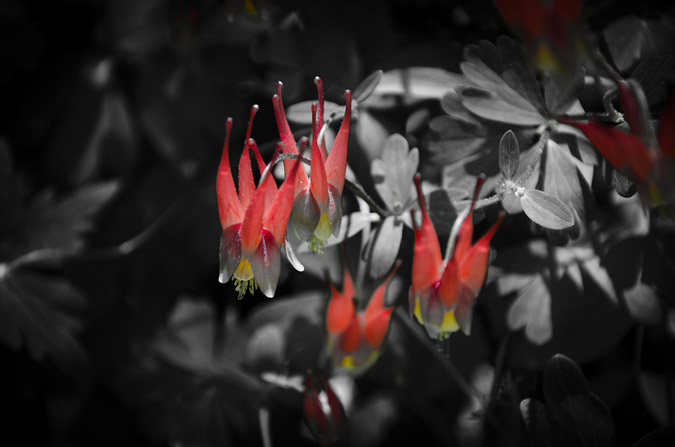
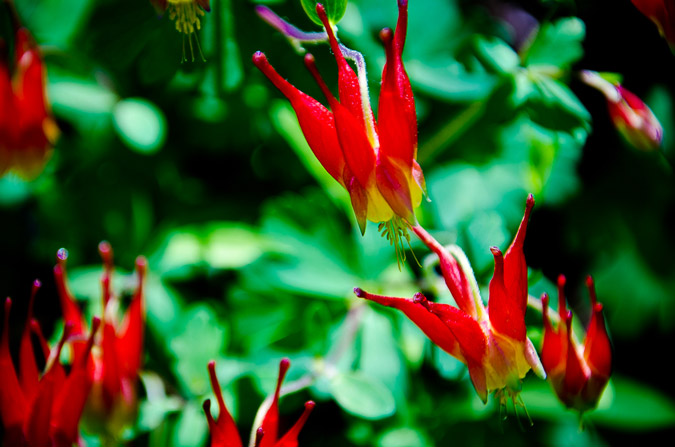
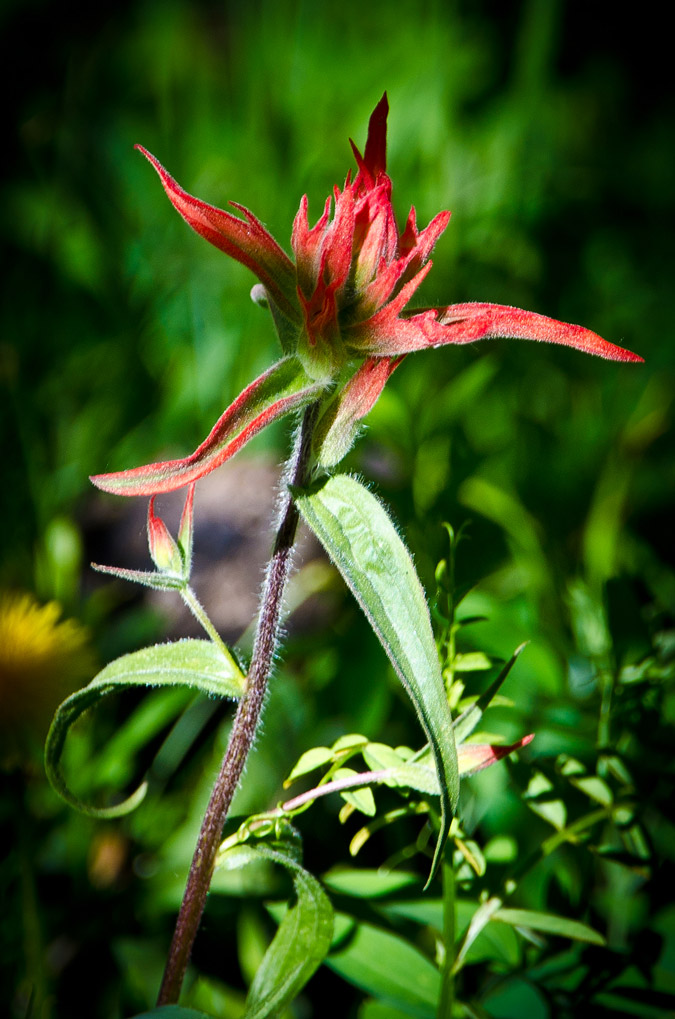
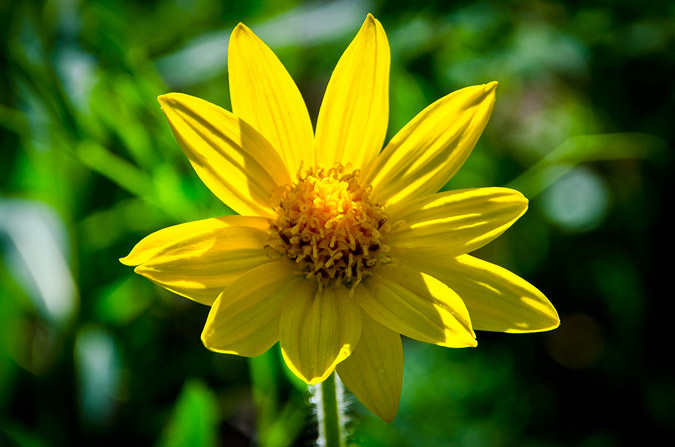
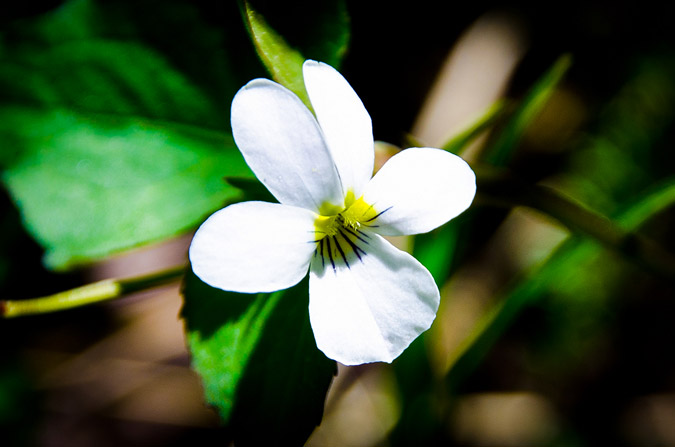
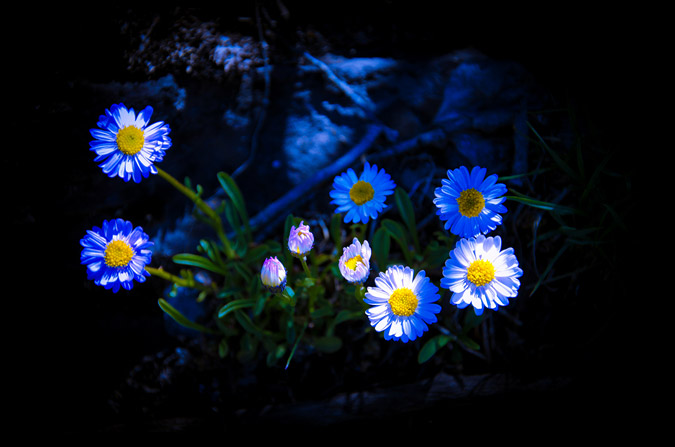
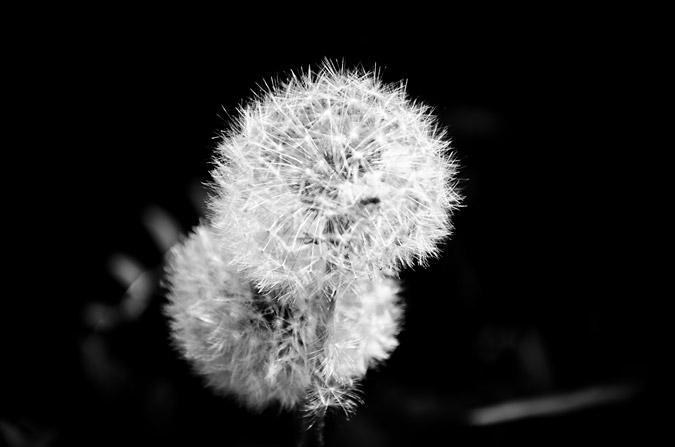
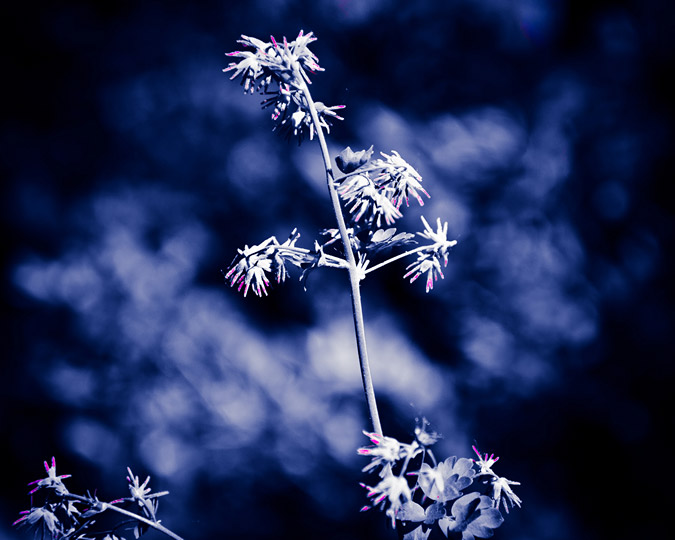
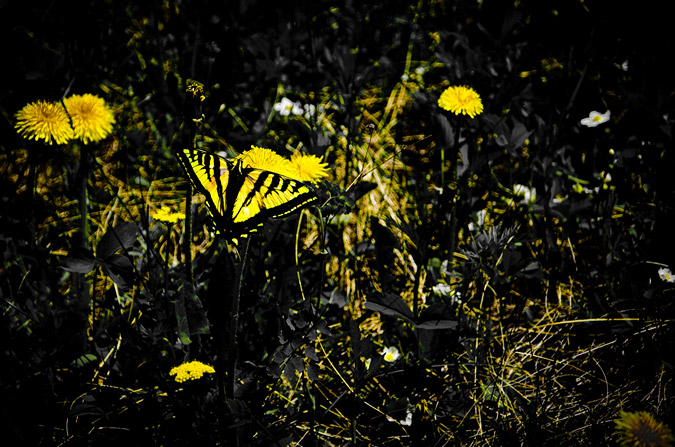
The most memorable part of the trip was yet to come though - and it certainly made up for the rest. On our way out, Regina took a nasty fall on the logjam! At first it was quite a scary experience. I was right behind her, and had to talk her through getting herself back up out of the water. She had managed to completely submerge one of her legs and was drenched. Fortunately, Regina is a good sport, and within a matter of minutes we were both laughing about it.
Lastly, we were able to get some great views of the backside of Snowmass that we did not get to see on the way up, which were quite stunning!
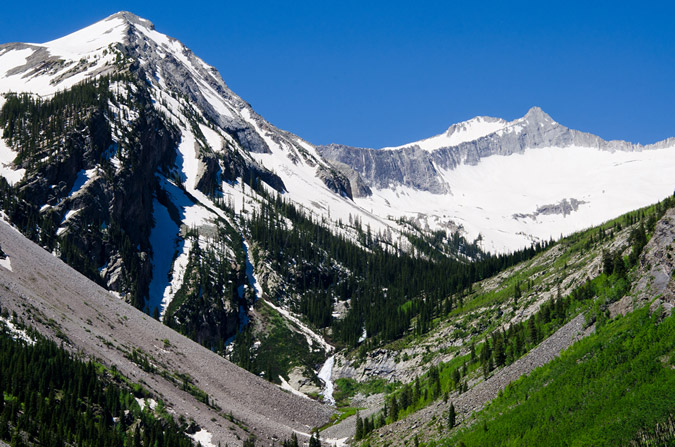
All-in-all, I would rate this hike quite highly on my list of hikes that I have done. The views from Snowmass Lake are worth it by themselves, and the logjam provides an excellent adventure.
And in case you were wondering - the new camera bag totally lived up to my expectations - I will end up writing a full-blown review of that product for sure!
Until next time Snowmass Mountain... I'll be back!
